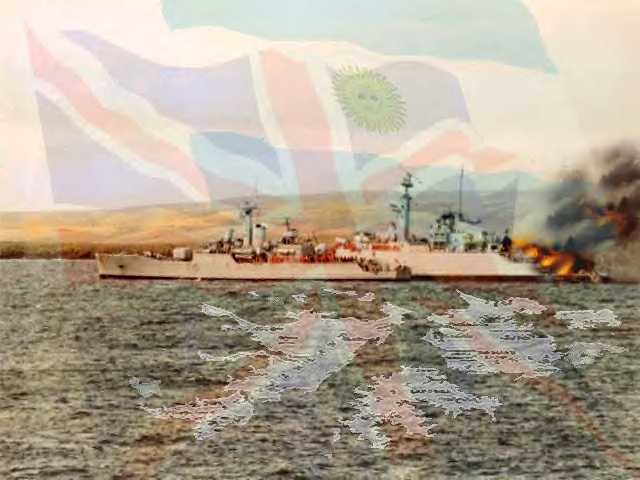
Re-look at the Falkland Islands War: Dress Rehearsal for the Taiwan Islands War?

VIDEO:
 www.youtube.com/view_play_list?p=05B8486AD1A7057E
www.youtube.com/view_play_list?p=05B8486AD1A7057E

In the 1982 Falkland Islands war, Argentina on the land continent of South America invaded the British-owned Falkland Islands to divert attention away from internal domestic issues. Ensconced on the Falkland islands, the Argentines waited for the British Royal Navy in a vast ad hoc armada of desperation amphibious ships to arrive. For an excellent brief history of the air war see Dr. Corum's article and the airpower magazine from Austria's in-depth coverage in the NOTES section. Another option is to watch the videos below:
Falklands War Over-View
 www.youtube.com/watch?v=DY9JyfVsjEA
www.youtube.com/watch?v=DY9JyfVsjEA
PART 2: broken down ships sail for Falklands, South Georgia retaken
 www.youtube.com/watch?v=X9n7TQyYbuU
www.youtube.com/watch?v=X9n7TQyYbuU
PART 3: Exocet ASMs hit HMS Sheffield
 www.youtube.com/watch?v=0BLRkSkzqng
www.youtube.com/watch?v=0BLRkSkzqng
PART 4: Sheffield burns, cheapo ship construction polyester clothing, Brits who knew better afterwards revamp, Pucara o/a plane threat to ships troops over soft open terrain, Pebble Island raid catches them exposed, yet more proof for need of aircraft to be in mobile, protected BATTLEBOXes, troops wet up to waist in freezing cold water
 www.youtube.com/watch?v=se1yxiLpLJw
www.youtube.com/watch?v=se1yxiLpLJw
PART 5: LCU (flat-bottom WW2 Higgins boat) goes aground, big tussock grass wearing rucksacks, reverse slope defense, ships mauled by SkyHawks, goose green attack foot infantry dependant on nvgfs and darkness, Thompson admits he should have sent light tanks and commanded in person,
 www.youtube.com/watch?v=eFr38idz6tg
www.youtube.com/watch?v=eFr38idz6tg
PART 6: situation desperate at goose green, wp smoke grenade screen not enough, caught in open, LEADERSHIP: LTC Jones killed, Keeble pulls A/B coys back from exposed axis, Harriers attack Boca house, Milan ATGMS shot at Argies, paras dig in no lightweight sleeping bags, 1200 EPWs taken, civilians rescued, almost no helos after Conveyor sunk by Exocet ASMs
 www.youtube.com/watch?v=xpSkMaLMRmM
www.youtube.com/watch?v=xpSkMaLMRmM
PART 7: sorry, you're walking exhausted men too heavy rucksacks: march or die, where's the carts Brits had in WW2? Trench foot, 2 Para in sole Chinook flies ahead
 www.youtube.com/watch?v=D1P0cKhp8zs
www.youtube.com/watch?v=D1P0cKhp8zs
PART 8: Spartan APC moves wounded man, 105mm guns can't reach Stanley so hills overlooking have to be first taken, 3 para steps on ap mine compromising attack for Mt. Longdon, they ditch their rucks/lbe and crawl wearing just smocks used bayonets to prevail, longer-ranged 155mm guns at Stanley kill some brits
 www.youtube.com/watch?v=6UskM2D24Xo
www.youtube.com/watch?v=6UskM2D24Xo
PART 9: 2 Para with light tank fire support takes Wireless Ridge easily compared to Goose Green battle where they didn't have light tanks
 www.youtube.com/watch?v=1NtxYCCcSHo
www.youtube.com/watch?v=1NtxYCCcSHo
PART 10: some argies thought they were on mainland, unrepentant think islands belong to them regardless: could be cause of future war?
 www.youtube.com/watch?v=6BTyUctnGe0
www.youtube.com/watch?v=6BTyUctnGe0
This war was the "littoral" combat near shores that the Navy brass are so infatuated with and claim to be adapting to. If Red China invades nearby Taiwan, by the time the U.S. responds a good part of that nation's islands will be occupied---in other words the same belligerent gobbling up a nearby neighbor scenario as the Falklands. With over a billion hungry and thirsty for water, food and amenities people, a convenient land grab for Taiwan to rally everyone around the "one China" flag might be too appealing for the Red Chinese dictators to pass up.
However, this time Red China will have a complete surveillance strike complex (SSC) in place--there will be no gaps in radar, sonar and patrol aircraft coverage. The U.S. Navy's surface WILL be seen and targeted. If you can be seen, you can be hit. If you can be hit, you can be killed.
In modern naval combat, seaplane fighters should be on EVERY capital ship to provide their own AES and AAW/ASW cover.
http://en.wikipedia.org/wiki/Modern_naval_tactics
"The key to successful AAW is to destroy the launching platform before it fires, thus removing a number of missile threats in one go."
This is one thing, the British did well by cramming every Harrier they could onto their ships, saving their entire effort. That was 1982. Today, the British have UNDONE their force structure and UNlearnt this lesson to have adequate air cover by retiring their Sea Harriers! Its so shocking and stupid, we have had to add a point #12 on this web page to address this. The U.S. Navy followed this insanity by retiring their F-14 Tomcats with long-range Phoenix missiles, placing both fleets at risk of enemy ASM destruction due to non-existent or weak outer ring air covers. It looks like both navies need to relearn lesson #1 again--and quick.
AIR & SEA LESSONS TO BE LEARNED
1. Its the guided ASMs, stupid
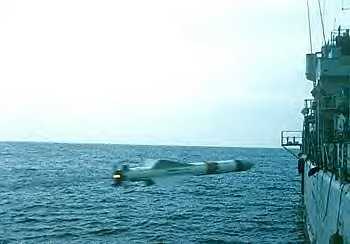
 www.youtube.com/watch?v=NYUqC6VEuMI
www.youtube.com/watch?v=NYUqC6VEuMI
The stunning truth of the 1982 Falkland Islands war is that had the Argentines did everything wrong that they did---but had 100 air-launched Exocet anti-ship missiles (ASMs) instead of the less than a dozen they did have, THE BRITISH FLEET WOULD HAVE BEEN SUNK OR TURNED AWAY.
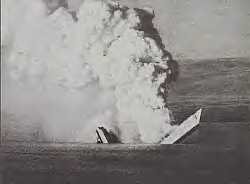
They would have "won" the war. Not only did the British invasion fleet of 1982 lack an effective anti-ASM defense back then, surface ships today still lack the stealth to avoid and the anti-missile missiles and rapid-firing guns and heavy armor protection needed to survive multiple, modern naval guided missile strikes.
Here's some UNCLASS data on fairly common anti-shipping systems KNOWN to be available to Third World nations on an almost "cash & carry" basis, (and therefore available to sub-national adversaries):
Origin Name Range Notes
Russian Styx 80km I think everyone who hates us owns some
Russian Siren 90km Nominally sub-launched
Russian Silex 55km Not just ASW, there IS an anti-ship version
Russian Sandbox 550km Large missile, less likely
Russian Shipwreck 625km Large missile, less likely
French Exocet 65km We know it works, ask the RN
PRC Silkworm 80km Styx copy
PRC C701 15km Short range, less threat
PRC C101 45km
PRC FL7 32km Also produced by Iran
PRC HY2 95km Large missile, Iran has large stocks
PRC HY3 100km Large missile, land based coastal defense
This doesn't even include the missiles that probably are out of reach of sub-national groups or Third World advesaries. So, ignoring the really big missiles (around 10 meters long for the missile alone), and figuring that rarely do maximum range attacks work very well, a 65km safety bubble around the boat, is likely to work as a passive measure.
www.cuttingedge.org/news/n1449.cfm
HAS RUSSIAN AND CHINESE MISSILE TECHNOLOGY DOOMED THE U.S. NAVY IN THE UPCOMING PLANNED THIRD WORLD WAR?Subtitle: The Russians have developed and deployed a supersonic cruise missile that travels so quickly as to defeat the U.S. Navy anti-missile defenses. This supersonic cruise missile also can carry a nuclear warhead. China has this Russian cruise missile! Is this why Chinese military leaders have warned us that, if we defend Taiwan, our Naval forces "die"?
NEWS BRIEF: U.S. Missile Gap Widen: Pentagon's hypersonic weapon program by 2010, WorldNetDaily,
www.worldnetdaily.com/bluesky_smith_news/20001003_xnsof_us_missile.shtml
by Charles Smith, October 3, 2000.
"Despite the Pentagon's development of a new generation of hypersonic missile, the U.S. is still a decade behind Russia in high-speed cruise-missile design, according to defense analysts. According to the Defense Advanced Research Project Agency, the U.S. military is developing a new hypersonic robot missile reported to be capable of traveling in excess of six times the speed of sound and armed with its own miniature smart bombs. The new weapon, called the Advanced Rapid Response Missile Demonstrator, or ARRMD, is designed to cruise at over 4,000 miles an hour and strike targets hundreds of miles away in only a few seconds."
Wow! This type of weapon would be a devastating weapon that could penetrate any defense system known today. A missile moving toward a target at 4,000 miles per hour would move so quickly through even the most sophisticated defense system that no computer could react quickly enough to shoot it down before it blew the targeted ship out of the water. Thank God we are working on it, and not the Russians and Chinese. Right? Wrong!!
"Nevertheless, defense analysts agree that the U.S. is fully a decade behind Russia in high-speed cruise missile designs. Russia currently deploys and exports the supersonic SS-N-22 Moskit cruise missile, NATO codenamed "Sunburn." The SS-N-22 is considered the most lethal anti-ship missile in the world, and flies at over 2.5 times the speed of sound only a few feet from the surface of the water." [This speed amounts to almost 1,700 miles per hour, or 28 miles-per-minute].
Moskit ASM
www.youtube.com/watch?v=PMqyWotOUz0
Wait a minute! You mean that Russia not only has this type of missile, but they have already deployed it? Further, they are exporting it to other nations! Does this mean that China might have this missile? Does this mean that both China and Russia might be able to deploy this missile in the upcoming planned Third World War? Listen:
"The Sunburn missile has been sold to China. The SS-N-22s are part of a recent Chinese purchase of two Sovremenny-class destroyers. Each warship carries two quad SS-N-22 launchers providing eight missiles per destroyer. According to U.S. Navy documentation, each Sunburn missile can be armed with a nuclear warhead equal to over 200,000 tons of TNT. News reports of nuclear warheads on the new Chinese anti-ship missiles were first published in WorldNetDaily in 1999."
I cannot find any level of horror high enough to describe my feelings about China and Russia possessing this type of weaponry, as I know the planned Third World War and the roles each of these nations are planned to play. I can remember the veiled threats from Russian former premier Boris Yeltsin that Russia is still to be feared and respected even though she was having such great economic trouble. I can well remember the threats of Chinese military leaders that, if America intervened in a Taiwan battle, our Navy would die, and that maybe we might even lose Los Angeles. This article proves that China and Russia are cooperating instead of being enemies or of being neutral toward one another. Listen:
"The Sunburn in China has proven to be a great concern inside the Pentagon. China's acquisition of the SS-N-22 is providing the People's Liberation Army with insights into Russian ramjet technology that may be applied to China's new strategic cruise-missile program. China has previously tested a ground-launched supersonic ramjet weapon based on the SA-4 and SA-6 surface-to-air missiles produced by Russia."
This article demonstrates, beyond doubt, that Russia and China today are cooperating against the United States. Top-level meetings between leaders of the two countries have been ongoing at all levels, including the highest level, between the current leaders of Russia and of China. For President Clinton to state again and again that "China is not a threat", and neither is Russia, is ludicrous beyond belief. We may die because this Communist/Illuminist President has acted on this belief.
Let us now continue examining this article:
"In July 1999, defense analyst Richard D. Fisher wrote an evaluation of the Russian-built Sunburn missile being sold to China. A senior fellow at the Jamestown Foundation, a Washington based think-tank, Fisher reported that the SS-N-22 may be capable of a dive speed of Mach 4.5 that would help it evade U.S. naval defenses. The Sunburn anti-ship missile is perhaps the most lethal anti-ship missile in the world," wrote Fisher in a review of the Chinese navy. The Sunburn combines a Mach 2.5 speed with a very low-level flight pattern that uses violent end maneuvers to throw off defenses. After detecting the Moskit, the U.S. Navy Phalanx point defense system may have only 2.5 seconds to calculate a fire solution -- not enough time before the devastating impact of a 750-lb. warhead."
Now we can begin to understand the effect this type of weapon might have on our Navy. If this missile can move so quickly that it would penetrate our current Phalanx point defense system would not have the time to plot a solution and fire in time to destroy the missile before it hits one of our ships.
But, what would happen if one of these weapons were outfitted with a warhead that was nuclear rather than conventional? What would happen if one or more of these missiles were outfitted with a warhead of the size mentioned, above, equal to 200,000 pounds of TNT? This terrible possibility is covered by another article.
"U.S. Eyes China First Strike Capability; Nuclear-tipped Missiles Set For Deployment On Destroyers", November 11, 2000,
www.worldnetdaily.com/bluesky_exnews/19991111_xex_us_eyes_chin.shtml
by Charles Smith.
"The Pentagon is reportedly investigating allegations that China will deploy nuclear-tipped missiles on two Russian-built Sovremenny-class destroyers, said by one defense expert to be warships designed to start a nuclear war. Reports of nuclear warheads on the new Chinese anti-ship missiles first appeared inside a new book called 'Red Dragon Rising'. According to the book's co-author, William Triplett, each Chinese warship is equipped with eight nuclear-tipped, Russian-made Moskit anti-ship missiles -- each armed with a warhead equal to over 120,000 tons of TNT. 'The Sovremenny is strictly an offensive platform', stated Triplett during a WorldNetDaily interview."
My years with U.S. Army Intelligence has taught me that, for a public disclosure to be made about a new capability, deployment has already occurred. Since this second article was published November 11, and based upon a book written before that, we can assume safely that China has already deployed this fearsome weapon. In fact, this article later states that the Chinese have already deployed these type destroyers.
"According to the U.S. Naval Institute, in August 1999, the first of two 8,480-ton Russian Navy Project 956A destroyers built for China conducted trials in the eastern Baltic. Each 956A warship is armed with eight supersonic 3M82 Moskit sea-skimming missiles (NATO code-named SS-N-22 'Sunburn') ... In 1996, the Chinese People's Liberation Army Navy negotiated to buy the Yekaterinburg and another 956A class destroyer named the Alexandr Nevskiy. The Yekaterinburg is due for delivery by the end of 1999 and the second destroyer by the end of 2000."
We know that the Chinese Navy has had possession of one of these destroyers since the "end of 1999", and since we are currently at the "end of 2000", China has the second ship on the high seas right now. This means they have 16 "supersonic 3M82 Moskit sea-skimming missiles" in their arsenal, each one nuclear-capable. Let us continue with this second article:
"Triplett also openly charged the missiles arming the new warships are nuclear-tipped. Each warhead is six times more powerful than the atomic bomb used on Hiroshima,' said Triplett. 'The new missiles are designed specifically to destroy American carriers and Aegis cruisers with a single nuclear blast'."
We are now at the point where we can understand the full import of our information from these two articles. The U.S. Navy might just have been rendered obsolete to the point where our ships are sitting ducks in a nuclear target gallery, rather than "State-of-the-Art fighting ships capable of defeating any foe in the world". If China were to fire just three of these missiles, each one with a nuclear warhead of 120,000 tons of TNT, in the air just above our fleet, and detonated them, an aircraft carrier, all of its Aegis cruisers and all support ships, would be annihilated instantaneously. The loss of life would be enormous, and total. Americans would panic beyond belief, as we try to cope with the combined news of war throughout the world, terrible loss of life, much of it by loved ones, economic collapse, and threats against our cities.
This new naval capability must be behind the threat by Chinese leaders of late that we had best not defend Taiwan or our Naval forces would "die". I fear very much for the safety of American armed forces in this coming Third World War. We have a bona fide, proven Communist/Illuminist President in Bill Clinton [Read NEWS1315, "Bill Clinton Much More Than A "Stealth" Communist President: He Is An Illuminist" for full details]. When the chips are down, and quick decisions have to be made in order to defend our armed forces and defeat an enemy that might be attacking, will Bill Clinton give the order? If we learn that these Chinese naval vessels are beginning to arm and track their nuclear-tipped missiles and are in a position to fire them above an American carrier fleet, will Bill Clinton do everything in his power to diplomatically or militarily dissuade the Chinese from attacking?
After all, not only is Clinton a Communist/Illuminist, but he is proven to have taken so much money from the Chinese government for his 1996 reelection campaign, that he could be fairly thought of as "in their back pocket". Will he order an overwhelming American response in order to protect our fleet, and our brave and capable American Soldiers and Seamen?
I have one other concern: one of the most consistent threads running in New Age and New World Order books is that globalist leaders of the New World Order consider their personal loyalty to belong to the global government they are creating, and not to the government of which they are citizens. American presidents from Woodrow Wilson to William Clinton have been globalist to the core. They are not patriots, even though they have certainly tried to portray themselves as such. They consider patriotism to be such a serious obstacle to the final establishment of their global system that they have done everything in their power to weaken and destroy patriotism in the minds of their subjects. Thus, American schools have been teaching the value of a global government for a number of decades now. Many Americans today are not the firm and fanatic American patriots of their predecessors.
As Clinton and others lead the American people through the Third World War designed to produce Antichrist and dissolve our traditional Republic form of government, they consider patriotism to be their last great enemy. In fact, these leaders tie American patriotism and Gun Ownership advocates together. Could it be possible that our troops might be led into battle in such an inept manner that they might be annihilated wholesale?
One of the greatest shocks I received was the realization that top Admirals were as committed to the New World Order as any of their civilian bosses. I walked out of the June, 1999 Naval War College Strategy Session shaking my head, not sure anymore that our top military men owed their allegiance to this country first of all, and to their troops secondly of all.
FYI: the Bush crime family are all illuminist/globalists, too! NEW THREAT: Theater Ballistic Missiles (TBMs) as ASMs
Editor of G2mil.com, Carlton Meyer warns us:
"A big danger to aircraft carriers are ballistic missiles. G2mil has an article 'Can an ICBM hit a ship'. I'm sure the Russians could hit one in port in the USA. With a conventional or no warhead, a big missile warhead coming down at Mach 5 would slice right through the ship. An Iraqi SCUD nearly hit an LHA in port in Saudi during the first Gulf war. There was an article in Proceedings about it. The author noted with that ship full of fuel and ammo, it would have been very bad. So if you put some IR guidance on an SCUD, the Navy is in trouble. It is developing anti-missile missiles SM-3s which seen to work, but only against a single known target in tests. If someone fired a dozens guided SCUDs at a carrier I say several would hit it. Do the math, Aegis radar looks out only 100 miles, (E-2C provide a much bigger look, but don't look up high) so a Mach 5 (~3000 mph) incoming missile provides a battlegroup with just a couple seconds to track, ID, fire, and intercept, e.g. impossible to defend against."
Carlton
BAD SHIP CAMOUFLAGE
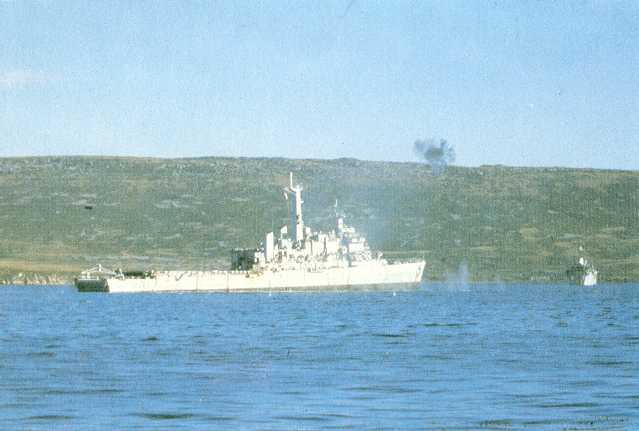
Falklands War 1982: picture of a British surface ship in all gray color sitting in medium blue water too close to the grassy green shore being attacked by Argentine aircraft who are visually aiming cannon fire and iron "dumb" bombs. Would painting the ship in blaze orange with a bull's eye be any more damaging?
Let's have some honesty here, ok?
Navies paint their ships in GRAY when water is BLUE because:
a. they are non-warfighting bureaucrats and ships primarily show the flag at civilian ports that we are not warmongers when we are
b. they are afraid of colliding with each other
Because...if they were serious about warfighting they'd paint their ships in the blue color of the ocean they are in!
USN/Mc Lessons not learned:
Yet the USN and marines who say they base their warfare to prevail in the guided missile age, have not taken this lesson to heart and are continuing with their high-technification of WW2 mentality where guided missiles were not prevalent. In fact, the Navy/marines racketeers "pork-ize" SeaBasing for themselves with even more expensive, vulnerable amphib ships. Nevermind that none of the plan below would help us one iota deep inland in Iraq or Afghanistan. We are packing even more men into vulnerable surface ships for untimely deaths by a rain of enemy missiles, torpedoes and sea mines.
DefenseNews.com
July 14, 2005New U.S. Navy Sea Base Plan Includes Assault Ships
By Christopher P. Cavas
The future makeup of the U.S. Navy's new Sea Base squadrons has been dramatically changed, moving from a collection of modified prepositioning ships based on commercial designs to include three large-deck assault ships per squadron and modified versions of Navy supply ships.
Up to nine LHD or LHA(R) big-deck assault ships are included in the plan - three per squadron. Those ships would be beyond current fleet requirements, which call for about nine to 11 assault ships to deploy marine expeditionary units.
How many squadrons are needed for the plan is not yet clear, according to the Navy, but the number is "between one and three," service spokesman Capt. Tom Van Leunen said July 14. He called the new plan a "significant" change from previous ideas.
The revision could be a boon for shipbuilders, particularly Northrop Grumman Ship Systems, which has built all 13 of the Navy's assault ships, and General Dynamics National Steel and Shipbuilding (NASSCO) in San Diego, which is building the new T-AKE dry cargo ammunition ships and has built a number of T-AKR roll-on/roll-off ships for the current pre-positioning forces.
Details of the new plan were provided to Congress June 6, when Navy acquisition chief John Young sent a report to the chairmen of the House and Senate defense committees. Further details appeared in a briefing for Congress prepared by the marine corps. Copies of each report were obtained by Defense News.
As now envisioned by the Navy, the plan includes:
* Two LHA(R) large-deck amphibious ships fitted with marine Expeditionary Brigade command-and-control facilities.
* One LHD amphibious ship, fitted for aviation command and control.
* Three modified LMSR roll-on/roll-off ships, similar to those now in service with joint prepositioning forces.
* Three Combat Logistic Force ships, variants of the T-AKE dry cargo ammunition ships now under construction at NASSCO.
* Three Mobile Landing Platform ships, a new type able to embark 1,112 marines.
* Two "dense packed" ships, using prepositioning ships already in service.
Van Leunen emphasized that although Navy and marine corps leaders have signed off on the new plan, no official proposals have been released to industry to build the new ships. Initial briefings on the plan to top Pentagon leaders have been "received positively," he said, but the scheme is still "awaiting formal approval."
Already, thousands of marines and sailors are routinely packed on board aircraft and amphibious carriers that will simply not survive if a rain of ASMs land upon them. These surface ships are visible from space and air to facilitate enemy targeting. The USMC has absurdly wasted $BILLIONS on an over-the-horizon (OTH) assault capability via the failed V-22 convertible helicopter-plane and the EFV high water speed bloated light armored tractor just so their mother ships can remain 25 miles off shore and under the curvature of the earth to avoid enemy coast defenses. The foolishness of this approach is that it ASS U MEs that we are only going to attack the enemy from one direction---what if the enemy has already landed on the friendly islands we want to take back and came from a nearby continental mainland? Launching an OTH assault from 25 miles off the shore of a "satellite" island only puts the mother ships that much CLOSER TO THE CONTINENTAL MAINLAND where thousands of ASMs from ground and air launchers can then rain down upon them. And Red China indeed has many ASMs of increasingly sophisticated types that will indeed overwhelm our surface navy if it ventures into the littorals to defend Taiwan.
Editor of G2mil.com, Carlton Meyer writes:
"The Navy likes to brag that a missile could not sink an aircraft carrier, that is probably true, provide the carrier has no fuel or ordnance aboard. One hit in the right spot can send a carrier burning out of control, or could blow it apart if the magazine is hit. Imagine if a couple F/A-18s each loaded with thousands of pounds of bombs were hit on deck. Read about the USS Forrestal off Vietnam. I think it was a 20mm gun fired accidentally that hit a loaded aircraft on deck and then almost the whole ship was lost. The ship was saved, thereafter called the 'Forrest Fire' by sailors."
Carlton
FIXES:
* The V-22 and EFV should be cancelled in favor of CH-53 SkyCranes helicopters that can lift troops with tracked armored fighting vehicles like M113 Gavins with waterjets called "Amphigavins" to enable amphibious and sealift mother ships to remain completely out of enemy ASM range. Unlike puny V-22s that even if they worked would limit troops to unarmored "dune buggies", the Air Assault/Heliborne Amphigavin force would have Air-Mech-Strike capabilities to fight with mounted, armored 3D maneuver.
www.geocities.com/armysappersforward/amphigavins.htm
Offload of sealift ships must be expedited by LCAC/ACVLAP interface:
www.geocities.com/strategicmaneuver
* All existing surface ships must be drastically up-armored and increased in ASM countermeasures and counter-weapons.
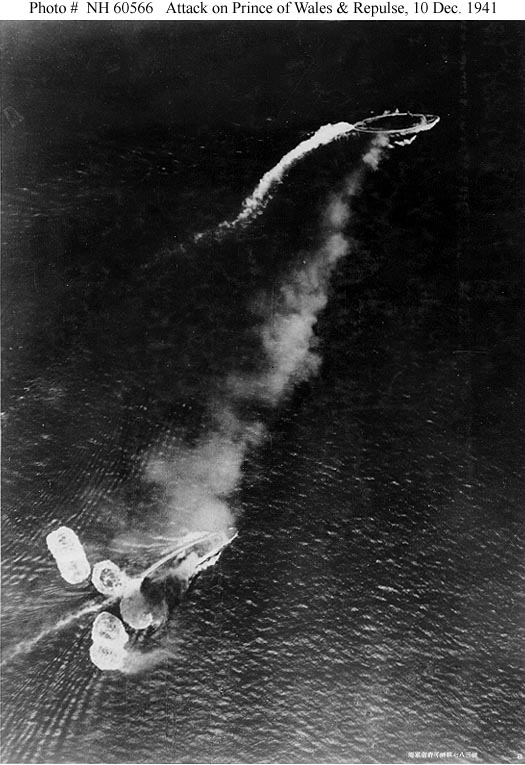
* Future surface ships must be heavily armored and have their wakes dissipate by the time they reach the stern to be invisible from air/space. ALL ships must be painted in sea blue or "dazzle" paint and too bad if it looks "war like".
GOOD SHIP CAMOUFLAGE

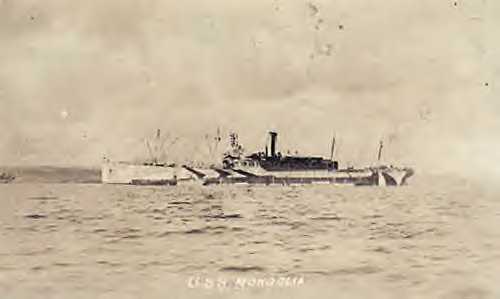
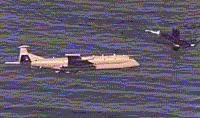
Notice above, the Royal Navy submarine on the surface is in a dark blue to blend in with the water. Even the U.S. Navy's subs are in a dark color for camouflage. Why not the surface navy?
www.combatreform.org/camie.htm
* Submarine aircraft carriers must be fielded.
www.combatreform.org/submarineaircraftcarriers.htm
* USMC must get out of the bloated amphib ship and bloated amtrack mentality and obtain seaplane transports
www.combatreform.org/seaplanetransports.htm
www.geocities.com/armorhistory/amphibiousinfantrytanks.htm * Face fact that ships WILL be sunk and re-equip Sailors to survive explosions, fires and being thrown into the water
2. Ocean Patrol Planes must be able to fight, and they should be capable of in-flight refueling and better yet be jet seaplanes to refuel from ships
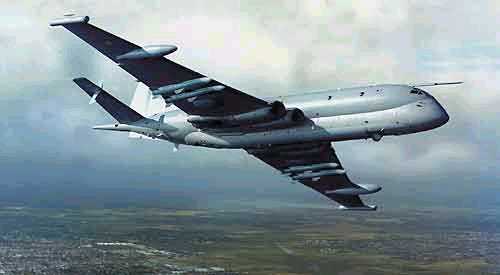
One of the things that saved the Royal Navy (RN) was that Argentine unarmed 707 jet airliners tailing their invasion fleet were run off by SeaHarrier STOVL jets. The Argentines had a hard time without space satellites and ocean patrol planes to locate the RN fleet to launch Exocet ASM and dumb bomb attacks until the fleet stopped offshore the Falkland Islands to offload ground forces. In fact, since the British chased off Argentine 707s from ocean surveillance with SeaHarrier jets during the Falklands war, the "lessons learned" migrated to their own ocean surveillance Nimrods which can be armed with AIM-9L air-to-air missiles to self-protect. I think we need to get longer ranged AMRAAMs on our patrol planes so the enemy fighter can be kept farther away/shot down.
USN/Mc Lessons not learned:
In 2000, an unarmed USN EP-3 Aries II patrol plane was intimidated and then brought down by a Communist jet fighter after a collision. If prior to a war, a capable enemy blinds/disables/shoots down our ocean surveillance satellites, we will be in the same emasculated position as the Argentines were in 1982.
Not only are our current P-3C Orion patrol planes unarmed, the Navy wants to buy yet another civilian airliner, a 737 commuter jet to replace them at great cost but with little improvements in combat power. The time has come to face the facts that in naval combat RANGE achieved through a multi-engined fixed-wing plane means a plane vulnerable to shoot down by smaller, faster enemy fighter jets flying from nearby land or sea bases. If we sail to defend Taiwan, WE WILL BE GOING INTO THE CHINESE ENEMY'S BACKYARD WHERE HE WILL HAVE THOUSANDS OF MISSILES AND JET PLANES to shoot down our P-3C or warmed-over 737 airliner patrol planes.
http://seattlepi.nwsource.com/business/70087_boeing13.shtml
Boeing 737 may be enlisted as a warplaneMonday, May 13, 2002
By JAMES WALLACE
SEATTLE POST-INTELLIGENCER REPORTER
ST. LOUIS -- Flying off the Washington state coast recently, a Boeing 737 suddenly swooped low above the dark waters of the Pacific.
P-I GRAPHIC
http://seattlepi.nwsource.com/dayart/pdf/737military.pdf
View a graphic showing the main attributes of the 737 business vs. military versions and the primary competition (Acrobat PDF, 120K).
When the jet was just a couple hundred feet above the waves and banking sharply, power was cut to one of the two jet engines -- a maneuver that no commercial pilot would deliberately make with a planeload of passengers.
But this was no commercial flight. It was a demonstration for the U.S. Navy.
Boeing wants the Navy to select the world's most frequently flown commercial jetliner as a replacement for the aging fleet of Lockheed Martin P-3C Orion maritime patrol aircraft and the EP-3C planes that gather intelligence.
The purpose of the demonstration flight was to simulate an attack on an enemy submarine and show Navy officers on board that a two-engine jetliner designed to carry passengers at nearly Mach 0.80 can make a very good replacement for the lumbering four-engine turboprop Navy planes that often fly low and slow for anti-submarine operations.
It also was an effort to show that the 737 can operate safely and effectively in such an environment, even on one engine.
If Boeing wins the competition, it would mean a lot more 737s rolling down the Renton assembly line.
"We are looking at a global market, but the heart and soul of the program is the U.S. Navy's requirement for about 200-plus planes," said Jack Zerr, general manager of Boeing's maritime aircraft program.
The maritime version of the 737 that Boeing is offering the Navy would be based on the Boeing Business Jet, which has a 737-700 fuselage and the bigger wing of the 737-800 to handle extra weight, including additional fuel tanks.
But rather than being outfitted to carry business executives in plush comfort, the maritime version of the 737 for the Navy would likely have missile racks on its wings and a bomb bay in its belly to carry everything from mines and depth charges to the sonobuoys used to track submarines.
"This plane can do the mission, no question," Zerr said during an interview in his office at the St. Louis headquarters of Boeing's Military Aircraft and Missile Systems.
The company submitted its proposal to the Navy on May 3.
Next month, the Navy is expected to pick several prime contractors for an 18-month initial concept development phase of the program, which is known as the Multi-mission Maritime Aircraft, or MMA. The winning contractor would be selected in 2004.
The Navy wants the first planes to be operational by late 2010.
Boeing faces strong competition. Lockheed Martin is offering the Navy a modern and re-engineered version of its P-3. And BAE Systems of Britain is proposing the new version of its Nimrod maritime patrol plane that it is already building for the United Kingdom.
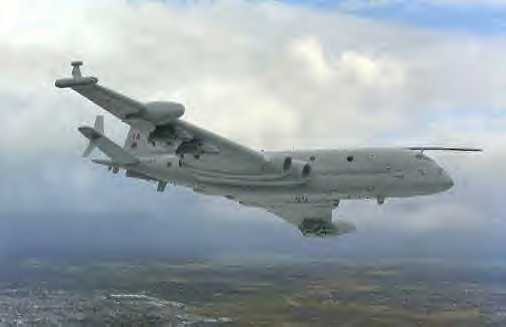
Interestingly, BAE Systems has approached Boeing about becoming its partner in the competition. So one Boeing team could end up competing against another.
Boeing is already a major subcontractor for BAE Systems on its new Nimrod plane, known as the MRA4.
Boeing's chances of winning may well hinge on funding.
The Navy, already facing proposed cuts for its fighter programs, could have a difficult battle to get all the money it wants to replace its P-3s and EP-3s.
"If there is an off-the-shelf jetliner solution for MMA, Boeing's 737 wins," said Richard Aboulafia, an aviation and defense analyst with the Teal Group.
"That's the good news. The bad news is that I don't think the Navy is ready for a jetliner-based solution. Those turbofans and swept wings are terrible for swooping and diving to low altitudes, as patrol aircraft need to do.
"And the absence of any carriage bays means the 737 would either need to cooperate with armed planes, a terrible approach, or Boeing would need to develop a 737 with large munitions and sonobuoy bays. The development costs associated with gouging these large cavities in a round pressurized fuselage would erase many of the cost savings of going with an off-the-shelf jetliner."
He believes the Navy probably will go with the modernized P-3.
But don't count out the newly designed Nimrod, he said.
Navy officers have privately told reporters who cover the defense industry that the new Nimrod would make a very good P-3 replacement.
The Navy initially was not going to allow a foreign prime contractor to enter the competition. That would have forced BAE Systems to look for a partner. But the Navy changed its mind.
"Like the 737, it's a jet, but it has straight wings, so its a good compromise," Aboulafia said of the new Nimrod. "It has huge bomb bays. And it would reward our close ally, Britain. Nimrod can be seen as a promising dark horse."
Boeing's recent 737 demonstration flight for the Navy was done in part to counter the perception -- like Aboulafia's -- that the two-engine jetliner would not be ideal for the kinds of low-altitude missions often flown by the P-3C Orion turboprop planes.
Boeing received permission from one of its airline customers to use a 737-700 whose delivery was delayed because of the Sept. 11 attacks.
At the controls was a Navy pilot and P-3 wing commander. The co-pilot was a Boeing test pilot.
Zerr, a former Navy fighter pilot, was a passenger. The plane took off from Boeing Field and headed out over the Washington coast to simulate an anti-submarine warfare mission.
"They were doing typical ASW maneuvers at 200 feet," Zerr said of the March 5 flight.
It was during one 60-degree banking maneuver that power was deliberately cut to one engine.
"There was no adverse handling," Zerr said. "They leveled the wings, put power on the good engine and climbed right out of there. It was impressive."
Although the 737 is best-known as a workhorse of the commercial airline fleet, it is also used by the military.
Boeing has built 737-700s for the Navy. The C-40A, as the plane is known, is used to carry passengers and cargo for fleet logistics.
And Boeing is developing a 737 for airborne warning and control. Australia has ordered the electronics-laden plane and Boeing is negotiating with Turkey for several more.
But the maritime patrol version presents unique challenges, since the jet would have to carry weapons, some of which would likely be carried on the wings because of the limited size of the bomb bay.
Zerr said wind tunnel testing has been done on a 737 model configured with a bomb bay to determine the handling characteristics of the jet with the doors open. The test results were good, he said.
Additional high-speed wind-tunnel testing will be done in August. Next year, wind-tunnel testing will examine what happens when weapons are dropped from the wings.
"Weapons separation characteristics are one of the items on our risk chart," he said. "But we have a fair amount of experience in this part of The Boeing Co. with dropping weapons from airplanes. It as much an art and craft as engineering and science....
"But separation of weapons from this plane should be no where near as complicated as dropping weapons off airplanes such as fighters, where speed and conditions are considerably more demanding."
Another challenge for the 737 is low-level operations.
"At low altitude, the P-3 does a little better than us," Zerr acknowledged.
But the 737 has a much higher ceiling, and it also has the advantage of speed.
The P-3 and EP-3 replacement planes wanted by the Navy must be able to perform multiple missions. In addition to intelligence-gathering, they must be able to direct what will be a growing fleet of Navy unmanned aerial vehicles.
Navy officials have said they want a plane that can act more like an "airborne node."
But the bottom line remains affordability. One of the program requirements is to reduce what the Navy calls "total ownership costs," and well as reduce current P-3 and EP-3 cost-per-flight-hour by 17 percent.
"We are expecting to do considerably better than that," Zerr said.
Lockheed Martin and BAE Systems are equally confident.
BAE Systems is planning to fly one of its new Nimrod MRA4 patrol planes to the Naval Air Station at Patuxent River in Maryland next year to give the Navy and look -- and a ride.
FIXES:
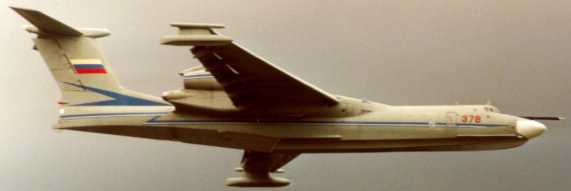
www.youtube.com/watch?v=0mg_PHcoFxU
* Its time to stop this airliner BS and to obtain real maritime combat patrol planes like the Russian A-40 jet seaplane patrol bomber that can land on the water to refuel, dip sonar, lay seamines and attack enemy surface and sub-surface ships and stay on patrol, by being able to refuel at sea from friendly ships/sub and not have to return to distant land bases. The British Nimrod ASW/maritime patrol bomber has in-flight refuel capability, our P-3C Orions do not. Even with in-flight refueling, the British had to refuel one Vulcan bomber 11 times to make it to bomb Stanley airfield. This is not efficent. The ideal would be a SEAPLANE maritime patrol bomber that can refuel in flight and land on the water and refuel from any ship using the same JP-5 heavy fuel the ship uses for increased safety over more volatile JP-8. If we set our mind to this, we can develop the JP-5 burning turbofan engines and the maritime seaplane patrol bomber starting with the A-40. When heavy bombers can get fuel, they are the most efficient air-delivered firepower means we have.
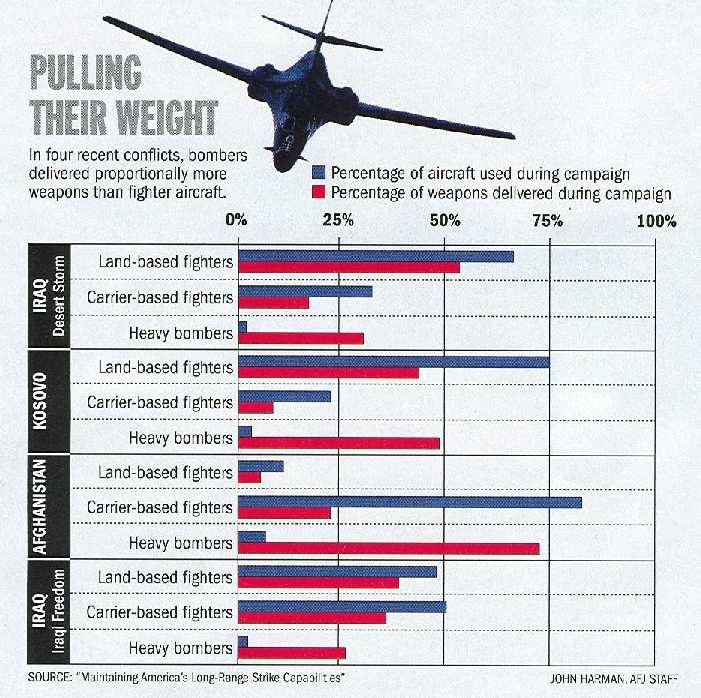
We should build A-40s under license from the Russians and arm them with AMRAAM beyond-visual range air-to-air missiles (AAMs) so if they encounter enemy fighters they can shoot them down and not only survive but continue the mission. If we do not do this, our patrol planes could get shot down and turned away as the German Fw200 Condors were defeated by Hurricane fighters launched from merchant sealift ships by Jet Assisted Take-Offs (JATO) in WW2. Without the Condors to locate enemy ships, the German U-Boats (submarines) were hard pressed to mass together into wolfpacks to effectively gang up on surface ship convoys that were increasingly better defended by anti-submarine warfare (ASW) blimps, sonar, radar and depth charges. The U.S. Navy at one time fully utilized seaplane patrol bombers to win WW2, but right when they had a jet seaplane patrol bomber, the P-6M Seamaster that was actually faster than the USAF B-52, the "carrier mafia" in the USN cancelled the program out of sheer "us" and "them" egotism.
Subj: Fwd: Role of seaplanes
Date: 08/18/2003 11:34:45 PM Eastern Daylight Time
From: Richard Wagner
"Although I don't agree with all of your posions regarding potential roles for seaplanes I do believe they have a definite place. I have always been intrigued by them but was convinced by the Falklands War.
Imagine Seamasters or even Tradewinds bombing the airfield at Stanley instead of that farcical 14,000+ mile multi-refueling Vulcan strike that essentially failed. In the absence of signicant air defense those seaplanes could have pounded the airfield day and night while also mining the sea lanes.
Instead of surface ships exposing themselves to air strikes in confined waters with little room to maneuver Tradewinds could have flown in, deposited their loads, and exited before the Argentines could have launched an airstrike from the mainland.
With AEW even the relatively slow Tradewinds could have avoided attack even by jet fighters. With any kind of warning they could have easily withdrawn beyond range as AWACS planes do now and would have the advantage if an incoming attack was detected they would not need to return all the way to base. They could have withdrawn to a safe distance and "loitered on the surface" until the threat departed.
I envisage an AEW version of the Tradewind with a limited tilt-wing, not for VTOL but for low speed take off and landings. Such a plane could be deployed forward of the fleet on a combined surface/air, land/fly operation that would give it tremendous endurance. Actually, a very large gyroplane similar to the Fairey Rotodyne might make a good seaplane for amphibious landings and AEW.
Speed is much over rated in some situations. It certainly is not that essential if you have a radar good enough so that one can avoid the incoming. Either approach would have been superior to Britain's cobbled up AEW helicopters which lacked speed, range, payload, and the ability to loiter on the surface.
In the case of the Falklands War the Seaplanes and Tradewinds would not have been restricted to operations from the open sea in bad weather. They could have operated from the nearly landlocked harbor at South Georgia island.
All in all, landplanes have superior performance but undoubtedly seaplanes' unique abilities add definite advantages that can not be matched, not even by VTOL or helicopters, in many situations."
Richard Wagner
* Exploit technology that tail chase nor even nose pointing are even necessary for AAM firing: arm ALL aircraft; especially 2-seat trainers making them into observation/attack aircraft
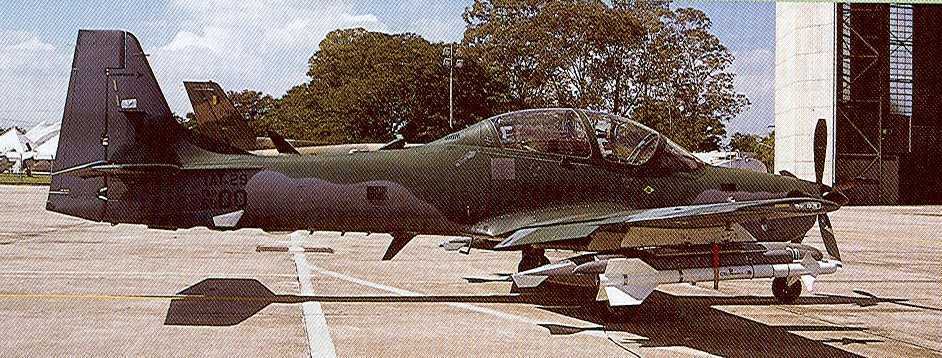
Here a Brazilian AT-29 SuperTucano trainer/attack plane shows an AAM armament. The Brazilians definitely learned this lersson from their neighbors down south. Are we so rich and arrogant that we can afford planes that can't fight when we need 2 seaters for observation/attack? Do you realize the F-35 Joint Strike Fighter does not have a 2-seat version planned? We will use "simulators" to train JSF pilots. Yeah, right. Watch when we start killing JSF student pilots and everyone will run around like their heads were cut off desperate for a 2-seater.
Notice the Eurofighter already has a 2-seater:
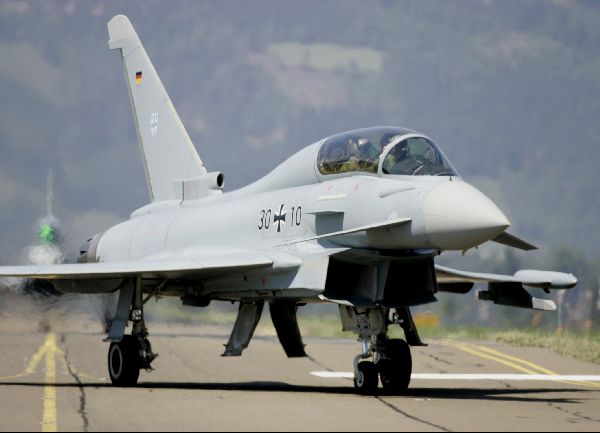
The Argentine MB 339 jet trainers had some success attacking British ships. Had they been better equipped with anti-ship weaponry "icing" they would have been devastatingly effective. Not only is it no longer needed to get into a tail chase position to launch short-range infared AAMs, its now longer needed to have the nose pointed at the target!
Its become clear to me that had the Argentine Mirages/A-4s had the kind of AAMs (good icing) that the British Harriers had that could fire as soon as a target was spotted and in range without requiring tail-chase position, even though they were short of fuel to maneuver due to poor basing decisions and a lack of in-flight refuel tanker planes (bad cake), they would have shot the Harriers down, gaining air superiority to such a degree that the Royal Navy would have had to leave or be sunk.
We don't think the RN's anti-aircraft missiles on their weakly armored ships alone could have enabled them to keep from getting sunk.
Good icings like all-aspect AAMs and helmet aiming should be applied to ALL of our aircraft because on the non-linear battlefield no place is safe from anything. Notice we are not doing this in our snobbiness.
What we are trying to do is replace durable, manned platforms (good cake) with disposible unmanned platforms that we can use as ordnance (icing). In other words, all icing, no cake. That's RMA DoD's madness, spend little money/thought on platforms and humans*, just spend money on "precision" ordnance. In other words, instead of empowering humans they want to either further human snobbery (reserve technologies to only favored cliques) or take humans out of the fight (alleged humanitarian reasons actual motivation is technosnobbery: the man pushing the button is king, you ain't involved, you ain't shit).
The problem with all-icing-and-no-cake (to continue the analogy), is that you can't get it into your mouth ie; you need the cake (platform). To get from A----->B there are minimalist approaches indeed, the V-1 cruise missile and V-2 ballistic missile, the battleship/artillery gun come to mind. However, as we know DoD permeated with RMA mentalities think all human warfare is is FIREPOWER bombardment, if they can turn everything into a video game they think they will win. They are totally out of touch with what war really is, a contest of whose will (ideas) dominates and the need for the MANEUVER of human platforms (minimalist: the body is a platform) to control the ground which people live on.
We see UAV/UCAVs as ordnance "icings" not durable "cake" platforms that we can rely on to come back and do missions again and again. We still need manned cake platforms to MANEUVER to find the enemy to attack themselves as well as send in UCAVs to "pour it on".
However, at rate we are going we are headed for a military disaster when we find that we had spent too much money/thought on mental directed firepwer icing and not enough getting us good, physical cake (insuring our ships do not get sunk or aircraft shot down, ground troops with MAS etc.).
The Red Chinese are ahead of our USAF/USN/Mc, but we are now finally fielding helmet-mounted weapons sights in our fighters so the pilot if he turns his head and sees a threat, he can fire AAMs at it without wasting precious seconds steering his nose to face the threat.
So yes, if we applied helmet mounted sighting systems like we have had for years to steer AH-64 Apache helicopter gunship's 30mm cannon to A-10s, A-4s, AY-65s and our slower MAS aircraft they could blast the sexy MIGs from the sky if they try to engage us.
Countries with tighter budgets than ours have learned lessons from the Falklands war and are applying shoot-from-any-direction AAMs to ALL of their aircraft even trainer/attack planes to GAIN FORCE-WIDE capabilities while our fighter jock egotists conveniently keep such technologies to themselves and their ego platforms. For example, our A/C-130s, C-17s, P-3C Orion ASW and E-2C Hawkeye AEW planes should have helmet sights/AAMs to defend themselves. We are living in la-la land if we think no MIGs are ever going to leak through and attack these "support" planes.
* Even the AMRAAM might not be enough to ward off enemy fighters due to its range letting them also get within their own medium missile ranges. War is an extreme activity that comfortable peacetime garrison practices may simply not yield enough of an advantage over the enemy to win. We need to develop a way for two F-16 or A-4 SkyHawks and jet ski/floats or two F-35B STOVL fighters with AMRAAM/Sidewinder SRAAMs to meet up with the A-40 after separate take-offs and then "hook up" to a wingtip towing cable on the A-40's wings so they can by with the A-40 while on patrol but appear to be one radar blip to the enemy. If the enemy scrambles fighters to intercept the A-40, the two "parasite" fighters can detach and meet the threat to shoot it down. The parasite fighters if undamaged could hook back up to the A-40 or divert to a submarine aircraft carrier or surface ship to land.
3. Do you want a Navy or don't you? ALL surface ships need STOVL attack jets
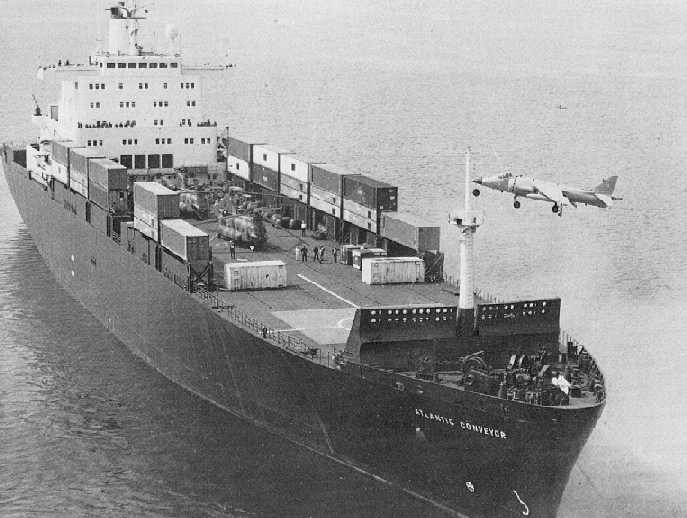
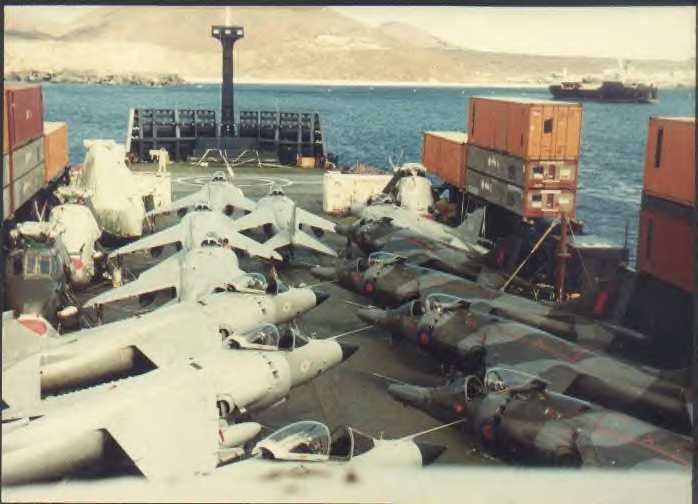
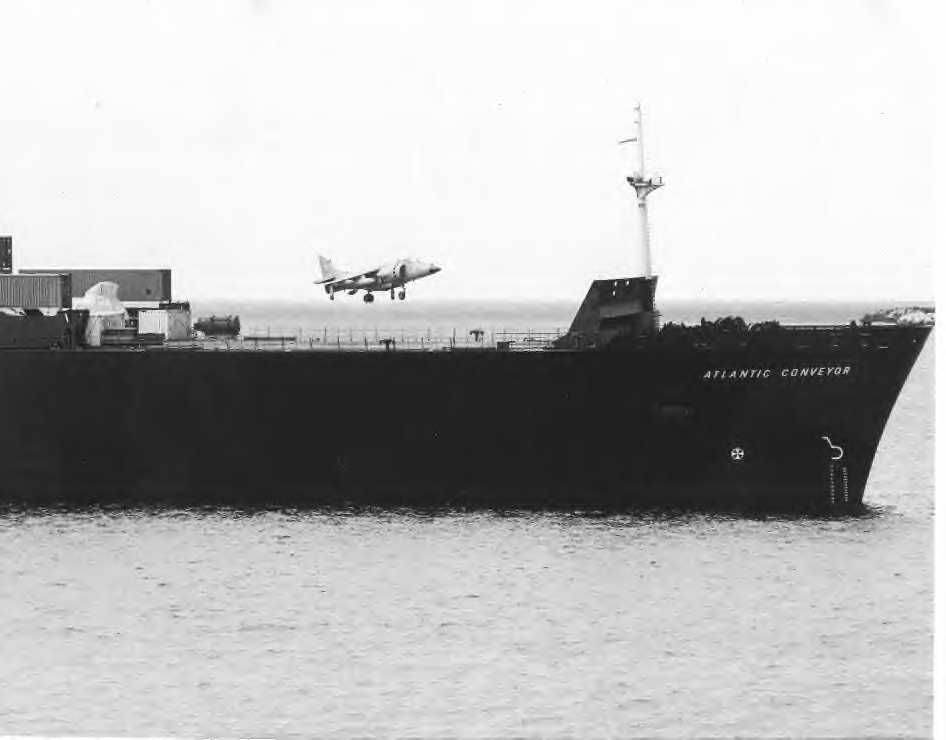
One of the things the Brits realized was that they did not have enough deck space for all the Harrier STOVL jets their surface ships needed to survive against Argentine air attacks. They crammed extra Harriers on the Atlantic Conveyor, Atlantic Causeway container ships made into an expedient aircraft carrier using ISO containers to form walls to break the wind/sea spray. They also refueled and rearmed Harriers from the stern flight deck of destroyers and frigates.
The main British HMS Ocean amphibious carrier, is a CONVERTED MERCHANT SHIP. They are hanging on with their fingernails just to exist.
Could Britain retake the Falklands today?
http://thescotsman.scotsman.com
Fri 5 Apr 2002
Soldiers celebrate after taking Mount Tumbledown, a key moment in the campaign.
http://news.scotsman.com/email.cfm?id=365372002
Could Britain retake the Falklands today?
Gethin Chamberlain
WHEN the British task force set sail for the Falklands 20 years ago today, confident, cheering crowds waved off the troops, buoyed by a sense of moral outrage at the most serious affront to the nation's sovereignty since the Second World War.
But even before the strains of Don't Cry for Me Argentina and We Are Sailing had faded away, military strategists were questioning whether Britain still had the capability to conduct a war 8,000 miles away in another hemisphere.
Today, the anniversary of the start of Britain's last colonial war, those questions are still being asked, but 20 years of cuts to defence spending have fuelled the fears of those who believe that the country no longer has the capability to mount such an ambitious military adventure.
Even 20 years ago, the prospects for a British victory were by no means certain. Margaret Thatcher, then the prime minister, was aware she was taking a gamble that would destroy her if it failed to come off.
Luck played as big a part as military bravado and flair.
Had the Argentines waited a few months longer, the outcome might have been very different.
John Nott, the defence secretary at the time, was proposing to sell off two of Britain's carriers, HMS Hermes and HMS Invincible, and get rid of the assault ships HMS Fearless and HMS Intrepid. If the cuts had gone ahead, it is doubtful whether the task force could ever have set sail.
Twenty years on, the navy is in an even more parlous state. According to the military historian Trevor Royle, many of the factors that helped Britain to victory no longer exist.
During the Falklands War, the Sea Harrier fighters operating from the decks of the carriers were a match for the Super Etendards and Mirages of the Argentine air force, but he believes a modern task force operating so close to its opponents' home airfields today would find itself far more vulnerable to air attack.
"The Sea Harriers, which operated as fighters, are being replaced by ground attack versions of the veteran aircraft, and they can no longer be expected to provide effective fighter cover," he said.
Britain still has three small carriers - HMS Ark Royal, HMS Illustrious and HMS Invincible - but plans for two large aircraft carriers are still in their infancy, with no realistic chance of the vessels becoming operational for another decade, if ever.
Carriers capable of carrying a range of modern aircraft, including reconnaissance and early warning planes, are seen as crucial to Britain's ability to conduct a future Falklands-style operation.
Commodore Michael Clapp, the commander of the naval task group during the Falklands War, believes successive British governments have failed to learn the lessons of 1982.
"I think we are in an extremely dangerous position until the carriers come and the Argentines know it once again. That's why they invaded last time, because they thought we were selling the carriers and the landing ships and we weren't interested in defending the place.
"I find the politicians beyond belief because the defence budget has gone right down and it is so small compared to what it used to be, even in the '60s.
"We have still got these other dramas and if Blair wants to keep us in Afghanistan and all those other places he really ought to give the services a bit more money because we are going to get caught out again. They are stretched all over the place."
Defence spending has more than halved as a share of gross domestic product since the Falklands War and the British armed forces have suffered as a consequence.
Last month, the assault ship HMS Fearless was retired eight months ahead of schedule and the navy has only one amphibious support ship, HMS Ocean, a converted merchant ship. The navy now has only 31 frigates and destroyers, down from 50 in 1982, and four landing ships instead of six.
All three services are smaller than when the Argentine junta gave the order to invade and the army is 15,000 below strength.
During the Falklands War, commercial ships such as the Canberra played a vital role in transporting the troops to the islands, but with many British-registered vessels now under foreign ownership, no guarantee could be made that they would be made available for such an operation.
Other factors also played a crucial part in the British victory. The loss of even one carrier would have placed the entire operation in jeopardy, but the carriers escaped attack from the Argentine air force.
The failure of the Argentines to set the fuses on their bombs to explode on impact might have spared six ships and saved the entire operation.
At least six bombs smashed through British ships without detonating. Lord Craig, the former marshal of the Royal Air Force, is said to have remarked: "Six better fuses and we would have lost."
But despite the pessimism over the resources available, Royle believes one important factor would still enable such an operation to succeed - political willpower.
"I believe Tony Blair would try it, even with the limitations," he said. "He's shown himself well capable of that . He made such a noise in Washington about sending British combat troops that eventually they took him up on his word.
"He has the same instincts that Maggie Thatcher had, that there is a direct relationship between military success and political popularity."
USN/Mc Lessons not learned:
We snobby American however, will sneer that our "super carriers" and other expensive warships have plenty of deck and hanger space for all the attack jets we could ever want, in fact more capable planes than STOVL types because we use catapults and arrestor wires to snag tailhooks. First, because of bureaucratic stupidity, USN/Mc naval aviation is dying; S-3 Viking ASW/tanker planes are retired. F-14 Tomcats with long-range AAMs are almost gone. A-6 Intruder, A-7 Corsair II and A-4 SkyHawk attack planes are gone. Other than helicopters, all the supercarriers have are under-powered, bloated F-18s trying to do every mission and C/E-2C Hawkeye radar planes. So the Hawkeye sounds the alarm that enemy ASMs and fighters are in bound. WHAT WILL THE SUPER CARRIER DO ABOUT IT? Baton down all hatches and take the punishment? Or try to launch all planes off the deck? What if the ASMs start landing before all planes are removed? USS Forrestal fire all over again?
The knocking out of our supercarriers by enemy ASMs, diesel-electric submarines or seamines means the rest of the surface fleet would be without ANY air cover and forced to flee the battlefield. Victory for the enemy.
FIXES:
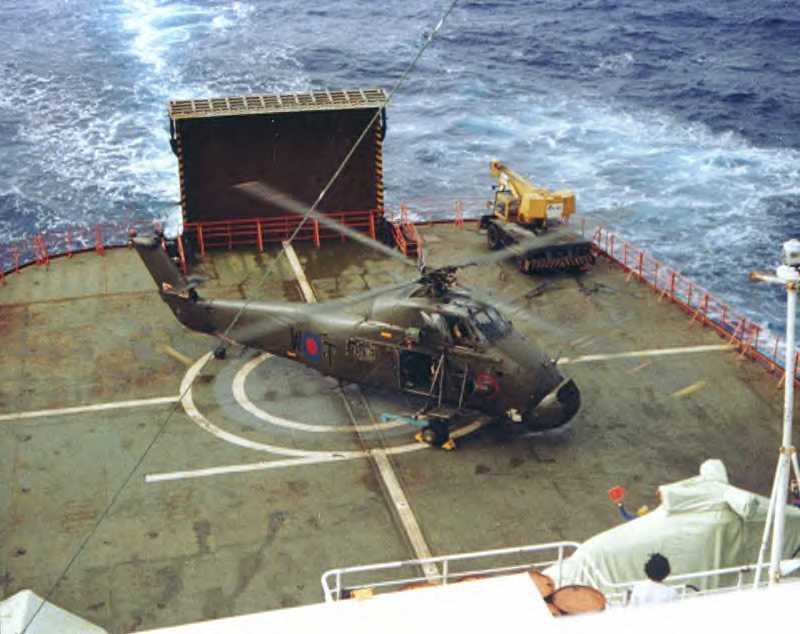
* Its high time we start facing the possibility that our expensive carriers will be wiped out and to start routinely deploying a F-35 STOVL JSF with ASW helicopters on the stern deck of our frigates, destroyers and cruisers. With a light cannon and AAM load, they should be able to take-off vertically for air defense missions. At least 6 could be on an Iowa class battleship if brought back to duty:
www.combatreform.org/battleships.htm
* We need to hurry up and get the safe lift-fan F-35B STOVL attack jet into service.
* Folding-wings should be standard on ALL F-35 JSFs to fit at least two aircraft on the back of small surface ships
* Develop a heavy fuel jet engine for F-35 JSF so it can burn the same JP-5 the ship uses
* Field several "Container Ship Aircraft Carriers" with STOBAR operating capabilities so aircraft can fly to them and operate when the supercarriers are knocked out of action. Details:
Straight Flight Deck (like converted British container ship, RM Argus)

STOBAR angled deck arrangement possibilities:
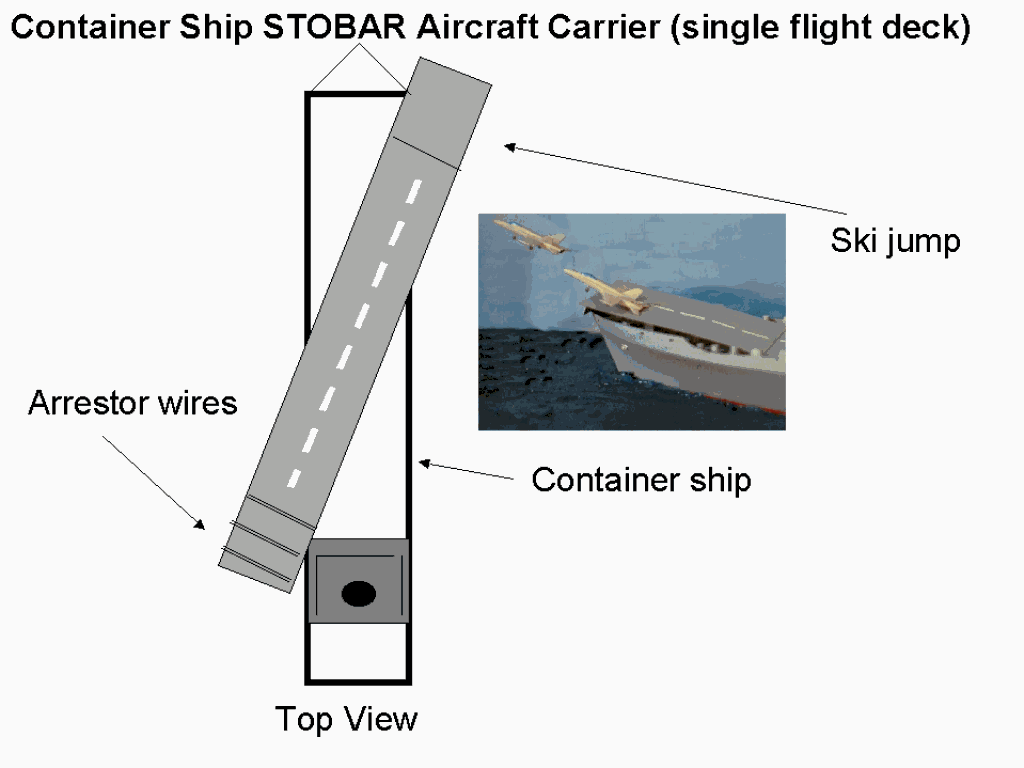
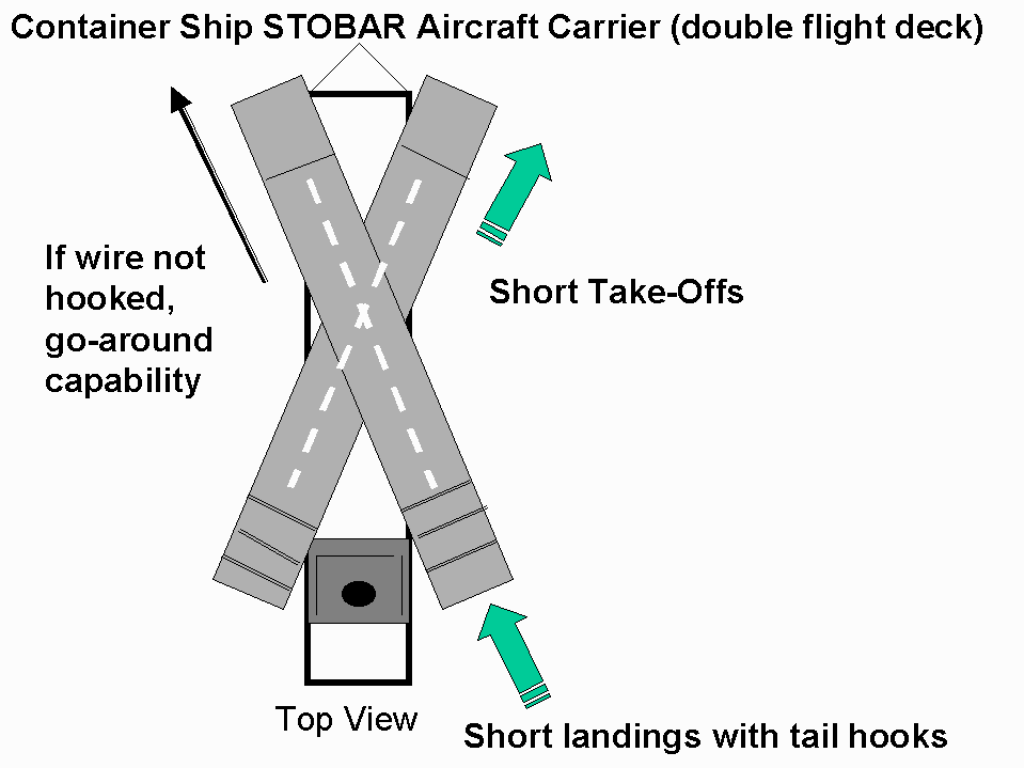
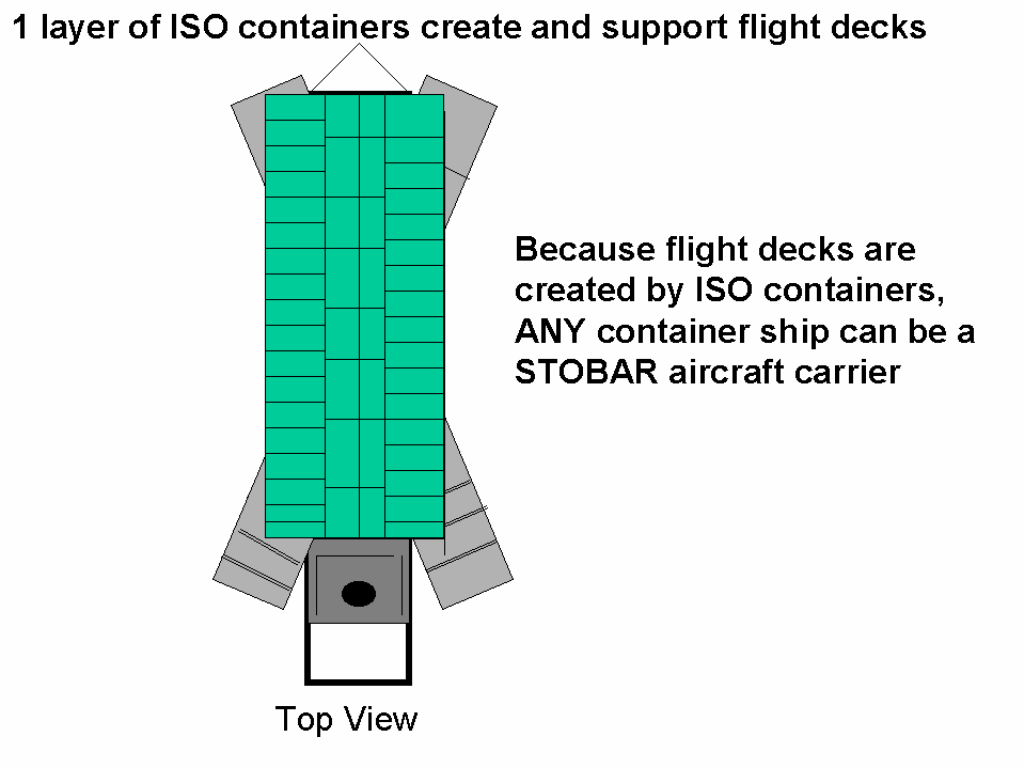
British have already done it: Container Ship Conversion to Aircraft Carrier: Arapaho, SCADS and SkyHook
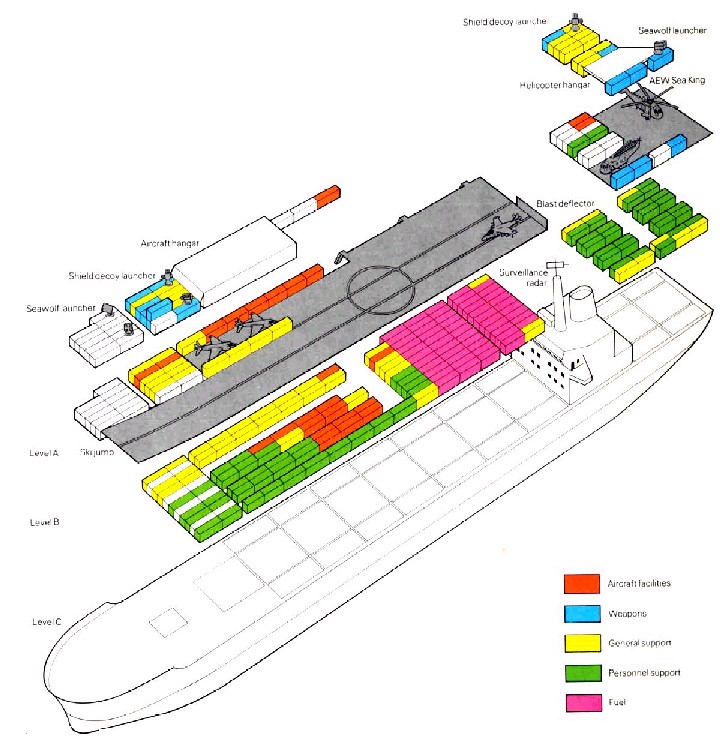
http://home.planet.nl/~alder010/Future/Future.html
Future and Specials
In the late 1960s the U.S. Navy had conceived the "Arapaho" programme, under which a container ship would be modified to permit testing of its suitability to operate special mission helicopters. The aim at that time was to allow a significant proportion of wartime convoy escort and sealane protection tasks to be performed by such ships, manned by USN reservists. The Arapaho concept involved an LPD-size flight deck 200 feet (61m) long and 64 feet (19.5m) wide, and a 4,000 sq ft (372m²) hangar large enough to accommodate four Sea King [amphibious] helicopters. The complete installation weighed 900 tons, and could be installed on a container vessel in less than 18 hours.
In 1982 such an installation was emplaced on the 18,000-ton Export Leander, and 178 helicopters landings and take-offs were performed. In the following year the Arapaho equipment was leased by McDonnell and installed by Camel Laird at Birkenhead on the 27,900-ton MV Astronomer (subsequently renamed RFA Reliant) for tests in the South Atlantic.
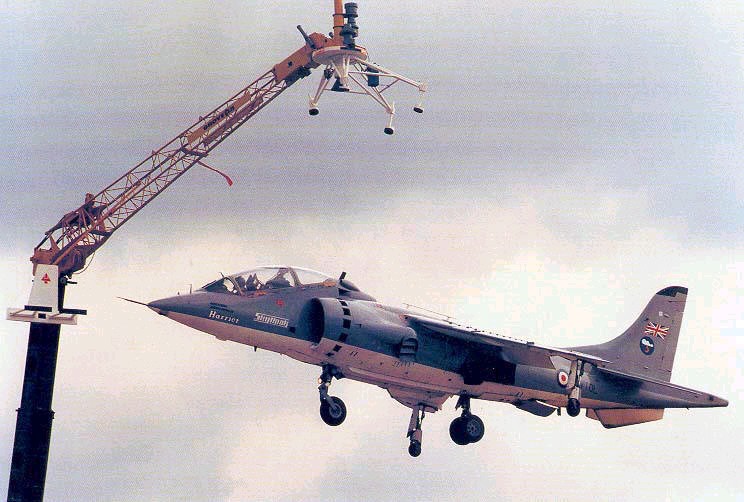
In efforts to exploit the sales potential of the Sea Harrier, which rested largely on its ability to operate from small, inexpensive ships, British Aerospace proposed the installation of ski-jump decks on commercial vessels, and the "Skyhook" concept that would allow such aircraft to operate in the VTOL mode from ships without any form of aircraft deck.
"Skyhook" was invented by Heinz Erwin Frick (a BAe test pilot of Swiss descent) and the corresponding specification No.2104014 was filed with the British Patent office in 1982. Frick had been struck by the ease with which a Sea Harrier can be hovered with great precision, regardless of wind variations. It occurred to him that if this hovering accuracy could be combined with a space-stabilised "Skyhook" on a ship, then it could provide the means for the aircraft to recover to a highly mobile deck. If the design of the ship precluded the use of a ski-jump take-off, then the aircraft could depart from the "Skyhook", although its warload radius performance would then be much more limited.
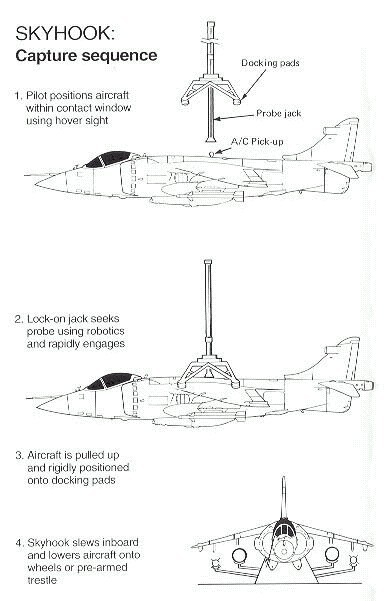
The concept required very little modification to the aircraft itself - simply a hoisting point above the centre of the gravity and possibly some local strengthening. If the operator wanted to refuel the aircraft while suspended from the "Skyhook", this would require modification of the fuel system, but it would still represent a minor expense. The major development task would be the advanced technology crane, presumably with an inertial platform in its base sending commands to a fast-acting hydraulic system that would keep the head of the crane moving linearly through space.
The computations for the crane system were based on the RN's 4,250-ton Sheffield class of destroyers, and the design allowed for sea state 6, to give uninterrupted operations in the North Atlantic for 97% of the time. Using a special form of display attached to the crane head to assist the pilot to hover accurately, it was concluded that the aircraft could easily be placed within the 'capture envelope' of the "Skyhook". Engagement was to be performed by a robot system, scanning IR-absorbent patches bonded to the upper surface of the aircraft around the pick-up probe, and moving the hook accordingly. An IR engagement-control system was proposed in order that the aircraft could be illuminated in night recoveries without affecting the pilot's night vision.
Despite the very limited warload-radius performance available from the "Skyhook" launch (which would be less restricted in the case of an AV-8B), the concept undoubtedly has some potential in the context of convoy protection and in providing an outer defensive perimeter by making use of radar picket ships around a conventional carrier. However, BAe estimated in the mid-1980s that the system would cost around $12 million to develop. The company also insisted on acting as prime contractor for "Skyhook", rather than granting a licence (eg, to a company in Japan, where the concept might have special attractions). In the event, UK-MoD showed no great interest and BAe was unwilling to invest its own funds in the project, so "Skyhook" has been filed away, at least for the present.
www.secretprojects.co.uk/forum/index.php?topic=1304.msg11194
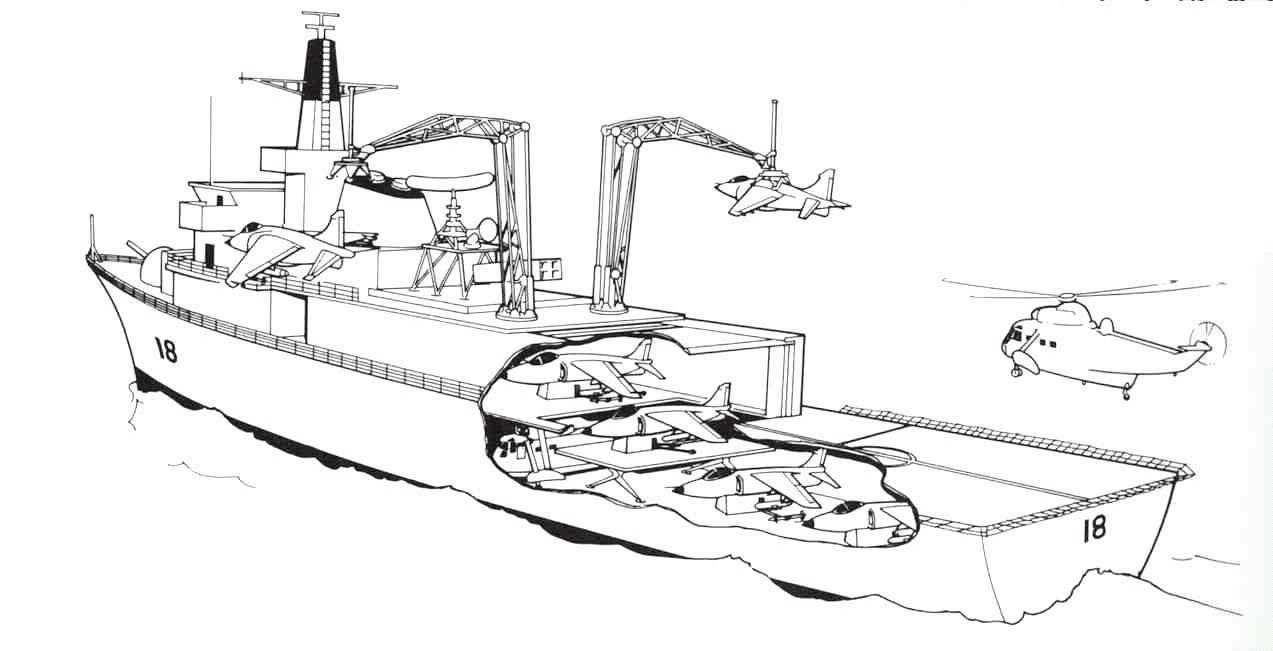
After the idea of SCADS BAe also came up with the SkyHook idea. The initial idea saw BAe propose two ships, one in their patent application (www.google.com/patents?vid=USPAT4523729&id=IcEyAAAAEBAJ&pg=PP2&dq=heinz+frick) and one used in publicity brochures.
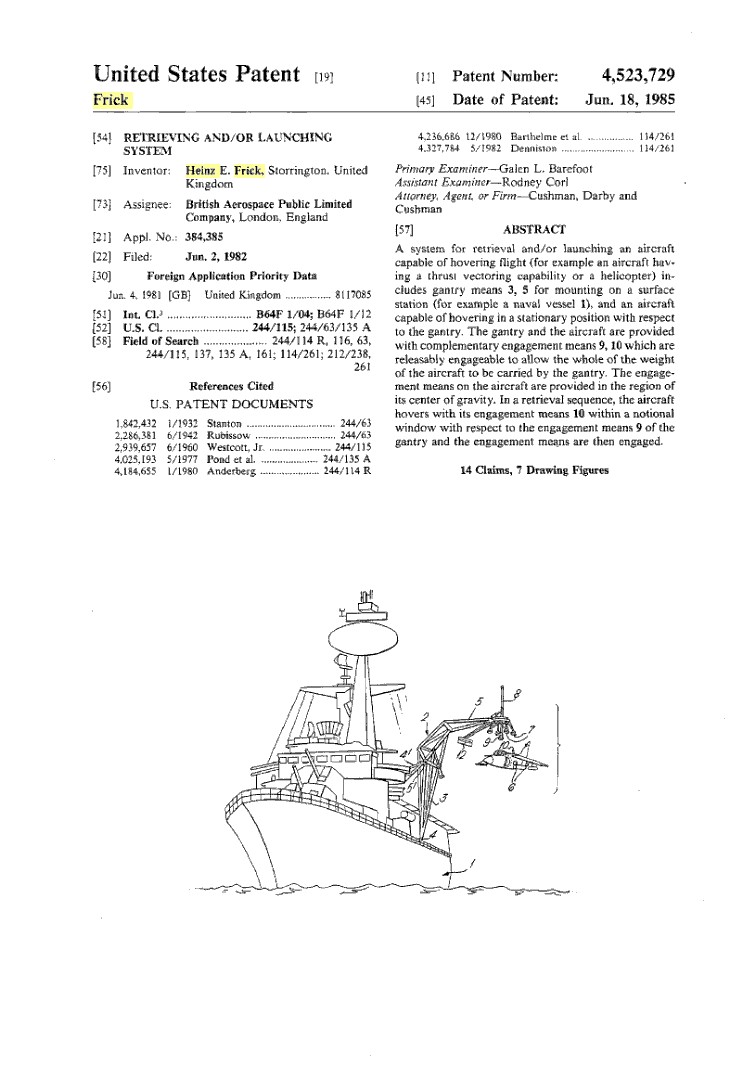
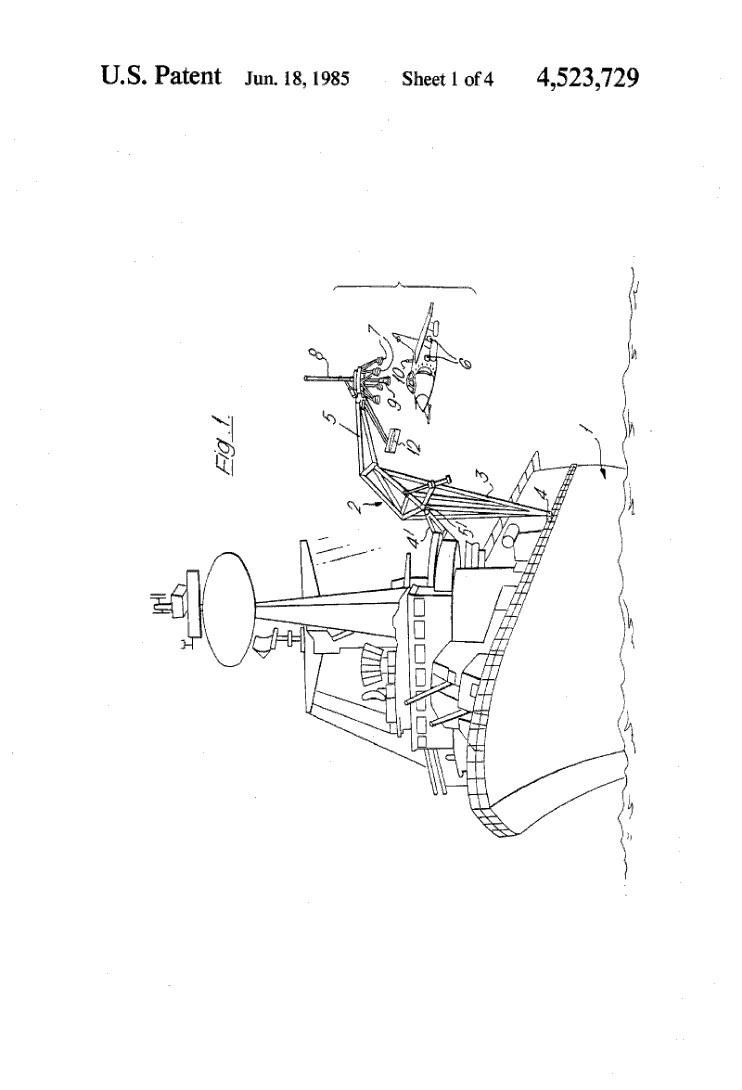
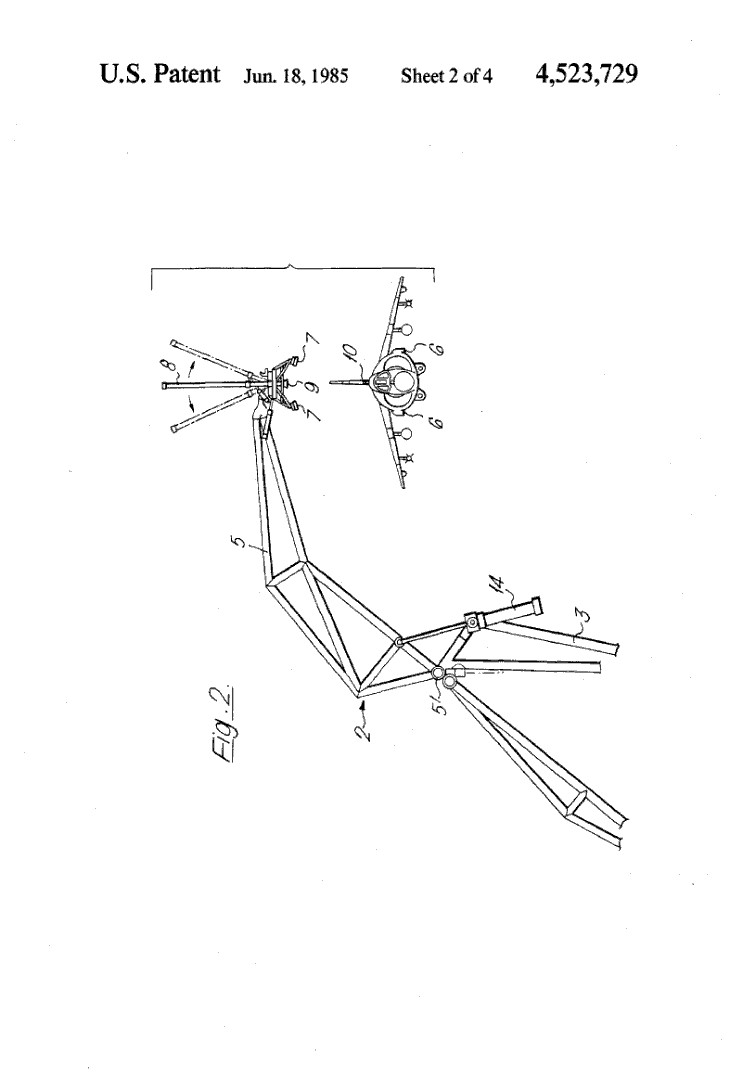
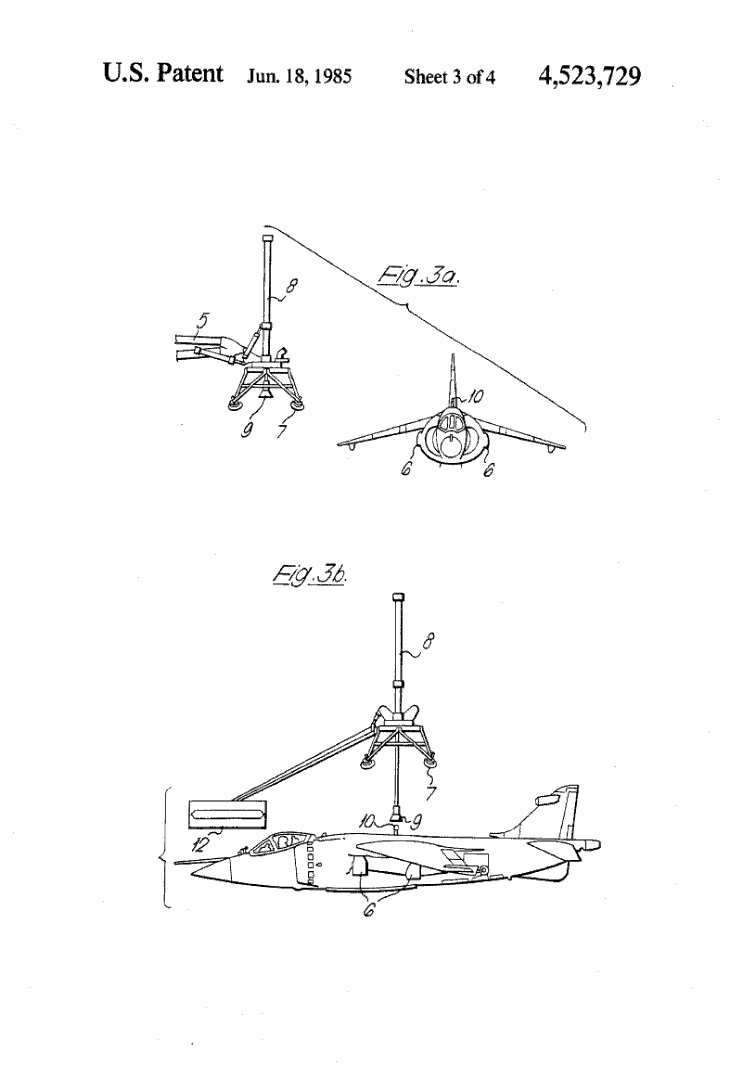
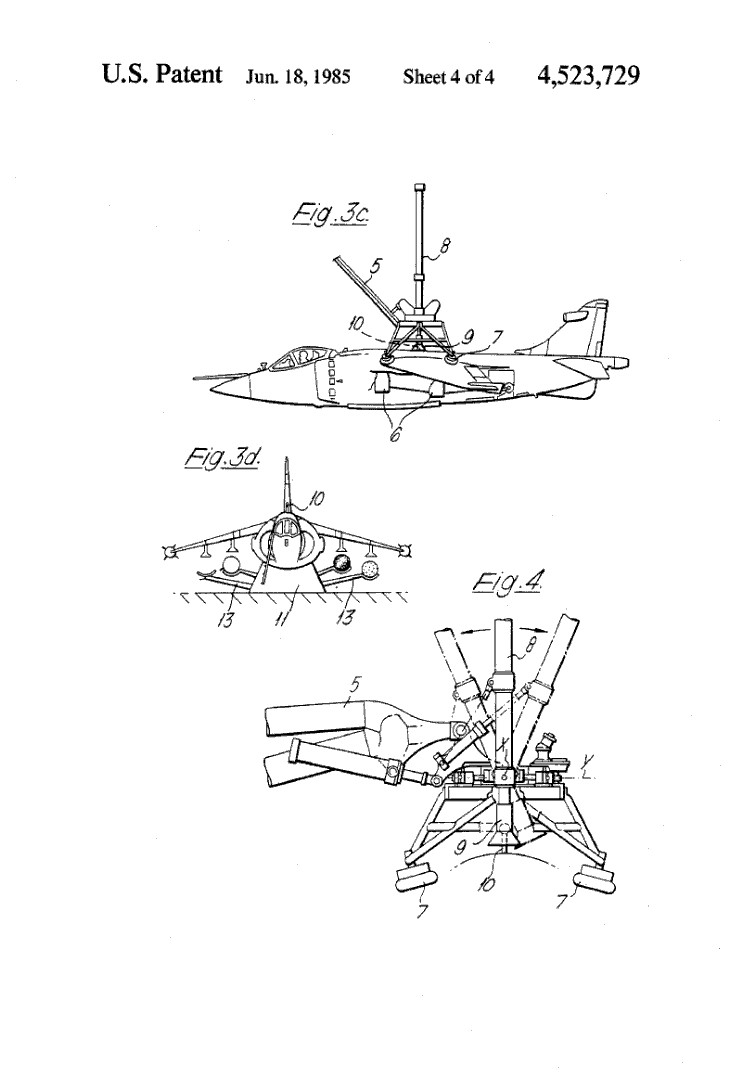
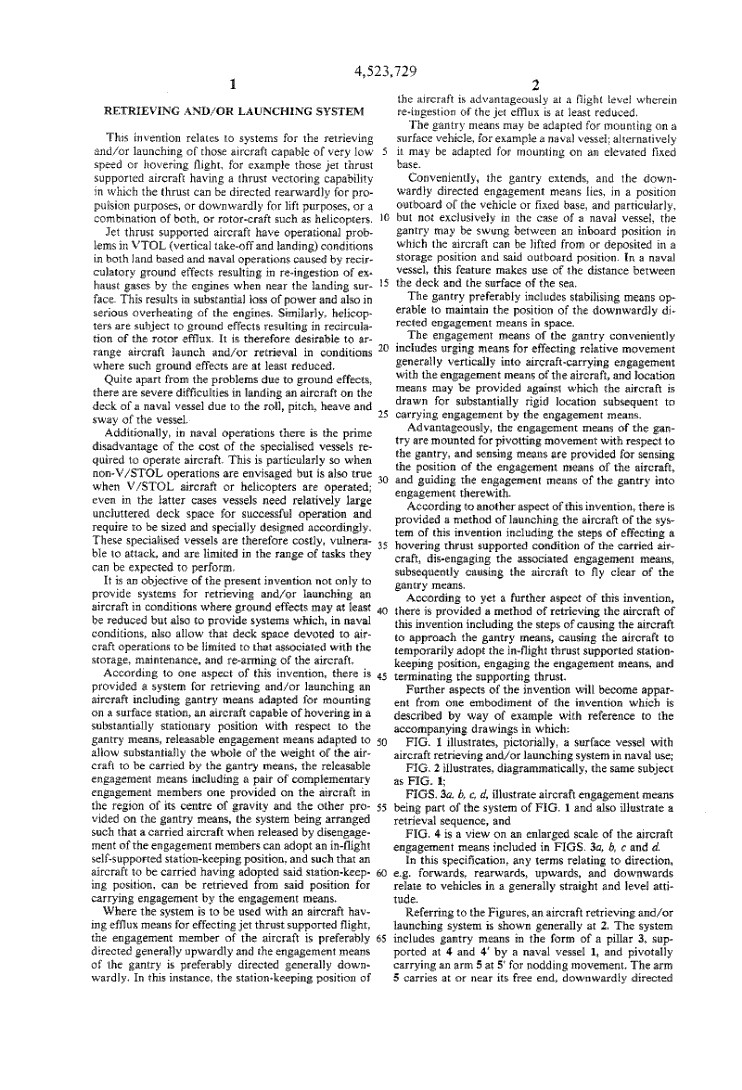
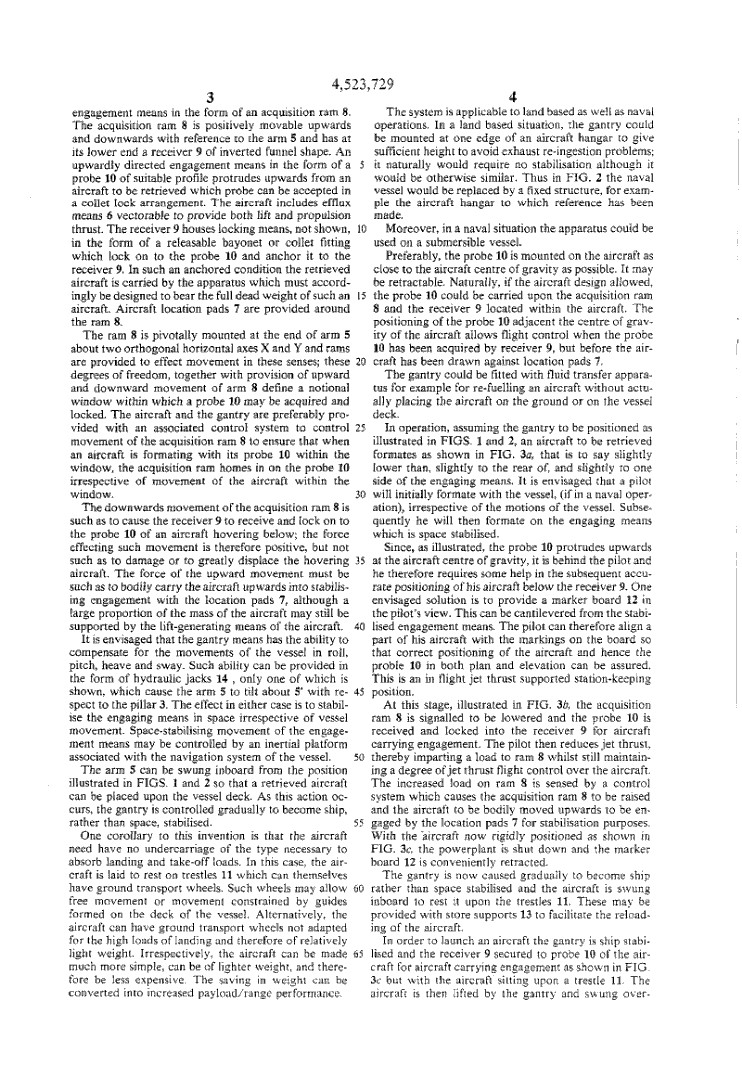
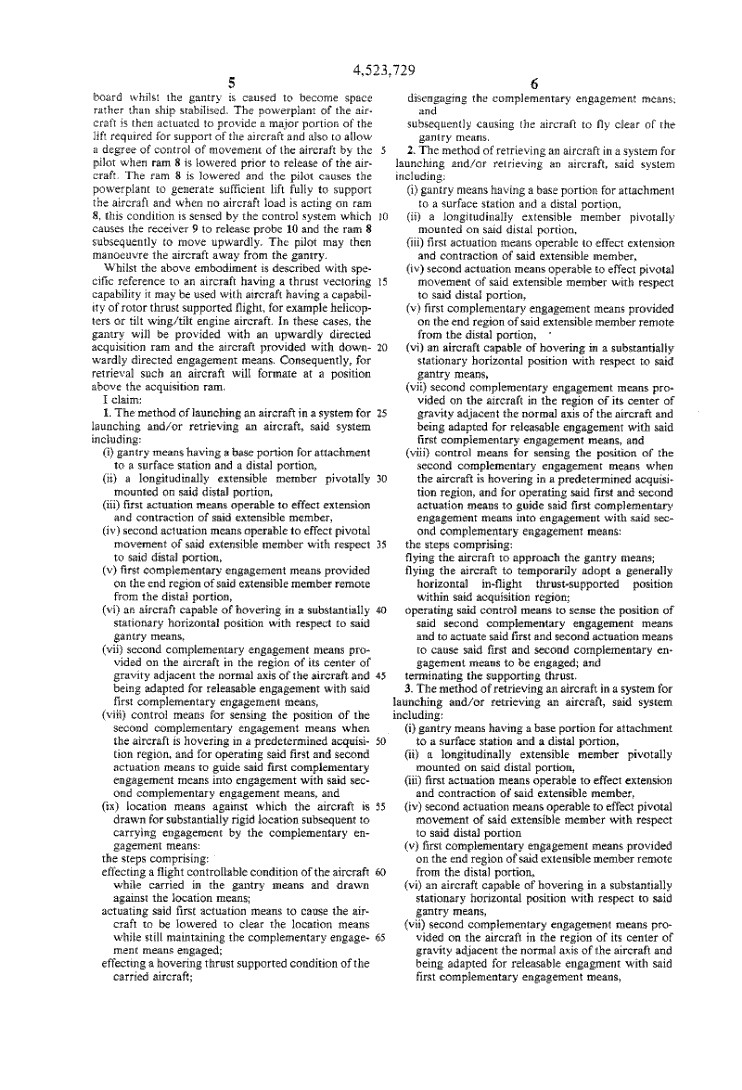
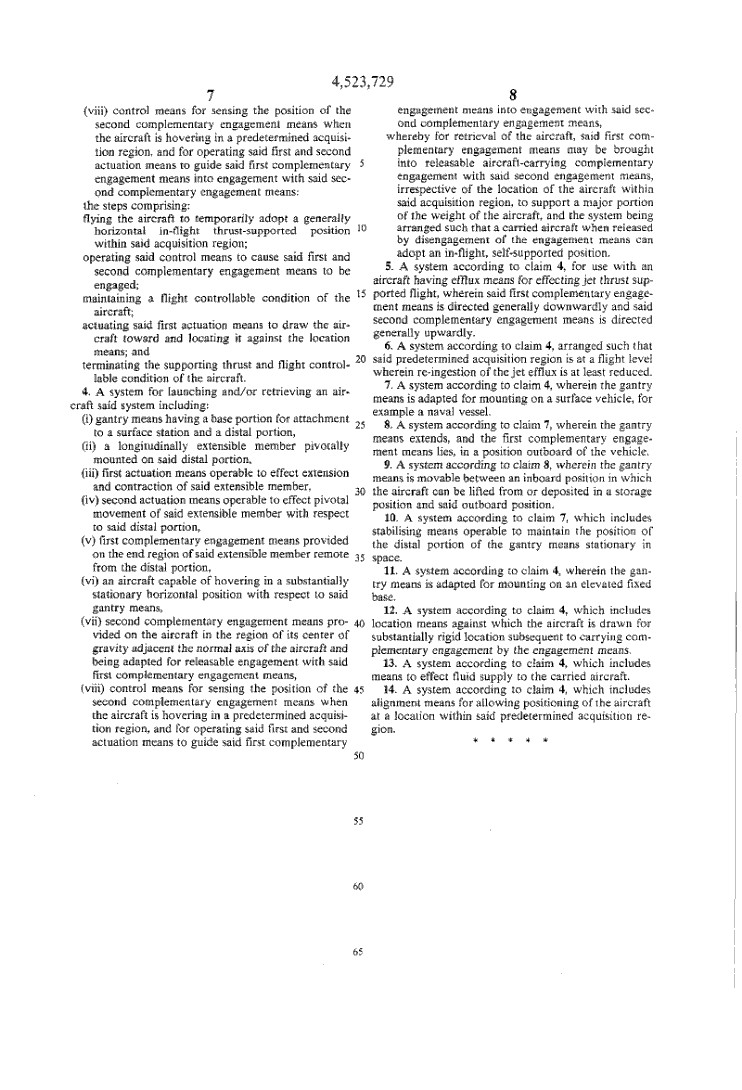
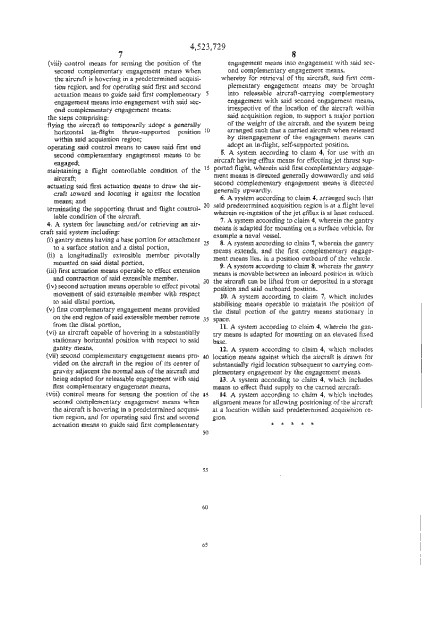
Both relied on SkyHook for take-off and landing, probably not too practical.
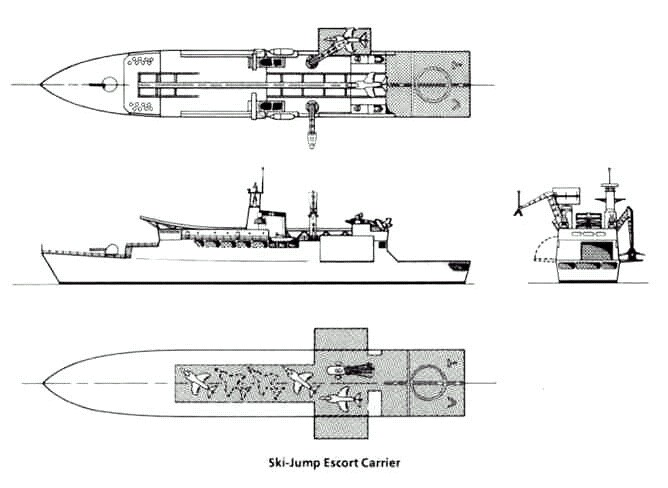
However, VT designed a "proper" ship around the concept and this featured a skeletal ski-jump atop the supersturcture for take-off. This increased payload, with recovery via SkyHook. Aircraft were stowed in a hangar with lateral doors for entry/exit, SkyHook being used to move aircraft to the launch position.
2x 25mm Sea Dragon CIWS, 1 medium gun, plus 16 x VLS missiles for defence.
5,200 tons diplacement, 416 feet 8in OA
45,000 shp = 26kts
5 x Sea Harriers, one helo.
The idea was to use the ship as a "forward base", allowing greater endurance in CAP patrols, with the aircraft returning to a large carrier for major maintenance. In other words, a naval version of the Harrier's land-based use of forward operating strips.
4. Bring back heavily armored gun missile battleships
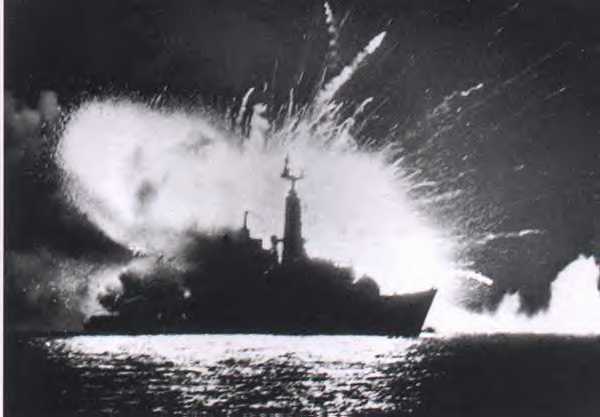
The Argentines did not sail the (former too-light Washington Treaty cruiser USS Phoenix) Belgrano light cruiser with 6 inch and other guns (but no modern ASW/anti-air war weaponry) into Stanley harbor long before the British arrived to act as a mobile AAA battery to defend the 4, 000 runway there from British aircraft attacks. If they had, they would have been able to use her guns to bombard for the Argentine ground forces. Instead, they tried to sail the Belgrano as an escort to their lone aircraft carrier and got her sunk by a British nuclear submarine's torpedoes. The Argentine surface fleet then turned around and did a "Jutland" and refused to fight for the rest of the war. The British used their tiny 4.5 inch guns to try to help ground troops with fire support but had to be close to shore and paid for this dearly by several ships sunk by Argentine A-4 SkyHawks.
The USS Phoenix/General Belgrano was a Washington Treaty limited LIGHT cruiser with inadequate armor even by WW2 standards.
During WW2, it kicked ass in the hands of American Sailors using AAA firepower to shoot down enemy planes in the inner defense ring and offensively bombarded shore targets to facilitate U.S. ARMY ground maneuver, hence its lack of glory because it wasn't helping the USMC BS worship-thyself propaganda machine.
http://en.wikipedia.org/wiki/USS_Phoenix_(CL-46)
However, at the end of WW2, we sold it to Argentina who did not fix its armor problems so the following comes as a stern (pardon the pun) warning about our own class of under 10, 000 ton destroyers/cruisers:
http://en.wikipedia.org/wiki/ARA_General_Belgrano
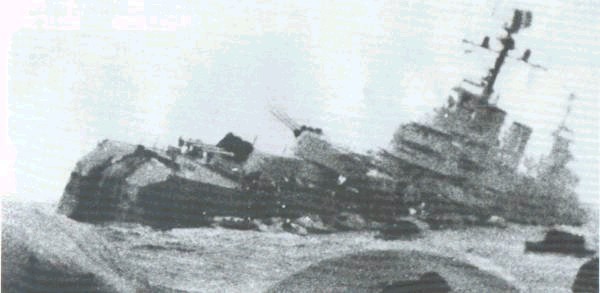
At 15:57 on May 2, [submarine HMS] Conqueror fired three conventional Mk 8 mod 4 torpedoes, each with an 800 lb (363 kg) Torpex warhead, two of which hit the General Belgrano. The Conqueror was also equipped with the newer Mark 24 Tigerfish homing torpedo, but there were doubts about its reliability. The Mk 8 dated back to the 1920s and was not a homing design. [1]One of the torpedoes struck between 10 and 15 metres back from the bow, outside the area protected by either the ship's side armour or the internal anti-torpedo bulge. The effect of this was to blow the bow of the ship off, but the internal bulkheads held and the forward powder magazine for the 40mm gun did not detonate. There was nobody in that part of the ship at the time of the explosion.
The second torpedo struck about three-quarters of the way along the ship, just outside the rear limit of the side armour plating. The torpedo punched through the side of the ship before exploding in the after machine room. The explosion tore upwards through two messes and a relaxation area called "the Soda Fountain" and finally ripped a twenty metre long hole in the main deck. Later reports put the number of deaths in the area around the explosion at 275 men. There was no fire after the explosion, but the ship rapidly filled with smoke. The explosion also damaged the Belgrano's electrical power system, preventing her putting out a radio distress call.
Though the forward bulkheads held, water was rushing in through the hole created by the torpedo and could not be pumped out because of the electrical power failure. The ship began to list to port and to sink towards the bow. Twenty minutes after the attack at 16:24 Captain Bonzo ordered the crew to abandon ship. Inflatable life rafts were deployed and the evacuation began without panic.
The two escort ships were unaware of what was happening to the Belgrano, as they were out of touch with the Belgrano in the gloom, and had not seen the distress rockets or lamp signals. Adding to the confusion, the crew of the ARA Bouchard felt an impact that was possibly the third torpedo striking at the end of its run (an examination of the ship later showed an impact mark consistent with a torpedo). The two ships continued on their course westward and began dropping depth charges. By the time the ships realised that something had happened to the Belgrano it was already dark and the weather had worsened scattering the life rafts.
Argentine and Chilean ships rescued 770 men in all from May 3 to May 5. In total 323 of the Argentine crew were killed in the attack.
USN/Mc Lessons not learned:
The USMC says it wants Iowa class battleships that are extremely heavily armored and with 16 inch guns to render fire support ashore that can keep the ship at least 20 miles away, but have not told Congress to take 4, 000 man-slots from their bureaucratic empire to pay for the sailors needed. The USN in their needing a constant excuse not to fight, keeps buying fragile, unarmored surface ships full of gadgets when what they need is Iowas bristling with modern anti-aircraft and anti-missile guns/missiles to keep their carriers, cruisers, frigates, destroyers afloat in a surface action group.
Iowa class battleships can also sail into the narrow straits between Red China and Taiwanese islands to sink the many CHICOM amphibious ships and swimming light tanks with lots of gunfire. We cannot afford to expend $ million dollar missiles on every CHICOM amphibious tank we spot.
www.geocities.com/armorhistory
FIXES
* Bring back two Iowa class battleships immediately
* Take the two Iowas back from the possibly money grubbing museum folk in Hawaii and Pennsylvania
Message to any of the USS New Jersey and USS Missouri museum folks who would oppose these ships being returned to duty to defend America:
1. FU*K YOU.
2. If we do not have a dam country because we have several cities turned to ashes in nuclear war with Red China we will not have any dam time to be visiting your fu*king floating museums and dropping dollars at the door. If you are such "patriots" start acting like it.
5. Ski Jumps and Expeditionary Dispersed Operations of aircraft ashore

ON LAND...

The British operate their Harriers with ski jumps to gain a boost of lift/altitude upon take-off, even on land they have ski jumps composed of medium girder bridge sections; USMC does not and has a horrendous death/accident rate, see the connection?
On the Falklands Islands, Stanley airport had a 4, 200 foot runway that was 148 feet wide [Battle for the Falklands: Air Force, Roy Braybrook, page 8]. A-4 Skyhawks can have JATO bottles fitted to take-off in 2, 000 feet and land as extremely short as you want with their tail hooks snagging arrestor wires like USMC did at Chu Lai in Vietnam. The runway was/is wide enough for two aircraft to take off in pairs. Had the Argentines placed A-4 Skyhawks with AIM-9L Sidewinder AAMs that can shoot down aircraft from any direction (not requiring tail chase position) and even dumb unguided bombs on Stanley airport they could have achieved air superiority versus the SeaHarriers coming from the mini-carriers and container ships and sank those ships. They would have had lots of range to venture out and aggressively attack British surface ships packed full of troops. In a nutshell, by doing A-4 SkyHawk EDO ops on Stanley airport the Argies would have sunk the British fleet and changed the course of military thinking for the better.
Instead, the Argentines kept their SkyHawks in centralized air bases on the South American mainland very far from the Falklands Islands so when they did attack they had no fuel for maneuver to do effective air combat against the British or evade air defenses to sink their ships. They could not repel the invasion fleet which landed ground forces who marched across the islands and took them back. If you cannot beat the British Army Soldier on the ground, you had best not let him land by sinking him in his invasion ships.
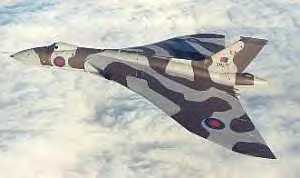
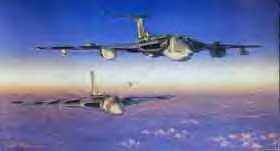
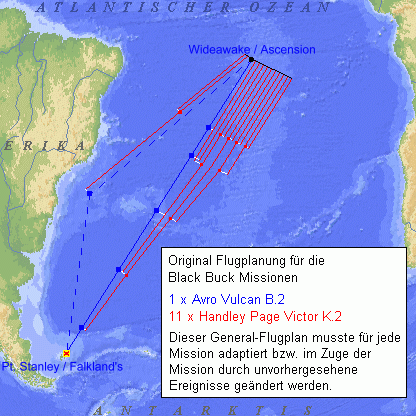
The British realized the possibility of EDO use of A-4 SkyHawks on Stanley airfield and tried to crater the runway with long-range Vulcan bomber strikes. We know that the Argentines used JATO for their C-130s to make downwind take-offs from Stanley airport during the war, so why they didn't exploit this with their A-4 SkyHawks remains a mystery. Some war gamers should refight the Falklands war with EDO SkyHawks and see what the outcome could have been.
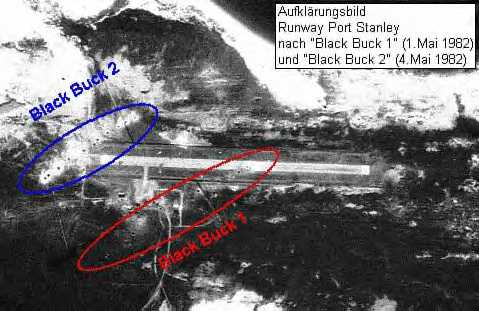
The British had to use 11 Victor tankers to get the single Vulcan land-based bomber from England to the Falklands to get one bomb load onto Stanley airport; the airport was NOT closed. So why didn't the Argies extend the runway for A-4 SkyHawks without JATO/arrestor gear could operate from there to sink British ships?
In contrast to the Argentine's missed opportunity to use the A-4/EDO combination, the British built a 800-foot aluminum mat runway at San Carlos for their land-based RAF GR.3 Harriers to operate using a short take-off roll and vertical landing to improve their responsiveness to ground force attack needs.
USN/Mc Lessons not learned:
The USN/Mc's F-18s have tailhooks but no brackets for JATO. Harrier STOVLs can do EDOs but are ducted direct thrust fanjets and unsafe with high accident rates. They need some rolling take-off and a boost of lift as a safety margin but USMC doesn't use MGB ski jumps ashore nor does USN have ski jumps on the end of LHA/LHD amphibious carriers. Lift-fan F-35B JSFs will be safer but they still need ski jumps.
Compare can-do Indian Navy to can't-do U.S. Navy....disgusting....they add a small portursion off port side to make an angled deck for STOBAR operations of MIG-29Ks and are building their own navalized fighter, too!
Meanwhile we can't do the same thing on our LHAs/LHDs so Harrier pilots can't kill themselves during take-offs?
INS Viraat, ex-HMS Hermes (of Falklands fame), is India's current and sole aircraft carrier after Vikrant was decomissioned. It also operates Sea Harriers and other aircraft and will be retired before 2010.
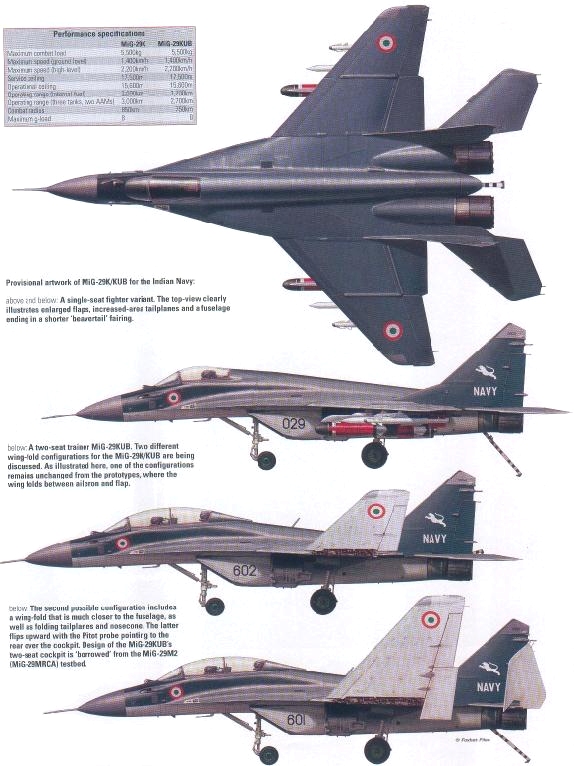
INS Vikramaditya, ex-RUS Gorshkov, is currently undergoing a huge refit. It will operate at least 16 x MiG-29Ks and possibly Sea Harriers as well. It will enter active service by 2008.
India's also building an indigenous aircraft carrier in the Air Defense Ship project. It will enter service around 2010, giving India a two-carrier navy, again. It will carry MiG-29Ks, and Navalized Tejas LCAs.
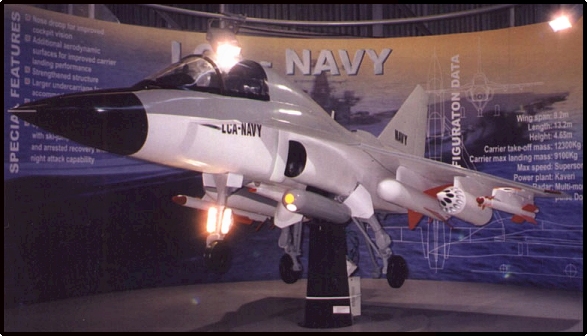
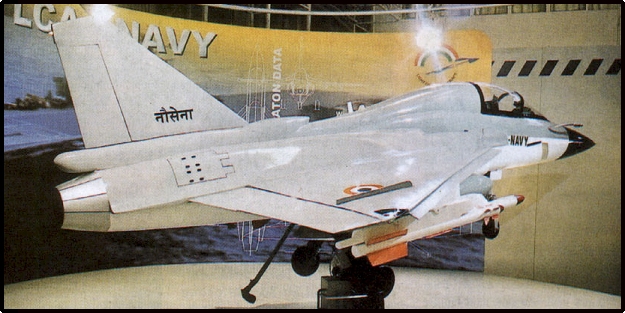
The LCA-Ns will take to the air around 2008-9.
New Gorshkov refit pics
http://www.militaryphotos.net/forums/viewtopic.php?t=31750&highlight=vikramaditya
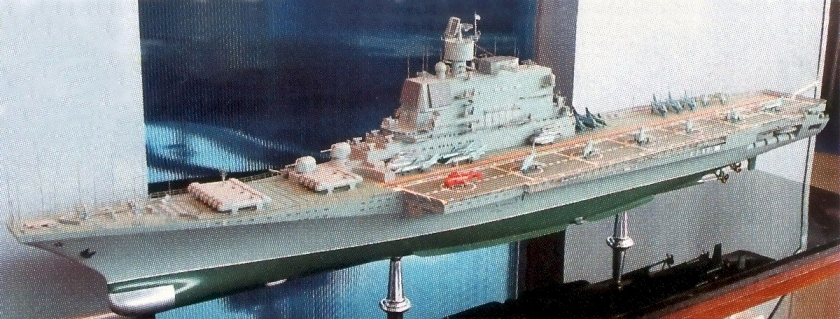
AFTER
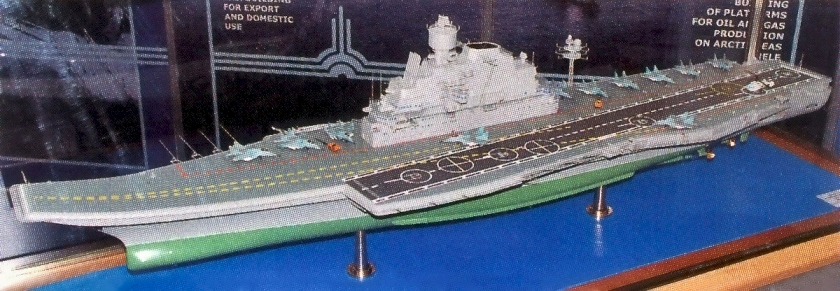
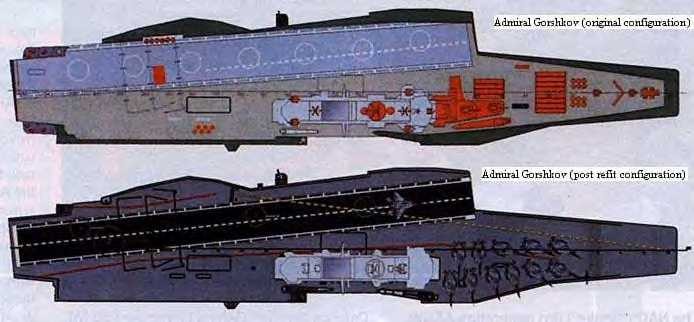
www.globalsecurity.org/military/library/report/1997/Hancock.htm
Major Ben D. Hancock, a marine writes in "The STOVL Joint Strike Fighter in Support of the 21st Century marine corps" that we must;
"develop and refine STOVL employment concepts that includes ramps (ski jumps) and smaller EAFs and it must fund the hardware and structural improvements that allow STOVL aircraft to operate in their intended environment. If we envision maintaining a primarily sea-based approach to conducting operations and we require responsive day/night air support in all-weather conditions, then we need to fundamentally change how we operate fixed-wing jets off amphibious ships. The most significant contribution that the Navy could make to STOVL air and helicopter-borne power projection is adding a ramp to all LHA/LHD class amphibious ships. A dedicated 'JSF carrier', such as an LHA/LHD with a ramp and updated radars, would serve as the optimum mobile forward base. Although the most effective means of employing the JSF would be to base it ashore as soon as possible, it should remain sea based for as long as possible where it can be more easily provided with fuel, ordnance, and maintenance without becoming a logistical burden. Seabasing may remain the best means of enhancing sustainability and reducing vulnerability.Basing flexibility is the only reason to buy STOVL Joint Strike Fighters. This flexibility increases the number of airfields from which to conduct operations, allows for more assets to be brought into theater, decreases the response time of aircraft, and provides dispersal for high-value assets, thus reducing vulnerability to attack by weapons of mass destruction. [16]
Some critics have attacked the STOVL JSF variant for driving up cost and slowing the schedule, and they contend that the marine corps and Navy should both buy the Air Force version. Senior Pentagon acquisition officials believe that the Air Force and Navy should buy the STOVL version, "a capability that would let the Air Force operate from shorter, rougher fields, thus moving closer to the battlefield and providing wider deployment and basing options."[17]
A Development Study on the JSF conducted by ten students from the Navy, marine corps, and Air Force at the Air War College in 1996 emphatically states that the JSF must be expeditionary and capable of performing in the littoral arena and that the STOVL JSF should be the choice of the U.S. The JSF should be one aircraft, not three derivatives. [18]
The main advantage of Vertical/Short Takeoff and Landing (VSTOL) aircraft is the ability to operate from various bases and not be tied to traditional runways and airfields.[31]
Modern runways, long and wide, are inviting targets. Runways will always be susceptible or vulnerable to attack, and the need for aircraft to take off with little or no runway will always be desirable. The major attraction of VSTOL type aircraft is their liberation from runways. Pre-emptive enemy action in the form of air attack or cruise missile attack forces the debate of the vulnerability of aircraft on the ground at fixed airfields. Aircraft or their runways and other facilities may be wrecked.
Historical Justification. History is replete with examples of extensive damage inflicted by attacking enemy airfields. During the Ardennes offensive, on New Year's Day, 1945, 1,000 Luftwaffe warplanes attacked 27 air bases in Belgium and Holland and destroyed 300 Allied aircraft on the ground for the loss of 93 of their own.[32] In 1967, the synchronized strike by Israel against 16 Arab fields determined the course of the Six Day War. On that first day, the Israelis destroyed over 250 Arab aircraft on the ground in only three hours.[33] One of the most persuasive arguments for the STOVL concept comes from the Indo-Pakistan war of 1971. Forty-eight hours after the start of hostilities a Pakistani airfield at Dacca had been attacked repeatedly. A squadron of Pakistani Super Sabre jets remained intact under the protection of their hardened shelters, yet they never flew a single sortie because the runway had been cratered.[34]
STOVL aircraft could have taken off vertically or on short sections of usable runway and could have been employed. The Harrier is most productive on ship when used in the STOVL mode versus being forced to perform a vertical takeoff due to limited deck space. A normal mission involves a short takeoff followed by a vertical landing at the end of the mission when the aircraft has expended its ordnance, burned most of its fuel , and has the thrust-to-weight ratio required for a vertical landing. A Harrier is simply not going to get airborne with any substantial load of fuel and ordnance in a pure vertical takeoff. For every foot of deck roll and knot of wind over the deck, the payload increases substantially. All shipboard combat operations by USMC Harriers in Desert Storm involved a Short Takeoff (STO). Vertical takeoffs are performed on ship only for maintenance checks and airshows. The JSF is going to operate in the same manner off of ships. It could perform a pure vertical takeoff but with a huge resultant penalty in payload. The most effective means of takeoff for STOVL jets utilizes a ski jump. "The most significant contribution that the Navy could make to STOVL air and helicopter-borne power projection is adding a ramp (ski jump) to all Tarawa- and Wasp-class amphibious ships."[76]
It is ironic that although the U.S. is the largest operator of Harriers and amphibious ships in the world, it is also the only navy in the world that does not have ramps on its Harrier platforms. The UK, India, Italy, and Spain all have ramp-equipped ships that optimize the combat power of the Harrier. The British discovered that if the ship's deck were curved upward the last 100 feet or so, the aircraft would exit the bow with a ballistic trajectory (speed builds up during the ballistic portion of the flight until the aircraft attains normal wing-borne flight). The U.S. Navy studied ship designs featuring ski jumps with exit angles of up to 12 degrees but rejected the concept as too costly in design weight of the ship and perceived loss of helicopter spots.[77] The ramp for Harrier operations significantly improves aircraft performance, payload, safety, and deck utilization. A ramp not only dramatically improves a STOVL aircraft's takeoff performance, it facilitates concurrent fixed-and rotary-wing operations afloat.[78]
A STOVL aircraft does not require a catapult to operate at sea. After a short full-power deck run, the pilot vectors the thrust downward as he approaches the ship's bow. He then transitions to conventional flight by vectoring thrust aft and accelerates. The basic principle of ramp technology is that because the aircraft is imparted a ballistic trajectory, it can exit the deck at a lower speed and a higher gross weight than would be possible with a flat deck. For certain takeoffs, the ship need not steam at high speed because the ramp provides an effect equivalent to additional wind-over-the-deck (WOD). Tests indicate that ramps reduce WOD requirements by 10-20 knots. [79] The aircraft can also leave the ski-jump at any point in the ship's pitching cycle because the upward trajectory cancels the effects of the bow-down part of the cycle. The former Soviet Navy recognized the advantages of ramps in adapting MiG-29 and Su-27 aircraft (high thrust-to-weight fighters) for carrier operations; the Soviets kept the arresting gear to bring the aircraft aboard but installed 12 degree inclined-ramps for takeoffs.[80]
The heaviest Harrier launch ever--31,000 pounds--from the deck of any ship was from the ramp-equipped Spanish Principe de Asturias with a deck run of only 400 feet. "An aircraft whose weight precluded its launch from any LHA or LHD, even using the entire deck, used the ski jump to take off in approximately one-half that distance."[81]
Skeptics who insist that ramps will displace helicopter landing spots are wrong. "On a 12 degree ski jump approximately 150 feet long, the slope gradually increases from zero up to 12 degrees at the bow. The first half of the ski jump has a slope no greater than that of an LHA during wet-well operations with the well-deck flooded--both Harriers and helicopters can land on it." [82]
Ramps also provide a margin of safety to the pilot in takeoff emergencies. The upward vector off the bow offers the pilot extra precious seconds to handle takeoff emergencies and an expanded ejection envelope if required. Major (now Lieutenant Colonel) Meyers believes that the price of one saved STOVL aircraft would probably fund several ramps on amphibious ships.[83]
FIXES:
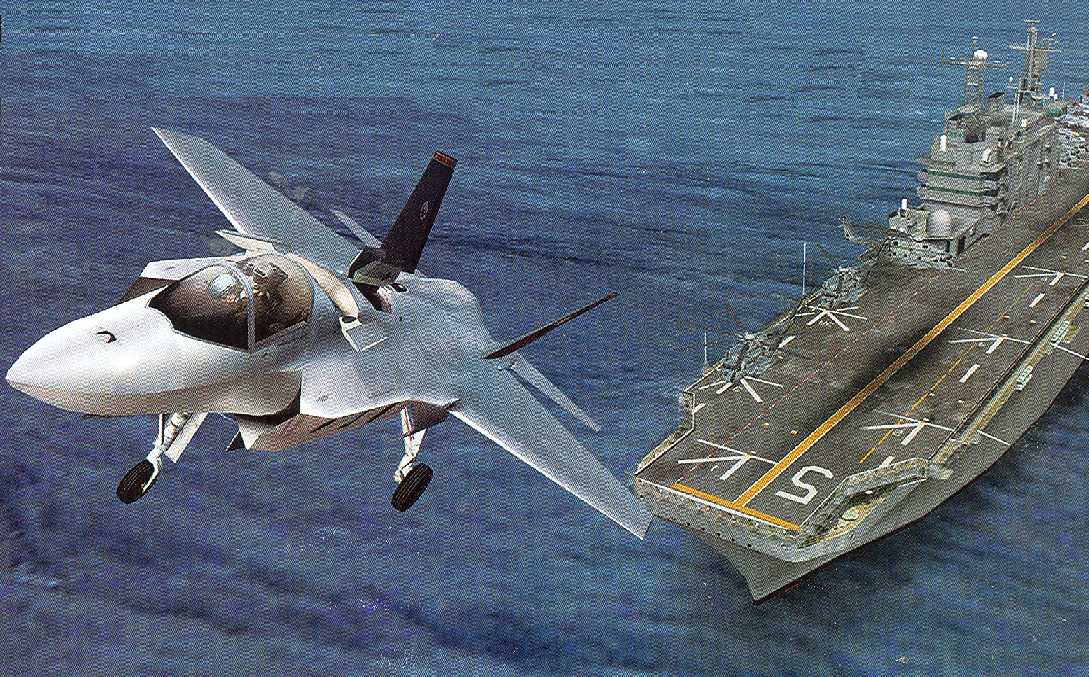
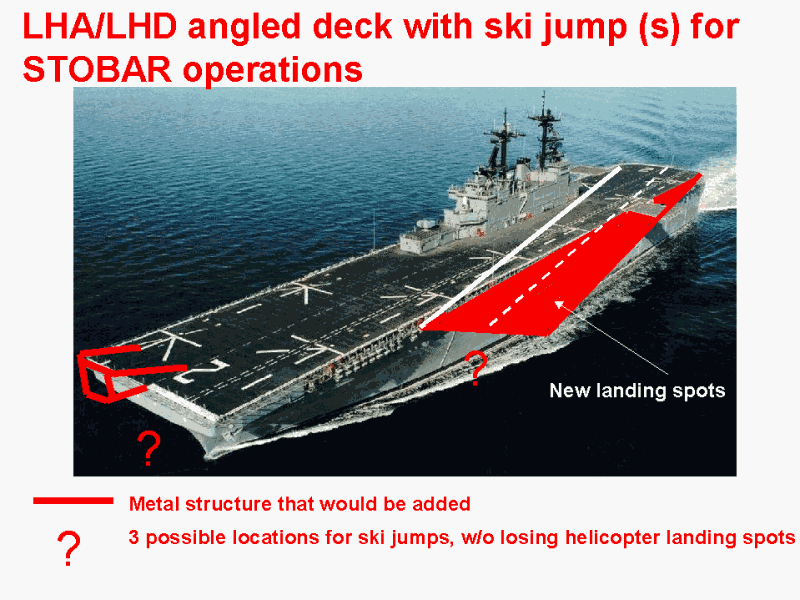
* Add ski jumps to end of LHA/LHDs, they can retract when not in use so quit your whining that a helicopter deck landing spot would be lost. The monies saves in preventing Harrier crashes will pay for the ship modifications.
* Create a centerline bomb rack with brackets for 1-4 JATO bottles for short take-offs from EDO landing strips ashore
* Be prepared to get off amphibs and come ashore to do "Cactus Air Force" by bringing arrestor gear, bulldozers and Rhino Snot to seal dirt runways
www.geocities.com/usarmyaviationdigest/fighterinabox.htm
6. ASW helicopters with ASMs can kill ships/submarines
Not often reported, British ASW helicopters operating off fantail decks of small surface ships sank several Argentine resupply ships and one diesel-electric submarine using ASMs.
US/MC Lessons not learned:
Ironically, the USN's Seasprite and SeaHawk ASW helicopters can fire ASMs (see photo above). Attaboy.
The USMC's AH-1W SuperCobras, UH-1N Hueys, CH-46 SeaKnights, CH-53E SuperStallions cannot. Excuse will be; "Its not our job, man". You damn well better hope the enemy doesn't overwhelm your mother ships with dozens of ASM armed ships and patrol boats, because if your carrier is in flames you ain't going to be landing on any beaches. You will be in the water playing Leonardo DiCaprio--but without Kate Winslet and without any seaplanes to rescue you from drowning, sharks, and dying from exposure. Continue to be narrow-minded and see how long the USMC exists in the modern era.
FIXES:
* ALL helicopters must be armed with ASM and AAMs because in a pinch surface ship survival WILL depend on it.
7. If you don't have RANGE you better range or close proximity via EDO you better have tankers in the air
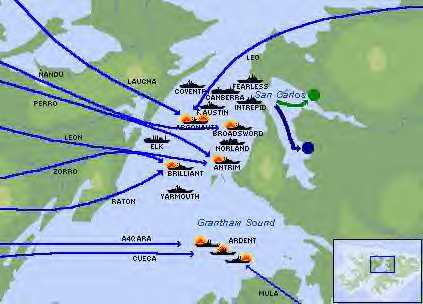
Because the Argentines had to fly so far from the mainland, they could not use aggressive flight routes nor afterburner to avoid being shot down. Not thinking ahead, they only had 2 x C-130 air tankers when the war began. In contrast, the Brits not only had C-130 and Victor jet air tankers, they rushed parts out of museums to make Vulcan bombers into air tankers.
USN/Mc Lessons not learned:
The USN retired S-3 Vikings and now absurdly try to have fuel hungry F-18s tank other fuel hungry F-18s.
FIXES:
USN/Mc should obtain A-10s sitting in desert in Arizona and make them into CAS/MAS/tanker/ASW/ASUW aircraft creating navalized "SeaHogs".
www.combatreform.org/aircommandos.htm
8. If you don't stop the submarines, they will sink you
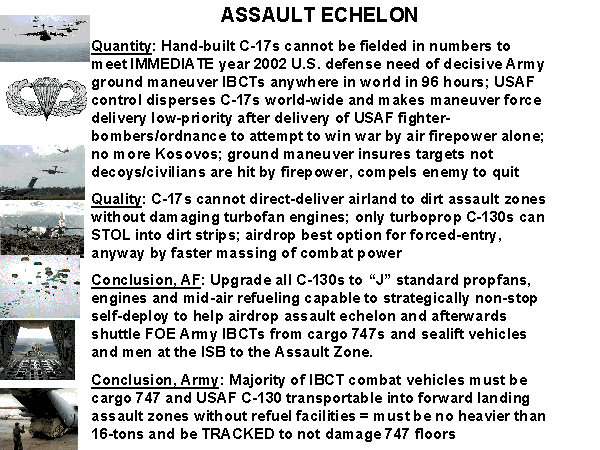
What can a modern torpedo do to a flimsy surface ship?
Lacking maritime patrol aircraft, the Argentines didn't put any of the British submarines at risk, and they had a field day. The lack of Argentine ASW capability resulted in the Belgrano being sunk and the rest of their surface Navy being AWOL from the war. All the Argentines had to do was sink one of the British Navy's small aircraft carriers and they would have won the war according to Admiral Woodward, the commander of that force in afterwar interviews.
USN/Mc Lessons not learned:
Not only has ASW capabilities in the USN been dying through retirement of S-3 Vikings and the wearing out of the P-3Cs doing land surveillance because the USAF/Army are idiots who refuse to employ manned, fixed-wing observation/attack aircraft:
www.geocities.com/usarmyaviationdigest/grasshoppersmustreturn.htm
THE ENTIRE QUASI-WW2 NAVY/Mc SURFACE SHIP FORCE STRUCTURE IS NOW AT RISK TO A MONUMENTAL CATASTROPHE IN COMBAT WHERE A GOOD THIRD WORLD COUNTRY COULD SINK SEVERAL SHIPS WITH INEXPENSIVE DIESEL-ELECTRIC SUBMARINES AND END AMERICAN SUPER POWER STATUS IN ONE BAD NEWS FLASH ON CNN.
That the USN/Mc need to get their heads out of their asses and quick are not strong enough words here.
www.geocities.com/usnavyindanger
FIXES
* Return S-3 Vikings to carrier duty and make more
* Create A-10 SeaHogs for CAS/MAS/ASW/ASUW/air-refueling
9. Don't forget sea mines!
Had the Argentines invested in thousands os cheap, WW2-style floating mines like Saddam used to stop the USMC from landing in the first Iraq war, the British would not have been able to land. All they needed to do was back trucks to the water's edge and send sea mines out from likely landing locations and the combination of inability to land troops by water landing craft and fighter-bombers attacking the ships would have forced the British to at least back off and regroup or possibly go home in defeat.
USN/Mc Lessons not learned:
* The USN is playing with robots and cannon on helicopters to "plink" at sea mines. We do not have time to be playing Robert Ballard and National Geographic.
* There are ways to carry LCAC hovercraft on top of sealift ships using cranes and receive rolling stock from RO-RO ramps using floating causeway sections pieces so LCACs can fly 8 feet over the water and avoid sea mines. The USN/Mc bureaucracy lies to Congress and the American people that the only way LCACs can be operated is by expensive flooding well-deck amphibious ships that they lust for to increase their bureaucratic empire handfuls at a time, when we need to get the lead out and IMMEDIATELY get our forces coming from the sea offloaded fast and over possible sea mines. The British need to get LCACs, too.
10. Airborne Early Warning radar: only by land-based AWACS jet airliners that need long runways or Hawkeye fixed-wing turboprop aircraft that need catapults? What if the enemy shoots your AEW down?
Modern naval tactics:
Airborne early warning
The key to successful AAW is AEW. If attacking units can be identified before they reach their launch points then the battle can occur at the outer air-battle screen rather than the inner screen. An AEW unit in a race-track loiter 100 nautical miles (190 km) ahead of the PIM, with a fighter escort, is perfect.
The outer air battle
In this area the interceptor aircraft of the Combat Air Patrol (CAP) are the principal element, whether originating from a CVBG or land base. CAP units protecting units other than their home base are called LORCAP (LOng Range CAP). The CAP is usually positioned 160 to 180 nautical miles (300 to 330 km) from the units to be protected, along the expected threat axis. At this point the units will wait in a fuel saving loiter to engage incoming groups with AA missiles. As the engagements progress, relief units are dispatched to the CAP to ensure that later attacks are met with full weapon loads. If attacking units penetrate the outer defenses they can be intercepted with aircraft in ready-5 status, if used.
One of the oft-cited "lessons learned" the USN bureaucracy loves to cite from the Falklands war is the Royal Navy's lack of AEW radar aircraft to alert them to air attacks that they smugly proclaim justifies large, vulnerable catapult equipped aircraft carriers to launch E-2C Hawkeye radar planes. We all know about logistics as the "tail wagging the dog", but is this the bottom line reason why we need large carriers, just to get a long endurance airplane with a radar dish on top?
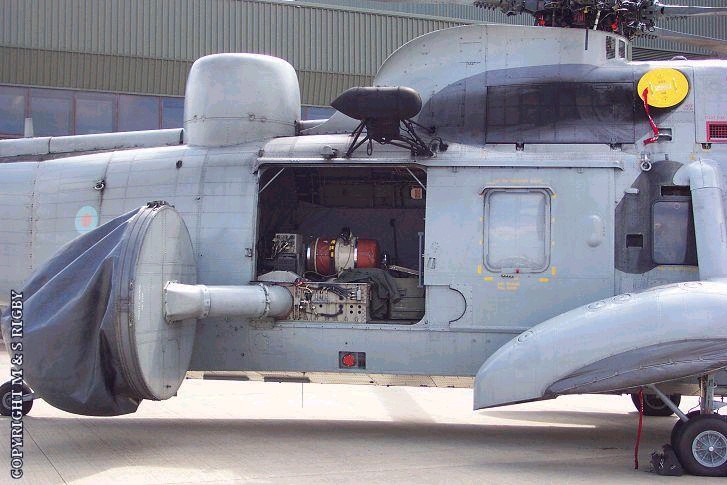
The British fitted an AEW system on Sea King helicopters out of desperation but as we all know that means high fuel cost and low range/endurance.
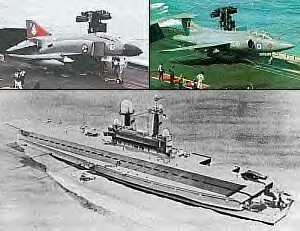
The RN simply could not afford the Queen Elizabeth class aircraft carriers and had to go with "thru-deck cruiser" STOVL carriers with Harrier jumpjets and helicopters.
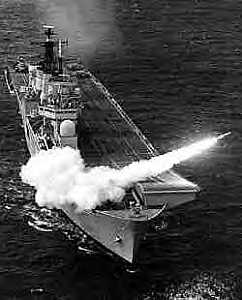
However, the truth is that there are other ways to complete a SSC system with AEW other than a large, nation-budget busting aircraft carrier:
a. Seaplanes with AEW radar
b. Large LTA blimps with AEW radar
c. Aerostat blimps with AEW radar aloft above surface ships
The easiest of the 3 AEW options is using Lighter-Than-Air to get indefinite endurance via an aerostate held by a cable above a surface ship. Why the British Navy did not do this to compensate for a lack of a large carrier with AEW aircraft is still a mystery, since they are now risking financial ruin with the purchase of two large aircraft carriers that can operate turboprop AEW planes. The U.S. Navy has been enormously successful with LTA blimps for ASW and had an AEW variant in service when to its shame they gave up on them in the early 1960s. A seaplane with AEW could be refuelled at sea to stay aloft for coverage for the fleet and have added benefits of being able to attack/defend itself if some "leakers" should reach it.
And whatever AEW system we use, it needs to be ARMED with AIM-120 AMRAAM missiles to defend itself from likely "AWACS Killer" SU-27s. This means we need to arm our E-2Cs with AMRAMMS ASAP.
USN/Mc Lessons not learned:
Yet, after the Falklands none of this AEW "out-of-the-box" thinking occurred, the USN/Mc bureaucracy smugly proclaimed their infallibility via large carriers/E-2C Hawkeye AEW aircraft not not only squelch any LTA and seaplane improvements to radar coverage but to write off the ENTIRE Falklands experience as a result of a lack of British AEW. In the arrogant American mind, as long as it has AEW, NONE of what befell the British would ever happen to the U.S. Navy/marines. This naval version of the "Maginot Line" hubris begs for a human tragedy and military defeat at the hands of a cunning foe.
FIXES:
* Immediately develop a navalized Aerostat for improved radar coverage
* Field LTA blimps for ASW/AEW back into the Navy
* Buy Russian A-40 seaplane jet patrol bombers and fit some to be AEW providers
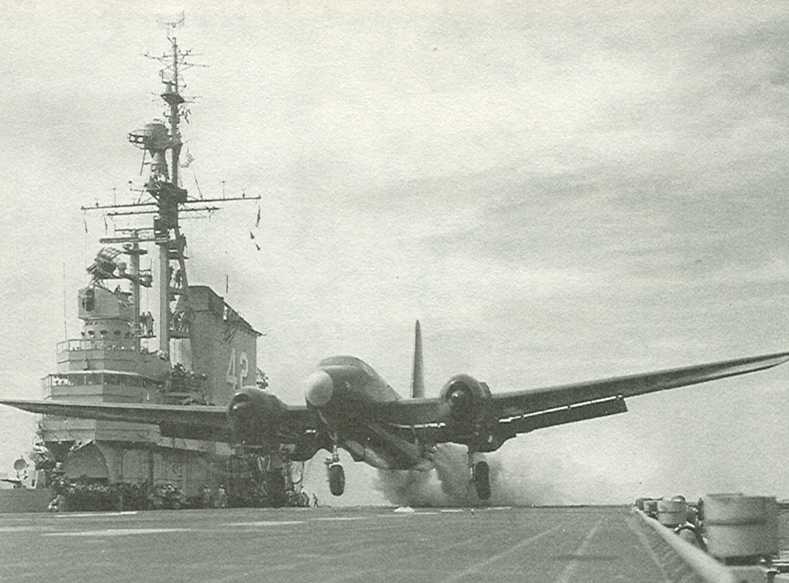
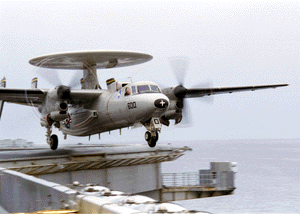
* Fit JATO bottle brackets so E-2C AEW aircraft can operate STOBAR from LHA/LHDs and emergency container ship aircraft carriers when supercarriers are sunk
* Fit AIM-120 AMRAAM missiles to every E-2C and C-2 in the fleet to defend themselves in an all-out shooting war so we don't lose them.
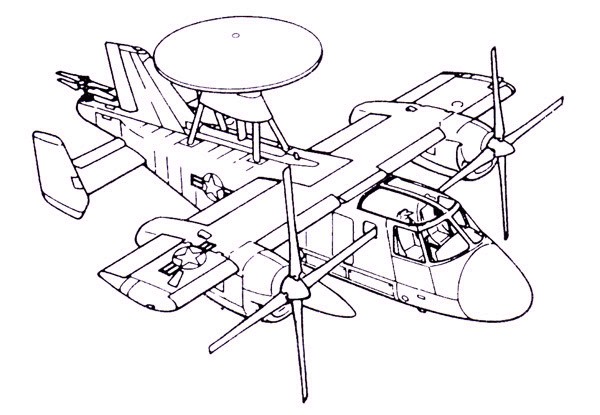
* Develop a tilt-wing AEW/ASW/COD/LA aircraft like the Canadair CL-84
11. Reduce number of Troops exposed onboard surface ships via Airborne Operations
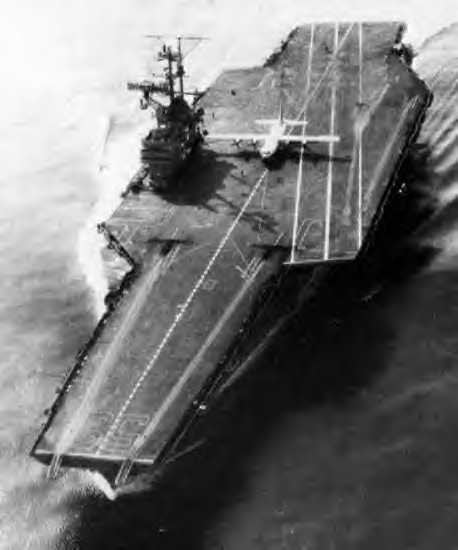
Quicktime video clip of a C-130 landing on the USS Forrestal supercarrier
Legendary war futurist, Ralph Zumbro writes:
"Mike;
Remember the Doolittle raid in 1942??? update that. a C130 can take off
from an aircraft carrier with a diasycutter on board.....or paratroopers, or an
M113 Gavin. Oddball fact, the aircraft carrier is much faster then its
published speed. A coastguardsman I know was off the Dominican Republic/Haiti, when a carrier was sent from Norfolk....ship arrived next DAY. He figured either they have TWO USS Kennedys or that ship can do 70 knots with the hammer down. If that kind of speed is actually available. the Carriers can serve as mid-ocean fuel stops for fully laden 130s.
Remember in Dr. Strangelove when the pilot decided to ride a nuke down....That needs to be done with every officer above Colonel in the military today....mabe THEN we get some action. The present generation of Generals and Admirals are of the SAME mentality that had to be cleansed for WWII...just like the British Generals at Balaclava had won their spurs against Napoleon."
His idea of using land-based C-130 Airborne forces stopping temporarily onboard a supercarrier is a sound one. It is the Doolittle Raid in modern form. 2d Para and 3d Para could have used this in the Falklands war if they had had bigger carriers instead of cramming them in cruise ships.
USN/Mc Lessons not learned
First off, the biggest hindrance we have is the USMC, everything is driven by their ego.
They should already have the marines slated to link up with pre-po ships on parachute jump status so we do not need to secure a runway to airland them.
Why?
BECAUSE AIRBORNE IS AN "ARMY" THING AND THEY HATE THE ARMY BECAUSE THEY THINK THEY ARE BETTER (EXTERNAL SNOBBERY).
The Army's prepo ship personnel will not jump because THE ARMY AIRBORNE THINKS ITS BETTER THAN THE "MECH PUSSIES" AND THEY ARE "NOT WORTHY" OF JUMPING in (INTERNAL SNOBBERY). Stay-in-your-lane, do only your narrow-minded mission sets etc. Again, EGO driving everything instead of get-the-job-done practicality.
If we were smart and frugal (we are not) would we have all these expensive aircraft carriers and not have a parachute forced-entry (Airborne) capability from them?
If we were not so defeatist and narrow-minded, the 2-engine C-27J "Baby Herk" fitted with folding wings, a tail hook and landing gear for cat shots would do COD better than the smaller C-2 Greyhound and could drop paratroops and a M113 Gavin off its large rear ramp. And a daisy cutter bomb to blast open a drop zone would also be an option.
Yes, we could use 4-engine C-130 from carriers but they are too big to store there, we could carry several C-27Js without leaving no space for OA-10B SeaHogs, F-18s (yuk), F-35 JSF (better) etc.
12. You need Air Cover, Stupid!
This is the sad adjunct to point #1 that ASMs are the primary threat to surface ships in modern naval combat.
The 1944 U.S. Navy War Instructions, Chapter 7 even then realized this truth:
www.ibiblio.org/hyperwar/USN/ref/WarInst/WarInst-7.html
739. The primary defense during daylight against an air attack is fighter interception. The accomplishment of this depends upon good radar detection in addition to good communications.
740. Fighter protection destroys trailing or shadowing enemy aircraft.
Yet, both the American and British navies obsessed with bombing Iraq and blind to the threat someday waking up and not allowing them to use aircraft carriers as floating, inferior air bases are "betting the house" on the F-35 Joint Strike Fighter coming into service as they retire their F-14s and Sea Harriers. This is betting on a company that is notorious for "cost over-runs" and naked money grabs once they have you dependant upon them for their excellent aircraft design.
USN/Mc Lessons not learned:
You should not get rid of your air cover assets that you need to spoil enemy air attacks in order to survive on the surface of the water until you have their replacement IN HAND.
FIXES:
* Both the American and British navies need to buy some commercial, off-the-shelf seaplanes and operate them from EVERY non-aircraft carrier ship and submarine they can because they are going to need every single AMRAAM firer they can scrape up if they want to have any hope at all of surviving massed ASM attacks.
* As soon as F-35B STOVL fighters become available, they need to be supplied to every surface ship possible to insure their is adequate outer ring air cover.
* DON'T DO THIS EVER AGAIN!
BAD NEWS: TONY BLAIR NEOCONS EMULATING AMERICAN AIRCRAFT STUPORCARRIER STUPIDITY!
As a free market corporation shill, the recent British governments have watched their industries and jobs out-source overseas and multi-billion dollar (pound) prijects like the new CVF aircraft carriers are funded.
www.youtube.com/watch?v=VUZrUGG29fo
UK's Queen Elizabeth Class CVF SuperCarriers: Not CATOBAR
The French version of the UK CVF will have CATOBAR capability to operate fixed-wing CTOL tail-hook planes like the E-2C Hawkeye AEW and an ASW plane if they chose to create a new one or bring back the contraprop Gannet etc.
http://en.wikipedia.org/wiki/Future_French_aircraft_carrier
By not being able to operate fixed-wing planes for AEW/ASW/anti-UAV defense the UK's CVFs are going to be fatally vulnerable, more than even American CATOBAR carriers.
http://en.wikipedia.org/wiki/CATOBAR
CATOBAR
From Wikipedia, the free encyclopedia
CATOBAR (Catapult Assisted Take Off But Arrested Recovery) is a system used for the launch and recovery of aircraft from the deck of an aircraft carrier. Aircraft launch using a catapult assisted take-off. However, these are conventional, rather than STOVL aircraft, and thus require arrestor wires to land on the ship. Only three countries operate carriers that use the CATOBAR system; the U.S. Nimitz class, USS Enterprise (CVN-65) and USS Kitty Hawk (CV-63), France's Charles De Gaulle, and Brazil's NAeL São Paulo.
Will they have CATOBAR 24/7 E-2C Hawkeye AEW coverage or not? Where's the fixed-wing ASW planes? Anti-UAV planes?
www.youtube.com/watch?v=fEsJfNKsPGA
British Admiral Remarks on New British CVF Aircraft Carriers
www.youtube.com/watch?v=H6h8i8wrajA
LAND LESSONS TO BE LEARNED
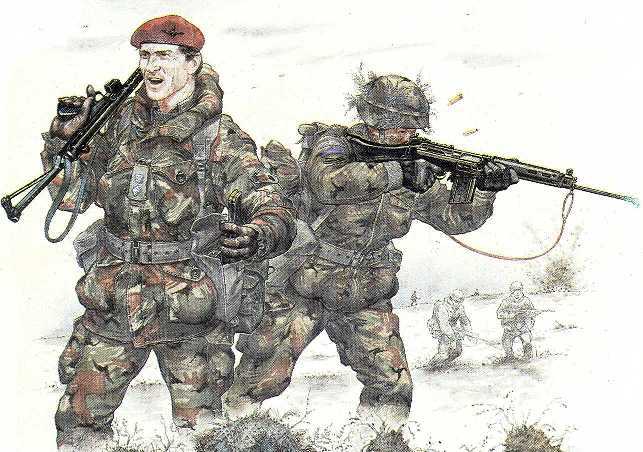
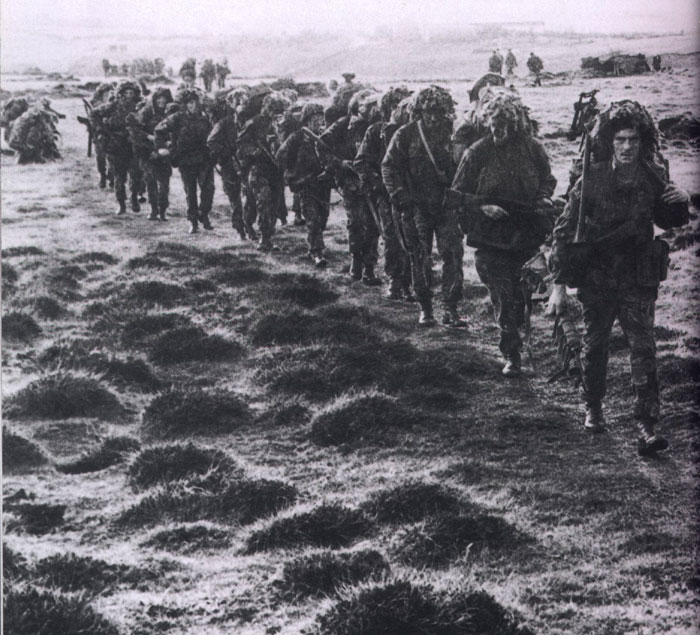
The following Lessons Learned are derived from Major Wheen's lecture to the USMC in 1986. Its also on the bottom of this web page. Excerpts are in italics
www.globalsecurity.org/military/library/report/1986/WDG.htm
As insightful as Major Wheen's two lectures were (see bottom) his lessons to be learned are not forthcoming other than some quick, safe platitudes at the end. We are going to tackle this job head-on, but first let's set the context:
The Falklands War was a nation-state war in a rural, open wet, terrain with some mountains setting. The closest situation America is now fighting in would be Afghanistan but much drier and firmer; actually arid conditions.
1. Use the best Light Mechanized Concept of Operations possible
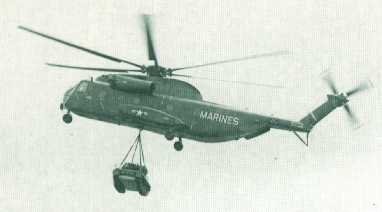

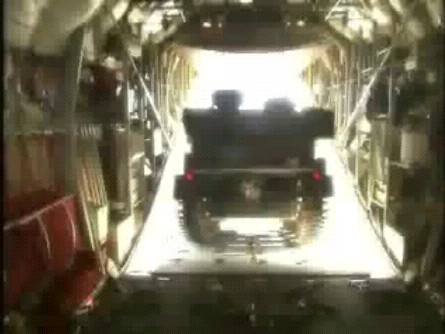
The Brits were short on ships that could rapidly discharge men much less vehicles resulting in a helicopter (air assault) and foot infantry (dismounted) back by towed howitzers, naval guns and Harrier jump jet CAS concept of operations. When the container ship aircraft carrier, SS Atlantic Conveyor was sunk, they lost 3 CH-47 Chinook helicopters and switched their CONOPS to dismounted infantry combat. This kind of "feel good" infantry war was nearly identical to what a Vietnam light infantryman fought against the NVA except in much colder terrain. What is lost when we delve into how to do foot infantry combat better discussions is the FACT THAT LIGHT MECHANIZED MANEUVER OPERATIONS would have worked better. U.S. Army "tank and Brads" (33-ton medium and 70-ton heavy tanks) with ground pressures of over 12 PSI could not have traversed the Falklands. Nor could the bloated USMC 26-ton medium AAV-7 Amtracks or 30+ PSI LAV-1 trucks. If you doubt this assessment, the Argies landed troops to take Stanley by AAV-7s and DID NOT keep them on shore for inland mobility. Light infantry must have LIGHT tracked AFVs for a light mechanized capability in addition to 3D air transportable maneuver (helicopters and fixed-wing aircraft) interfaces, which we call an "Air-Mech-Strike" force.
www.geocities.com/air_mech_strike
Excerpt:
"The battle for Goose Green was, however, unique in that it spilled over the first night and into the whole of the next day. Low gently rolling hills made it seem ideal tank country, but these were not used as it was felt they would get bogged down in the peat. Experience in the long march across the island eventually showed that this would not have been the case and Julian Thompson freely admits his mistake. A lack of direct and indirect fire support was a problem throughout the battle."
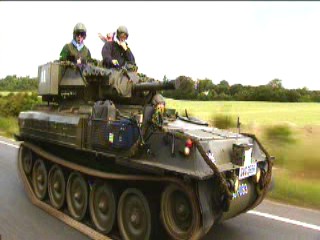
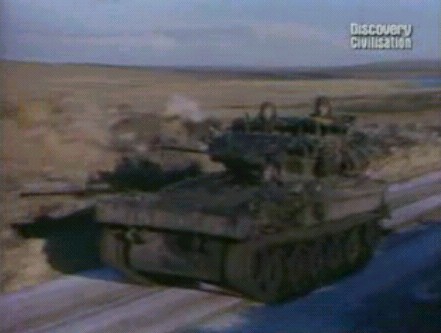
After Goose Green's heavy casualties the Scimitar/Scorpion 8-ton light tanks were aggressively used to render direct fire support because their low ground pressure tracks were mobility creating. So the point is that instead of using their ships to carry so many helicopters, had they carried large numbers of LIGHT tracked armored personnel carriers like the Spartan version of the Scorpion family or the Bv202 articulated two body oversnow vehicle used as mobile command posts or the American 10.5 ton M113 Gavin the British light infantry could have rapidly crossed the boggy terrain under armor and not lost time and so many men to mortar and arty fire and landmines. Furthermore, the M113s can be fitted with waterjets (ARIS SPA "Arisgator" we call "Amphigavins") to SWIM IN THE OCEAN and could have delivered themselves to the beach as their own landing craft if RO-RO container ships had a Mexeflote barge piece underneath the vehicle ramps for them to splash into the water.
USMC/Army Lessons Not Learned
The thing that is telling about the Falklands war experience is that the Royal Marines have bought the BV10S "Viking" enlarged version of the Bv206S which is an armored improvement over the Bv202s they used in the war. With a PSI of less than 2, they have now a light mechanized capability but we have some doubts about this choice. First, the BV10S is propelled by its tracks only in the water, can it swim from ship-to-shore, even if the "mother" ship risks its own destruction and gets it close, say less than 4, 000 meters? We think not. To avoid missile destruction, mother ships need to stay away from defended beaches; how well does the Bv10S fly by helicopter? Not well. It cannot fit inside the CH-47 like the narrower Bv206S and must be slung underneath the Chinook itself split into two "cars". External sling loads mean the helicopter itself can only fly straight ahead and slow less than 100 mph speed, severely hindering its ability to avoid getting shot down by an enemy Pucara, attack helicopter or from ground fire. We think that the Bv10S since it cannot swim from ship-to-shore nor fly inside a Chinook is a poor choice for the Royal Marines but at least it IS a light mechanized capability IF it can get itself ashore. Its not helping the Navy to avoid being sunk.
However, if you look at the U.S. military its light infantry is even in worse shape than the RMs and the Paras for they have ZERO armored vehicles. The 172nd and 173rd Brigades that are in Alaska and Italy where oversnow mobility are vital are getting rid of their unarmored Bv206 tracked vehicles when they should be getting armored versions and/or M113 Gavins. The USMC persists with its bloated amtracks and LAVs the former can swim to shore but not fly by helicopter, that latter can't swim but can fly.
www.geocities.com/armorhistory/amphibiousinfantrytanks.htm
If the American light infantry were faced with a Falklands-esque situation, they would end up humping heavy weights on their backs after their helicopter and truck rides conk out and can bring them no farther forward; ie the mess we are in now in Afghanistan!
FIXES
We should fix this immediately by supplying our Army Delta weapons companies and anti-tank platoons/mortar platoons in every light infantry battalion light tracks to render armored mobility for A, B and C companies as needed in addition to improving their heavy weapons direct fire support capabilities.
www.combatreform.org/itmaneuversabattalion.htm
USMC should use M113 Amphigavins
www.geocities.com/armorhistory/amphibiousinfantrytanks.htm
www.geocities.com/armysappersforward/amphigavins.htm
2. If you use dismounted operations, make them as mobile as possible
"We carried full scale ammo for all weapons and the only troop weapons not carried in the assault were the 2" lt mortars. The effects of MAW and LAW were tremendous against enemy infantry. The kit carried was: fighting order with a respirator bag on the belt too - it carried such things as water proofs, survival rations and other items such as extra socks, radio batteries and some extra ammo. Windproof-smockpockets were also crammed with odds and ends not carried on exercises but considered highly desirable in action, especially with logistic resupply so tenuous! (e.g. extra torch batteries, drinks pack, nutty, toilet paper - the majority had some sort of "dog" at one stage or another, for we used any water available in the hills - we rarely got water resupply by Hel, the space just was not available). The '58 pattern Webbing was awful. With extra rats/ammo and whatever Hexamine we could carry, it was heavy un-comfortable, and awkward when wet. Nevertheless we always meant to assault carrying it: our philosophy was that a belt order or just weapon alone with magazines in pockets was all very well in pursuit of the philosophy of mobility in the assault, but if you were then pinned down/counterattacked on an exposed feature, it was best to sacrifice some comfort in terms of weight for the comfort of knowing that you could survive a set length of time before you had to have outside assistance. Our set length was 48 hours and I think we felt much happier knowing we had this capability. adrenalin in the assault customarily enables "royal" to carry fearsome weights and still fight hard!
"We were exhausted, out of ammo and suffering significant casualties."
"but on the first mission the FAC and Harrier never made contact. Much of the FAC's equipment had been left behind due to the 12 mile manpack move."
They marched 80 miles in three days carrying all their personal equipment for combat; the packs weighed Up to 110 lbs
"there are no trees in the Falklands -- and no local resources for making a stretcher"
OK, you are crossing the island in your light tracks and come upon MOUNTAINS, now what do you do? In the case of the British they walked and were very tired and came upon mountains to assault. Either you are on foot already or you get out (dismount) from your light tracks and take the NO-GO terrain for vehicles from the enemy. You are at point B from A. Here is indeed where both heavy and light units fail. The "heavy" units refuse to train their infantry to do completely on foot offensive attacks as the Brits did in the Falklands citing "lack of training time" and other flimsy excuses. This is where they get the "mech pussy" label. The facts are that the terrain may not allow your even light tracked AFV to be with you close by to take objectives in difficult terrain types that are NO-GO. The tracks might have to support-by-fire. On the other hand, the "light" units are guilty for not having light tracks as their baseline way of ground maneuver to carry heavy but vital equipment like laser target designators so fast-mover jets can assist in some way and not drop bombs on friendly troops. The result of this lack of ground Forward Air Control due to Soldier's load problems, unarmored, fast-mover Harriers STOVL jets were ineffective at the bloody battle of Goose Green and one was shot down when the pilot tried to bird dog his own targets to strafe.
The "lightfighters" also fail to realize that all it takes for a man to become an immobile 200 pound weight is to get hit once. This macho over-estimation that the Soldier will remain able-bodied with two good legs is naive as you can see from the accounts below.
"marine Curtis, a 230 Lbs. RN rugby player, stepped on an antipersonnel mine, at Gr 285708. At that time the patrol also came under artillery fire. Cpl Cuthell, his section commander, another large rugby player, picked him up and carried him back the way he'd come, for about 250m. There the troop stopped and Curtis gave himself morphine while the remnants of his foot were bound and strapped up by the corpsman (ma). The mission was abandoned, and then started the long, slow business of evacuating him back. The weather was foul, and the low clouds prohibited helicopter Casevac."
After a second stop for more intravenous drips and rest for all, the troop eventually got back absolutely exhausted at 9 a.m. Those of us who have in the past skipped over the casevac procedures during exercises in the NATO sequence of orders, had better take note. At about 10:30 there was a break in the weather and Curtis was eventually evacuated by helicopter to SS Uganda. Though the offensive missions of the patrol were not achieved, they were nearing the patrol base location, when "bang", marine Paterson stepped on a mine. The patrol could not be abandoned since the attack was scheduled for the next night. Sgt Weston with one section took Paterson back 1500m
Soldiers WILL get hit and immobilized and they will need to be moved, so you need to have the tracks and human powered mobility means to move them: rucks with wheels, bikes, carts, sleds, stretchers, SKEDCOs which the Brits did not have, but the Argies did:
"Outside was a wheelbarrow with a dead soldier in it, on top of him was a kit bag."
USMC/Army Lessons Not Learned
Neither the Army nor the USMC narcissistic infantry communities train realistically with men becoming immobile casualties nor if they did have they employed the humility and wisdom to create alternative mobility means to keep the fighting maneuver going. In WW2 we had a second a third echelon of troops to care for the wounded and dead because we had a 100 division Army created from an universal national survival at stake war-time draft. Today's 10 division Army does not have extra men to free the assault (1st) echelon to keep fighting, so when a man goes down, often the unit stops moving, circles the wagons, calls for artillery or air strikes and the MEDEVAC helicopter. The enemy is free to conveniently get away.
FIXES
* Every Soldier's rucksack should have wheels to enable it to be towed
www.combatreform.org/rucksack.htm
* Designated Soldiers when dismounted from light tracked AFVs have their rucksacks and themselves by fat-tire, folding All-Terrain "Mountain" Bikes
* Every 2-man buddy team needs a half-SKEDCO like drag device (plastic sheet)
www.skedco.com
* Every section/squad needs a Darby ATACS cart/sled to carry unit gear and MEDEVAC casualties to the CCP
* We might be wise to designate units to do the conveyance of supplies forward and wounded men back. Excerpt:
"This tp was to act as a porter group, carrying the sf kits of both k and l coys thus freeing them of that burden, in addition, they carried extra ammo."
3. Battery self-sufficiency
"radio batteries and some extra ammo. Windproof-smockpockets were also crammed with odds and ends not carried on exercises but considered highly desirable in action, especially with logistic resupply so tenuous! (e.g. extra torch batteries
There had been no power for a couple of weeks or more."
You will notice compounding light infantry's overloading problem is the need to carry spare batteries to keep their communications network going. Also, at the end of the war, the civilian power grid had been down for weeks, so the assumption that power can be easily had needs to be dispelled.
USMC/Army Lessons Not Learned
America's ground forces are just as bad, if not worse. All sorts of electronic gadgets are added to the Soldier's load without any restraint to miminize the TYPES and quantities of batteries required making a logistical nightmare to supply our troops, an ecological disaster to dispose of all the dead one-time use batteries, tremendous waste of money and the Soldier's mobility is further degraded.
FIXES
* Use Rechargeable NiMH and/or Lithium-Ion batteries and carry only 1 extra set
* Power inverter/charger in "mother" light tracked AFV
* Pedal/Hand generators
www.combatreform.org/batterychargesolution.htm
Recharge the set of batteries that have died, and do not use throw-away batteries that require a constant influx.
4. Water MUST BE ABLE TO BE COLLECTED AND PURIFIED by every Soldier
"the majority had some sort of "dog" at one stage or another, for we used any water available in the hills - we rarely got water resupply by hel[icopter], the space just was not available).
that I had to evacuate only 1 medical case, and he had a stomach problem.
...and so far as water is concerned, we had to find our own. The nearest stream was 5 miles away - east of the Argentinean regiment at Mt. Harriett. We were on top of a mountain but fortunately the water settled and remained on the surface! In coy hq, 10 of us used a puddle 6 ft. Long, 2 ft. Wide and 6 inches deep for the duration of our stay. Hygiene of course was of crucial interest but luckily no one at this stage suffered from the 'dog'.
I also was suffering from the "dog". It hit me first on top of Mount Harriet after we had taken the main position and were about To strike the rocky outcrop. I must confess that I coordinated both the artillery and mortar fire missions and five minutes later the troop attack with my trousers round my ankles! One way and another no one has ever packed such a punch!
Its true that you should have a canteen cup to boil water to kill any germs before drinking. However, what if you cannot create a fire to boil the water? Excerpt:
"we were down to one cube of hexamine per troop - this will heat 1 pint of water in calm conditions to boiling point! There are as you'll recall no trees in the Falkland Islands and the peat bog was completely sodden so we had no combustible materials."
Those who think infantry should be in some weak co-dependent state relying on resupply are naive and dangerously deluded. Excerpt:
Non-availability of helo assets prohibited resupply for 5 days. As you can imagine, we were fairly hungry when it eventually came: 2 days' rations don't stretch that far.
Even when the war is over, do not assume that fresh water will be available:
In Stanley, we found dozens of large containers full of food, clothing and equipment; there was no need for us now to go hungry, but water remained a problem and more and more marines got the "dog" as a result.
USMC/Army Lessons Not Learned
Back here in the U.S.A. where co-dependence and weakness is desired, troops are in a make believe state that food and water is their god-given right to have. When bottled water became scarce in 110 degree heat wearing body armor in Iraq this should have been a wake-up call to determine the best ways to collect and purify water from local sources.
FIXES
* Issue a water purifier pump (preferably a ROWPU that can convert seawater) to every 2-man buddy team or the very least 9-man squad to FILL THEIR CAMEL-BAKS via their drink tubes and avoid disease/sickness
www.combatreform.org/drink.htm
5. Use lightweight rations that do not need water or can be ate with cold water
"Non availability of helo assets prohibited resupply for 5 days. As you can imagine, we were fairly hungry when it eventually came: 2 days' rations don't stretch that far.
...and a very little dehydrated food which was useless as it needed cooking!
This is one lesson that doesn't make sense. When 1st TSG (A) Director Mike Sparks went to JRTC several years ago, one of his enterprising Soldiers decided to not eat the constipation-causing MREs and bought absolutely delicious Mountain Home dehydrated camping food. All you need to do is pour a little bit of water and you have something that was not only pleasing it filled you up. Why the MRE cannot be like this and without the constipation effects is a question that needs to be answered. Certainly as a Brit, they like their tea and want hot food whereas an America who wants fast food here and now is utterly satisfied with a dehydrated meal brought to life with a squirt of water.
USMC/Army Lessons Not Learned
Yes, MREs have improved in their food variety and less clutter in packaging with the accessories all in one little pack. What remains to be explained is the preservative odor you smell when you open a MRE main course and the constipation it gives you after you eat it. The only thing Sparks will eat out of MREs is the civilian food items inserted AS-IS from civilian life that he knows the military has not given a shot of kayopectat equivalent compound.
FIXES
We'd like to see the MREs lightened up by Mountain Home dehydrated food and the constipation causing substances removed.
6. Combat Light: minimalist Battle against the earth shelter EVERY Soldier has at all times
In Wheen's account you notice they made a serious mistake that experienced field Soldiers should not have done: GET WET early on in the operation.
Nevertheless we were so keen to get off the LCUs that we made no
comment about the thigh deep wet landing to which we were subjected. We were positively elated to get ashore, in an environment similar to Dartmoor or Scotland, where we felt much safer than aboard ship or LC.
Once you GET WET there is no guarantee that you will EVER be able to dry off again even if your body is a nuclear reactor during exertion. They should have known this in the dreary South Atlantic and ignored any cat calls about being "wimps" and taken care to come ashore to stay dry. Each Soldier through experience needs to find out how wet he can tolerate his clothing to get and how much his body heat can dry in various temperatures and climates. This is what layering is all about--finding the optimal layers to wear to ovoid overheating and sweating from drenching your clothes just as much as never getting so wet from outside wetness that you cannot dry yourself out with exertion. Notice the negative chain reactions getting WET wading into the water from the LCU created:
"Life was pretty miserable, with freezing temperatures, rain or snow and 20-30 knot winds, so I was obviously concerned about the effects particularly of exposure and battle casualties in these circumstances.
His main gained approximately 4 mph mobility:
"Each section carried 2x sleeping bags..."
"Due to our hot pursuit role we went ashore in fighting order, a belt/webbing equipment without rucksack but carrying 2 x mortar bombs etc. Having dumped these bombs at the mortar base plate position at Port San Carlos, we were able to move much faster and my coy had the first contact some hours later..."
"This was our first experience of crossing rock runs at night while heavily laden. Even though we only had our belt equipment, wpns and ammo,
including blowpipe air defense missiles, 2 days' food, sleeping bag and minimal shelter, the average weight was 60-70 lbs. It took us 8 hours to cover the 5 miles."
However this "hare" speed capability was at the cost of environmental exposure slowing his men down to a stop in order to warm up:
"At 2 a.m. I gave the order to bed down without erecting bivouacs. Our bivvies were simply a waterproof ground-sheet supported by a small stick and some rubber bungies. This was a bad mistake. It rained during the early morning, and the plastic bags in which our sleeping bags were stretched did not keep the water out. Our sleeping bags were soaked. The last citadel of a man's morale is His sleeping bag. The comfort and resource it offers is Amazing. On subsequent occasions, when one was being shelled or heard bombing close by, it was an instinctive Automatic reaction to wriggle deeper into the 'green slug'. When all else failed, when the world crumbled around us, Even if the sleeping bags had failed to turn up in the evening, one always was vaguely comforted by the prospect Of climbing into a dry bag eventually. When my citadel Was drenched by rain, my morale was at its lowest...I was subsequently to spend more uncomfortable and more bitter nights and it was not the last time my citadel was breached - but one hardened. The men who survived that march basically stuck it right through to the end.
...we crawled into our sleeping bags. Typically as we had no shelter overhead, it started to "pee" with rain. My sleeping bag got soaking wet and for the next 72 hours I had to put on waterproofs before climbing into my "slug".
Notice that to save weight each squad only carried 2 sleeping bags and an overhead cover kit. This means the men on watch were exposed. If these or the other bags are lost/destroyed then men can die of exposure.
The troop commander, Lt. Burnell was suffering from exposure so did not lead the patrol. He fortunately revived when we got the helicopter resupply of food that I've already spoken about.
Sparks remembers getting hypothermia one winter day at Fort McCoy when it did not stop raining and all the cheap issue gear failed to keep any of the water out. Even the poncho's coating failed. What saved him was hot food brought out to the field for the first and only time in his marine infantry career.
At best, if they get wet morale can sink. He advocates a synthetic sleeping bag that will work even when wet covered by a Gore-Tex cover, but he will still end up with the 2 bag per squad possibly resulting in exposure risk even if they are the greatest bags known to man (quality) because there was insufficient quantities taken to try to save weight.
At the question and answer period last time, someone asked what kit was the most useful; I found it difficult to answer because it was all useful -- that which I did not have but which I swear I shall never again be without is:
a. A Gore-Tex sleeping bag cover/bivvy bag
b. A hollow-fill sleeping bag rather than a down or Feather sack.
Scientifically they dry 27 times quicker and don't now suffer the serious degradation that they used to, when damp. In my last job procuring and trialing kit for Special Forces, I co-directed comprehensive trials lasting 12 months and involving live trials in the arctic and controlled cold chamber evaluation at temps down to -40oc (-40of) and including 1 litre of water per bag. The American north face big foot sleeping bag came out on top, I can wholeheartedly can recommend it!
We vehemently disagree with the only a few in the squad having a sleeping bag approach since it damns those on watch to getting wet and cold and relying on ANYONE OTHER THAN YOURSELF IS A RECIPE FOR FINDING YOURSELF WITHOUT. And this is EXACTLY what happened!
"Fearing an enemy follow-up the op fled leaving much heavy personnel equipment behind, including sleeping bags. The logistics on the Falklands was such that there were no spare bags available; they had all been sunk on the Atlantic Conveyer. The op party had several cold nights until we finally overran the Argentinean position, and liberated some of their excellent bags!"
USMC/Army Lessons Not Learned
Clearly, the U.S. Army and marines go "camping" when they go to the field and do not carry ACTUAL AMMUNITION LOADS to make them realize hard choices have to be made. Instead their entire rucksacks are full of environmental protection gear that will be too heavy to carry if they had ammunition in war to carry. They say "necessity is the mother of invention" but if you do not replicate the necessities of war, then no inventiveness follows to come up with aggressively lighter ways to survive in the field.
FIXES
* Dummy ammunition (or stop being cowards and carry live ammo) to replicate ALL bullets, rockets, missiles etc. need to be created and every Soldier forced to carry them in the field to force leaders and everyone to wake up and start solving the Soldier's load problem.
* The absurd sports PT test should be abolished in favor of a ruckmarch with a tangible and desirable battlefield mobility goal of 4-7 mph as the goal
Tie in the above two suggestions with Wheen's admonition for tough, realistic training so its not just another cliche' and platitude (BS).
* Each Soldier should have in his butt pack a sub 2 pound Ecotat lightweight sleeping bag with head hole so it can be worn when on security watch like a warmth poncho
www.combatreform.org/combatlight.htm
This way, no matter what no Soldiers will lack anti-exposure gear and can sleep when they need to without sharing.
* The LWSB should be in an air and water tight plastic safe saver vacuum bag to insure it stays dry
www.spacebag.com
* Each Soldier should have a one man Ecotat TENT that is also a sleeping bag cover without the poles to provide a micro-climate no matter what the situation
www.geocities.com/ecotat
7. Where's the overhead cover? Camouflaged Helmets and body armor?
"The following day the Scots Guards prepared for their attack on Mt. Tumbledown from a position in trenches laid out in the open behind us at grid 295715, and I regret to say suffered some shrapnel wounds. They were not adequately dug in, had no overhead cover
Each section carried 2x sleeping bags and a kip (kit individual protection), used for construction of shelter trenches. These were used from time to time but were not very good."
He says the overhead cover kit (KIP) didn't work well. He and others wore their jaunty green berets offering a highly visible signal to where the Soldier was and offered no protection rather than ballistic helmets with rag-tops. None of the force wore flak jackets. Notice several men were killed by Argentine fire because they were exposed. A question we'd like to know is the EXACT deaths and woundings and their causes from the Falklands war. If the Brits had been up against a more capable foe (Red China) that could flood entire grid squares with indirect fire, would wearing berets and no body armor work? Maybe the "Red Baron" effect of telegraphing you are here (posturing) works to break the spirit of weak enemies like the Argies, but against more determined foes they might smile and lick their chops as they prepare to kill easily. Would dismounted walking work? The need for light mechanized armored vehicles is obvious but an ability to "burrow" into the ground and disperse troops is needed also.
USMC/Army Lessons Not Learned
The following article by the legendary Colonel David Hackworth reveals the classic dismounted light infantry fight in a rural jungle setting against a very aggressive foe. The Brits in the Falklands were lucky to be facing a passive Argentine foe, but you will see the way they fought parallels the American experience in Vietnam when fighting on foot. The message here is that if we fight an asian foe again, fighting him "even" on foot is unwise.

DIG DEEP!
LIEUTENANT COLONEL DAVID H. HACKWORTH, USA
During an operation in the central highlands, a rifle platoon discovered a large enemy base camp. The platoon leader, an old hand in the jungle, quickly established a perimeter and had the platoon scratch out hasty fighting positions. Simultaneously, two small patrols were dispatched. Mission: "Determine if the camp is occupied and by what size force". The patrols were told to avoid a fight.



DISCUSSION: a light infantry platoon in light mechanized means; ie; M113 Gavins would not have to tire themselves to necessarily dig hasty fighting positions due to the armored hull of the light track. The track can have a backhoe and some dozer blades to dig its own hull-down positions and only the dismounts would need to fan out from the vehicle to dig their own positions. Its a possibility that a mechanical device on the track like a back-hoe could rapidly dig the fighting holes for the infantry, preserving their fighting strength. Failing that, the track can carry explosive charges to excavate ground for fighting holes that the men would be hard pressed to manpack. Combat Engineers "Sappers" should be ORGANIC to at least every light infantry Delta Weapons company or AT platoon so know-how to safely handle explosives and general high explosives knowledge is a part of the daily mindset of grunts not just feel-good NRA gunslinging.
Before the patrols got near the basecamp complex, they drew rifle fire and hotfooted it back to the platoon. In hot pursuit was an enemy force estimated at platoon strength. This force stumbled into the coiled platoon and bounced off violently with a bloody nose. Soon the attack against the dug-in platoon was, going full steam. Within a half hour of the initial abortive probe, the platoon was struck by a two company sizeMar - Apr 1969 INFANTRY 24
force. But the platoon leader had done his homework. In his initial estimate, he concluded that he could be up against at least a battalion. So when he decided to form a perimeter, he also laid on a first class fire support plan.
DISCUSSION: notice that the entire current U.S. light infantry CONcept of Operations (CONOPS) is co-dependent upon fire support from someone else to solve their own lack of organic fire support. How come the enemy can manpack/bicycle-in his own fire support in the form of RPGs, mortars and heavy machine guns and we can't? Also notice that poorly conceived U.S. light infantry when it gets into a fight without the crutch of tube artillery as in Operation Anaconda in Afghanistan, events go badly for him at the Soldier vs. Soldier level. Back to Vietnam, the ARVN collapsed when their artillery firebases were smashed by NVA M46 130mm tube artillery out-ranging their 105mm howitzers. "A chain is only as strong as its weakest link". In the U.S. military its our co-dependent light infantry that should be self-sufficient with its own light tracks and human powered vehicles to gain mechanical advantages to have superior organic fire support--THEIR OWN RPGs (high explosive weapons effects) for example.
As soon as the patrols had closed, the fire plan became a reality. The platoon leader placed a virtual wall of arti11ery steel around his perimeter. This fire was put in so close that secondary shrapnel cut throughout the perimeter. Tactical Air was placed out beyond the artillery's protective ring. The lieutenant had the Airborne FAC (Forward Air Controller) put the fighter aircraft's destructive fires within the enemy basecamp, on likely routes of movement and on possible assembly areas. In short, the battlefield was made as hot as possible.
DISCUSSION: WHAT AFAC?
Since Hackworth wrote these words the U.S. military has retired fixed-wing manned observation/attack aircraft like the OV-1 Mohawk, the OV-10 Bronco and bought lots of UAVs that can't see shit. They have refused to put a back seat in the A-10 to be an air observer (AFAC). If an asian "hugs our belt buckles" we will not have any HUMANS in the air to see and control fires to stop them. The loud, slow scout and attack rotary-wing helicopter can be easily driven off or shot down if it tries to linger overhead. Again, the U.S. Army and marines refuse to use NOTAR to quiet their helicopters and the Army refuses to paint them in other than DARK GREEN amongst blue skies and tan terrains in Iraq/Afghanistan yet wonders why they are getting shot down. Work on making helicopters fly faster to survive via Piasecki VTDP and wings Cheyenne-style is proceeding at a snail's pace due to low funding of a UH-60 "SpeedHawk".
You can forget about aircraft saving your ass in a close range fight in an all-out nation-state war against an asian baby machine (Red China).
The platoon withstood strong enemy attacks for the next hour. The protective fires continued to hammer the enemy, disrupting his ability to penetrate the defending platoon's position. As small-arms ammo was becoming critically short, five friendly platoons, who were checkerboarding within reinforcing distance, had moved close enough to influence the action.The enemy, upon discovering U.S. forces to their rear, concluded it was time to "give up the fight". Certainly, the deadly supporting fires also hastened this decision. The enemy broke off and disappeared into the bush, leaving a large collection of Uncle Ho's finest cluttering up the battlefield.
DISCUSSION: note in this cum-by-ya the infantry always has other, weak, narcissistic co-dependents nearby to save their asses. Will this be likely in an all-out war where the enemy who out-numbers us has engaged ALL of our forces so there are no reserves or uncommitted units?
Maybe its time for our infantry to get its heads out of its asses and start BEING SELF-SUFFICIENT and FIXING ITS PROBLEMS instead of using others as crutches?
This story unfolds like a classical infantry school defensive problem. Unfortunately, there are more examples in the record of where everything went wrong, rather than right. If the platoon leader follows the basic principles of defense, he will not get hurt. But for those who like to do things the easy way, the Vietnam jungle holds many tragic surprises.
DISCUSSION: here is the linchpin of the light infantry chest-beating. Its all about you. And your ego. And your manhood. Self-reliance only extends as far as improvisations that are ego-enhancing to the infantry narcissism; what can be done only by the human body's muscle power. If artillery and aircraft fires are brought to bear, ITS THE VOICE AND MIND of the infantry doing the deed in the mind of the narcissist. That's aok. Having a "tank" which is what a light track really is, would be a daily reminder THAT HIS BODY IS NOT ENOUGH for the fight. That's NOT AOK. So that tool is "off-limits" to the light infantry narcissist full of Dixonian anxieties about himself. As would be bikes, carts, weapons gunshields,wheels on rucksacks, you name it. Anything that without a doubt shows that the infantryman's OWN BODY is not the star of the show and fallible must be rejected. So our infantry continues to live under the delusion that men will remain able-bodied and mobile and their powers are endless until they get into actual combat, get hit, lose able bodied men who become immobilized, the force gets pinned down, circles itself and calls on the radio for help. Sound familiar? Ever hear of Blackhawk Down!? How about every day for the last 2 years in Iraq?.
platoon strengthA rifle platoon does not have the strength of stay-power to fight long as an independent force. Experience underscores the fact that a full strength platoon can survive for not more than two hours against a strong, determined enemy force. And this is a platoon, as in our example, which has done everything by the book. After two hours, casualties, shortage of ammunition, and breakdown in command and control, splinters a unit. It is no longer an organized fighting force and is subject to destruction in detail.
DISCUSSION: THIS IS THE MOST DAMNING INDICTMENT OF ALL!
Here in a remarkable admission of truth, Hackworth reveals that a foot infantry platoon cannot fight long on its own. The description of how it starts to disintegrate after taking enemy fire SHOULD make you scream, THEN GET ARMOR PROTECTION. Right?
Unfortunately not.
The weak U.S. light infantryman then decides he needs MORE OF THE SAME vulnerable fleshy human bodies in a feces sandwhich (quantity) when the fact is the problem here is one of QUALITY---our infantry less mobile than the enemy's is easily pinned down and hurt by their ORGANIC fires. One shudders to think if the enemy on top of this lays down THEIR artillery and air strikes.
A rifle company should assemble its platoons and start preparing a solid company defensive perimeter not later than two hours before darkness. Ambush patrols should be planned early, and elements assigned ambush missions dropped off as stay-behinds during the platoon's movement to the proposed company defensive position. The ambushes should be sited on logical avenues of approach into the company defensive position.
DISCUSSION: here you can see that Hack's formula for a weak quality inherent in an infantry platoon is MORE QUANTITY of weakness ie; a rifle company.
fighting positionsDecent defensive terrain is hard to find in the bush. Do not worry about securing critical terrain. Worry only about making your defensive position fit you. Three-man holes should be the rule and the perimeter should be drawn tight. Each fighting position must be within sight of its adjacent neighbors during periods of limited visibility.
Listening posts should be set out in front of the platoon while the perimeter is being dug. Holes should at least come to the Soldier's waist, and preferably to his chest. A grenade sump must be cut. Firing stakes made from jungle branches should mark the sector-of-fire.
Soldiers should sleep below ground, directly behind their fighting hole. Weapons should be cleaned and oiled before dark.
DISCUSSION: here is again the typical macho "superman" BS in action. The infantry force on foot with 100 pounds of gear, walking all day in the heat are going to stop and dig not only waist-deep fighting holes, they are going to dig slit trenches to SLEEP behind them. Let's be honest here. IT DOESN'T FUCKING HAPPEN. Yes, Hackworth was a superman with popeye forearms, most Soldiers are not. Furthermore, in garrison Soldiers DO NOT dig fighting positions to standard with overhead cover. First thing, they spend the majority of their time doing narcissist sports PT and building/lawn care and DO NOT DIG, period. They do not "go" to the field except on rare occasions. Its "From Here to Eternity" crap. So when U.S. infantry goes to war and finds it has to dig in fast, its going to have callouses, sore arms and back and not be very deep (the antithesis of Hack's article's title) let alone have ANY overhead cover to stop variable time (VT) fuses exploding into their exposed bodies. Its high time the light infantry get light tracked AFV armor protection since its not going to be very good at digging in any time soon.
Magazines and hand grenades should be arranged where they are ready for quick use. Soldiers should practice locating them in the dark. Also, they should practice changing M16 magazines and reloading the M60 [medium] machine gun during hours of darkness.Soldiers should be made to rehearse moving from their sleeping positions to their fighting holes. They should not take off their clothes or boots at night during an operation.
DISCUSSION: some important tips from Hack. We advocate each M16/M4 magazine having a pull cord loop so you can also clip them to a snaplink and not lose them during a firefight like Army Rangers do. We should use lightweight sleeping bags like the Ecotat that have head holes and close around your boots so you don't have to sleep in a vulnerable condition. However, when is all this weapons handling going to happen when weapons never leave the arms room vaults because your officials want to play garrison army lawn/building care? Do change of command ceremonies? Obsess over gear maintenance (ie not use it) so they look good on higher headquarter's anxieties-about-everything reports.
Putting a poncho over a hole to keep out the rain tells the enemy exactly where the position is. Forbid this slipshod practice. The fighting position must be carefully camouflaged. Soldiers should be taught to look at their position as if they were the enemy and planning to attack.
DISCUSSION: we believe that a SKEDCO plastic should be the basis for overhead cover that would when covered with sand bags with Rhino Snot will also protect from the rain. If we issue everyman an Ecotat 1-man tent, this could be easily dug-in below ground using the dozer blade of a M113 Gavin for those resting and not on watch.
Only the squad leaders should set and recover booby traps, but the men must know their location. Each Soldier should set out at least one trip flare or warning device. The platoon must establish a strict SOP on the employment of Claymores.It is essential for each man to know the location of his supplemental position. Platoons should rehearse, a squad at a time, falling back to this position.
As a matter SOP, each squad should be assigned on nightly artillery concentration, preferably registered. If the tactical situation does not permit this, the squad leader must point out to his men where it is on the ground and its number. The concentration number should remain the same night after night. If a platoon is hit and a Soldier sees a good artillery target, he yells to his squad leader, "25 VC from concentration A21O, left 50, drop 50". The squad leader passes this to his platoon leader who provides an azimuth and calls in the fire. It's simple, and it works like a charm.
Mar - Apr 1969 INFANTRY 25
DISCUSSION: how is ANY of this going to take place when we spend the majority of our time doing garrison BS?
Do not stay in one position longer than one night. Keep moving, and you normally will keep the enemy off balance. He is too thorough to attack without knowing all the scoop about you. Remember, he only fights when he knows he can win!
DISCUSSION: how can you keep moving if you have injured men?
Again carts...bicycles...tracks...
Stress light, noise, and fire discipline; assign top priority to the development of your fire plan, and always fire it in before dark. Conduct stand-to at dusk, dawn, and occasionally, when keyed to intelligence, during the night. During the dawn stand-to, stay at 100 per cent alert until patrols have swept your complete perimeter. The enemy often stages right on top of a unit, with the purpose of attacking after stand-to when the unit is in that vulnerable twilight zone of preparing to move. Maximum security is achieved if the sweeping patrol takes up outguard positions around the perimeter while it is breaking camp.
DISCUSSION: your men are pooped digging, and now they have to patrol all night? Unrealistic. If you want this to happen we had best get some labor saving mobility devices in use to preserve our men's strength for such patrols.
During daylight hours, patrol out from your perimeter with strong combat patrols. Insure that each patrol is planned, prepared, and executed with precision. Each patrol should register supporting fires and have reliable communications. Inspect each patrol member before departure for weapons maintenance, quality of preparation, knowledge of mission, and unit patrol SOPs. Take time out when the patrol returns to debrief the members as a group, and thank them for a "job well done". Then, let them rack out.
DISCUSSION: What if you have no supporting fires?
The infantry rifle company should have a 20-40mm autocannon on its tracks for direct fire support and lots of 60-81mm mortar bombs thanks to the transport of its tracked mobility means. If away from their tracks, carts/bikes give them more units of fire than just 1 mortar bomb in each man's ruck. Hack seemed to like this idea in an email to 1st TSG (A) Director, Mike Sparks.
Your command post should be well dug in. A sixfoot by two and one-half foot hole, chest deep, will suffice, a poncho can be stretched tight over the top to allow for the use of a filtered flashlight for map study and message copying. The command post must be a defensive entity. This means that if a portion of your perimeter is overrun, the CP will remain a fortified island that can care for itself. Your CP group must be able to fight in any direction. Radios are operated from the bottom of the hole for maximum protection. The radio is your lifeline. Take care of it.
DISCUSSION: all electrical gear must be operable by a hand crank recharger in emergency and for routine battery charging.
The perimeter must be checked to insure that a minimum of one man per fighting position is awake and alert. In the jungle, I recommend against a leader physically walking the line during darkness. This procedure is too noisy, and jumpy Soldiers have killed their fair share of squad and platoon leaders. A system I suggest is that each fighting position be connected with a piece of como wire. The trooper who is on guard holds the wire in one hand. The wire is tugged every 20 minutes.If a fighting position does not respond to a tug, a leader is notified and he pays the position a visit. Soldiers who sleep on guard must be treated harshly. The best defense against attack is alert Soldiers, trip grenades, trip flares, anti-intrusion devices, and sharp OP's. If your OP's are on the ball and have a starlight, they will see and smell Charley. Instruct your OP's when they see Charley to spray a few magazines, toss a couple grenades, and make it back to the line yelling as they can that the platoon's got visitors.
The platoon immediately should go to 100 percent alert and simultaneously hose down all sectors of fire. The artillery defensive fires should immediately brought in, and a flare ship should turn night into day.
DISCUSSION: we have no flare ships anymore. When are we going to train to do jungle perimeters when we never leave garrison asphalt?
The VC prefer to attack when there is no moon during heavy rain. Increase your number of OP's and percentage of people who are on guard during these periods.So far, we have just discussed the hasty overnight defensive position. On occasion, you will be assigned a security mission, such as for an artillery battery or an attached helicopter company, of higher headquarters. When you get this kind of mission, you must harden your position, set out wire barriers, mines, booby traps, Claymore mines, and improvised flame devices (such as electrically detonated Fougasse). An open fighting position is not sufficient if you are going to stay in one spot more than a day. You must build bunkers that are designed to last. All positions should have reinforced overhead cover capable of withstanding the effects of mortar fire. Positions must be well camouflaged and have small firing apertures. The outline of the bunker must be broken up by the skillful use of camouflage to prevent silhouetting at night. The bunkers should be at least 50 meters behind the inner barrier wire to be out of hand grenade range and to reduce the damage from VC employed Claymore mines. Place chicken wire over the aperture of each bunker to deflect grenades. Connect each bunker with a deep zig-zag pattern trench network. Cut grenade sumps throughout the trenches.
Establish dummy positions to confuse the VC intelligence team who may be sketching the perimeter. Leave your machine guns in alternate firing positions during daylight. After dark, move them to their primary sites. Do everything possible to break the routine. Do not get into a rut and follow a schedule. Charley is watching and studying.
Get out to your front and try to out think your opponent. Don't just sit and wait to get hit. The best defense is a vigorous offense. Get out and patrol around the hardened base. Set up ambushes and OP's during day and night. Place VT H&I fire on possible enemy mortar positions at night; also stake out ambushes in these positions.
If you do your job right, you can kill a lot of the enemy in a defensive perimeter, whether it's an overnight or hardened position. And that's the name of the game.
******************************************
The author recently served in South Vietnam as a battalion commander. He is a frequent contributor to INFANTRY and other military publications.
26 INFANTRY Mar-Apr 1969
DISCUSSION: WHERE IS THE MATERIAL FOR THE OVERHEAD COVER COMING FROM? Where are the axes? U.S. dismounted light infantry Soldiers don't have axes. Mech Soldiers in tracks, do. What if there are not any trees/limbs to cut as in the deserts/mountains/peat bogs? Yes, you can pile rocks to form a "sanger" like shown below of 101st AASLT Soldiers in Afghanistan.

The Brits did sangers in the Falklands, too. However, in most terrains you can and should "dig deep". What we need is a lightweight "kit" for portable overhead cover like the Brits have except better by using the SKEDCO plastic that can be stacked and kept in the tracks or a trailer until needed.

The USMC on the otherhand, has no overhead cover kit whatsoever. The Army has a designated OHC kit, the humongous 25 pound Fighting Position Overhead Cover (FPOC) which looks like two Darby ATACS joined together at the sides but without wheels!

www.galleria-e.com/cgi-bin/Colemans.storefront/en/product/353801
353801
Overhead Cover, FPOC
2 steel ladder frames on the underside, waterproof polypropylene material riveted to the frames on the outerside. Frames fold together and strap securely for suitcase like carrying capability. Total dimension of FPOC is 48 in. x 40 in. Unused/Unissued.
Availability: In Stock
Price EACH $199.00
Basket Total: 0.00
Natick saw the UT2000 dug-in as overhead cover for a fighting position at our 1993 Operation Dark Claw demo, so I wouldn't put it past them to have stolen our ideas!
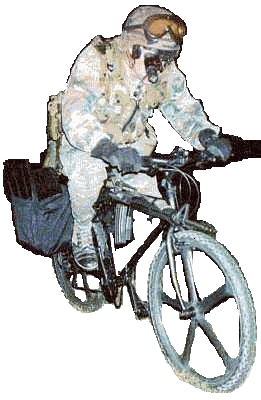
The sad truth is the FPOC is VERY HEAVY and we don't see it being widely used. It needs trucks to be used. The "book solution" of cutting 6-8 inch diameter logs DOESN'T HAPPEN.
a. Troops don't have saws of any kind
b. even if they did the "eco-nazis" are not going to let them cut trees and tree limbs down
Result?
U.S. ground forces are in danger in the next war in a rural setting NOT HAVING overhead cover to protect against bursting artillery and mortar shells IF THE CLASS IV barrier material doesn't show up, which is likely.
www.2ndbn5thmar.com/mrsm/pp04.htm
The frontal parapet fighting hole significantly strengthens a unit's defensive position. In 1976, the U.S. Army compared three types of fighting holes - open, split-parapet, and frontal parapet. Seventy-two platoon attacks were conducted against three types of squad positions. The results are shown in the table.1
Units fighting from frontal parapet fighting holes:
Suffer Less Friendly Casualties
Defenders in open holes are wounded three times more often than defenders behind frontal cover. Conversely, attackers need to fire three times more ammunition against parapet holes than against open holes to inflict a wound. And these casualty ratios apply only after the enemy has located the position.
Invisible fighting holes, not seen by the enemy, protect defenders from all fires and all casualties. On the modern battlefield, what can be seen can be hit, and what can be hit can be destroyed. Enemy tank cannon and missiles are precision instruments for destroying fighting positions, but not if the position cannot be seen.
Because a frontal parapet protects defenders while they engage the attacker, defenders inflict six times more casualties than they receive. One position prepared by the 1st Battalion, 18th Infantry at Loc Ninh in Vietnam caused a casualty ratio of 198 to 1.2
Defenders in invisible fighting positions surprise the enemy with effective fire from unknown locations, much like an ambush. Enemy support fires, from preparatory artillery and mortars, to machinegun, RPG, and missile fires are difficult to coordinate against unseen positions.
U.S. Army 1976 Fighting Hole Evaluation |
|||
|
Analysis |
Type of Fighting Hole |
||
|
|
Open |
Split Parapet |
Frontal Parapet |
|
1. Casualty Exchange Ratio Atk: Def |
2.9 : 1 |
5.1 : 1 |
6.2 : 1 |
|
2. Time Defenders were suppressed |
48.9 % |
38.4 % |
34.6 % |
|
3. Defender's Angle of Engagement Day Night |
20.1 21.8 |
21.1 26.5 |
32.1 37.7 |
|
4. Attacker accuracy. Hits per 100 rounds. |
3.1 |
1.4 |
1.0 |
When an open hole is suppressed by the enemy, the defender is forced to duck almost 50% of the time. While defenders cannot see and cannot use their weapons, enemy units maneuver to assault.
Frontal cover defeats suppression. Frontal cover defeats the enemy's mutual support, overwatch, fire and movement, and assault fires. Defenders in frontal parapet fighting holes are not suppressed by direct frontal fire and their return fire reduces the effectiveness of the attacker's fires. Frontal parapet positions enable defenders to keep firing on an advancing enemy even when subjected to both indirect and direct fire simultaneously.
Defender's fires are equally accurate from all types of holes, approximately 12 hits per 100 rounds, with no difference in kill ranges. Defenders in open holes, however, become significantly less effective once they are suppressed and begin taking casualties.
* Strong defensive positions are psychologically important. Well-entrenched units are eager to aggressively engage the enemy.
* The frontal parapet fighting hole, known in the US Army as the DePuy (da-pew) fighting hole, was named after General William E. Depuy:
" In World War II...we saw the German Soldier...on...rare occasions, nor were we able to suppress him...when I looked...I was impressed by the way he picked positions where his body and his head were protected from frontal fire yet he was able to defend...no matter what we threw at him."3
* Some defenders are concerned about the parapet fighting hole being blind to the front. Defenders shoot 90% of their attackers on an oblique angle anyway, even from open holes, so frontal observation generates tremendous vulnerability in exchange for a small degree of freedom to observe and fire that is rarely used.
Frontal parapet fighting positions:
* Take time and work to construct.
* Take tools and materials to construct.
* Are more challenging to select, lay out, and coordinate.
* Are blind to the front.
* Limit fields of fire, especially for machineguns.
* Are dependent on adjacent positions for mutual support. 4
Overhead cover provides ten times more protection than open holes. In 1976, the German Infantry School at Hammelburg conducted a fighting position test. They fired artillery and mortars at three types of infantry positions, hasty positions in the open, trenches without overhead cover, and trenches with overhead cover. Infantry in the open suffered 100% casualties, those in trenches 30%, and those under covered positions, 10%. A separate 1977 U.S. Army test at Fort Leavenworth found that seven anti-tank fighting positions were destroyed for every enemy armored vehicle destroyed, but not by return fire - ninety-five percent of these fighting position losses were from indirect fire.5
Overhead cover permits a defender to use indirect fire on his own position, a tactic used by the Japanese during World War II.
During the Falklands War in 1982, a Scots Guards battalion preceded one attack on an Argentine Marine position with a generous artillery barrage. The defensive position was, "exceptionally well-prepared. Many fire trenches had deep bunkers...and these often burrowed under the natural overhang of rock." Not one man in these well-prepared positions was wounded by British artillery.6
1
See also: "Infantry Fighting Positions." TRADOC Message 16 December 1975. Selected Papers of General William E. DePuy. Compiled by Richard M. Swain. Fort Leavenworth, Kansas: Combat Studies Institute, U.S. Army Command and General Staff College, 1994. pp 171-175. See: "A New Fighting Hole." Thomas Greenwood. Marine Corps Gazette, April 1987, pp 57-59.
2,3
4
5
6
FIXES
* Units with M113 Gavins could carry conceivably several FPOC suitcases to be overhead cover roofs, however the UT2000 would be better since they can be cart/sleds, too.
* The U.S. military needs a LIGHTWEIGHT overhead cover roof system derived from the half-SKEDCO plastic to take the British KIP idea and make it work. They should have 4 aluminum poles to undergird the SKEDCO plastic which would be staked to the ground using non-stretch kevlar cords. Then plastic sandbags would be filled and stacked on top to create a 18 inch layer. Lastly, a Rhino Snot backpack sprayer would seal everything to repel water and be sturdier in the face of enemy fires received.
* The half-SKEDCO should be modified with lashings/tent stakes to become a center roof for overhead cover on a 2-man fighting position and each 2-man buddy team should have one.
www.skedco.com
* Helmets should have a simple netting so strips of old BDUs and burlap can be tied to create a "rag top" to break up the outline and blend the Soldier into his surroundings for effective camouflage.
www.combatreform.org/camie.htm
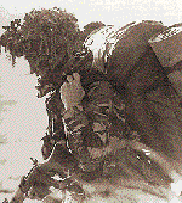
Berets are great morale boosters but they should be worn AFTER the shooting is over. The Royal Marines were foolish to wear berets just to look different from the smarter Paras who wore helmets with ragtop camouflage.
www.combatreform.org/bberet.htm
7. Engineer Cavalry: time to train and live as we would fight
"The next night I cleared a route with our combat and attached Royal Engineers from the saddle between Mt.Challenger and Mt. Wall southwest track, to the track, and the following night I sent out 5 troop, under Sgt Weston and a small recce section under Sgt Collins to find a route round the south of the minefield."
In previous lessons learned the reader will note Brits stepping on land mines, loosing limbs and compromising the mission.
WHERE WERE THE ENGINEERS (SAPPERS?).
Why should someone DIE or be maimed before Sappers are called in?
The reason is that Sappers are NOT ORGANIC TO INFANTRY.
USMC/Army Lessons Not Learned
The snobby U.S. military infantry think all war is is a giant gunfight with them as the victorious gunslingers. If they encounter trouble THEN they call on a lesser life form to bail them out, then step aside and let them finish the job and get the credit. This is too late. The enemy is blowing American Soldiers and marines regularly in Iraq and there is no "immediate action" the bomb goes off and Americans are dead. We need preventative measures and this means SAPPERS NEED TO BE PERMANENTLY ASSIGNED TO INFANTRY UNITS TO FORCE THEM TO FACTOR IN THE HIGH EXPLOSIVES DOMINATED NON-LINEAR BATTLEFIELD.
FIXES
* Assign a Combat Engineer Squad to EVERY Delta Weapons company and AT platoon that re-equips with M113 Gavin light armored tracks to get Sapper capabilities to the FRONT of the lead elements as they move forward.
www.geocities.com/armysappersforward
8. Where were grenade launchers?
"Once identified, we found anti-tank weapons ideal for engaging the enemy. We fired Milan in conjunction with mortar and other illuminants, and though on one occasion it hit the wrong target it had a shock effect upon the enemy sufficient to persuade them to stop firing! 84mm Carl Gustav HESH rounds proved remarkably effective up to 150m and on two occasions I watched them completely shatter enemy machine gun teams. 66mm were also used effectively up to approx 50m, to suppress the enemy fire. Regrettably we had no M203, m79 or smaw which would have been most effective."
USMC/Army Lessons Not Learned
While we have 40mm grenade launchers, designated men do not wear the necessary load bearing vests and do not train on them because we lack a way to train non-lethally for the 40mm grenade.
FIXES
* Supply Rifle/Hand Grenades to EVERY Soldier
www.combatreform.org/riflehandgrenades.htm
* Develop a soft rubber paint ball 40mm grenade that can be used in force-on-force training using SIMUNITION FX cartridges
www.combatreform.org/ttprpg.htm
9. Vulnerable Harrier jump jets can't hunt for targets to do CAS, small scout helos can't collect forward recon
"but on the first mission the FAC and Harrier never made contact. Much of the FAC's equipment had been left behind due to the 12 mile manpack move.
2 Harrier GR3 (ground attack Variant) sorties each involving 2 Harriers were used in the day preceding the battle, but on the first mission the FAC and Harrier never made contact. Much of the FAC's equipment had been left behind due to the 12 mile manpack move. This also explained the lack of mortars and artillery assets.
The second ill-fated sortie was flown by wing Commander Pete Squire and squadron leader Bob Iveson; Iveson had also flown the first sortie. The Harriers made two passes and then Bob Iveson decided, on his own
initiative, to make a third run to attack some trenches, ironically the trenches on Darwin Hill that were later to cause so much trouble to 2 Para. Let me tell you fast movers, Harrier pilots particularly, what he wrote;
"It was a silly move, a very poor tactical move, and it cost me because it was on that pass that I was hit. I was coming off target, heading roughly west, and was hit by two fairly large-calibre shells - probably 30 or 35 mills -a hell of a thump which rattled me round in the cockpit banging my head on the side of the canopy - it moved the aircraft sideways that much. Things went very wrong, very quickly, after that. The controls stopped working; there was smoke in the cockpit and finally fire, at which point I pulled the handle. I was in a good attitude to eject but I was a bit fast and a bit low - about 450 knots at 100 feet.
The chute opened and I found myself going right towards the fireball of my aircraft in front of me. I couldn't tell whether it had struck the ground or not. I think now it had blown up in the air. I was only on the chute for about ten to fifteen seconds before I hit the ground, in a bit of a heap and very winded.
...throughout the battle for Goose Green, 2 Scout Helicopters from 3 cdo bde air sqn were used to fly in ammunition and evacuate casualties, including the co, Lt Col H. Jones. They were finally attacked by a pucara aircraft, and after a 5 minute game of cat and mouse, one was shot down killing Captain Dick Nunn RM instantly. He was the Brother of Chris, coy cmd of m coy 42 cdo, at this time in South Georgia.
Chuck Myers' Maneuver Air Support (MAS) doctrine factors in the realities that fast mover aircraft can neither see targets to engage them nor survive at low level even if they could:
www.geocities.com/usarmyaviationdigest/mas.htm
USMC/Army Lessons Not Learned
Naval aviation is in a severe crisis now with the F-35 Joint Strike fighter in danger of being cancelled and the overweight, sluggish F-18 Stupor Hornet becoming the defacto only aircraft type other than the Hawkeye family on U.S. aircraft carriers. America's Navy is one program cancellation from becoming the Japanese Navy in WW2 having aircraft carriers and no planes to operate from them.
Without GFACs on the ground fast-movers like the Harrier and Stupor Hornet are more a danger to their own friendly troops via fratricide than to the enemy. If however, a GFAC can shine a laser beam on the exact target they can provide Distant Air Support (DAS):
"A Harrier strike was therefore called and we had a bird's eye view of the laser guided: bomb striking on target."
However, DAS is not CAS nor the even better MAS ground maneuver troops needed in the Falklands and today on the non-linear battlefield (NLB).
FIXES
* Create 2-seat OA-10 "SeaHogs" and deploy them on our carriers and in USAF Air Expeditionary Forces so we can solve the empty aircraft carrier problem as well as get a second set of eyes in the sky to act as an Airborne Forward Air Controller (AFAC) to render MAS
www.combatreform.org/aircommandos.htm
* Have enlisted GFACs and AFACs do tours on the ground and in the air to gain the best vision and expertise possible
* Light Mechanize and have plenty of human powered mobility devices so GFAC gear is taken to the fight to enable aircraft to contribute
10. Where was the air recon?
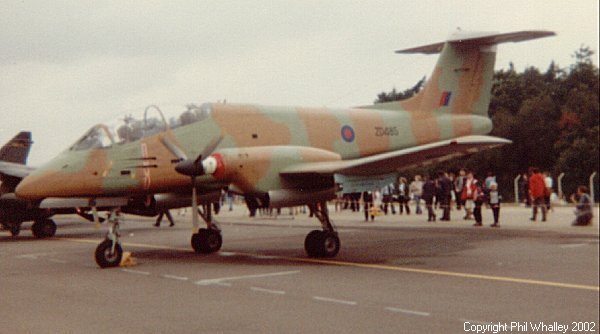
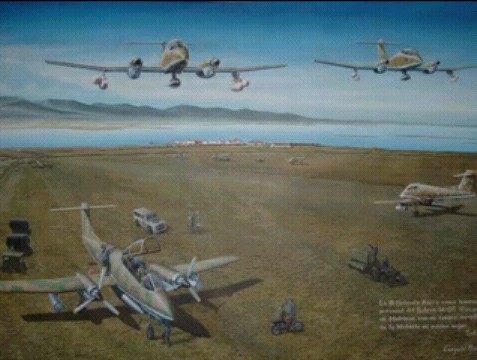
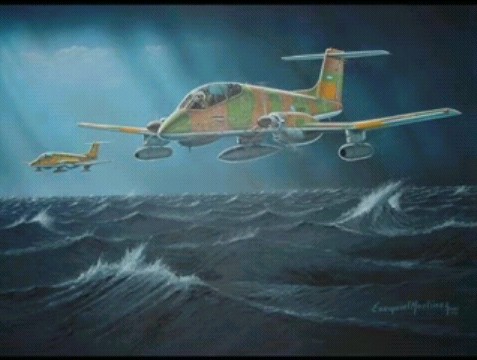
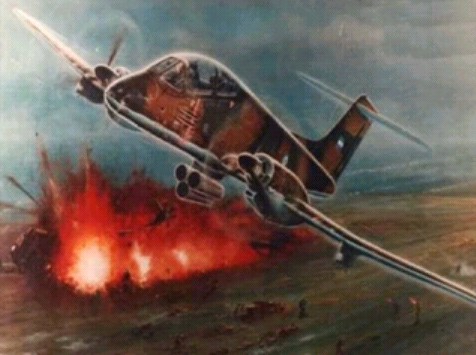
"we had no air photographs nor any up-to-date information other than that which we had ourselves gathered."
Many desirable assets were omitted due solely to lack of space. The most significant of these were perhaps rpvs & 155 guns. RPVs because we had no available assets for aerial reconnaissance and photography, and these would have given us the required real time information. The 155 guns would have been useful as they would have enabled us to engage the airfield prior to the battles for Port Stanley; and also they deliver a much greater punch than the 105's that we presently have. As it happened, the logistic tail to sp these guns would have been unattainable; but more about that in pt ii the land battle. As you can imagine, the landing force was effectively a "come as you are, if you can party".
Notice that the Brits cannot send their small observation/attack helicopters forward to gain recon lest they get shot down by Pucara turboprop COIN observation/attack planes. They also did not have RPVs called UAVs today.
Its peculiar that the Brits captured some Pucaras, feared them so much yet haven't bothered to get their own. To penetrate enemy air space itas doubtful that the attack helicopter can survive, but a faster 200-500 mph, armored fixed-wing plane can. Small helicopter "Killer Bees" can be great as long as they stay close to where the troops they are supporting are.
www.combatreform.org/killerbees.htm
USMC/Army Lessons Not Learned
Both services have bought into the overly complex turbine helicopter panacea and are losing their shirts trying to keep them flying as the troops lack a continuous overhead presence (MAS) to keep enemies from laying roadside bombs. The Army got rid of its OV-1 Mohawks and the USMC its OV-10 Broncos and are now in a jam. UAVs simply do not work to detect cunning human enemies who know how to hide with C3D2. Shame on them both!
FIXES
* Purchase simple, trailer-mobile MANNED Observation/Attack planes OWNED BY THE GROUND MANEUVER UNITS THEMSELVES AND CO-LOCATED TO INSURE AIR RECONNAISSANCE IS AVAILABLE
www.geocities.com/usarmyaviationdigest/grasshoppersmustreturn.htm
11. Mortars need Vehicular Mounts
"42 cdo rm also had to provide mortar fire support, as the scots guards tubes got sunk in the peat after the first rounds, having been inadequately bedded in."
Mortar baseplates get easily stuck during dismounted use by the extreme recoil forces driving the plate into the ground. Rebels to do hit & run mortar attacks frequently leave baseplates in order to get away with the tube.
USMC/Army Lessons Not Learned
Neither of America's light forces understand their need for vehicle-mobile mortars that can shoot from the vehicle. Other nation's armies have TURRETED mortars that can fire at high rates plus point & shoot direct fire engage targets and we are still fooling around with hand emplaced mortars.
FIXES
www.combatreform.org/120mortars.htm
The 82d and 101st infantry battalions have a single 81mm mortar platoon with 8 Humvee trucks and 6 mortars.
The 10th and 25th infantry battalions have a single 81mm mortar platoon with 6 Humvee trucks and 4 mortars.
If we replaced their Humvee trucks with M1064 series Gavins, we improve the armor protection, cross-country mobility and indirect 5 km firepower because they can shoot instantly from the vehicle using a turntable without having to run out and set up a mortar baseplate. We can increase range to over 7 km and HE firepower (vital in long range desert and mountain warfare) by using the 120mm mortar in the M1064A3 variant. If we stretch the hull there will still be troop space inside to carry 10 men for an additional lift of 60-80. If the mortars are dismounted then 105-120 men can be transported.
12. We must be able to use enemy weapons against them
"As a diversion, it opened up on the enemy positions opposite, firing various enemy weapons captured previously; it sent up schermulies and made a great deal of noise aimed at deceiving the enemy into believing an Argentinean patrol was engaged with it. Even if this deception was not believed, the spectacle was likely to divert attention from the two rifle coys skirting South to the fup."
The above idea of using the enemies own weapons to divert their attention is brilliant!
USMC/Army Lessons Not Learned
However here in the U.S., only "special" forces are allowed to be creative and considered "worthy" to use enemy weapons. This is total rubbish.
FIXES
EVERY infantry/armor unit should have captured weapons in their arms room to conduct training on them so they can:
* use enemy ammunition against them
* attach captured weapons to their vehicles as counter-ambush weapons
www.geocities.com/transformationunderfire/thunderrun.htm
* Have "Vulture" squads whose sole purpose is to collect enemy weapons and ammunition to distribute it to all other Americans within their unit to keep them supplied and able to fight if the U.S. logistics system breaks down
13. EPWs
"Guarding them and sending them back to bde cages became a real problem for no fighting sub-units could be spared as a counterattack surely must be mounted"
Another aspect of the light infantry narcissists refusing to face combat realities like when their own men cease to be able-bodied is when they suddenly gain enemy captured able-bodied prisoners. There is no way to carry them on our own bodies and herding them takes combat power away.
USMC/Army Lessons Not Learned
Because Americans waste so much time on BS garrison appearances they spend no time on the "tricks" needed to win wars that Larteguy talks about. We should get rid of almost all permanent buildings on Army/marine posts, period.
www.geocities.com/strategicmaneuver/battleboxes.htm
FIXES
* Clearly, having light tracks with trailers with carrying capacity and trailers can absorb captured EPWs and move them around to a holding area manned by MPs.
* ALL Soldiers should be trained to search, blindfold and restrain EPWs using expedient means like their shirts pulled down over their arms, Prusik EPW ties, etc. and not just rely on the supply system providing them plastic flex-cuffs
14. IFF
We were also most concerned about recognition at Night. Eventually we decided upon a small 2-4 inch strip of white tape on our belt harness just below the Shoulders.
Fratricide is what killed former NFL football star Tillman in Afghanistan.
USMC/Army Lessons Not Learned
U.S. troops hardly ever go to the field and spend most of their time playing BS garrison barracks games.
FIXES
If we trained DAILY in full combat gear and stayed overnight at least once a week we'd discover what we need to identify friends and foes NOW before a war starts.
www.geocities.com/skedco2000/nvghelmetcover.htm
15. Troops denied souvenirs
"As you can imagine we collected a great pile of weapons, magazines, bayonets, etc.; Sadly we as individuals were allowed to bring none back, but each unit retained a number of specialized weapons for subsequent worldwide contingencies. What happened to the surplus 8000 weapon: they were tragically dumped in the sea!"
This is yet another manifestation of the "kill-joy" mentality that Dr. Norman Dixon details in his book, "On the Psychology of Military incompetence"
www.geocities.com/militaryincompetence
Military life attracts people full of anxieties about themselves and life who must "sheath the sword". They MUST keep the troops in check. They must keep them under control. Nevermind that WE NEED ENEMY WEAPONS SO WE CAN HAVE AN USE-THEIR-AMMUNITION-AGAINST-THEM-IN-EVENT-OF-OUR-OWN-LOGISTICS-COLLAPSE CAPABILITY (see Lesson #24).
USMC/Army Lessons Not Learned
In America the same politically correct curb-your-enthusiasm crap takes place with those who do not go along severely punished. Is it a wonder we have airliners flown into buildings after the suicide hijackers produce mere box cutter knives?
FIXES
LET THE FUCKING TROOPS KEEP WHAT THEY FIND.
THEY DESERVE IT.
If its an automatic weapon, REMOVE THE SEAR so it cannot fire on full auto.
How hard is this?
Its not.
Some people just want to fuck the troops over.
1. www.raf.mod.uk/equipment/nimrodmr2.html
Aircraft of the RAF
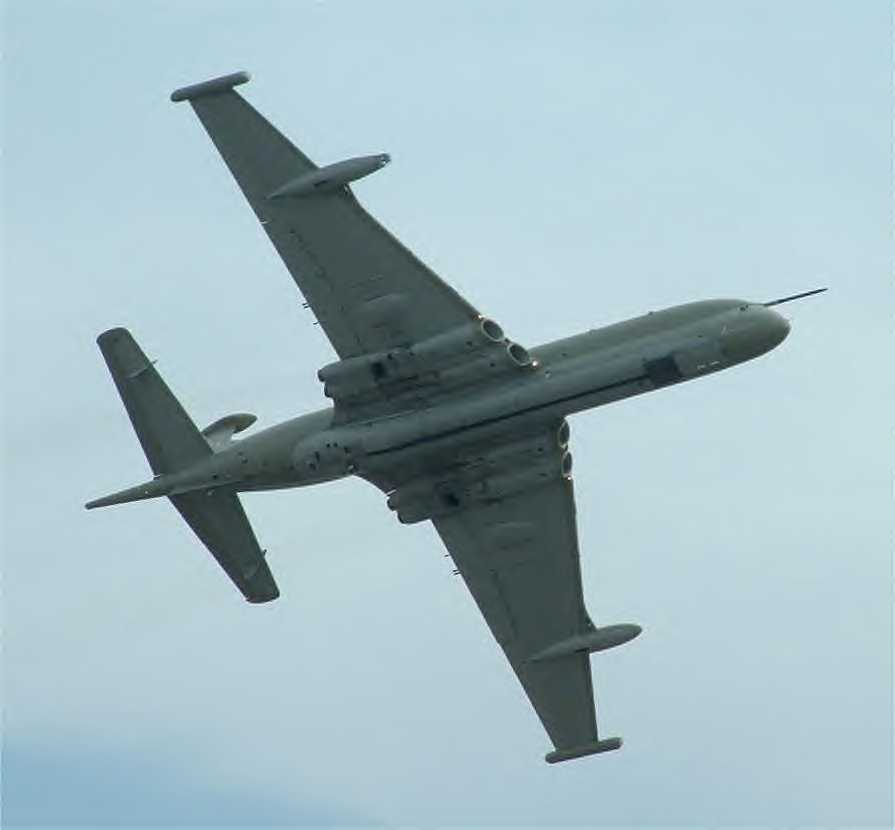
Nimrod MR2
Four-engined maritime patrol aircraft Crew of 13 Can fly for 10 hours without refuelling Details The Nimrod entered service in 1969 as the MR1 version. Based on the civilian Comet airliner, the Nimrod was, and remains, the only jet powered long range maritime patrol aircraft in military service. Offering the advantages of speed and height during transit, while still capable of long patrol periods and, in particular, stealth in the anti-submarine mission. (Propeller-engined aircraft make a discrete resonance that can be detected by submerged submarines whereas the jet noise of the Nimrod is virtually undetectable.)
In the early 1980s, the aircraft was upgraded to MR2 standard; while the flight deck and general systems remained the same (apart from the later addition of an air-to-air refuelling probe as a result of lessons learned during the Falklands War in 1982, the main underwater and search systems were given a significant upgrade. All Nimrod MR2s are operated from RAF Kinloss, equipping Nos 120 and 201 Squadrons along with the Operational Conversion Unit, No 42 (Reserve) Squadron.
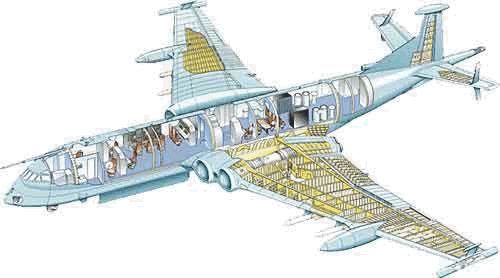
The Nimrod carries out 3 main roles; anti-submarine warfare, anti-surface unit warfare and search and rescue. It has an unrefuelled endurance of around 10 hours and, although capable of carrying 25 people, the operating crew comprises the following:
2 Pilots and a flight engineer operate the flight deck. 2 Navigators, who swap between routine and tactical responsibilities every other sortie. An Air Electronics Officer (AEO), who is sensor and communications coordinator. The sensor team includes 3 Air Electronic Operators (known as 'wet men') who are responsible for monitoring both active (searching) and passive (listening) sonobuoys. The remaining 4 Air Electronic Operators (known as 'dry men') manage a wide range of avionics and weapon systems essential in delivering Nimrod's capability.
Nimrod Specifications
Engines:
Four Rolls-Royce Spey turbofans
Length: 126ft 9in (38.63m)
Wingspan: 114ft 10in (35.00m)
Top Speed: 575mph (926km/h)
Accommodation: Crew of 13.
The Nimrod bomb bay carries the Stingray torpedo and the Harpoon missile for the anti-surface unit mission while for search and rescue duties the aircraft has a selection of air deliverable multi-seat dinghies, survival packs and other stores. The aircraft was also fitted to carry Sidewinder air-to-air missiles during the Falklands War (to allow for opportunity attacks on opposing surveillance aircraft more than for self-defence). Internally the aircraft can carry around 150 sonobuoys of several different types.
The majority of Nimrod tasking comes from the Maritime Headquarters (MHQ) at Northwood. Peacetime work includes surface and sub-surface surveillance and taking part in maritime exercises around the world; much of the Nimrod's work is in support of naval forces and it is essential to remain current in joint operations. There is always an aircraft on one hour readiness for search and rescue, primarily for downed military aircrew and military maritime incidents, however, Nimrods are tasked by the Air Rescue Coordination Centre, co-located at Kinloss, to attend many civil incidents. Such activity may include carrying out searches, assisting search and rescue helicopters or acting as on-scene commander at major incidents such as the Piper Alpha oil-rig disaster. The aircraft can operate as low as 200 feet whilst over the sea.
Although the Nimrod airframe is old the MR2 remains a potent and respected maritime patrol aircraft; mission system updates will maintain that capability. It has served with distinction in the Falklands Conflict, two Gulf Wars and in support of the maritime blockade of the Balkans during the Bosnia crisis, while also regularly monitoring Russian naval movements, both sub-surface and surface, in the North Atlantic during and since the Cold War. The Nimrod MR2 will continue in service until all squadrons will have been re-equipped with updated and re-engined aircraft known as Nimrod MRA4s.
A dedicated electronic intelligence version of the Nimrod, the R1, is described HERE.
Roles
Anti-Submarine Warfare (ASW). Aerial patrols monitoring the activities of submarines.
Anti-Surface-Unit Warfare (ASUW). ASUW covers a wide range of operations involving surveillance and reconnaissance missions that may culminate in the targeting and attack of enemy vessels. Search and Rescue (SAR). Nimrods can support SAR operations by assisting in the detection and location of personnel in emergency situations, providing a communications relay with attending helicopters.
Armament
Internal bay for up to nine torpedoes, bombs and depth charges; Sidewinder AAMs can be carried on underwing pylons for self-defence.
Recognition
Long 'double bubble' fuselage (1) with the cockpit built into the steeply raked nose (2). The fuselage tailcone extends well beyond the fin and rudder to house a magnetic anomaly detector (MAD) unit (3). The low-set wings are slightly swept on the forward edge. The four turbofans are buried in the inboard section of the wings (4). Bullet-shaped wing fairings project from the leading edges towards the wingtips. The Nimrod's fin, which has a large dorsal section extending well forward, is surmounted by an elliptical-shaped fairing (5). An in-flight refuelling probe projects from the fuselage above the cockpit.
Squadrons
120 Squadron , 201 Squadron 42 (Reserve) Squadron, RAF Kinloss , [ RAF Kinloss website ]
2. Dr. James Corum's excellent article on the Falklands War
Document created: 20 August 02
Air
& Space Power Journal - Fall 2002
DISTRIBUTION
A:
Approved for public release; distribution is unlimited.
An Operational View
| Editorial Abstract: Air warriors can learn many important lessons from the Falklands War. For example, the British experience demonstrated the value of long-range aerial early warning systems, while successful Argentine Exocet attacks revealed the dangers of antiship missiles. The Argentine air force was at a great disadvantage but did surprisingly well. While most of the senior Argentine government and military leadership demonstrated how not to wage war, Argentine airmen exhibited impressive competence and courage at the operational and tactical levels of war. |
THE FALKLANDS/MALVINAS War of 1982 is especially notable for airmen.1 The decisive battle that determined the fate of the islands was fought in the air. In fact, the ground war was largely a sideshow. If the Royal Navy had not been able to fend off Argentine air attacks and protect its fleet, no British landings on the Falklands would have been possible. With-out long-range airlift from the Argentine mainland to sustain the large Argentine ground garrison, those forces would have been cut off and forced to surrender in spite of any success they may have had on the battlefield.
The Falklands War pitted two modern and capable air forces and naval air arms against each other. Indeed, Argentina's air force was rated as the best in South America. The war, Argentina's first in over a century, represented a grand opportunity to step into the limelight as a serious military power. It is notable that the Argentine air units bore the brunt of the battle during the six-week war and inflicted serious damage and losses on United Kingdom (UK) forces, in contrast to the quite minor losses inflicted on those forces by the large Argentine ground force.
This article examines the tactical and operational effectiveness of Argentine air units in the Falklands War. Several issues will be addressed, including the effect that the Argentine junta's strategic decisions had on air operations; the problems of command at the operational level; and the effect that prewar training, equipping, and organizing had on combat operations.
The act of sending a military force to occupy the Falkland Islands on 2 April 1982 was apparently a spur-of-the-moment decision taken by Argentina's ruling military junta. The Malvinas had been a festering problem ever since Britain had illegally seized the islands in the 1830s. Negotiations between Argentina and Britain were in progress. However, the junta feared that Britain would send a military garrison to the islands after an incident with an Argentine fishing trawler in the also disputed South Georgia Islands.2 Seeing a window of opportunity to act before the British sent a significant force to the Falklands, the junta ordered the islands seized in March 1982.
On Friday, 2 April 1982, 500 Argentine troops landed and quickly captured the 84-man garrison of Royal Marines at Port Stanley, which they immediately renamed Puerto Argentino (fig. 1). At this point, the junta expected to open negotiations that would allow Britain the opportunity to cede sovereignty of the islands. The Falklands was a small colony with a population of only about 2,000 hardy sheepherders. It was, frankly, a strategic liability, and supporting the colony was a burden for the British taxpayer. To the junta's surprise, the United Kingdom responded with an ultimatum for an immediate Argentinian withdrawal, and that was accompanied by a clear threat of war. When Argentina rejected the demands of Prime Minister Margaret Thatcher, the British government simply announced that the islands would be retaken by force and began a large-scale mobilization to organize a naval task force and ground forces to invade the Falklands.
|
Figure 1. Sites of Operational Activities during the Falklands War |
The Argentine government, although led by professional soldiers, thought of the seizure of the Falklands as a political act to obtain a diplomatic bargaining chip-not an act of war. In fact, the junta was so sure that Britain would accept its action as a fait accompli that no plans or special preparations had been made to repel a British task force and defend the islands. Now, with that powerful British task force being assembled and expected to arrive in three to four weeks, the Argentine armed forces had to cobble together a force and create a plan to defend the Falklands. It was to be a truly "come-as-you-are war."
Command Arrangements
Faced with war, the junta set up a complicated command arrangement to direct combat operations. A theater command, the South Atlantic Theater of Operations (TOAS), was created under Vice Adm Juan Lombardo to command Argentine naval units and the Falklands garrison. Subordinate to Admiral Lombardo, Brig Gen Mario Benjamin Menendez was to command all the army, air force, and navy units deployed to the Falklands (which amounted to over 10,000 men by the end of April). On 5 April the air force operational headquarters (Strategic Air Command-TOAS) set up a special force called the Southern Air Force (Fuerza Aerea Sur [FAS]) under the command of the air force's Brig Gen Ernesto Horacio Crespo. General Crespo, commander of the 4th Air Brigade, was a highly experienced pilot and commander and was given the pick of Argentina's aerial strike forces with the primary mission of attacking the British fleet. The air force was outside the authority of the theater commander and reported directly to the junta, although it was supposed to coordinate its efforts with the other commands. It was not an effective command arrangement for developing strategy or conducting operations.3
Argentine Air Force/Naval Air Arm
Fuerza Aerea Argentina (FAA) was the country's large, relatively modern, and capable air force, particularly when compared to the militaries of most midsized powers. The FAA possessed some frontline aircraft equal to any in the world-including Mirage III interceptors. During the previous decade, they had acquired Israeli-made Mirage 5 fighters (called Daggers), which can operate at Mach 2 and are effective in both the air-to-air and strike roles.

The naval air arm was in the process of acquiring a squadron of Super Etendard fighters from France.

The primary attack aircraft of both the FAA and navy were several dozen A-4 SkyHawks that had been bought as surplus from the U.S. Navy in 1972. The A-4s were old (built in the 1960s) but still very capable. In 1982 they were still used by many air forces (including the U.S. marine corps) and were appreciated for their agility, toughness, and accuracy as dive-bombers. The latter was important.
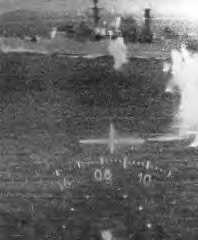
Unlike their British opponents, the Argentinians had no precision-guided bomb capability and required skilled pilots and accurate aircraft to hit targets with their "dumb bombs."4

On paper the FAA looked formidable. However, a modern air force is an expensive proposition, and midsized and smaller nations are financially constrained and required to tailor their air forces to meet the most probable threat. Chile would be Argentina's most likely enemy, and it also had a modern and formidable air force. Chile had long been a rival and had repeatedly gone to the brink of war over a long-standing dispute over ownership of the Beagle Channel located at the southern tip of South America. In 1978 tensions with Chile led to a full military alert in Argentina. For decades, the FAA had developed its force structure and training in anticipation of war with Chile. In such a war, the FAA would have flown short-range missions from bases close to the long Argentinian-Chilean land border. The aircrews of FAA's strike aircraft were well trained for that war and were proficient in close air support (CAS).
The FAA had never considered the possibility of waging a long-range naval air campaign against a major NATO power that would employ superior technology. The FAA had only two tanker aircraft (KC-130) to serve the whole air force and navy. While the FAA and navy A-4 SkyHawks were equipped for aerial refueling, the Mirage IIIs and Daggers were not, which dramatically reduced their ability as long-range strike aircraft and their time on station to provide fighter cover. Another problem was that the only aircraft capable of long-range reconnaissance were two elderly navy P-2 Neptune propeller planes. The FAA was also lagging behind in navigation avionics-as of April 1982, only one-third of the A-4s had been upgraded with the Omega 8 long-distance navigation system. Armament was the FAA's most serious deficiency. Its primary air intercept missile (AIM) was an early version of the French-made Matra 530 infrared air-to-air missile. It suffered from a six-mile range, a very narrow field of vision (30-40 degrees), and an infrared sensor that could lock onto an enemy fighter only from directly behind.6 The British Fleet Air Arm and Royal Air Force (RAF) Harriers could each carry four U.S.-made AIM-9L Sidewinder heat-seeking missiles. The AIM-9Ls were a generation ahead of the Matras, had a very wide field of vision (90-120 degrees), and had a much more sensitive infrared seeker that could lock onto the heat created by the airflow over an enemy aircraft. In short, the AIM-9Ls gave Harrier pilots a great deal more flexibility and allowed them to engage targets head-on.7
General Crespo quickly began organizing and preparing his strike force. With only a few weeks to prepare, he trained his force relentlessly. The Argentine navy provided a modern Type 42 destroyer to simulate British warships for training exercises with FAS Daggers and A-4s. It had modern anti-aircraft missiles and radar systems similar to those mounted on the Royal Navy vessels. The SkyHawks and Daggers made simulated attacks against the destroyer while it made evasive maneuvers and simulated a missile defense. The results were not heartening. The navy concluded that FAS strike pilots attacking modern shipborne air-defense systems would likely suffer losses of 50 percent.
While still training, the FAS deployed to four air bases within range of the Falklands: (from south to north) Rio Grande (380 nautical miles [NM] from Port Stanley) was home to 10 Daggers of Grupo 6 de Caza, four Super Etendards of the navy's 2d Fighter Squadron, and eight A-4Q SkyHawks of the 3d Fighter Squadron; Rio Gallegos (435 NM) was the operational base for 24 A-4Bs of Grupo 5 de Caza and 10 Mirage IIIs of Grupo 8 de Caza; San Julian (425 NM) hosted 10 Daggers of Grupo 6 and 15 A-4Cs of Grupo 4 de Caza; and Comodoro Rivadavia (480 NM) was the wartime home of a detachment of Mirage IIIs from Grupo 8 and 20 Pucaras of Grupo 4 de Ataque. In addition, Trelew naval air base (580 NM) was home to eight Canberra bombers of Grupo 2 de Bombardeo, that also had the range necessary to reach the Falklands (fig.2).8 The Argentinians had 122 aircraft available, which included 110 FAS combat aircraft based on the Argentine mainland and 12 additional naval strike aircraft.
The junta made strategic and operational decisions throughout the campaign without consulting its senior service commanders or doing any serious study of the situation. Within days of the invasion, it was clear that the British were going to fight, and the junta started reinforcing the Falklands garrison. On 9 April 1982, the president and army commander Lt Gen Leopoldo Galtieri, without consulting the service staff or the officers responsible for the defense of the Falklands, ordered the entire 10th Mechanized Brigade to the islands. On 22 April, after visiting the Falklands, General Galtieri ordered the army's 3d Brigade to the islands. By the end of April, over 10,000 Argentine defenders were spread throughout the Falklands, with the largest force of 7,000 men located on East Falkland Island (which the Argentinians called Soledad) in the vicinity of Port Stanley. Resupply and reinforcement of their forces on the islands were complicated by a British naval blockade of the Falklands-enforced by three Royal Navy nuclear attack submarines. Argentina dared not use the sea to send any reinforcements or supplies. Thus, from the start, Argentinian forces in the Falklands were dependent upon FAA airlift.
Within days of the invasion it was clear that the British were going to fight.
The airfield at Port Stanley was the only hard-surface airfield in the Falklands. Its runway was fairly short-only 4,500 feet long-and therefore suitable for only civilian and military turboprop transport planes. Its short runway could not support operations by large civilian/military jet aircraft or any of the military's high-performance strike aircraft. The whole of the Argentine logistic and reinforcement effort depended on this one small airfield.
The FAA had a small transport force of seven C-130s and a few smaller Fokker F-27 twin-engine transports. Every national airline aircraft that was capable of landing at Port Stanley was pressed into service to ferry the troops and equipment that General Galtieri had blithely ordered to the islands. The FAA transport force performed extremely well-given its limitations. Indeed, the airlift effort of the FAA to support the forces in the Falklands lasted until virtually the last day of the campaign. However, the small transport force and the one short airfield drastically restricted the equipment that could be sent with the troops to the islands. The 10th Mechanized Brigade was sent to the Falklands without its artillery battalion or its vehicles. Virtually all of the army units were deployed to the islands by air and could bring only light weapons and vehicles-most of their equipment was left behind at their home bases on the mainland.9
A sizeable air force was also deployed to the Falklands to serve under the command of General Menendez-not under FAS command. To serve mostly in the reconnaissance and troop transport roles, 19 army, navy, and air force helicopters were sent to the Falklands.10 In April, 24 Pucaras of the 3d Attack Group were ordered to the islands. The naval air arm sent six Aermacchi 339 light strike aircraft and six T-34B Mentors. Because the Aermacchi jet aircraft needed a hard-surface runway, they were based at Port Stanley. The Pucaras, however, were built to operate in rough conditions, so most of these were sent to a small grass airstrip at Goose Green-a miserable little field that would turn into a quagmire after any rain. Some Pucaras, light transports, and the six T-34s were deployed to a tiny dirt strip on Pebble Island.
|
Figure 2. Operating Locations during the Falklands War |
The opening shots of the war came on 1 May 1982. The first wave of the British invasion force arrived in Falkland waters and took position approximately 70 NM to the east of Port Stanley.
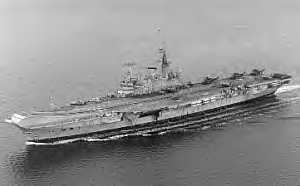
The British task force, under the command of Adm John Woodward, was built around two light carriers (Her Majesty's Ship [HMS]Hermes and HMSInvincible), over 20 destroyers and frigates, and a host of troopships and support vessels carrying a British brigade with full equipment. The two carriers each carried a complement of Royal Navy Harrier jets and helicopters. In all, the British first wave consisted of 65 ships protected by an array of modern radars and dozens of anti-aircraft missile systems to include the new Sea Darts (effective over long ranges and to high altitudes), Sea Wolves (for low-altitude threats), and an array of 20mm and 40mm guns for close-in defense.11 However, the Harrier was the primary weapon system for British strike and defense efforts throughout most of the campaign.
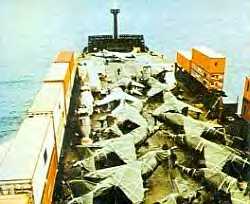
The small Royal Navy Harrier force would soon be reinforced by an additional 14 RAF Harriers arriving on the two large cargo vessels, the Atlantic Conveyor and Atlantic Causeway, that had been modified with flight decks for vertical takeoff and landing (VTOL) Harrier operations.
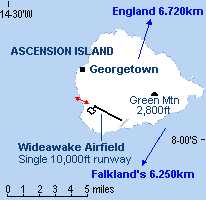
An additional four Harriers were flown all the way from Ascension Island, with numerous tanker refuelings, to reinforce the British late in the campaign.12 The Harrier was a more technically advanced aircraft than anything the FAA flew. Although it had a short range, it could fly combat air patrol (CAP) over the fleet for 40-60 minutes, a significant time advantage over the Argentine attackers, who had, at best, a few minutes to find and engage their targets. During daylight hours, the Royal Navy tried to maintain continuous CAP coverage over the fleet with two Harriers armed with AIM 9L Sidewinder air-to-air missiles. However, the limited number of Harriers made maintaining continuous coverage difficult, so the Argentinians' best hope was to strike the fleet while the Harriers were diverted or on deck refueling.
Air Operations: The First Day
The battle began before dawn on 1 May 1982 when a long-range RAF Vulcan bomber, flying from the British base at Ascension Island thousands of miles away, bombed the Port Stanley airfield, cratering the runway and damaging some of the airfield support facilities. Shortly after 0800, 10 Harriers, armed with bombs and cannons, struck both the Goose Green and Port Stanley airfields in a low-level bombing attack. A bomb detonated near one Pucara and killed the pilot and ground crewman. At least two other Pucaras were damaged, and the airfields received moderate damage. The Argentine anti-aircraft fire was intense, and the Argentine forces were cheered by the claim that they had destroyed at least four Harriers during the British attack on Port Stanley. In fact, only one Harrier had received minor damage-a small 20 mm hole that was repaired in two hours. Three British warships joined the bombardment of the Port Stanley installations and began shelling from their station six miles off the coast.13
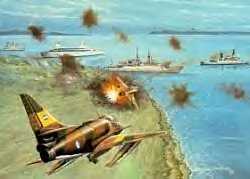
The FAS, now alerted to the British fleet in Falkland waters, began sending waves of strike aircraft covered by interceptors to attack the British ships. The FAS never had the option to send in a large strike force and use an advantage in numbers to overwhelm the British air defenses. Skyhawks needed aerial refueling to carry four 500-pound or two 1,000-pound bombs over a combat radius of 600 NM. The entire air refueling capability of the FAS was limited to two KC-130 tankers that could support the launch of only four strike aircraft at a time. Even then, each flight had to be carefully planned and scheduled in order to make the required refueling rendezvous.14
While the Skyhawks and the Argentine navy's four Super Etendards were capable of air refueling, the Daggers and the Mirages were not. Even using two 550-gallon drop tanks to carry extra fuel, the Daggers and Mirages were flying at the absolute limit of their range to reach the British fleet. The fighters sent to engage the Harrier CAP and cover the strike force would have no more than five minutes over the target area. The Harriers, on the other hand, could loiter for up to an hour and quickly refuel on the nearby carriers. The distance the Argentinians had to fly to engage the British was increased further by the Royal Navy's tactic of positioning its fleet 70-100 NM east or northeast of the Falkland Islands-that added another 150-200 NM to the distance and created additional fuel requirements for the Argentine missions. Moreover, the Argentine Mirages and Daggers, escort fighters capable of Mach 2, could not use their afterburners to employ their enormous speed advantage against the subsonic British Harriers because of the extra fuel it would consume. If the Argentine fighters were forced to use their afterburners during the course of their missions, they would consume the very fuel they would need to return to base.
The FAS launched almost all of its strike forces into action on 1 May 1982. The first two flights of fighters ingressed at medium altitude, failed to find the British force, reached their "bingo" fuel limits, and had to turn back. In midafternoon, the third flight of four Mirages sent to engage the Harriers found their prey. The flight of two Harriers flying CAP outmaneuvered the Mirages and quickly downed two of the Argentine fighters with Sidewinder missiles. A third Mirage pilot used up too much fuel to return to his Argentine base and tried to make an emergency landing at the Port Stanley airfield. The Argentinian air defenders mis-identified their Mirage for an attacking British aircraft, successfully engaged, and shot it down, killing the pilot.
The three British warships (one destroyer and two frigates) shelling Port Stanley were attacked by a flight of Daggers that dropped bombs and strafed the vessels with their cannons. This resulted in minor damage to one vessel. However, the elated Argentine pilots' bomb damage assessment (BDA) optimistically reported heavy damage to one ship and varying degrees of damage to two others.
Late in the day, a flight of two Canberra bombers from Trelew Air Base attempted to attack the British ships shelling Port Stanley. Approaching at medium altitude, they were picked up by British radar and intercepted by the Harrier CAP. As the old Canberras turned to run, one was brought down by a Harrier's Sidewinder, and the other-badly damaged by a Sea Dart missile-limped back to base.
The perceptions of the first day's battle largely set the tone for the whole campaign. The Argentinians claimed a triumph in damaging three ships and shooting down at least five Harriers. They also claimed that they had repulsed a British landing attempt when several Royal Navy helicopters flying towards East Falkland Island turned around and headed back to the fleet. Heartened by their perceived success, the FAS prepared to mount additional strikes, despite the loss of five aircraft and others damaged.15
In reality, the day had gone very well for the British. The task force had lost no planes and suffered only minor damage to one ship. The helicopter-borne "invasion force" that was repelled was actually a group of antisubmarine helicopters conducting a search for Argentine submarines in Falkland waters. Throughout the campaign, the Argentinians fought largely in the dark without much intelligence capability. Apart from pilot reports, the FAS had no means of getting an accurate BDA to evaluate its attacks. It had to rely on notoriously inaccurate pilot and antiaircraft gunner reports-which consistently overestimated the effect of both the Argentine defense and air strikes. On the other hand, the British could collect real-time intelligence by tasking Harriers to fly photoreconnaissance missions over Argentine forces in the Falklands. One must also assume that the United States provided the British with satellite imagery of Argentine air bases that allowed them to count and identify enemy aircraft on mainland runways.
One of the most serious FAS limitations throughout the campaign was the shortage of modern long-range reconnaissance assets. Unless the British fleet showed itself by moving close for a shore bombardment, the Argentinians had few means to locate the British ships. The FAS long-range reconnaissance assets consisted of two elderly P-2 Neptunes whose radar and passive systems could pick up ships at more than 50 NM. The other major Argentine intelligence asset was a very modern Westinghouse AN/TPS-43F radar and a supporting Cardion AN/TPS-44 tactical surveillance radar installed at Port Stanley and manned by Argentine air force crews. The Westinghouse radar was a state-of-the-art machine with a long-range capability that could "see" over the horizon. The very competent Argentine air force radar crews were often able to pick up the Royal Navy Harrier CAP at over 40 miles. By plotting the Harriers' flight patterns, the radar crew could often determine the approximate location of the British fleet.16 However, a combination of factors affected Argentine success.
For example, the shortage of reconnaissance assets caused a near void of accurate and timely intelligence. Furthermore, long distances between takeoff and targets were a significant limitation on the Argentine aircraft's ability to loiter/search in the target area, choice of tactics, and options for employment speed and maneuvers. Additionally, the weather in late autumn in the South Atlantic was generally poor. Since most Argentine aircraft and most of their weapons required daylight and visual meteorological conditions (VMC) for employment, the Argentinians were limited to a small window in which to attack. As a result of the combined effects of all of these limitations, approximately one-third of all Argentine aircraft sent to strike the British returned home without making any contact.
The greatest British weakness was the lack of long-range aerial early warning (AEW) aircraft that could identify enemy aircraft coming in at low altitude. When the Argentinians ingressed at or above mid-altitude, as they did on the first day, they proved to be easy prey for the Harrier's onboard radar. However, that radar could not easily acquire enemy aircraft flying at low level. During the rest of the campaign, the FAS aircraft exploited this weakness and attacked the British fleet from wave-top level, where they were very difficult to spot. This meant that the Argentinians would fly at the normal altitudes between 20,000 and 30,000 feet until about 100 NM to the target and then drop to about 100-200 feet above sea level (ASL) for the last leg of the attack and the initial egress. These were some of the most stressful and dangerous missions in the history of aerial warfare.
The First Exocet Attack
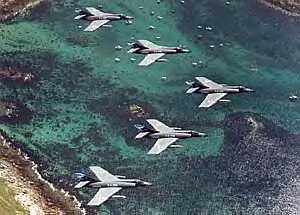
When the Argentinians landed in the Falklands, the naval air arm was in the process of standing up a new air squadron, the 2d Escuadrilla. The squadron's aircrews had recently completed training in France and had accepted five of the 14 x French Super Etendard fighters. Light strike fighters developed in the 1960s, the Super Etendards would soon go out of production in France.
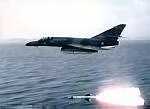

www.youtube.com/watch?v=NYUqC6VEuMI
The Etendards were significant because they were configured to carry the state-of-the-art Exocet antiship missile.17 The radar-guided Exocet, a large missile that carried a 950-pound warhead, could be fired at nearly 25 NM. It would streak along just above the wave tops at almost Mach 1, and once it acquired its target, it was very difficult to shoot down. If it struck its target, the result was likely to be devastating. It was an ideal stand-off weapon, and its range allowed the strike aircraft to avoid closing with the enemy CAP. The best defense against the Exocet was to create a strong radar return (by shooting large amounts of chaff [small metal strips] over the sea and away from the ships being attacked) on which the Exocet's guidance system would detect and engage, missing the real target.
The pilots of the 2d Escuadrilla, trained in France in 1980-81, were fully qualified with the aircraft. However, at the time the conflict in the Falklands began, only five of the Super Etendards and five Exocet missiles had been delivered from France. The Common Market nations and NATO immediately initiated an arms embargo on Argentina, therefore halting the French shipments of planes and missiles. Throughout the conflict, the Argentine government tried desperately but unsuccessfully to obtain more Exocets on the world market. Argentina would have to fight the war with only five Etendards and Exocet missiles. Since spare parts for the Etendards were cut off by the NATO arms embargo, the FAA decided to hold one of the five fighters in reserve and use it for parts to support the remaining four aircraft.
The Argentinians had no previous experience with anti-ship missiles [ASMs], and the Exocet was a complicated and cranky weapon. The Argentinians experienced a lot of trouble fitting the Exocet launch system and rails to the Super Etendards. In November 1981, Dassault Aviation, owned by the French government and builder of the Super Etendard, sent a team of nine of its own technicians (and some additional French Aerospatiale specialists) to work with the Argentine navy to supervise the introduction of the Etendards and Exocets. Although France complied with the NATO/ Common Market weapons embargo, the French technical team remained in Argentina and apparently continued to work on the aircraft and Exocets, successfully repairing the malfunctioning launch systems. Without the technical help and collusion from the government of France-Britain's NATO "ally"-it is improbable that Argentina would have been able to employ its most devastating weapon.18
Action on 2-3 May
On 2 May 1982 the decisive naval action of the war occurred when the British nuclear attack submarine HMS Conqueror sank the Argentine cruiser General Belgrano outside the 200-mile exclusion zone that the UK had established around the Falklands. A possible sortie of the General Belgrano, which was equipped with ship-mounted Exocets, represented enough of a threat to their task force that the British decided to torpedo the cruiser, killing 321 of the Argentinians aboard. From this point forward, the Argentine decision makers would not consider any further naval sorties, and the Argentine navy's one carrier remained in port. All hope of naval resupply for the Falkland garrison was ruled out, and the Argentine forces remained completely dependent on airlift.
Poor weather around the Falklands on 2 May forced the cancellation of all air activity, but on 4 May one of the Neptune reconnaissance planes identified what it believed to be the British carrier HMS Hermes east of Port Stanley. Two 2d Escuadrilla Super Etendards, each armed with one Exocet, took off for the long flight.
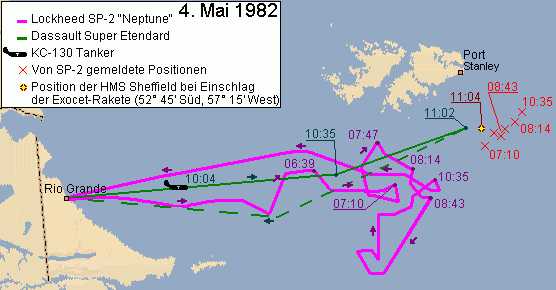
While still at a fairly long range, the Etendards picked up not the HMS Hermes but the HMS Sheffield, a Type 42 destroyer, stationed well out from the fleet for aerial warning and defense (the Type 42 destroyers carried the new Sea Dart antiaircraft missiles).19 The Argentinians fired both Exocets (some sources say the missiles were fired at the extreme limiting range of 26 NM; other sources say the missiles were launched at six NM). Once the missiles were fired, both aircraft prudently executed a low-level egress. One Exocet went astray, but the other found its target, crippled the Sheffield, and caused heavy casualties.
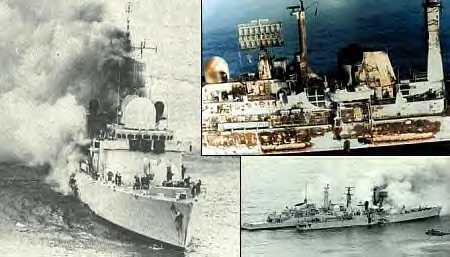
The Sheffield was later abandoned and sank six days later while being towed. Ironically, due to their lack of reconnaissance capability, the Argentinians had no idea whether either Exocet attack had been successful. However, the British policy of keeping the press and public informed of casualties actually provided the Argentinians an accurate BDA. The Argentine high command learned within hours that an Exocet had crippled the Sheffield. Had the British not announced the loss, the Argentinians would have likely concluded that their Exo-cets were still malfunctioning and called off further Exocet attacks.
Softening Up the Falklands
During the first 20 days of May, the British task force carried out a systematic campaign of bombing and shelling Argentine installations and forces in the Falklands. The first Harrier was lost to antiaircraft fire on 4 May while attacking the airfield at Goose Green. British aircraft sank two small Argentine ships, Port Stanley came under naval ship bombardment, and British helicopters and Harriers carried out air reconnaissance and dropped Special Air Service (SAS) teams to conduct reconnaissance behind enemy lines.
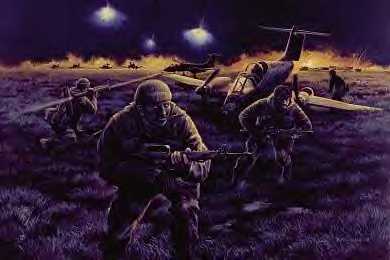
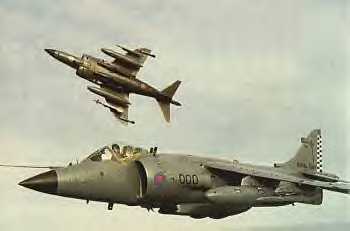
Whenever the weather cooperated, FAS sent flights of aircraft to hit the British task force. This task was made more difficult on 10 May when the two Neptunes were both taken out of service for repairs, reducing the Argentine long-range air reconnaissance assets to nil. The FAS then had to wait until the British showed themselves by moving in close to the islands for shore bombardment or close enough to be seen by the island's Argentine radar. The British had a formidable and layered air defense that used Harriers, missiles, and gun systems. General Crespo was forced to employ a combination of tactics to get at the British fleet. After the failure of the initial high-altitude attacks on 1 May, all further Argentine anti-ship missions were carried out at very low altitude in order to slip by the Harrier CAP and avoid the ship's radar. Most of the Argentine strike missions were also carried out in the late afternoon, when Argentine aircraft attacking from the west would have the setting sun at their backs. Another tactic employed by General Crespo, with some success, was the creation of an improvised squadron of FAA using commandeered civilian Learjets. The "Fenix" Squadron was based at Trelew-the Canberra bomber base. The unarmed Learjets would simulate an incoming Canberra raid by flying at high altitude in the general direction of the British fleet in hope of being picked up by the British radar and causing an unnecessary defensive response. At a safe distance from the British fleet and its response, the Learjets would turn and run for home. General Crespo hoped the unarmed Learjets would divert the British CAP and allow his SkyHawks and Daggers to get at the British fleet. At the very least, the Fenix Squadron forced the British to regularly scramble their Harriers and increased the British pilots' ops tempo and fatigue.22
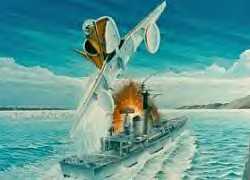
On 12 May 1982, FAS SkyHawks attacked the HMS Glasgow and HMS Brilliant while they were bombarding Port Stanley. The Brilliant's Sea Wolf missiles destroyed two SkyHawks, and another crashed while taking evasive action. However, one of the SkyHawks put a 1,000-pound bomb into the Glasgow. Luckily for the British, the bomb did not explode. However, the kinetic energy of the 1,000-pound bomb traveling at over 400 knots still badly damaged the Glasgow and caused it to withdraw from the scene. Many of the Argentine bombs in the campaign failed to explode when they hit the British ships. The failure was probably caused by releasing the bombs from such a low altitude that the fuse-arming-delay time exceeded the weapon's short time of flight; thus the fuse failed to arm and the bombs did not detonate.
On 18 May the second wave of the British invasion force joined the fleet, arriving with more warships, a second infantry brigade, and 14 RAF Harriers carried on the Atlantic Conveyor. Even with attrition, the British had more than 30 Harriers available to protect the fleet and fly ground-attack sorties. The British were now ready to land forces on East Falkland Island.
The British picked a landing site at San Carlos Bay on the northwest side of East Falkland Island opposite Port Stanley, which lies on the east side of the island. San Carlos Bay was chosen as the landing point because the bluffs and high hills surrounding the bay would mask the landing ships from Exocet missile radars. Indeed, the Exocet was the one weapon system that the British truly feared, and that concern governed their selection of strategy and dictated other operational choices to minimize the Argentinians' opportunity to employ their Exocets.
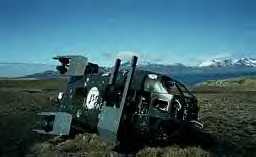
The British lost a Harrier and two Royal Marine Gazelle helicopters to ground fire during aggressive air strikes on Argentine airfields and installations in the Falklands on the morning of 21 May 1982. Now alerted to the British landing, the Argentinians sent virtually the whole FAS air strength-about 75 aircraft-to attack the British ships during the day.
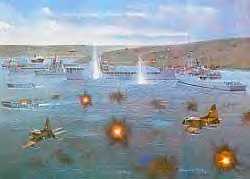
Staging in flights of four, the Argentine SkyHawks and Daggers dropped to a 100-foot altitude for the last 100 NM to San Carlos Bay. The high hills not only screened the British ships from Exocets, but also screened the Argentine aircraft from detection until the last moment.
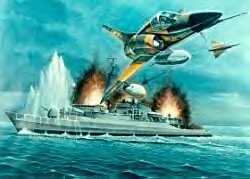
The Argentine Daggers and SkyHawks popped up over the hills and bored straight into the British ships. The British had dozens of air defense missiles (Sea Wolves, Sea Darts, Sea Slugs, Sea Cats, and shore-mounted Rapiers) as well as numerous antiaircraft guns to defend the ships. However, coming in at low level and popping up over the hills, the Argentinians gave the British no more than 20-30 seconds to acquire, track, lock on, and shoot before they released their bombs and headed for home.
It was a frightful day of combat. The frigate HMS Ardent was damaged in an early attack and sunk by a second Argentine attack late in the day.
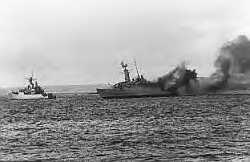
Argentine bombs-some of which mercifully did not explode-damaged four other ships.
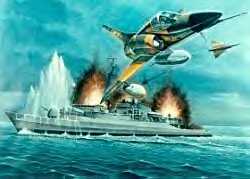
The HMS Antrim suffered heavy damage while the HMS Brilliant, Argonaut, and Broadsworde sustained moderate damage. The Argentinians paid a fearful price for their moderate success. The British downed nine FAS aircraft, including five Daggers and four SkyHawks. They also shot down two Pucaras and two helicopters from Argentine air units based in the Falklands. As the British landing continued, the FAS mounted further strikes. On 23 May, bombs released by SkyHawks flying from Rio Gallegos sank the frigate HMS Antelope. On 24 May two Harriers encountered a flight of four Grupo 4 Daggers and, in only moments, destroyed three of them with Sidewinders.
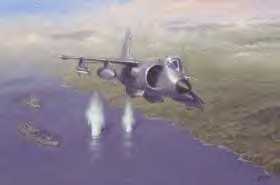
In other action another Argentine Dagger was lost. That day the British landing ships Sir Galahad and Sir Lancelot both sustained moderate damage from the kinetic energy of bombs that did not explode. The Sir Bedivere also suffered slight damage.
On the 25th of May, Argentina's Independence Day and its greatest national holiday, the FAS mounted a major air effort.
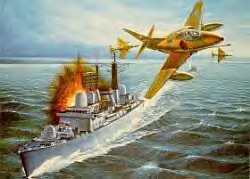
Although it lost three aircraft in the morning while trying unsuccessfully to get at the British fleet, in the afternoon, FAS SkyHawks succeeded in hitting the destroyer HMS Coventry with three bombs, causing it to sink in half an hour. At about 1630, Super Etendards of the 2d Escuadrilla launched two Exocet missiles at the HMS Invincible, stationed north of the landing site. As before, one Exocet went astray after possibly being hit by British anti-aircraft fire. Initially the second Exocet's radar locked onto the Invincible; however, large amounts of chaff caused it to break lock. The Exocet then searched, acquired, and locked onto the cargo ship Atlantic Conveyor that had no chaff protection; consequently, it was hit, crippled, and later sank. The British lost 12 men and the 10 helicopters the Atlantic Conveyor was transporting. That loss included one heavy-lift Chinook, which made army logistics much more difficult as the British relied heavily on helicopter resupply due to the Falklands' few roads and boggy terrain.
The 25th of May had been the worst day for the British in the campaign. However, by its end, most of the two ground-force brigades were ashore with their equipment and supplies and ready to mount the final offensive against the Argentine ground forces.
The British were well established on shore in the area of San Carlos Bay by 26 May 1982 and ready to begin their advance on the Argentine Army positions. At this point in the campaign, there was little that the FAS could do to stop an inevitable British victory. Even if the FAS had taken out one of the British carriers, the British could have operated-and in fact did operate-the VTOL Harriers from unprepared surfaces on the island. General Menendez, who commanded all Argentine forces on the Falklands, placed his troops in an extended defensive line, occupying positions on high ground across the eastern end of the island to defend Port Stanley. None of the Argentine battalion and regiment defense posts, however, were in a position to support the others. While the FAA's airlift had been effective in bringing 10,000 troops to garrison the Falklands, the available airlift had been able to bring only a small number of military vehicles and heavy weapons. The forces under General Menendez had a total of 159 vehicles of all types, including only 10 light armored cars.23 Most of the artillery had been left behind on the mainland, and the Argentine troops had very limited ammunition reserves. The two well-armed British brigades began their offensive on 28 May when they surrounded and forced the surrender of the isolated Argentine garrison at Darwin. The British then methodically rolled up the Argentine Army, position by position, until the last forces were cornered in an area around Port Stanley on 8 June 1982.
Although things were going badly for the Argentine forces and the air units had taken heavy attrition, the FAS pilots' morale and aggressiveness remained very high in a very tough situation. One possible reason is that the Argentine forces continued to overestimate the damage and casualties that they had inflicted on the British forces. The Argentine high command announced, and apparently believed, that as of 25 May 1982 they had sunk or disabled 19 British ships and shot down 14 British Harriers. In fact, the British had only five ships sunk and three heavily damaged-less than half the damage the Argentinians had claimed. Likewise, the British had lost only four Harriers instead of the 14 the Argentine anti-aircraft crews had claimed. Basing their logic on perception, however inaccurate, the Argentinians concluded that the Royal Navy would have to soon withdraw in the face of such attrition.24 On 30 May 1982, the 2d Escuadrilla made its last Exocet attack on the carrier HMS Invincible, following up with an attack by a flight of SkyHawks. Argentine forces, to this day, claim that they hit and crippled the Invincible with both the Exocet and the SkyHawks' bombs. Apparently, the Exocet was shot down by Royal Navy anti-aircraft fire and the hulk of the Atlantic Conveyor was mistaken for the HMS Invincible and attacked by the SkyHawks. Despite Argentinian claims, no British damage resulted from their last Exocet attack.25
The Harriers now began carrying out numerous CAS missions to help the British troops execute their campaign. The 24 FAA Pucaras based in the Falklands had been steadily whittled down by British strikes on the Port Stanley airfield and in air-to-air combat. Even so, the few flyable aircraft remaining at Port Stanley still tried to carry out strikes against the British troops. The Pucaras were generally ineffectual, and several were lost to British ground fire, Harriers, and portable anti-aircraft missiles (Blowpipes). However, one Pucara did score the only Argentine air-to-air kill during the war when it shot down a patrolling British helicopter with its cannon. The FAS, in spite of its severe losses, was still game for the fight and ready to strike the British fleet whenever the weather was clear. On 8 June 1982 the troopships, Royal Fleet Auxiliary (RFA) Sir Galahad and RFA Sir Tristram, were unloading troops of the Welsh Guards near Fitzroy, about 17 NM southwest of Port Stanley, when five Daggers from Grupo 6 and five SkyHawks from Grupo 5 came in over the Falkland Sound.
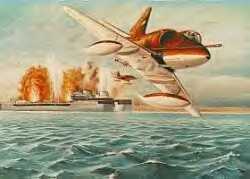
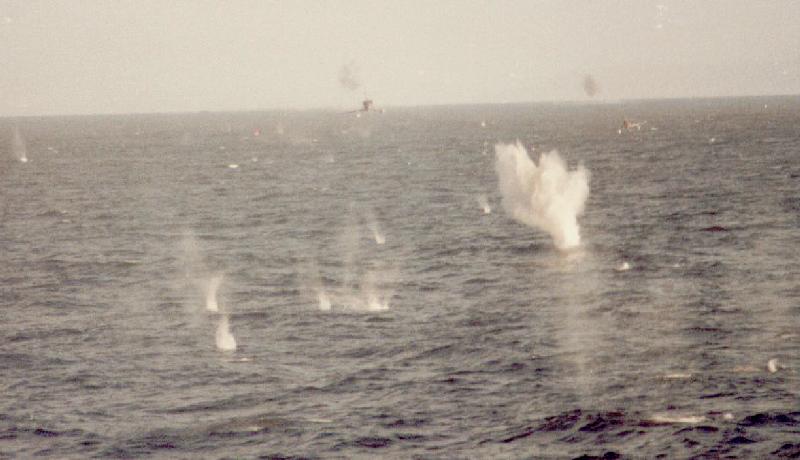
The frigate HMS Plymouth was covering the cargo vessels when the Argentine fighters roared in, strafed it with cannon fire, and hit it with four bombs that failed to explode. The SkyHawks continued their attack and successfully put bombs into both the RFA Sir Galahad and RFA Sir Tristram. Both ships caught fire and were abandoned; 50 men were killed on the RFA Sir Galahad. Later that afternoon four Grupo 4 SkyHawks caught the landing craft LCU F4 transporting British vehicles from Goose Green to Fitzroy. The vessel was attacked and quickly sunk with the loss of six British lives. The Harrier CAP caught the SkyHawks and promptly shot down three with Sidewinders.
The FAS flew aggressively to the end. As the Argentine Army was collapsing in the Port Stanley area, the SkyHawks of Grupo 5 and Canberras from Trelew flew CAS missions in an attempt to assist their embattled army. Those strikes were ineffectual, and a Sea Dart probably downed the Canberra that was lost during the strikes. With little artillery left and no hope for relief, General Menendez surrendered with over 8,000 men at Port Stanley on 14 June 1982. The British had won the war.
The Falklands War provides some important lessons for the conduct of a modern air war. The British learned the importance of having an aerial long-range early warning system to protect the fleet. The successful Exocet attacks alerted all the world's navies to the dangers of antiship missiles. Britain's 20 air-to-air kills by Harriers carrying AIM-9L Sidewinders illustrated the importance of keeping a technological edge over the opponent in missile sophistication. Even a slight edge (and the Sidewinders had more than a slight edge over the Matra 530s) can translate into decisive air superiority.26
For the Argentinians it was less an issue of learning lessons than dealing with the shame of defeat. The senior military leadership was guilty of a string of poor decisions that resulted in the deaths of many brave and dedicated Argentine soldiers, airmen, and sailors-men who deserved far better leaders than they had. General Galtieri and the military junta had blundered into a war without a plan or a strategy. From the start, the junta's strategy of seizing the Falklands was delusional. Immediately after the Argentinian seizure of the Falklands and the British announcement that they would mount a campaign to retake the islands, the Argentine military contacted the US government and requested that the United States provide Argentina with full intelligence support in a conflict with Britain. When the U.S. intelligence officials denied the Argentinian requests and declared that the United States would stand by its British ally, the Argentine leadership was dumbfounded.27 So convinced were they of the nobility of their cause that they simply assumed the United States and the whole world would line up with Argentine national ambitions. The Argentinians felt bitter about the rebuff, as the junta had never seriously considered that the United States would not wholeheartedly support an Argentine dictatorship and abandon its closest ally.
General Galtieri demonstrated a remarkable lack of understanding of modern military operations by insisting that the Falklands would be defended by a large land force, largely composed of half-trained conscripts, with few heavy weapons, cut off from sea supply and completely dependent upon a tenuous airlift capability. He and most of the senior military leaders also seem to have had little concept of the use of modern technology in war. For example, the Argentine Army and air force could have lengthened the airstrip at Port Stanley by 2,000 feet and forward based the SkyHawks and Daggers in the Falklands. On the mainland the Argentinians had the engineers, equipment, and pierced-steel planking that would have allowed them to extend the runway within a week or so of starting work.28 However, to get the engineers, materiel, and equipment to Port Stanley would have required reallocating much of the limited airlift capacity. General Galtieri's strategy to defend the islands with a large number of ground forces committed all the airlift to transporting troops and ruled out any reallocation-and there was simply not enough airlift to do both. In April 1982, in contrast to General Galtieri's decision, professional air force and naval officers in the United States and Europe thought lengthening the runway on the Falklands was the obvious thing to do.
Admiral Lombardo, the theater commander, does not come across much better than General Galtieri as an operational commander and strategist. His decision to base a large air force (24 Pucaras, six Aermacchi 339s, and six T-34s) in the Falklands is difficult for a professional Soldier to comprehend. What did he think that a force of light counterinsurgency planes could do in an aerial environment full of Harriers with Sidewinders, British ships bristling with the latest antiaircraft missiles, and ground forces armed with Rapier and Blowpipe antiaircraft missiles? It was an exceptionally lethal environment for aircraft designed for fairly benign counterinsurgency operations. Many of the operations of the Falkland-based Argentine air units demonstrated a touch of the ethos reflected in Tennyson's Charge of the Light Brigade.
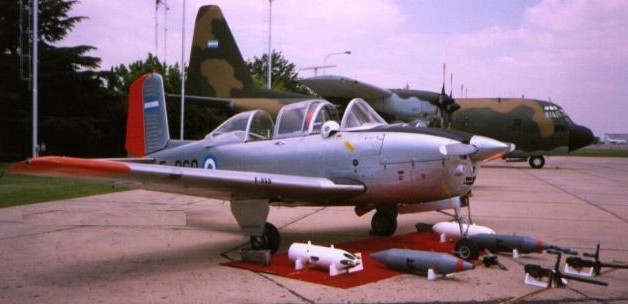
The T-34 Mentors were basic-training aircraft armed with a light machine gun and some rockets suitable for artillery spotting. The Aermacchis were also lightly armed and not suited for anti-shipping strikes.

However, this did not prevent one navy Aermacchi 339 from carrying out a valiant pass with its cannon against the British fleet, slightly damaging one vessel. That was, in fact, the total damage that the Falkland-based 36 fixed-wing aircraft and 19 helicopters inflicted upon the British fleet. The T-34s flew a few reconnaissance missions and managed to survive by hiding in the clouds. The Pucaras fought valiantly-but ineffectually-and most were destroyed or disabled by the end of the war.
Another of Admiral Lombardo's major operational decisions was to sortie the General Belgrano (an ancient 43-year-old cruiser) towards the British fleet with little anti-submarine defense. It was sunk by the British nuclear submarine HMSConqueror and caused the greatest single loss of life in the war. The General Belgrano's sortie accomplished nothing offensively for the Argentinians, and its loss forced a change in strategy that caused them to keep their navy's capital ships in port for the rest of the war.
General Menendez, the commander of the Falkland garrison, demonstrated a poor grasp of the basics of the operational art. He deployed his poorly trained and poorly armed infantry units into an overextended and badly sited defense line. The British easily overran Menendez's positions one by one. Indeed, miserable weather and logistics problems caused the British Army and Royal Marines far more trouble than did the Argentine Army. One has to question how General Galtieri ever thought that half-trained, lightly armed soldiers could hold their own in battle against some of the best infantry in the world-the Gurkas, the Paratroop Regiment, and the Royal Marines. General Galtieri and the junta apparently felt that patriotism and valor could overcome all of their military disadvantages.
Indeed, the only Argentine senior commander who demonstrated real competence and professionalism in the Falklands War was the FAS commander, General Crespo. He had to minimize the effect of Argentina's liabilities: the technological inferiority of the Argentine air force and naval air arm, operations at his attack aircraft's maximum combat range, the lack of adequate air-refueling capability, and the lack of early warning and reconnaissance assets. Considering these limitations, General Crespo did very well with the forces and capabilities he had available. He used the three weeks prior to the beginning of hostilities to organize and train his strike force to conduct a naval air campaign-a mission in which only two of his small naval air units were previously trained. He learned from his mistakes-apparently the only Argentine senior commander who did. After 1 May, he avoided high-altitude ingress beyond the point where British radar could detect his forces and made great use of low-altitude attacks to avoid detection and achieve surprise. His improvised Fenix squadron creatively baited the British with decoys, forced a response, and stretched their CAP coverage to improve the chances of survival and success of his attack force. The professional competence of his headquarters staff was demonstrated by their ability to plan numerous long-range air strikes and coordinate the very limited air-refueling support.
The record of the FAS in the Falklands War is impressive. The pilots of the SkyHawk, Dagger, Mirage, and Etendard squadrons demonstrated remarkable piloting and navigation skills. The low-level attacks were exceptionally difficult and dangerous. One flight of SkyHawks flew so low during their ingress to attack the British fleet that on arrival at their home base they had to make instrument approaches to landing because a coating of salt (deposited by the spray off the ocean's waves) obscured their canopies. Argentine official historians continue to claim that the Argentine airmen inflicted far more damage on the British fleet than the British officially admit. However, the losses the British do document are still impressive considering the FAA's limitations and lack of antishipping training before the war. The destroyers HMS Sheffield and HMS Coventry, the frigates HMS Ardent, HMS Antelope, the support ship Atlantic Conveyor, the landing ship RFA Sir Galahad, and the landing craft LCU F4 were all sunk by Argentine bombs and Exocets. The destroyers HMS Glasgow and HMS Antrim, the frigates HMS Argonaut and HMS Plymouth, and landing ship RFA Sir Tristram all sustained heavy damage, and another six ships received minor damage. In all, the Fuerza Aerea Sur inflicted the heaviest damage and casualties suffered by the British task force. For that, the FAS paid a very heavy price, losing 22 SkyHawks-19 from Grupos 4 and 5 and three more from a naval SkyHawk squadron. Grupo 8 lost two Mirages, and Grupo 6 lost 11 of its 30 Daggers. The 2d Bomber Squadron lost two Canberras. In all, the FAS lost 41 percent of its aircraft to combat and operational accidents. This is an astounding attrition loss-but it never broke the FAS's high morale and fighting spirit.
The FAA Transport Command also performed superbly. During April, the small transport force mobilized everything that could fly and airlifted almost 8,000 troops and 5,037 tons of supplies, weapons, vehicles, and fuel into the Falklands.29 Even after the arrival of the British fleet and its proclamation of a full air blockade of the Falklands, the transports continued to fly into Port Stanley by night, bringing in supplies and airlifting out the wounded. FAA transports continued to slip past the British through the last night of the war. These were very dangerous missions-as evidenced by the loss of one C-130 transport to a Harrier Sidewinder.
The Argentine air force's antiaircraft gunners and radar operators performed their jobs with great bravery and competence throughout the campaign. Argentine ground-based air defenses destroyed seven British aircraft, including four Harriers. [30] The FAA's radar operators at Port Stanley were Argentina's most effective asset for locating and monitoring British ships and planes. They warned Argentine SkyHawk and Dagger pilots of the location of defending British Harriers during their antiship attacks and were credited with preventing the loss of several FAS pilots and their aircraft.
In short, the Argentine air force did surprisingly well in the face of many great disadvantages. Old-fashioned words like courage, gallantry, and honor are the only ones that can be used to describe and explain the combat wartime performance of the Argentine air force and naval air personnel. While the junta and most of the senior Argentine military leadership offer a model of how not to wage war, the Argentine airmen provide a positive and impressive model of competence and courage at the operational and tactical levels of war.
Notes
1. For about 200 years designated the "Falkland Islands" by the British and "Islas Malvinas" by the Argentinians, this group of islands in the south Atlantic is located 300 miles east of the Argentinian coast, has a population of approximately 2,100 people, and occupies about 4,700 square miles.
2. For a general view of the Argentine claims to the Falklands, see Mariano César Bartolomé, El Conflicto Del Atlántico Sur (Buenos Aires: Circulo Militar, 1996); and Carlos Augusto Landaburu, La Guerra de las Malvinas (Buenos Aires: Circulo Militar, 1988).
3. For an excellent overview of the Argentine command arrangements and the problems they caused the Argentinians, see Alejandro Corbacho, "Improvisation on the March: Argentine Command Structure and Its Impact on Land Operations during the Falklands/Malvinas War (1982)" (paper presented at the Society for Military History Conference, Quantico, Va., April 2000).
4. For a general history of Argentine units and aircraft in the war, see the official history: Direccion de Estdios Historicos, Vcom (Lt Col) Ruben Moro, ed., Historia de la Fuerza Aerea Argentina, Tomo VI, vols. 1 and 2 (Buenos Aires: Ejercito Nacional, 1998).
5. Several books provide details about the Argentine air force's organization, equipment, and aircraft. See Roy Braybrook, Battle for the Falklands: Air Forces (London: Osprey Publishing, 1982); and Salvador Mafe Huertas and Jesus Romero Briasco, Argentine Air Forces in the Falklands Conflict (London: Arms and Armour Press, 1987). On the Argentine air force training schools, see Jose Antonio Bautista Castano, "La Escuela de Caza y Bombardeo Argentina," Revista de Aeronautica y Astronautica, November 2000, 916-21.
6. One of the best discussions of the weapons and technology employed in the Falklands War is found in Lon Nordeen, Air Warfare in the Missile Age (Washington, D.C.: Smithsonian Institution Press, 1985), 191-206, 233.
7. Much of this information comes from the USAF Armaments Museum personnel, Eglin AFB, Fla.
8. Victor Flintam, Air Wars and Aircraft (New York: Facts on File, 1990), 372-73.
9. Corbacho.
10. Enrique Mariano Ceballos and Jose Raul Buroni, La Medicina en la Guerra de Malvinas (Buenos Aires: Circulo Militar, 1992), 23. This work is probably the best source for exact figures for all the army, navy, and air force units that were stationed in the Falklands.
11. The best general history of the war from the Argentinian side is Comodoro (Col) Ruben Moro, Historia del Conflicto del Atlantico Sur (Buenos Aires: Escuela Superior de Guerra Aerea, 1985). For British weapons systems, see 157-58.
12. Capt Joseph Udemi, "Modified to Meet the Need: British Aircraft in the Falklands," Airpower Journal 3, no. 1 (Spring 1989): 51-64.
13. The whole issue of combat losses and damage is a very complex one. Both sides exaggerated the damage and losses inflicted upon the other, with the Argentinians having a greater degree of exaggeration. The following narrative of combat actions and losses has been pieced together by the author from both the official Argentine histories and reports. For the Argentinians' version, see Comodoro Ruben Moro's works. For the British version, see the official after-action report, Secretary of State for Defence, The Falklands Campaign: The Lessons (London: Ministry of Defence, December 1982). Both sides have carefully documented their own losses and provided aircraft losses by circumstance, tail number, unit, and pilot. I have taken each side's account of its own losses as the definitive one and have discounted claimed damage for the opponent.
14. The two volumes of La Fuerza Aerea en Malvinas (1998) provide several examples of mission orders complete with maps showing the tanker-refueling plans for the FAS strikes. While short on operational narrative, this official history of the Argentine air force offers a wealth of detail on the tactics of each air strike.
15. For an Argentinian version of the 1 May 1982 battle, see Moro, Historia del Conflicto, 176-97.
16. Udemi, 60.
17. On the Super Etendard, see Christopher Chant, Super Etendard: Super Profile (Somerset, England: Winchmore Publishing, 1983).
18. Ibid., 48-49.
19. Moro, Historia del Conflicto, 229-33.
20. Braybrook, 24.
21. Ibid.
22. Moro, Historia del Conflicto, 229-30.
23. Ceballos and Buroni, 22.
24. On the Argentinian claims, see "The Argentine Gazette," pt. 2, in The Royal Air Force Air Power Review 3, no. 4 (Winter 2000): 87-108.
25. For an Argentinian version of this encounter, see Moro, Historia del Conflicto, 416-27.
26. Secretary of State for Defence, The Falklands Campaign: The Lessons, provides a detailed (302 paragraphs) lessons-learned account of the Falklands War to serve as a basis for future military doctrine and technology developments.
27. Stephen Schwab, retired CIA Latin American analyst, interviewed by author, 24 May 2001.
28. Earl Tilford, "Air Power Lessons," in Military Lessons of the Falklands War: Views from the United States, ed. Bruce Watson and Peter Dunn (Boulder, Colo.: Westview Press, 1984), 37-50.
29. Moro, Historia del Conflicto, 140.
30. Secretary of State for Defence, The Falklands Campaign: The Lessons, Annex C. Additionally, 14 British helicopters were lost when their parent ships were sunk, and 12 more aircraft, including four Harriers, were lost to operational accidents.
Contributor
Dr. James S. Corum (BA, Gonzaga University; MA, Brown University; MLitt, Oxford University; PhD, Queen's University) is professor of comparative military studies at the School of Advanced Airpower Studies, Maxwell AFB, Alabama. A previous contributor to Aerospace Power Journal, he is the author of The Roots of Blitzkrieg: Hans von Seeckt and German Military Reform (University Press of Kansas, 1992), The Luftwaffe: Creating the Operational Air War, 1918-1940 (University Press of Kansas, 1997), and (with Richard Muller) The Luftwaffe's Way of War: German Air Force Doctrine, 1911-1945 (Nautical and Aviation Publishing Co., 1998). Dr. Corum, a lieutenant colonel in the Army Reserve, is a graduate of Army Command and General Staff College and Air War College.
Disclaimer
The conclusions and opinions expressed in this document are those of the author cultivated in the freedom of expression, academic environment of Air University. They do not reflect the official position of the U.S. Government, Department of Defense, the United States Air Force or the Air University.
3. Was the light aircraft carrier, HMS Invincinble hit late in the war?
www.britains-smallwars.com/ Falklands/Exocet.html
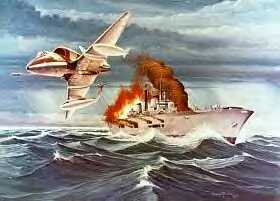
...and covered up by the British?
We think so.
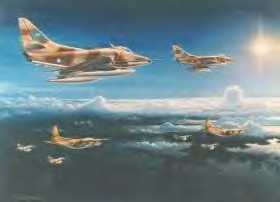
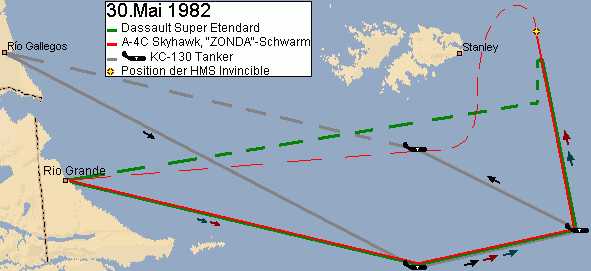
4. Excellent blow-by-blow account of Argentine ship attacks
www.airpower.at/news02/0410_falklands/fleetattack.htm
Much of the new revelations and photos about the Falklands war comes from the excellent researchers at www.airpower.at magazine!
5. E-2C Hawkeye Fact Sheets
www.northropgrumman.com/paris2005/paris2005_fact_sheets.html
See related news release(s):
June 13, 2005-_Northrop Grumman Sees International Opportunities for Hawkeye www.irconnect.com/noc/press/pages/news_releases.mhtml?d=79782
Designed and built by Northrop Grumman Corporation, the all-weather Hawkeye aircraft is an airborne battle management and command and control center. The aircraft has been in active service with the U.S. Navy since 1973. Egypt, France, Japan, Singapore and Taiwan also operate the E-2C. With its distinctive 24-foot-diameter rotating radome and more than 12,000 pounds of sophisticated electronic equipment, the E-2C can monitor six million cubic miles of airspace and more than 150,000 square miles of ocean surface for the presence of aircraft, missiles, ships and fixed targets. For example, an E-2C, analogous in mission to the Air Force E-3 AWACS but highly automated, flying over New York City could track all the traffic in the congested Boston-to-Washington, D.C. air corridor.
The E-2C flight crew comprises two pilots, a radar operator, an air control operator and a combat information center operator. The three system operators work independently in all operational roles: sensor utilization, monitoring and control of the tactical situation, and relay of tactical information to key battle group participants.
Powered by twin Allison turboprop engines, the Hawkeye combines fuel economy with short takeoff capability. Current production aircraft are equipped with T56-A-427 engines, which deliver longer mission duration, greater range and higher altitude capabilities. In its present configuration, the E-2C can cruise on station for more than four hours, 200 miles from its base. An advanced, proven airborne defense system, the Hawkeye eliminates the element of surprise attack, not only from bombers and fighters but also from low-altitude aircraft, missiles and ships.
The From an operating altitude above 25,000 feet, the Hawkeye extends the radar horizon by overcoming the line-of-sight limitations imposed on ground-based and shipboard radar systems by the earth's curvature and mountainous terrain. With its Lockheed Martin AN/APS-145 radar system, the current production Hawkeye 2000 and the previous Group II version automatically detect, identify and track targets at ranges exceeding 300 miles. Hawkeye's passive detection system clandestinely detects and classifies targets at distances beyond radar limits. The E-2C also have provides strike control, drug interdiction and search-and-rescue mission capabilities. The long-range, high-resolution radar, working with IFF and passive detection systems through associated computers, not only develops a picture of the operating environment, but also provides real-time information to air operations and other command centers. The E-2C also controls friendly aircraft for pinpoint interceptions through high-speed data links. The system can maintain more than 2,000 tracks simultaneously. Track data include course, speed, altitude and identification of all radar, IFF and passive targets in the computer files.
Because the E-2C will serve the Navy well into the twenty-first century, continual modifications and upgrades have kept the aircraft ahead of the threat. The production E-2C, known as Hawkeye 2000, improves the Hawkeye's capabilities in detection, processing, identification, communications and navigation. Key among the advances is the mission computer upgrade (MCU) with its advanced control indicator set workstations. MCU is a smaller, lighter, more powerful mission computer that allows even more capabilities such as the Cooperative Engagement Capability (CEC) upgrade. CEC will enable the Hawkeye to serve as the fleet's information hub, fusing and distributing information from sources such as satellite and shipborne radar. The mission computer upgrade test aircraft flew for the first time in early 1997, and was sent to the Patuxent River, Md., Naval Air Test Center for testing. Low-rate initial production of the new mission computer was declared in July 1997.
The first test Hawkeye 2000 successfully completed its first flight in 1998 and operational evaluation by the U.S. Navy in March 2001. Production of the Hawkeye 2000 began in 1999 under a five-year $1.3 billion multiyear (MYP) contract. Northrop Grumman is producing 21 of the next-generation aircraft for the Navy, and three more for international customers. France is the buyer for one of the Hawkeyes, though that aircraft will be in Group II configuration to match the other two French Hawkeyes now in service. Taiwan has received two Hawkeyes under this order. The U.S. Navy took delivery of the first production Hawkeye 2000 in October 2001.
Beyond new production, Japan and Egypt initiated programs to upgrade their fleets to a Hawkeye 2000 export configuration, which does not contain the CEC and satellite communications. Egypt also has procured another U.S. Navy Hawkeye and Northrop Grumman upgraded it to the new configuration. This will give Egypt a fleet of six Hawkeyes.
In December 2001, the U.S. Navy took a significant step when it awarded Northrop Grumman a $49 million pre-System Development and Demonstration contract and, in July 2003, the $1.9 billion SDD contract itself for the next-generation Advanced Hawkeye.
Officially designated the E-2D by the U.S. Navy in 2005, the Advanced Hawkeye is the key airborne node in the Navy's Sea Power 21 network-centric warfare architecture of the future. The E-2D system represents a two-generational leap in radar technology. Under the SDD contract, Northrop Grumman, its radar subcontractor, Lockheed Martin and antenna manufacturer L-3 Communications Randtron Antenna Systems, are developing a completely new radar and electronically scanned array antenna. The system will give the Navy far greater threat detection capabilities over land and water, with greater range and precision than any similar system, current or planned, and will be the foundation for the Navy's theater air missile defense function. Advanced Hawkeye's new communications systems will make it a major node in the Navy's FORCEnet information/decisions grid, enabling it to integrate and deliver key information and surveillance data, fuse decision data and provide forward control and communications capabilities. The E-2D will provide the enhanced airborne command and control and expanded surveillance umbrella that will be a foundation of Sea Power 21.
The Advanced Hawkeye will have a new cockpit. Going beyond the single-purpose "glass" cockpits of modern aircraft, Northrop Grumman engineers are designing displays that will allow either the pilot or co-pilot to participate as a fourth mission system operator. Navy operator input has been obtained to guide these designs using the substantial laboratory simulation and demonstration capabilities available to the E-2 program. Other features of the Advanced Hawkeye include terrain avoidance systems and global air traffic management system enhancements.
The SDD program is also focused on reducing production and total operational support costs. For example, some of the structures on current Hawkeyes are built-up from individual sheet metal parts. These will be replaced by single-piece machined parts to reduce both cost and the time needed to construct the subassemblies and mate fuselages. Two-level maintenance concepts, coupled with automated system test capabilities, are being explored to reduce total ownership costs.
The SDD program will lead to a multibillion-dollar Advanced Hawkeye production program. On April 19, 2001, at Naval Air Station Patuxent River, Md., the U.S. Navy successfully conducted the first flight of an E-2C equipped with state-of-the-art composite eight-bladed propellers. The Hamilton Sundstrand NP2000 is a digitally controlled, all-composite propeller blade system that will replace the electro-mechanical, steel spar propellers that are on all Hawkeyes, both in production and in service, and all Northrop Grumman C-2A Greyhound carrier-on-board delivery aircraft. Easier and less expensive to maintain than the current four-bladed propellers, improves performance throughout the flight envelope and reduces noise.
The Northrop Grumman legacy in airborne early warning and battle management systems is long. The rugged, reliable Hawkeye 2000 is the latest of five generations aircraft built by Northrop Grumman since the mid-1940s. At that time, a TBF-3 Avenger was modified with the first-generation airborne search radar. This was followed in the mid-1950s by the E-1B. In 1964, the Navy took delivery of the first aircraft specifically designed for AEW, the E-2A Hawkeye, 59 of which were delivered through 1967. They flew in Vietnam combat from the USS Kitty Hawk and USS Ranger. E-2A's were modified to E-2B's with a then-new, programmable, high-speed digital computer. The E-2C program began in 1968.The E-2C prototype made its first flight in 1971, and the first 11 operational aircraft were delivered to the Navy two years later. Since then, deliveries have totaled more than 140 for the Navy and more than 30 for allied forces.
www.northropgrumman.com/images/paris2005/paris_hi_res/0036_high.jpg
E-2 Hawkeye
www.northropgrumman.com/images/paris2005/paris_hi_res/0036_high.jpg
This new eight-blade composite propeller has been tested by the U.S. Navy for the E-2 Hawkeye battle management-command and control (shown here) and C-2A Greyhound carrier on-board delivery aircraft fleets. The NP2000 propeller system is an electronically controlled, all-composite propeller system is replacing the current Hamilton Sundstrand 54460-model electro-mechanical, steel spar propeller that currently is used on all Hawkeye and Greyhound aircraft. The NP2000 is being fitted to all new Hawkeyes. It reduces maintenance, improves flight performance and reduces noise.
www.northropgrumman.com/images/paris2005/paris_hi_res/0017_high.jpg
The technologically-advanced Northrop Grumman E-2C Hawkeye battle management/command and control aircraft serves not only the United States but other nations as well. Its highly automated wide-area early warning and tactical control capabilities are being used by Japan (shown here), Egypt, France, Israel, Singapore and Taiwan. Japan is upgrading its fleet to the Hawkeye 2000 configuration and the aircraft shown here was the first one completed.
www.northropgrumman.com/images/paris2005/paris_hi_res/0018_high.jpg
The technologically-advanced Northrop Grumman E-2C Hawkeye battle management/command and control aircraft serves not only the United States but other nations as well. Its highly automated wide-area early warning and tactical control capabilities are being used by Egypt (shown here), France, Israel, Japan, Singapore and Taiwan. For Egypt, Northrop Grumman is upgrading the nation's fleet to the Hawkeye 2000 configuration.
www.northropgrumman.com/images/paris2005/paris_hi_res/0019_high.jpg
E-2C Hawkeye 2000
www.northropgrumman.com/images/paris2005/paris_hi_res/0019_high.jpg
This is the business end of the Northrop Grumman E-2C Hawkeye 2000 Airborne Early Warning and Control aircraft: the operators' consoles. Taking advantage of commercial off-the-shelf technology and common with workstations used on U.S. Navy ships, these workstations are just one of the several significant system upgrades constituting the Hawkeye 2000 system. The Hawkeye 2000, the first of which was delivered to the U.S. Navy in October 2001, boasts many advances beyond the previous, Group II production configuration now serving the US Navy and several foreign nations. The heart of Hawkeye 2000 is the mission computer upgrade and its advanced control indicator set workstations. Hawkeye 2000 also boasts an environmentally-friendly cooling system.
www.northropgrumman.com/images/paris2005/paris_hi_res/0024_high.jpg
Designed and built by Northrop Grumman Corporation, the all-weather Hawkeye aircraft is an airborne battle management and command and control center. The aircraft has been in active service with the U.S. Navy since 1973. Egypt, France, Japan, Singapore and Taiwan also operate the E-2C. With its distinctive 24-foot-diameter rotating radome and more than 12,000 pounds of sophisticated electronic equipment, the E-2C can monitor six million cubic miles of airspace and more than 150,000 square miles of ocean surface for the presence of aircraft, missiles, ships and fixed targets.
www.northropgrumman.com/images/paris2005/paris_hi_res/0025_high.jpg
The Northrop Grumman Hawkeye 2000 Airborne Early Warning and Control aircraft is the latest configuration of the E-2C Hawkeye aircraft and it boasts many advances beyond the previous configuration, the Group II. Among the improvements are a mission computer upgrade, advanced new workstations, and an environmentally friendly cooling system. International customers Taiwan and Egypt chose to buy new export configurations of the Hawkeye 2000 or upgrade the current fleet, respectively. Taiwan has taken delivery of those two E-2Ts; Egypt has had some deliveries. Japan is upgrading its aircraft to the Hawkeye 2000 export configuration. They gain major increases in their airborne early warning capabilities in addition to the benefit of interoperability with the U.S. Navy.
6. Specifications
DIMENSIONS Wingspan 80 ft. 7 in. (24.56 m) Width, wings folded 29 ft. 4 in. (8.94 m) Length overall 57 ft. 8.75 in. (17.60 m) Height overall 18 ft. 3.75 in. (5.58 m) Diameter of rotodome 24 ft. (7.32 m)
GENERAL DATA
Crew Members 5
Power Plant Number 2
Manufacturer Allison
Type T56-A-427 Turboprop
Rating 5100 eshp (each)
PERFORMANCE
Max level speed 338 knots (626 km/hr.) Max cruise speed 325 knots (602 km/hr.) Cruise speed 259 knots (480 km/hr.) Approach speed 103 knots (191 km/hr.) Service ceiling 37,000 ft. (11,278 m) Min. T.O. distance (ground roll) 1,850 ft. (564 m) Min. landing distance (ground roll) 1,440 ft.(439 m) Ferry range 1,541 nm. (2,854 km) WEIGHT Weight empty 40,484 lb.(18,364 kg) Internal fuel 12,400 lb.(5,624 kg) T.O. gross weight 54,426 lb.(24,689 kg)
Contact Information
John Vosilla
(516) 575-5119
(516) 816-5354
john.vosilla@ngc.com
7. Container Ship Conversion to Aircraft Carrier
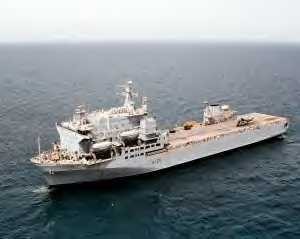
www.hazegray.org/navhist/carriers/uk_helo.htm
Argus aviation support ship
Displacement: 28,480 tons full load
Dimensions: 536.8 x 100.5 x 27 feet/163.6 x 30.6 x 8.2 meters
Extreme Dimensions: 567.6 x 100.5 x 27 feet/172.8 x 30.6 x 8.2 meters
Propulsion: Diesel-electric, 2 Lindholmen-Pielstick 18PC2.5 V400 diesels, 2
electric motors, 2 shafts, 23,400 hp, 19 knots
Crew: 79 civilian, 28 military, 137 training, 750 troops in emergency (994
total)
Armor: none
Armament: 2 single 30mm AA, 2 single 20mm AA
Aircraft: up to 18 V/STOL and helicopters
Concept/Program: A RO/RO & container ship converted to replace Engadine in the helicopter training support role. Also supports Harrier training, and the ship's large size allows her to act as a transport, emergency "spare deck" or auxiliary carrier, and general-purpose auxiliary. A second conversion was considered but cancelled in 1984. This ship had operated as an emergency aircraft transport during the Falklands crisis, prior to being taken over for this role.
Design/Conversion: Large superstructure forward with a long clear deck aft. Small superstructure on the starboard side, aft, simulates destroyer/frigate superstructure for training purposes.
Operational: Operates primarily as a training ship, both for landing training and by carrying ASW helicopters out to deep-sea training areas. In wartime can act as an aircraft ferry and/or an auxiliary carrier and/or as an assualt ship; has also operated as a hospital ship. The ship's transport and "spare deck" roles are no longer significant due to the availability of purpose-built transports (RO/ROs) and Ocean as a "spare deck".
Departure from Service/Disposal: The project that became HMS Ocean was originally meant as a replacement for this ship. Immediate replacement now seems unlikely, since the new ship evolved into an amphibious assault ship. The future of Argus is uncertain, but a replacement will probably be sought in the near future, as this ship is excessively large and expensive to serve purely as a training ship.
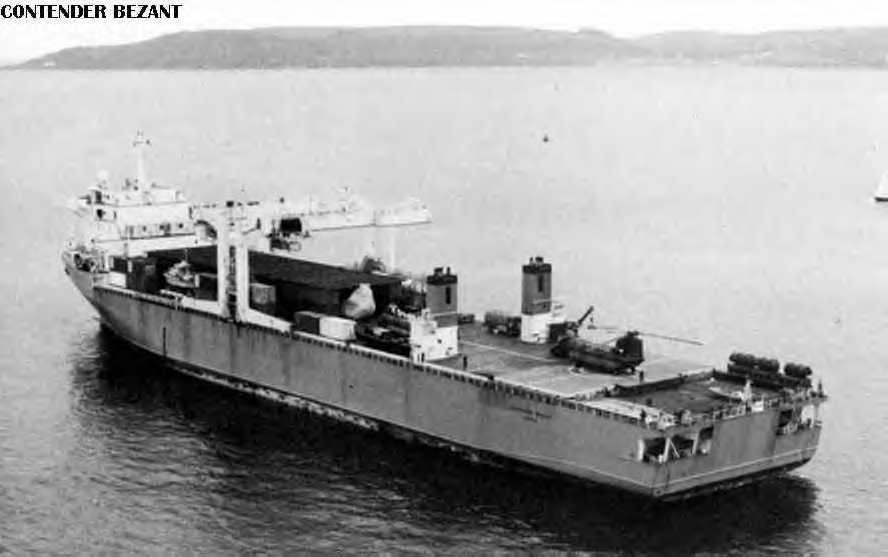
Argus A135
Photos: [Prior to conversion - M/V Contender Bezant], [Argus as completed].
Laid down ????, launched 1981, completed as cargo ship 1981. Chartered for Falklands service 5/82; returned postwar. Purchased by RN 2 March 1984, converted at Harland & Wolff 4/1984 to 3 March 1988. Commissioned 1 June 1988 but immediately went into post-trial refit 17 July 1989 to 3 Oct 1989, fully in service 10/1989.
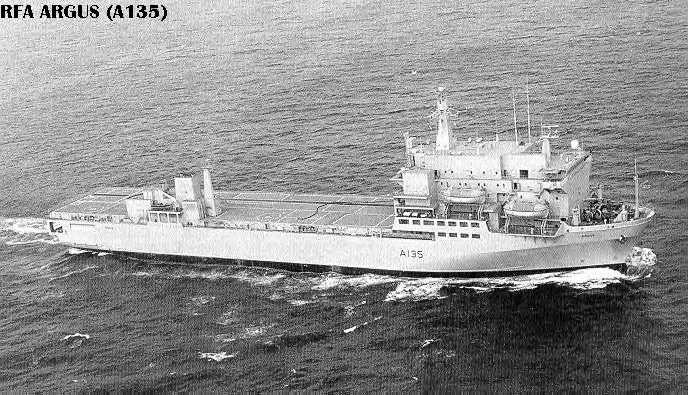
Deployed to Persian Gulf early 1990's as hospital ship and as an aircraft transport.
8. www.globalsecurity.org/military/library/report/1986/WDG.htm
THE FALKLANDS WAR 1982: A RIFLE COMPANY COMMANDER'S PERSPECTIVE
By Major David G. Wheen, Royal Marines
Command and Staff College
Education Center
Marine Corps Development and Education Command
Quantico, Virginia 22134
25 March 1986
TABLE OF CONTENTS
Subject Page
Presentation 1. 1.1 - 1.50
Presentation 2. 2.1 - 2.49
Video Tape Clips V.1
Slides: Presentation 1 S.1
Presentation 2 S.2
Maps: Falkland Islands Map 1
East Falkland Map 2
The Beachhead Map 3
42 Cdo's Battle Map 4
Citation: 42 Cdo RM C.1
THE FIRST PRESENTATION TO USMC COMMAND AND STAFF COLLEGE ON THE FALKLAND WAR (AIR & SEA BATTLES)
BY MAJOR D. G. WHEEN, RM
19 DECEMBER 1985
VIDEO - (2 MINUTES)
Ladies and gentlemen, this is the first of two Presentations on the Falklands war of 1982; and before I go any further let me say for the benefit of our Spanish speakers that the word "Falkland" is as far as I am concerned interchangeable with the word "Malvinas". I intend during this session to skip Quickly through the political, historical and geographic background and so set the scene for the initial Argentinean invasion; thereafter, I shall concentrate on perma. The next session will cover the land battle, primarily 42 cdo's land battle following the breakout of the beachhead.
You may well ask why should you spend your time listening to me when you can, and probably have, read about the war from various British and American books and publications. My response is threefold: first, the alternative for my individual research paper was an in-depth study Of Earl Haig, the British Field Marshall during World War I, even though he was involved in the battle of the Somme, that we heard about on 1 Dec 1985. This was a far less attractive proposition to me personally. Next, the Falklands war is the first major naval, amphibious and naval air war conducted in the Missile age. It involved significant ship and aircraft Losses: this slide eg shows ship losses it does not show the 8 RN ships damaged by bombs/Exocet but not Sunk; and high-intensity operations ashore, afloat, and In the air. It should be studied to draw out any significant lessons that we can learn from it. And Finally, I have been asked many times by fellow students about the Falklands war and my experiences in it. This slide is particularly for Bob Churchill. I was a rifle company commander, in command of coy l, 42 Cdo RM, so my experiences are perhaps of more relevance to a company commander's course such as AWS.
Nevertheless, I feel I now have a better understanding of military operations, and am keen to pass on some recollections and observations for you to accept or reject as you wish. In addition to my own experiences my sources of information include long conversations over three years with CO 42 CDO RM, Lt Col Nick Vaux, For whom I worked both as a coy commander and subsequently when he was promoted to colonel and was my Chief of Staff, he was here as RM advisor 79-81 so you may have met him at AWS; also with the Brigadier commander, 3 CDO Bde RM, Brigadier now Maj Gen Julian Thompson, on whose staff I worked for two years, and also with CLFFI Major General Jeremy Moore, for whom I have thankfully never worked as he is married to my cousin! On the Naval side, I have spoken to Commodore Amphibious Warfare, the CATF, and many other naval officers before during and after the conflict. I have also read a large number of books on the Falklands and would be happy to recommend some, if anyone wishes to follow-up this presentation. I do not intend discussing South Georgia as I was not there. I will of course endeavor to answer questions on this and any other issues at the end of each presentation.
Geography
May I just first crave your indulgence and just remind you of the geography of the Falklands because it later became a very influential factor in the conduct of operations at all times. You will be aware that it is some 8,000 miles from UK but only approximately 350 miles from Argentina, but of equal or more significance to the land force is its relative position to the vast Antarctic land mass. This has a profound affect on the Weather. There is no gulf stream as there is in the North Atlantic to warm up the sea and produce the mild weather in winter that we experience in Britain -- and we were, of course, down there in the southern hemisphere's mid winter. The winds blow nearly all the time and change in intensity very rapidly and without warning -- sometimes changing a notch on the Beaufort scale every minute. The weather obviously does exactly the same as the wind and one can get several periods of snow, rain and bright sunshine, all in one day. Each succeeding the other incredibly rapidly.
The land mass of the Falkland Islands of 4,697 Square miles is about the same size as that of Wales or Connecticut. The country is almost all peat bog with mountains rising up through the bog. Although the Mountains are not high by some standards, they are Extremely rugged (the highest is Mt. Osborne at just over 2,000 feet, Mt. Kent is just over 1,200 feet). The tops are crowned with craggy, tor-like features. All over the islands there are rock-runs. These are like maxi-scree and extend for miles. Some of the Rocks are huge. As we later discovered, it can take Hours to cross a rock-run when heavily laden especially at night. There are no roads except in the immediate Vicinity of Stanley and a few tracks near each settlement. There had therefore been very little British investment in terms of construction over the years; all materials for which would have had to be Imported. You will have noticed that there are no trees in the islands except where they've been Carefully nurtured around the houses. Concealment Particularly of hqs was a major problem, as hq 3 cdo bn RM found out the hard way when subjected to an air attack inteial inlet.
The population as of 1 April 1982 was 1800. All But 40 were of British origin and spoke English. The Remaining 40 were Argentineans concerned with the operation of the airfield and in planning construction of a natural gas storage facility.
History
The Falkland islands were discovered by the English navigator, John Davis, in 1592. Though the Islands were visited by Sir Richard Hawkins in 1594, and others later, they were not named the Falkland Islands until 1690 after the then treasurer of the navy Viscount Falkland. The French who sailed to and from Rio de la plata called them les illes malouines (malooenes) after their home port of St. Malo. The Spaniards on the mainland corrupted this to las islas Malvinas.
In 1764 settlers led by de Bougainville of France landed in east Falkland, while in the 1765 captain John Byron claimed the islands for Great Britain and left a Small party at Saunders island (NW Falkland Islands). In 1766 the French settlers under pressure from Spain withdrew. In 1770 with Spain and Britain on the brink of war, the Spaniards ejected the English! The following year Port Segment was reoccupied by the British, but voluntarily abandoned three years later.
In 1829 (I'm sorry about the misprint in the slide) the new republic of Buenos Aires, claiming to Have inherited the rights of Spain, sent Louis Verne to the islands to develop a colony in its name. Two Years later Vernet seized 3 x us sealing vessels; this Brought down the American corvette USS Lexington which "laid waste the settlement and proclaimed the Islands free of all government". The British, however, had never renounced their claim, and resumed official occupation. The colony was established under a succession of naval officers who were engaged in hydrographic work until 1841 when civil administration was established, this has remained in being ever since. In order to provide as balanced and impartial a perspective as possible let me mention Argentina's point of view. Argentina claimed ownership of the Islands because:
a. It had succeeded Spain in the territories formerly ruled from BA.
b. Spain by purchasing the islands from France
Had acquired the right of prior occupation.
c. Argentina then claimed that Britain had abandoned. Its claim in a secret, unwritten clause of a 1771 declaration.
d. Because Britain had abandoned its settlement in east Falkland in 1774.
Not much changed until September '67 when, following un intervention two years earlier, talks on sovereignty of the Falkland Islands commenced. All foundered eventually, principally because the islanders are British, speak English and wished to remain British. In early '81 the British government keen to reduce out-of-NATO area defense expenditure announced the phasing out of HMS Endurance, our only RN ship permanently on station in the South Atlantic, meanwhile the military regime now under General Galtieri in Argentina was suffering rampant inflation and national unrest, and finally in march 82 there was a group of Argentinian scrap metal workers unlawfully operating ashore in S. Georgia. These three apparently unrelated events triggered the Argentinian invasion of the Falkland Islands and South Georgia on 12 April 1982.
On 13 April the UN security council condemned the Argentinian invasion and demanded the withdrawal of army troops.
Defense
The defense of the Falkland Islands was vested in:
a. Naval presence of HMS Endurance (at the time of the invasion nearing S. Georgia supposedly to deal with the scrap metal workers.)
b. FI defense force - a homeguard of 120 men dispersed around island - only 23 men reported for duty.
c. Np 8901 - a 40-man detachment of RM commanded by captain RM given acting rank of major.
This force, under command of Major Gary Noott, RM Had just been relieved in place by its successor, under Major Mike Norman. To get to FI this group had to fly to Montevideo and be transported by sea to FI. For obvious sound, practical reasons, this force traditionally has to travel unarmed, in civilian clothing and with only minimal military personal equipment. Thus on the island were for example, 40 Rifles, radios for 40 men, etc. and minimal defense stores. This detachment had prevented surreptitious Argentinean occupation on a couple of occasions but it is scarcely a deterrent force. It was at best a trip-wire force and in the event of a determined invasion, reinforcements were clearly essential.
Consideration had been given to reinforcing this detachment in late march 82 but the stumbling blocks remained, how do you position it? It may have been possible to organize a single C-130 to fly the 8,000 miles return trip from Ascension Island with in-flight refueling, and land or parachute troops into the Falklands - but the effect of 1 x C-130 load, even if It could have arrived in time, would have been minimal! Mike Norman and Gary Noott therefore had to plan for their defense without reinforcement. In Essence, the keypoint was government house, key terrain- the airport, Sapper Hill, thee apologize for the scruffy map, it had been in my map pouch for 20 days! The military barracks at Moody Brook were abandoned which is just as well because it was subjected to an overwhelming assault 12 hours later the deployment was as follows:
2 men = york beach/christmas bay/sapper hill/
8 men (section) harbour town/overlooking road/n of harbour
The main defensive position was at government House, to which the 2 sections in port Stanley area were to withdraw. The 2 men ops were to make their way back to the town as well as possible. The Section n of the water was to go into camp (the Countryside) and organize resistance.
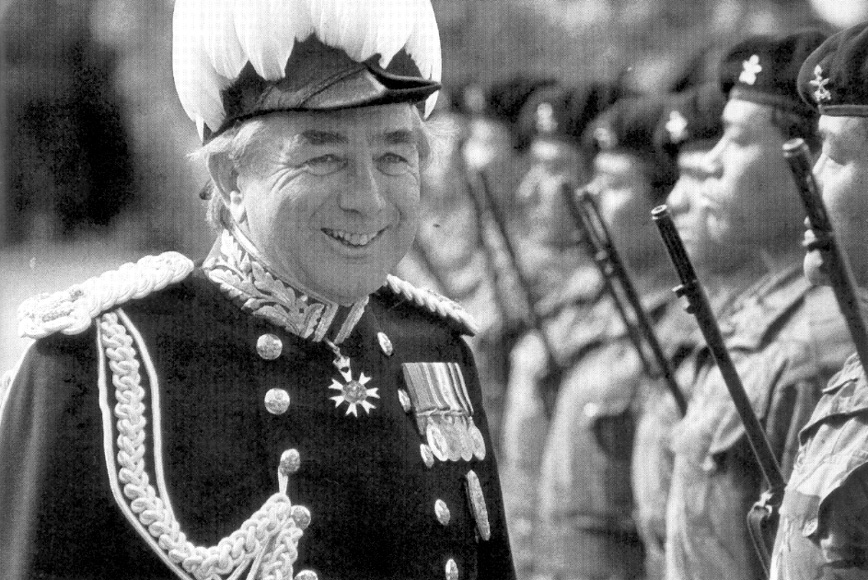
Mr. Rex Hurt (governor) however ordered the surrender before Significant British casualties were received, once it Was obvious that the defense was outnumbered 20:1. It is thought that some 20 Argentineans were killed in the invasion. At s. Georgia, it was a similar story, where Lt Keith Mills' detachment displayed great gallantry, inflicting serious casualties. S. Georgia was later Reoccupied by m. Coy, one of the other 2 rifle coys of My unit, 42 cdo on 26 Apr 82. M coy was specially selected for this unique mission solely because the coy Commander Capt. Chris Nunn was she first coy commander To walk pass the co office and be seen by the co that crucial morning. Peter Babbington, the other coy commander and I were green with envy, and wished we'd arrived at Work earlier than normal. Events in the Falklands Subsequently endorsed Peter's and my more laid back approach. Mike Norman having been returned to UK as a POW on 5 April 1985 and been debriefed, joined Canberra In ascension -- and formed composite company (j) as 42 Cdo 3rd rifle company (to replace Mcoy). While Mike Norman and his detachment were originally on route to Fi, 42 cdo were undertaking arctic training in Norway.
On 27 December 1981, I flew off with the Remainder of the cdo advance party to prepare for the arrival and subsequent training of 42 Cdo RM in north Norway. For the same reasons of Economy that had forced the announcement of the phasing Out of the south Atlantic ice patrol ship HMS Endurance, the 1982 annual royal marine arctic Deployment was reduced from brigade level to commando (battalion) level. I have been asked to describe this Training during the FMF in the offense exercise; Suffice to say that we spent three months intensive Training such that at the end of the period I knew the personality, shortcomings and capabilities of every voice on the radio, and of course every man in my company. In addition to 6 weeks of intensive company training, we had conducted two major exercises at cdo Level or above -- and the unit had a well practiced battle procedure; probably significantly better than the other units which had been trg in U.K. for the previous 3 months, and subjected to the usual barracks routines of "dog and pony" shows etc.
We returned from Norway in the ill-fated LSL Sir Galahad on 23 march 1982, and proceeded on two weeks leave, 3 or 4 days later; the unit dispersing on the usual 7 day notice. We were of course aware of the Argentinean scrap metal workers' illegal occupation of South Georgia, but clearly did not know what was to happen on 1 April 1982.
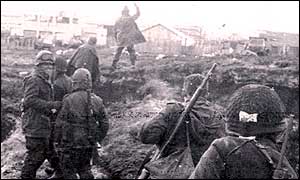
I had a telephone call at my home in Somerset at 0400 hours on 2 April 1982 recalling me to Bickleigh, Plymouth, 42 cdo UK base. This phone call was a mere 25 minutes after the brigade commander had been called -- and the remainder of the unit was recalled during the course of the morning. 42 cdo RM was ill-prepared for a fast move as our heavy equipment was still on the high seas returning from Norway. Although we had the leave address/phone no of all ranks of the cdo, we were Scattered far and wide. Our s2 was in Camp Lejeune Marrying the daughter of the dentist the JW attache From the British embassy, who was a guest at the Wedding actually handed the unfortunate bridegroom a Note while he was walking up the aisle of the church, telling him to catch a flight back to the UK at 0700 the following day; the s3 was in Tunisia, the xo and oc HQ co were on a long civilian ski tour in Norway. Nevertheless within 72 hours we were ready to go. The whole country had mobilized, in a wonderful display of solidarity, to prepare the 100 ships comprising 2x Carrier battle groups and amphibious task force for deployment and operations in the Falklands. Trucks had been entering our base around the clock; I was on duty one evening when the orderly officer of the day reported on the telephone that our commando's ammunition had arrived. I suggested he get a working party and unload it, he seemed not to understand, so I asked him what the problem was. He then explained that we had 26 x 16-ton trucks full of it!
video - (4 minutes)
Concurrently with our preparations, the RN and department of trade were assembling ships for the ATF. An early decision had been made to requisition Shipping Taken Up from Trade (STUFT), including SS Canberra, Flagship of P&O, then in the Mediterranean on Completion of a world cruise. Liaison officers from the units to be embarked flew to Gibraltar, along with the RN ship constructor officers, and had a working holiday on the three-day return passage to Southampton. Within two days of the return, dockyard workers had erected two new helicopter-landing spots, one over the best of the three swimming pools, the other on top of the wardroom bar and the embarkation of 2,500 tps was complete. That same day we sailed to rv With the remainder of the ATF at Ascension Island. Living and training conditions on board were outstanding; a luxury liner is definitely the way to go to war.
video - (2 minutes)
Embarked, on the ship were three battalion sized Units, later to be reinforced by a further rifle copy, Band of HQ cdo forces RM, elements of the bde medical squadron, and hospital surgical support teams, a Sea King helicopter and other miscellaneous sub units; on board was also the specially appointed deputy Brigade commander colonel Tom Seccombe who was the Embarked force commander. The accommodation was luxurious in the extreme. I lived in a cabin with a Double bed (sadly by myself) complete with bathroom and two big picture windows. The cost of this accommodation in 1982 prices for the world cruise was $170 per day. We also had extremely good food, though we reduced from a five course to a three-course dinner each night due to the difficulties of resupply. The enlisted men lived in similar comfort in two beds and at the most four bed cabins. The training facilities were also far better than any RN ship that I have been in. we used the promenade deck, a continuous 4oom loop around the ship, from 0700-2300 daily for fitness training. This built up to 9-mile speed marches with equipment in 90 minutes and 20 mile load carriage marches in boots of course! We also had access to landing spots, games decks, two swimming pools and other areas not normally found in grey line ships.
video - 1 minute
We also concentrated on medical training. Every man was to be issued with morphine and every other man with a drip bag. Each man learned the treatment for trauma, wounds, and burns; and having spent the winter In Norway was well aware of the treatment for all cold Weather injuries. We also practiced treating everyday injuries as well as battle wounds and learned how to do sutures. The galley was somewhat confused by the request for so many raw pork chops until they got these back, covered in stitches. Our dinner that night was predictably not suitable for Muslims or those with delicate stomachs.
The other military skill I would highlight as receiving particular attention was that of calling for and controlling naval, artillery, tank and mortar fire support. Every man in my coy was capable by the time we landed, of calling for and adjusting fire sp, and had practiced this n what we call a "puff range"; in this case a detailed cloth model of the approaches to Port Stanley built in the empty swimming pool under the landing spot. I got a great kick prior to the actual battle personally calling for, and adjusting, a two-battery fire mission.
We also had intelligence and orientation briefs from previous cos of np8901, including Maj. Mike Norman and Maj. Ewen Southby Tailyour whom I shall mention later. We also concentrated on weapon handling and shooting, radio procedure and reaction training. We spent a lot of time assessing what equipment we must take ashore and how this should be transported, packed or carried. We ended up with a landing load of approximately 120-145 lbs. Per man. This was broken down as follows: two mortar bombs at 26 lbs, personal Wpn and ammo 50 lbs., 2 water bottles, food for 48 Hours, sleeping bag, shelter, spare clothing; radio and batteries, and other specialist equipment required by that individual, his section or troop (squad or platoon). We also rehearsed the assault routines and had to sort out and practice by day and night how to embark in Lcvp/lcu from a 56,000 ton luxury liner! This slide shows loading doors open and 2 helos on the spots.
Our responsibilities for the running of the ship were minimal. Each coy was duty for 1 x 24 hour periodevery 15 days. More importantly, we had to darken ship principally for anti-submarine detection -- a difficult problem for a luxury liner which more usually is lit like a Christmas tree, and prepare an air defense capability. This we did by deploying 50 machine guns around the upper decks and 12 Blowpipe [MANPADS SAMs] missiles on the superstructure.
We knew our initial destination was to be Ascension island where we would have to rv with the ATF ships and restore.
tape - 4 minutes
Ascension Island, like Diego Garcia, is a British Island with certain facilities leased to u.s. on Ascension this is primarily Wideawake airfield. It was to here that considerable logistic sp from USA was sent to help; principally Sidewinder missiles and comms equipment. But the timescale for the landing in the Falklands was dependent upon the frantic political and diplomatic negotiations involving Al Haig, Peres de Cuellar (UN Sec General) and the president of Peru. Despite what the tape said, few of us honestly believed that we could resolve our differences by negotiation --even though Argentina and Britain have been closely allied for years. The future of Galtieri and his regime depended upon retention of the Malvinas for Argentina and Margaret Thatcher's political career was at stake too!
The motivation for training was therefore unbelievable. We had with us for example approximately 15 chaplains and 10-12 media men. Though traditionally these people do not carry weapons, they undertook the full range of weapon training, medical training, etc. Having mentioned the media, let me digress a little. We had with us newspaper, radio and television men; they are traditionally left wing and suspicious of the military. One or two had been war correspondents in Vietnam, Afghanistan or Lebanon while most had reported at one stage or another upon northern Ireland. In Ireland the media appear after an incident has occurred in which either the military may have suffered casualties (and therefore "failed") or inflicted casualties perhaps "unacceptably"! In no incidents such as these could the media be forewarned of the military plans or intentions for security reasons, nor had they been aware of the degree of training, planning, preparation and rehearsals necessary for even the most mundane operation. Whilst on board Canberra, they became friends with troops of all ranks and became actively involved with our training; after all, their lives were for once at stake!
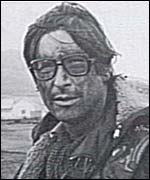
This is Max Hastings, taking things a little seriously for once! We, the military in general and the RM in particular, now have some firm friends in the media. Hopefully some will become editors of national newspapers or TV programs in the years to come where they would he very powerful allies to have.
Now back to perma. As we are taught, planning is of a continuous and developing nature. However, due to the immense political pressure to sail, the initial Pre-embarkation planning did not extend to planning a concept of operations ashore. Planning was limited to balancing the available (RN & STUFT) assets with the Brigade commander's assessment of what forces he wished to have ashore. The order of battle eventually deployed was as follows: (brigade) (attached)
Many desirable assets were omitted due solely to lack of space. The most significant of these were perhaps rpvs & 155 guns. Rpvs because we had no Available assets for aerial reconnaissance and photography, and these would have given us the required real-time information. The 155 guns would have been useful as they would have enabled us to engage the airfield prior to the battles for Port Stanley; and also they deliver a much greater punch than the 105's that we presently have. As it happened, the logistic tail to sp these guns would have been unattainable; but more about that in pt II the land battle. As you can imagine, the landing force was effectively a "come as you are, if you can party".
Once we had embarked, the planning for the amphibious assault and subsequent operations ashore was continuous. The task force commander, was Cincfleet, Admiral Sir John Fieldhouse, based in Northwood London; his military advisor was initially Major General Jeremy Moore from HQ cdo forces RM.
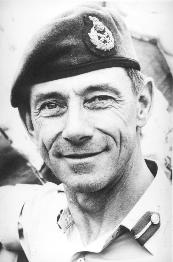
Until he became clff1, on deployment of a second Brigade on d + 12. The commander of the carrier groups was Rear Admiral Woodward aboard HMS Hermes, while the Commodore amphibious warfare, commodore Clapp, who was CATF, and Brigadier Thompson, initially the CLF were embarked in H.M.S. Fearless.
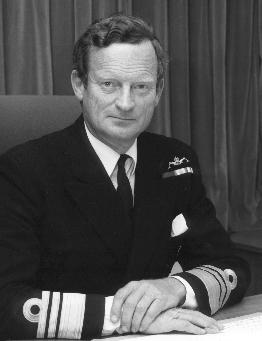
These flag officers and their staffs were the key planners. Though good maps of the Falkland islands existed, these were accurate only down to the high water mark. Neither official charts nor contingency plans existed for a military operation to recover the Falklands following a hostile invasion. Fortunately, a former co of np 8901, Major Ewen Southby Tailyour was a very keen, single-handed Yachtsman as well as a distinguished artist. He had spent his year in the Falklands doing detailed beach and coastal surveys throughout the islands. In December 1981, he had sent a copy of his manuscript to various publishing, houses. Sadly, as there are no Yachts or inshore fishing boats in the area, there appeared to be no market for a Falkland Islands coastal navigation book, these manuscripts had therefore been returned with regrets! 14 weeks later, the mod impounded these manuscripts and classified them "Top Secret". These, supported by Ewen's expertise, became the fundamental planning documents. I am pleased to say that the book is now unclassified and has been published. Many would argue that a war is a little excessive as a publicity stunt!
Many factors affected the landing forces recommendations on the location of the FBH. An assumption initially was that we would have air superiority; and What a false and costly assumption this was -- a political decision was made that the operation could not be delayed and so we never had air superiority, and the fleet suffered enormously because of it. Nevertheless the major factors to be considered were:
* Protection for the amphibious fleet both in terms of air defense, and from the south Atlantic storms and
* Enemy dispositions -- an opposed amphibious
Assault close to Port Stanley was thankfully swiftly rejected due to lack of resources and casualty estimates.
Three alternatives were finally considered on 17 April at Ascension Island at a meeting chaired by Admiral Sir John Fieldhouse. These were:
a. Occupy west Falkland for the purpose of building an airstrip to take C-130 and F-4 Phantom ac.
This was Admiral Woodward's preference.
b. Land in lafonia, a flat area south of Goose Green and then press north. This was a staff
Alternative with minimal advantages, that was rejected very quickly.
c. Assault at San Carlos.
The San Carlos landing site offered the amphibious force many advantages. San Carlos water would provide a sheltered anchorage in which the ships and landing craft could easily unload the landing force and its equipment. By closing off the relatively narrow Falkland sound to the north and south of San Carlos water, the navy could defend the amphibious ships against any enemy surface or sub-surface attacks. Since the site was 50 miles over very rough terrain from the enemy's main force at Port Stanley, the Argentines could probably only attack the British Beachhead by air or with a relatively small Helicopterborne force. Finally, the high ground that surrounded San Carlos water would prevent Argentine aircraft from using their feared, sea-skimming Exocet missiles to attack the ships unloading in San Carlos water.
The San Carlos site also posed a couple of disadvantages. The surrounding hills that would help defend against the Exocets would also restrict the radar acquisition of low-flying aircraft until they emerged over the high ground. Also, the narrow width of Falkland sound would give the ATF ships little room in which to maneuver away from enemy air attacks. Admiral Fieldhouse indicated that, subject to enemy disposition, he preferred the San Carlos option as he wanted to seize East Falklands vital objectives including Port Stanley as quickly as possible.
Advance force operations commenced on 27 April and continued for the succeeding 3 1/2 weeks until D-Day, finally selected for 21 May 1982. They deployed as follows: I would highlight Stanley, Goose Green, lax May, Port Howen & Pebble Island. The aims of these advance force operations were initially beach reconnaissance and identification of enemy dispositions. These were eventually identified as shown. The enemy had a significant radio direction finding capability, were well aware of the presence of SF ops ashore, and tried hard to locate them. At that time we had no burst transmission facility, and the Beach survey report for San Carlos for example took 2 1/2 hours to send, in morse. Fortunately the Argentinean helicopterborne reaction force failed to find them, so well were they camouflaged. Although on one occasion it landed within 50 meters of an o.p. position.
The offensive aims of advance force operations ashore were to harass the enemy and, fundamental to a landing at San Carlos, destroy the Argentinean airbase at Pebble Island. A raid on Pebble Island was carried out by 48 members of SAS supported by naval gunfire spot teams, HMS Invincible and a guided missile destroyer with a single 5-inch gun. The raid was planned and executed within 5 days. Such a time scale is not recommended but the operation was a complete Success. Eleven enemy aircraft principally the counterinsurgency Pucara, and a radar station were completely destroyed, and we suffered no casualties. The tragic death of 20 of these men a few days later in a helicopter accident was a grievous and poignant loss.
Other advance force operations included checking Falklands sound for mines, and domination of the sea area.
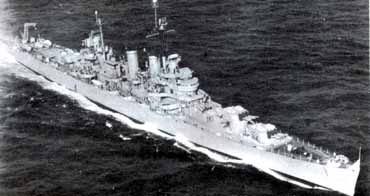
The former was achieved by sending a frigate through the sound, the latter was achieved in the tailing and subsequent sinking of the cruiser General Belgrano (previously the USS Pittsburgh. A WWII heavy cruiser) by submarine after which the Argentinean navy never again left territorial waters. The naval air Battle continued throughout the war starting with the sinking of HMS Sheffield by Exocet.
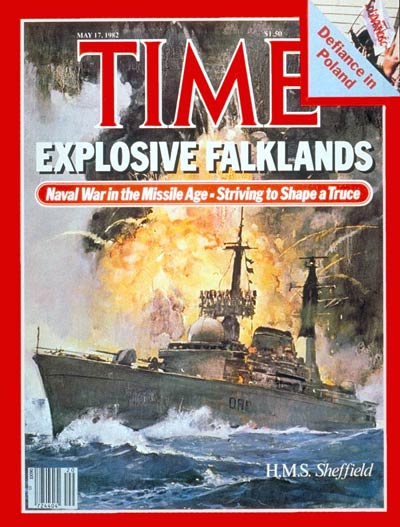
This was two days after General Belgrano was torpedoed, and those optimists who had remained hopeful of a peaceful settlement were finally reconciled to the need for combat ashore. The other ship sunk by Exocet was the Atlantic Conveyor, shown here. The naval air war was effectively concluded only 2 days before the surrender, with the land launched Exocet strike on HMS Glamorgan on 12 June. I saw this attack during the battle for Mount Harriet, but more about that in session 2, the land battle! In all we lost 6 ships and had 8 damaged; Argentina lost 4 aging or small ships. All are aware of the success of the Harrier. Many correctly argue, however, that the Argentine AF was operating at the limit of its range -- and therefore their a/c were unable to be detracted from their bombing mission in maneuver and counteroffensive operations, the counter is also true that we had no AWAC capability though we did actually Request it from USA, and the Harriers were therefore fighting blind. Furthermore, the Harriers were also operating at the limit of their range since the carrier battle groups were stationed well east of the islands to avoid Exocet. Nevertheless, Harriers were all we had and they performed superbly.
Naval ships also conducted nightly shelling over Argentine positions around Port Stanley, Goose Green, Mare Harbour, Fox Bay, Port Howard and Port Louis. You will notice that San Carlos was not included. Together with the Pebble Island raid, the mission by the RAF, with carrier-based Harrier assistance, to bomb Port Stanley airfield was the most stimulating to the general public. The war cabinet had incidentally rejected the idea of bombing air bases in mainland Argentina as being escalatory. 2 Vulcan bombers, the vanguard of Britain's nuclear deterrent in the 1950s and due for scrapping once Tornado was introduced, and 23 Victor k2 tankers were earmarked, trained and deployed to Ascension Island. Due to a faulty window which prevented the necessary pressurization, one Vulcan had to turn back, the other continued and dropped 21 x 1000 bombs. The logistic support behind this mission was enormous. The Vulcan bomber on route To the target had to have 7 in flight refuels, and the refuelers themselves had to be refueled. [Consider if they had long-range seaplanes instead] The overall range Ascension to Falkland return, in excess of 8000 miles, equates to a mission from Moscow to New York and back or England to Pakistan and return. The day before this mission, my company had been training ashore in Ascension Island on a 15-mile load carry and shooting exercise. Just as we were about to return to the Canberra, I was ordered to provide two of my 3 Rifle Troops to guard the airfield, and retain the security of the operation. It was a dramatic and noisy experience, and exhilarating to realize we were at last striking back. The BBC world service reported that the attack was a success, and pundits in U.K. declared that the airfield must have been damaged beyond use. It was a cruel shock a few weeks later to find that the airfield had never been blocked and I saw a/c movements up to the day before the surrender from 15 km away! Reporting this RAF/RN attack, Brian Hanrahan, a BBC TV Reporter aboard HMS Hermes, made the classic report which gave nothing away. He said, "I cannot tell you how many a/c were involved but I counted them all out, and I counted them all back in." There was great elation that this attack was apparently successful against a well defended airfield without loss. The sharp eyed amongst you will have noticed that these 2 individuals are Paras. That's because the cartoonists were all RM.
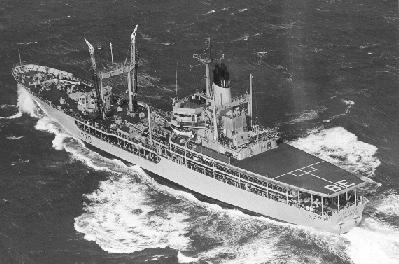
We spent about 3 weeks off Ascension Island, while diplomatic negotiations continued and the navy endeavored to enforce the maritime exclusion zone (by submarine) and the subsequent total exclusion zone (by (aircraft/surface) but regrettably could get ashore only 3 times. This was there was only 1 small beach, and all landing craft and many helos were involved by day in restoring the ships in a tactical manner. The speed with which the ATF and particularly grey funnel transport ships deployed from UK within 2-3 days had precluded combat loading -- planning had at that stage not proceeded beyond the composition of the force and a possible scenario for landing. By night we sailed Around the island, fearful of the Argentinean tanker spying on us might be equipped with the Italian cosmos Sdv that they the Argentineans had recently purchased.
We shall now break for 10 minutes while the ATF lingers in the sun at Ascension Island.
video 2 mins (silent)
By the time we left Ascension Island on 7 May 82, the concept of ops ashore had been prepared, though the 47 page brigade op order was not issued until 12 May, with "o" gp on 13 may. Having said that, I received a Warning Order while still in Ascension, that my coy was to prepare for amphibious raids on the West Falklands using 1 x frigate, 2 helos and small boats. The full briefing process had been completed down to marine level by 18 May 82, while the ATF sailed south into heavier seas, stronger winds and colder weather. The tempo of training slackened a little as final preparations were made, more blood was taken, letters were written home and the equipment scales laid down, trialled and tested over the previous weeks was checked, reviewed and packed.
On 19 may, the 1500 men of 40 cdo and 3 Para, our fellow passengers on Canberra cross-decked. It had been envisioned that this would have to be by jackstay transfer, one-man-at-a-time a horrific way of preparing to go to war, but fortunately a break in the weather enabled landing craft to be used. The amphibious task force rv'd with the light carrier battle groups during the night of 19/20 May. We awakened to find ourselves in SS Canberra in the center of the largest operational amphibious fleet that had assembled since World War II. It was a truly memorable experience, but one tinged with great apprehension. Approaching from the east we spent the day within the TEZ and were within the range of the Super Etendard aircraft armed with Exocet from lunchtime onwards. Fortunately the day was ideal with a very low cloud base and intermittent rain, and still we plowed on towards the Falklands. During the night of 20-21 may, we headed towards Port Stanley, and naval gunfire softened up targets in that area in a demonstration deception. Having been influenced by USMC, the Argentineans anticipated an opposed landing in the Port Stanley area, and the demonstration was so successful that even after D-Day they thought San Carlos was a diversion! Concurrently, the SAS undertook a most overt feint in a standoff attack on Goose Green with additional naval gunfire support (ngs). As the amphibious transport ships, naval gunfire and air defense ships headed towards Falkland sound, sbs with ngs attack the 1/2 coy position on fanning head, identified during advance force operations, to divert the enemy's attention. With SBS went a RM officer born and bred in Costa Rica who was a fluent Spanish speaker. He was armed with a loud speaker and his job was to persuade them to surrender, but sadly his voice could not be clearly heard. After a somewhat frustrating 7 hour action, 9 Argentineans were captured, the remainder filtered into the darkness just before dawn. However the overall mission was a success in that the action clearly diverted the attention of the Argentineans from interfering with the main landing. Left to their own devices, they could have used their 105mm recoilless anti-tank gun with devastating effect against the unarmoured LCUs [WW2 Higgins boats] packed with troops, as they passed south of fanning head on their way into San Carlos water.
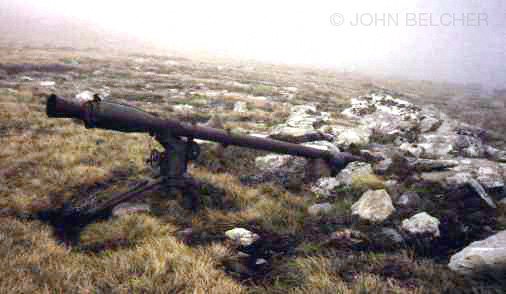
The brigade mission was to conduct a silent night landing by landing craft, so that by first light the Brigade would have secured the high ground overlooking Port San Carlos, San Carlos settlement and Ajax bay. As quickly as possible after 1st light, one light gun Battery would be flown in, followed by the Rapier btry and then the remaining guns. The design being that as soon as possible the bde should be in a good reverse slope defensive position ready to fight Argentinean air or ground attacks, or any combination of these 2. The plan called for 40 cdo to land at San Carlos settlement and 45 cdo at Ajax Bay first and then 2 and 3 Paras to cover s & n respectively. When the SAS feint attack located what was considered likely to be the enemy strategic reserve at Darwin Goose Green, the need to get to Sussex mountain quickly was obvious. The plan was therefore changed at the last moment to land 40 cdo on blue beach one and 2 Para at blue beach two first, then 45 cdo on red beach and 3 Para on green beach one. 42 cdo(-) was to remain on Canberra in reserve until ordered. My coy was still earmarked for raids in West Falklands, a role which promised to be both stimulating and exciting.
The time for h-hour was selected following a balancing act between RN who did not wish to be in hostile aircraft range by day, and Julian Thompson who required the maximum time to deploy troops by night. Eventually it was set for 2:30 am local time.40 cdo was allocated 2 Scorpion and 2 Scimitar Light Tanks under command and these landed side by side in the first 2 x LCUs. The intention being to fire the main armament if necessary while approaching the beach. 40 cdo had 4 x LCUs and 4 x LCVPs while 2 para had just 4 x LCUs.
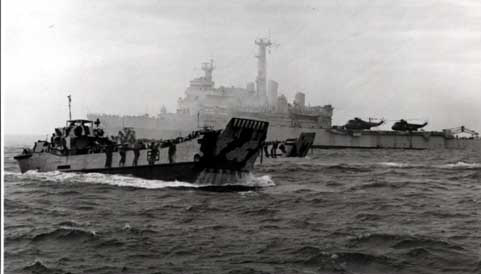
Though there was nearly an hour's delay in h-hour the landing was a clear success and all personnel got ashore without casualties. The delay in h-hour was Caused primarily because of the difficulty that heavily laden men experienced in moving through the narrow passageways and exit in civilian ships. Particularly by one man from 2 para who fell and was injured getting off Norland onto an LCU.
video - (1 min)
As implied by the tape, frantic efforts were made to build up the air defenses ashore while we waited tensely for the first aircraft attack which we knew must come soon. At 8 a.m. a Sea King helicopter with the Rapier missile air defense battery reconnaissance party was fired at, east of Port San Carlos, its 2 Escorting light Gazelle helos were hit by small arms fire. These aircraft were armed with SNEB rockets and GPMGs, and acted as gunships. One Gazelle managed to get back to an LSL; Sgt Evans the pilot of the other was hit. By a brilliant piece of flying and, although dying of his wounds, he managed to put his aircraft gently in the water. His aircrewman Sgt Candlish tended him and swam, dragging him while under machine gunfire, the 500 M to Port San Carlos. As Candlish was pulling his mortally wounded pilot and friend from the water he saw another Gazelle disintegrated in the air, having been hit by the same group. The crew of two were killed instantly. These three aircrew were the only men of 3 Cdo bde RM KIA on D-Day. But out in Falkland sound and in San Carlos water, where most of the ATF ships were, many more gallant sailors were to die under Argentine air attack.
On Canberra we had assembled in our coy assault station from h-hour, though most of us were awake all night, waiting and watching. Watching the attack on Fanning head and the preparations for the assault, watching the ships easing into San Carlos water and disgorging landing craft. Waiting for the Argentina reaction. Every minute that passed gave us time to improve our air defenses; would the delay enable us to get these ashore and fully effective before the first attack.
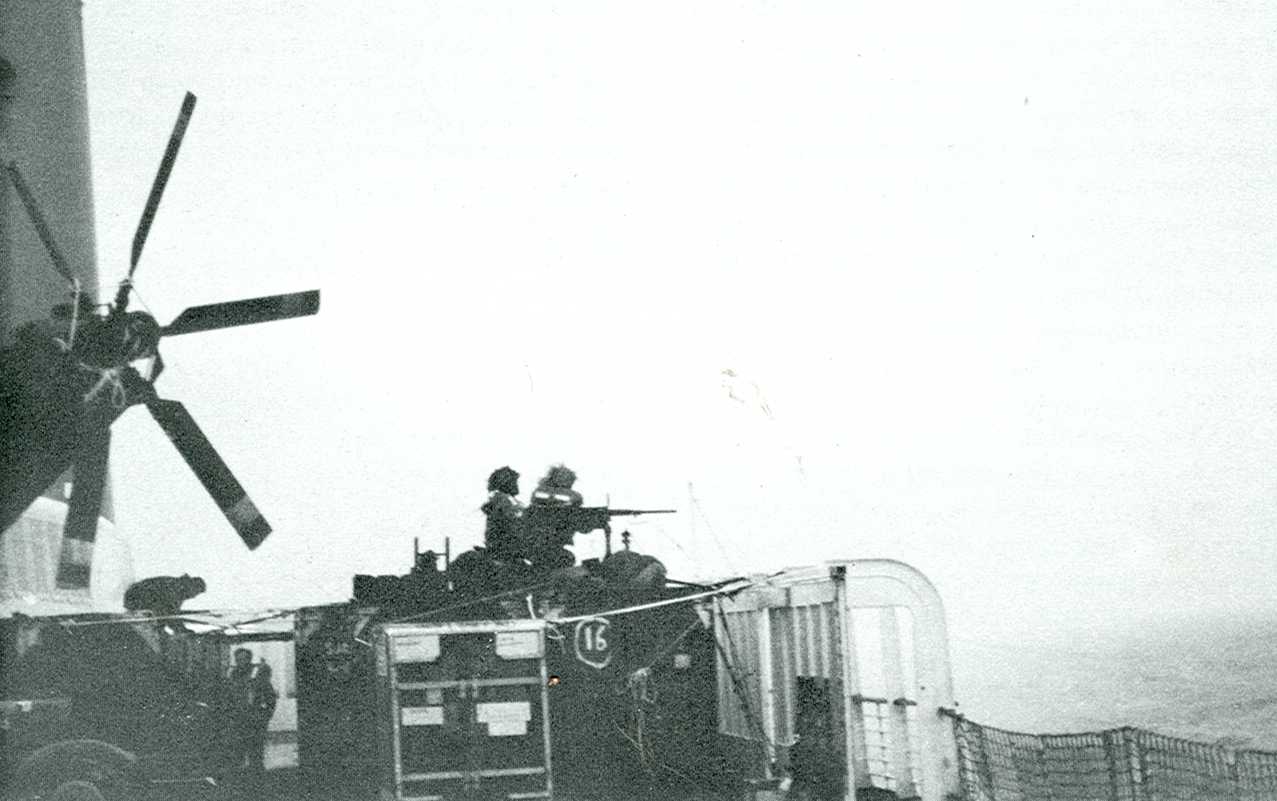
The waiting lasted until 8:55 am, when a single Pucara attacked Canberra but was driven off by machine gunfire. Then at 9:38 two more Pucara attacked 2 Para on Sussex mountain and D sdn, 22 SAS, withdrawing from their successful diversionary raid on Darwin. One was shot down by D sqn using the American Stinger missile. These Pucara were based at Goose Green only 12-14 miles to the south of the beachhead. Thereafter, we were subject principally to jet aircraft. The next were a pair of Mirages which attacked the anchorage at 9:45. From then on the, raids seemed continuous. Capt Burns the senior naval officer in Canberra, who had been calling those below decks to take cover at each and every attack, assured us that he could give 2 minutes warning of future attacks. As he was making his announcement we heard the roar of another Mirage over the PA system followed by abject apologies from Capt Burns. The aircraft had approached at wave top level totally undetected.
video (4 mins)
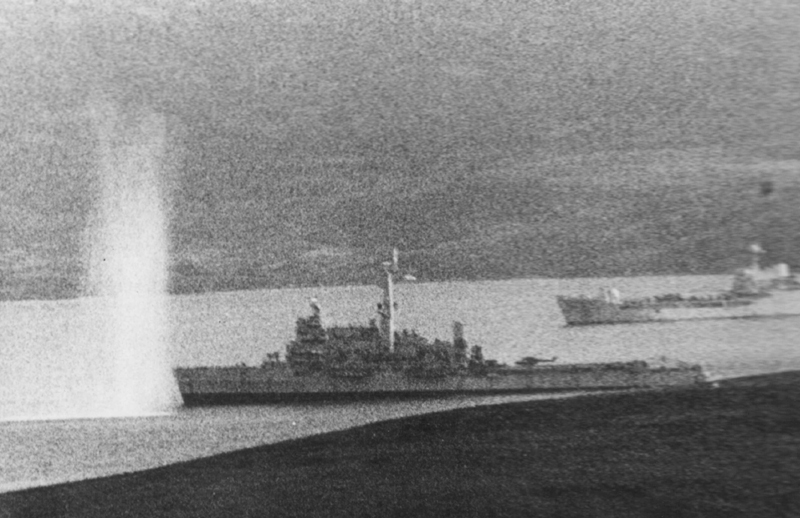
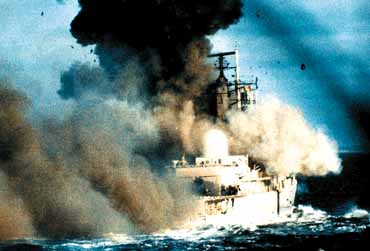
Some 72 aircraft bombed and strafed the ATF on D-Day and by late afternoon all of the frigates in or near the anchorage had been hit and damaged, one of them HMS Ardent mortally. Amazingly no further attacks came and Canberra, the LPDs and the LSLs remained intact. This was the first opportunity that the Argentine air force missed to cripple the cdo bde by attacking and sinking our supplies. On D-Day all of the brigade ammunition, fuel and rations were still embarked, and the loss of the LSLs would have resulted in the brigade being without its combat supplies other than those which we carried ourselves. Instead the Argentinians attacked but failed to destroy the air defense systems, that is the RN ships; to us grunts this was clearly a tactical error. Due to the vulnerability and lack of availability of RN ships in Falklands sound, my coy mission was changed and I rejoined 42 cdo in reserve. My commando was thankfully ordered ashore at about 11 am, to follow up the 1/2 coy that shot down the two helicopters.
Brigadier Thompson was also keen to get us off the Canberra, the most prestigious ship of the ATF so that she could get to sea at last light. As we moved ashore in 4 x LCU's we were of course most fearful of another air attack, but fortunately with almost predictable British Royal Air Force custom, the Argentineans must have taken a short lunch break, thereby allowing us to land at green beach one without incident. Nevertheless, we were so keen to get off the LCUs that we made no comment about the thigh deep wet landing to which we were subjected. We were positively elated to get ashore, in an environment similar to Dartmoor or Scotland, where we felt much safer than aboard ship or LC.
Throughout our time in the beachhead we were very much aware of the very valiant defense by the royal navy, and of their crucial and fundamental naval gunfire and air defense actions.
Due to our hot pursuit role we went ashore in Fighting order, a belt/webbing equipment without Rucksack but carrying 2 x mortar bombs etc. Having Dumped these bombs at the mortar base plate position at Port San Carlos, we were able to move much faster and My coy had the first contact some hours later. We saw 4 figures moving in the rocks on "the knob" a small prominatory in the San Carlos river, which one troop (platoon) proceeded to attack. It was with considerable embarrassment that we had to report on completion, nothing more than penguins! My boss LTC Nick Vaux was simply furious, but in the circumstances I believe we were right to shoot first and ask question later! That night and the next we slept in the open without sleeping bags or overhead cover. Having got thoroughly wet in salt water in the landing, we were very cold, but delighted to be doing the job for which We had trained so hard. During the afternoon of D+1, Having failed to catch the fleeing enemy, we occupied a defensive position in Cerro Montevideo. From here we watched the repeated air attacks on San Carlos to our SW and came to know that if the aircraft turned left as they flew over us they'd be shot down in a big red puff of smoke, this was a maneuver normally preparatory to a second strike at the fleet. Go straight on past us and they survived but perhaps only until they met the Harrier CAP operating west of the Falklands. Here incidentally is a chart of enemy aircraft shot down and how. Most aircraft attacked from the south, but in order to hit attractive LF targets ashore they had to approach from East or West. This was only done once when four marines were killed, 12 wounded, and the ammo dump hit. I had a spectacular view of this from Sussex Mountain. This slide shows friendly a/c losses.
video (4 mins)
After 2 or 3 days in Cerro Montevideo we were withdrawn by night by LCU to Port San Carlos where we were reconstituted as a reserve. It being a Sunday we even had time for a coy church service, congregations expanded enormously during the course of the dispute! On the afternoon of 26 May, I was given an order over the radio to move my coy in 20 mins; and I to catch a Helo in 5 mins. No further details were given for Security reasons. I was flown to Sussex mountains by Gazelle to take over 2 Para's TAOR immediately. After a short brief by the co, I was quickly able to select the key areas and identify the vulnerable approaches to the brigade admin area that had to be covered by standing patrols. The coy moved in without difficulty and once my xo and CSM had a firm understanding of the plan, I went to attend the CO's orders for the battle of Goose Green.
The battalion moved out under cover of darkness a couple of hours later. As I listened on my HF radio to the BBC world service evening news, I was simply horrified--and the co apoplectic with rage--to hear a report issued from London that 2 Para was now heading towards Goose Green. This news report was heard by the Argentineans who we later discovered moved a reinforced Coy to Goose Green from Mount Challenger/Mount Kent to counter the threat. The commanding officer of 2 Para LTC H. Jones was killed in action at Goose Green, 2 nights later when the attack was faltering and in need of a dramatic action. He was postumously awarded the Victoria Cross, The supreme British award for gallantry, and one of only two awarded during the war. We have now reached the stage where we are breaking out of the bridgehead, and I intend to cover the land battle in the next presentation. Now, however, is a good time to mention some of the lessons That can be drawn for the battle so far, while they are still fresh in our minds. First of all, modern warship construction has until now favored light and usually highly flammable toxic materials. Damage control and firefighting was so difficult that on at least two occasions the ship Had to be abandoned and later sank. The use of aluminum in the superstructure is under review, while other materials such as mattresses are now fire retardent. The value of anti-flash protection for head and Hands was clearly illustrated. The man-made fibre Overalls melted to the skin and contributed to many serious injuries. Natural fibre overalls are now issued. The navy in particular and the force in general lacked airborne early warning and control systems, Thereby leaving us particularly vulnerable. A number of a/s Sea King helos have now been converted to accomplish this vital role. Helicopter assets are vital where terrain prohibits mobility, and we did not have enough. All Available sorties of medium or heavy helo were used for Artillery deployments and resupply. It was also relearnt that a light reconnaissance or command Helicopter with only limited armament and in country devoid of natural cover is vulnerable to ground fire.
Harrier was a major success and showed itself to be flexible, robust, reliable and effective especially when equipped with your AIM-9L air-to-air missile. However, despite its success, it is not a fighter and is not as effective as a fighter would have been in the same circumstances. The UK had no alternative but to use the Harrier, which proved itself better than was expected. As for attacks on airfields, there is a need for an advanced airfield attack weapon. I understand these are under development. The absence of a dedicated land force, air reconnaissance capability was a severe handicap in our ability to gain enemy dispositions. At the time of the Falklands there were two platoons of rpv with the British army in Germany. This force is now being expanded.
The need for defense suppression weapons was clearly illustrated. Harriers were exposed to heavy and accurate ground fire due to the lack of these weapons, and three were shot down. Similarly small-arms fire accounted for a number of Argentinean aircraft.
In the air defense field all surface ships require a point defense capability to counter the missile threat. Vulcan Phalanx guns have now been fitted to all warships, and anti-missile chaff dispensers developed for attachments to all ships including merchantmen. There is also a need for more realistic air defense training. In particular all ships need to be fitted with a wide range of on-board trainers if the Navy is to optimize the performances of high technology systems. And we require more realistic targets for peacetime training of air defense weapon system operators. Ashore, there were insufficient land air defense assets. Every manoever battalion requires an air defence capability. We have now strengthened our own FAAD troop and issued the brand-new Javelin missile. In due course we shall also be getting a Rapier battery organic to 3 cdo bde.
The rapid dispatch of the amphibious force in three days was good politically, but caused problems to the landing force which embarked with little or no intelligence, and no firm mission or plan. It is not a recommended method of going to war, and was not militarily necessary.
The SSN nuclear powered submarines were flexible and powerful instruments throughout the crisis, posing An ubiquitous threat which the Argentines could neither measure nor oppose. Special forces played a key role in advance force Operations. The combination in a single patrol of Intelligence gathering skills with the capacity to Mount highly destructive raids gives the military Commander a flexible and potent weapon.
Finally I'd like to quote from a report sent to Our captain general HRH Prince Philip, the duke of
Edinburgh.
"The amphibious landings at San Carlos on 21 May 1982 were the first occasion that an assault landing had taken place at brigade level since the Suez crisis and the first time since 25 April 1915 (at cape helles) that such a landing had been launched from a task force incorporating non-specialist amphibious ships. The amphibious dimension was a paramount feature of the operation and it is doubtful that any other amphibious operation has been undertaken with operation Corporate's combination of speed and distance from the mounting base. Without an amphibious capability and the expertise in the specialist techniques involved, The United Kingdom could not have delivered a military riposte to the Argentine invasion.
The presence of specialist amphibious shipping for Operation corporate was an essential element in the Success of the operation, particularly during the Initial landings. The availability of the two LPDs and the six LSLs proved invaluable, but the lack of shipping with multi-spot helicopter platforms, essential for achieving really efficient ship-to-shore movement, was a serious handicap. This comment in no way diminishes the outstanding contribution made by ships taken up from trade (STUFT) which performed admirably within their own capabilities. Nonetheless, The operation emphasized four points concerning amphibious shipping:
a. There was a shortage of specialist amphibious shipping, and in particular, ships that were capable of operating more than two helicopters at a time. HMS Hermes was the only helicopter assault platform of significance but it was not made available to the amphibious force.
b. Even with all six LSLs, delivery of vehicles and stores required substantial use of STUFT.
c. The inability of LSLs to work helicopters off the forward spot at night delayed the off-load plan and proved to be a major handicap. The same applied to STUFT on which no night flying was allowed.
d. STUFT shipping was very vulnerable, but clearly proved its worth. Although an essential supplement to the amphibious group, STUFT by themselves could not provide any form of amphibious capability. Apart from their poor communications and total inability to provide command and control facilities, they are not by themselves capable of supporting an assault landing, or operating over the beach where ports and jetties do not exist. Experience of amphibious operations, and their extreme flexibility, enabled the commanders and staffs involved to achieve a successful landing and to secure a harbor and beachhead from which land operations could be developed. The absence of any major set-back should not blind analysts to the risks taken during and for a few days after the landings. The necessity in an amphibious landing for local air superiority remains Valid.
The relevance of this campaign to amphibious operations In Europe and particularly the northern flank is undoubted. The lessons emerging are not new but it has probably taken a war to refresh memories and re-emphasize the value of a specialized amphibious force. The need to replace the core of specialized amphibious ships, capable of launching substantial numbers of helicopters, and the provision of effective local air superiority and air defense assets, are lessons which apply as much to operations in support of NATO as they were shown to apply in Operation Corporate." Fortunately this need has now been recognized, and replacements for the aging LPDs and LSLs are in hand for the 1990s. I suppose the two fundamental lessons learnt can be summarized as follows:
Ladies and gentlemen, I regret that time has not Allowed me in this presentation to cover innumerable Areas of interest to the naval gunfire, artillery or Air defense expert, the medic, tanker, the logistician, and embarkation officer, pilot, public affairs officer and so on. For the benefit of the rest of your though,
We shall break for 10 minutes and I shall try to answer as many questions as possible when we return. Please listen for the bell.
The second presentation to the u.s. marine corps
command and staff college on the falklands war 1982
by Major D. G. Wheen, RM
10 March 1986
video 11
Ladies and gentlemen, good afternoon and welcome to The second presentation on the Falklands war. Those of you who managed to stay awake, and can still remember part 1, will remember we covered the political, historical and geographic background to the Falkland islands that led to the Argentinean invasion on 1/2 April 1982, and the British reaction in which we sent over 100 ships in the largest amphibious operation since WWII. We went through perma, and drew-out some of the more obvious lessons we learned in the naval, amphibious, aviation, and anti-air war. The aim of this presentation is to cover the land battle. I shall not cover all of the operations in detail but let me remind you that the force comprised the necessary hq, gce, css and, to a certain limited extent, the aviation elements of A 8/9 MAF. I shall primarily be concentrating on 42 Commando's operations, particularly l coy's. We left 2 para en route to Goose Green, in the first overt move to break out of the beachhead. As I think I explained in the question and answer period last time, Brigadier (general) Julian Thompson had initially contemplated a raid on Goose Green but rejected the idea because he felt the enemy force at goose green could be contained and bypassed. He was, however, placed under political direction from the United Kingdom to take up the offensive, and ease the media and military pressure on the ships of the ATF in Falkland sound. I don't intend going through the battle in detail as I was not involved, but it was the first set-piece battle of the war and 2 para's victory was an enormous boost to morale. It set the pattern for the later battles in that the attacking force was in each case enormously outnumbered by the defense, who were in well prepared defensive positions.
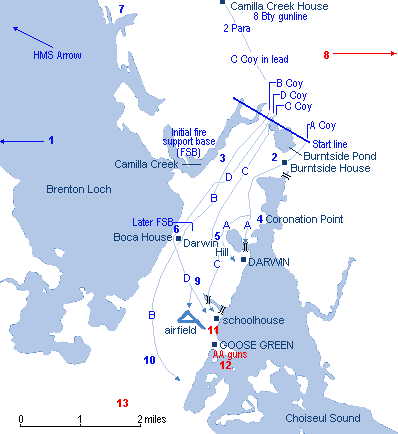
The battle for Goose Green was, however, unique in that it spilled over the first night and into the whole of the next day. Low gently rolling hills made it seem ideal tank country, but these were not used as it was felt they would get bogged down in the peat. Experience in the long march across the island eventually showed that this would not have been the case and Julian Thompson freely admits his mistake. A lack of direct and indirect fire support was a problem throughout the battle. 2 Para had just 3 x 105mm guns in direct sp, and only two of their own 6 x 81mm mortars; hms arrow provided ngs from 1 x 4.5" turret during the night but had departed before dawn in order to give protection to the ATF around the beachhead. 2 Harrier GR3 (ground attack Variant) sorties each involving 2 Harriers were used in the day preceding the battle, but on the first mission the FAC and Harrier never made contact. Much of the FAC's equipment had been left behind due to the 12 mile manpack move. This also explained the lack of mortars and artillery assets.
The second ill-fated sortie was flown by wing Commander Pete Squire and squadron leader Bob Iveson; Iveson had also flown the first sortie. The Harriers made two passes and then Bob Iveson decided, on his own initiative, to make a third run to attack some trenches, ironically the trenches on Darwin Hill that were later to cause so much trouble to 2 Para. Let me tell you fast movers, Harrier pilots particularly, what he wrote;
"It was a silly move, a very poor tactical move, and it cost me because it was on that pass that I was hit. I was coming off target, heading roughly west, and was hit by two fairly large-calibre shells - probably 30 or 35 mills -a hell of a thump which rattled me round in the cockpit banging my head on the side of the canopy - it moved the aircraft sideways that much. Things went very wrong, very quickly, after that. The controls stopped working; there was smoke in the cockpit and finally fire, at which point I pulled the handle. I was in a good attitude to eject but I was a bit fast and a bit low - about 450 knots at 100 feet.
The chute opened and I found myself going right towards the fireball of my aircraft in front of me. I couldn't tell whether it had struck the ground or not. I think now it had blown up in the air. I was only on the chute for about ten to fifteen seconds before I hit the ground, in a bit of a heap and very winded." The Harrier's speed had taken it well away from Goose Green. Iveson suffered a compression fracture of his back and windblast damage to his eyes. He made contact with friendly aircraft on his survival radio and was picked up by a naval helicopter two days later. He recovered from his injuries and returned to the Falklands for a second tour after the war.
Throughout the battle for Goose Green, 2 Scout Helicopters from 3 cdo bde air sqn were used to fly in ammunition and evacuate casualties, including the co, LTC H. Jones. They were finally attacked by a Pucara aircraft, and after a 5 minute game of cat and mouse, one was shot down killing Captain Dick Nunn RM instantly. He was the Brother of Chris, coy cmd of M coy 42 cdo, at this time in South Georgia.
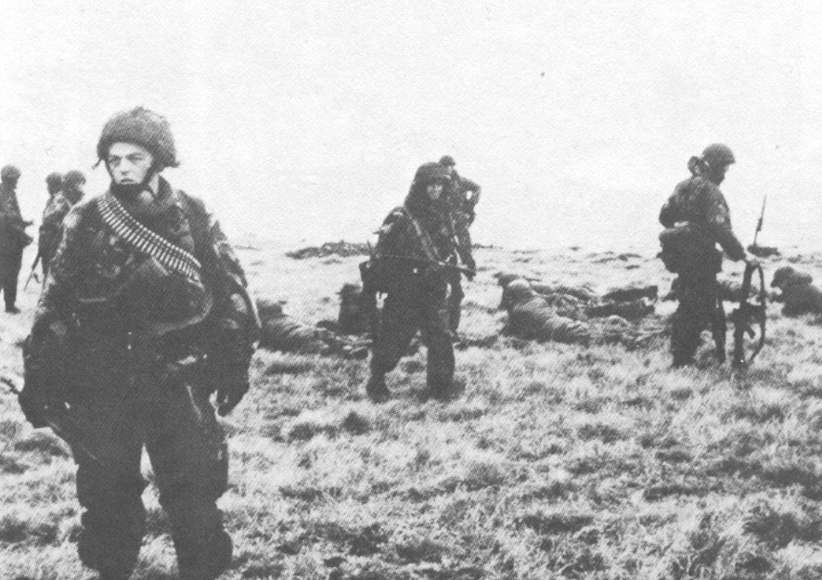
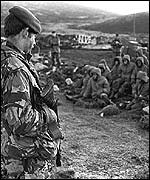
The long and weary battle started at 0230 on 28 May but the Argentinians did not finally surrender until day-break on 29 May, 32 hours later. The battle cost 20 British lives and 37 wounded. 1100 prisoners were taken and the captured equipment included 4 x 105mm howitzers, 6 x 120mm mortars, 6 x anti-aircraft guns and 2 x Pucara aircraft. I said earlier that this victory was an enormous boost to morale; I think you can now see why! J coy 42 cdo was flown to the area during the night of 28/29 may but arrived too late to take part in the battle since the Argentineans very sensibly surrendered. They did, however, help sort out the prisoners, rehabilitate the locals and evacuate casualties. During the afternoon of 28 May, my coy L was relieved on Sussex mountain by B coy 40 cdo and we made our way back on foot to San Carlos settlement whence we were carried after last light by LCU to port San Carlos, preparatory to flying forward to the Mount Kent area. I shall now get Maj Gen Jeremy Moore to set the scene for subsequent operations.
video 12
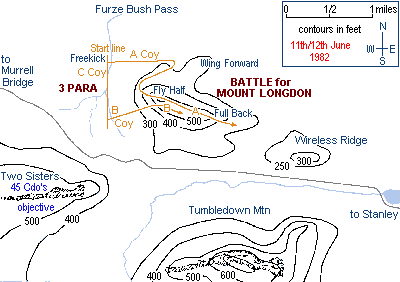
Concurrent with the end of the battle for Goose Green, 45 cdo and 3 Para started the big yomp across east Falklands. They marched 80 miles in three days carrying all their personal equipment for combat; the packs weighed Up to 110 lbs. It had been hoped that the whole force could have been helicoptered to the Mount Kent/Mount Challenger area west of Port Stanley, but the loss of 3 Chinooks CH-47 on the Atlantic Conveyor dashed these hopes. This is the account from the diary of Captain Ian Gardiner, A fellow coy comd in 45 cdo RM.
"The walk from Port San Carlos (north east) to new House, some twenty kilometres, was the worst of my life. The weather was not too bad but the ground was boggy. Where it was not boggy, there were strong lumps and tufts Of grass which, however one stands on them, even in Daylight, one stands a good chance of turning one's ankle. In places it was pretty steep but all faded into Insignificance compared to the cursed weight we were Carrying - much of which I knew to be wholly unnecessary. I probably make things worse for myself by allowing my bitterness to burn up energy - but the marines were magnificent. We lost the first man after 200 yards - a man known to be the company skate - and about six more over the next few hours. They were mostly the weaker-spirited men who, although they possibly did have something wrong with them, would probably have found some pretext or other to roll around in agony in any event. The rest went on with the greatest of stoicism and good humour all day and through until 2 o'clock the following morning. I was immensely proud of them. If possible, marching in darkness was worse than daylight, and, for those at the tail end of a queue of 600 men bumping and stumbling through the black night, life must have been hell. I was fairly preoccupied by trying to keep people together and perhaps didn't notice so much, but by the time we harboured up, I was near my wit's end.
At 2 a.m. I gave the order to bed down without erecting bivouacs. Our bivvies were simply a waterproof ground-sheet supported by a small stick and some rubber bungies. This was a bad mistake. It rained during the early Morning, and the plastic bags in which our sleeping bags Were stretched did not keep the water out. Our sleeping Bags were soaked. The last citadel of a man's morale is His sleeping bag. The comfort and resource it offers is Amazing. On subsequent occasions, when one was being Shelled or heard bombing close by, it was an instinctive Automatic reaction to wriggle deeper into the 'green slug'. When all else failed, when the world crumbled around us, Even if the sleeping bags had failed to turn up in the Evening, one always was vaguely comforted by the prospect Of climbing into a dry bag eventually. When my citadel Was drenched by rain, my morale was at its lowest...I was subsequently to spend more uncomfortable and more bitter nights and it was not the last time my citadel was breached - but one hardened. The men who survived that march basically stuck it right through to the end." This account accurately reflects the experiences of the whole of the force that made it as far as the approaches to Port Stanley.
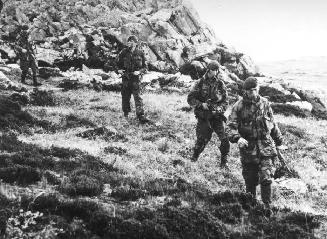
Back now to maneuver operations; Julian Thompson was keen to occupy Mt Kent and Mt Challenger, the keystones to subsequent offensive operations around Stanley, as soon as possible. An SAS sqn had conducted ops in this area for a couple of days, and a secure LZ was located. The first attempt on 29 may to fly in k coy, tac hq, Mortar troop and 3 x 105 was frustrated by a white out, despite determined attempts by the 4 pilots using night vision goggles. The pilot of the Chinook CH-47 was flying so low that he accidentally dunked his wheels into the waters of a lake. The alert crewman, fearing that the a/c was about to ditch, jettisoned the door. Thereafter that Helo, the only Chinook to survive the sinking of SS Atlantic Conveyor, went doorless, there being no spare parts available! The following night of 30 may, the fly in using Sea King and Wessex for troops and the Chinook for the artillery was achieved successfully but not without excitement. At the critical moment, an Argentine SF patrol wandered across the area. As the first wave was landing, D Sqn 22 SAS engaged the enemy and swiftly dealt with them, but the pilots had some worrying moments as tracer bullets criss-crossed the landing site. By first light on 31 may, k coy had reached the summit of Mount Kent, its objective, to find that the enemy had withdrawn. From this summit could be seen Stanley and the airfield about 20 kms away, well out of range of our 1o5mm Guns; but these were able to engage Moody Brooke marine barracks: the end was literally in sight but there was much still to be done.
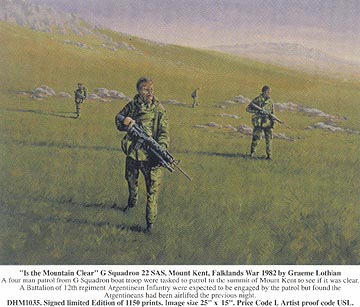
Commando tactical headquarters, one rifle company, one SAS squadron, six 81mm mortars and three light guns with very little ammunition were sitting on a key piece of ground near, and nobody knew exactly how near, five Argentine infantry regiments, supported by thirty 1o5mm guns and some 155mm guns. The nearest British troops were 3 Para at least half a day's march away. The nearest guns, other than the three already forward, were sixty-five kilometres away, nearly four times the range of a 105mm light gun. Except for Harriers in the ground attack role, The 200 or so commandos and SAS men were on their own. My company, L coy, was to fly forward to take Mount Challenger the following night 31 May/1 June 1982, but Lt Col Vaux said he wished me to contact him on the radio to confirm my orders. I was unable to get through on my Man-pack PRC 320 HF radio or on any of my other radios for that matter, so I flew to the SAS comms shack at San Carlos settlement where a satellite terminal loaned by USA was Located; D sqn below Mt. Kent also had one. Initially, I got through to Ascension Island, 4,000 miles away, where i Recognized the voice of 21c 22 SAS who had been my office mate in N. Ireland for nearly 2 years. I then got through To Hereford 8,000 miles away, and finally spoke to my boss 45 miles away. The implications of a few independent patrols being able to talk to Hereford, and be "patched Through" to Whitehall are immense: first of all, it guaranteed political interference in the military campaign; second, it meant that the whole command structure could be circumvented. For example, Cedric Delves, the oc of D sqn 22 SAS, was "twiddling his thumbs" back on board ship, after the recapture of S. Georgia wondering what to do, when he realized that a raid on Pebble Island would be a suitable task. His suggestion which would involve the Use of HMS Invincible, a guided missile destroyer and other valuable assets was apparently rejected by Admiral Woodward. A quick call back to Hereford ensured that Admiral Woodward was directed a few hours later by the task Force commander to carry out such an operation as soon as possible! Anyway I spoke to LTC Nick Vaux who confirmed my orders to move as far eastward on Mt. Challenger as possible. From there we could dominate the road from Stanley to Goose Green and the ground to Mt. Wall. That night we flew into the same LZ and were guided to just below the ridgeline by SAS. This was our first experience of crossing rock runs at night while heavily laden. Even though we only had our belt equipment, wpns and ammo, including blowpipe air defense missiles, 2 days' food, sleeping bag and minimal shelter, the average weight was 60-70 lbs. It took us 8 hours to cover the 5 miles.
As we reached the ridge we spread out into attack formation And conducted an advance to contact along the ridgeline, And as dawn of 1 June 1982 arrived, we went firm in a particularly suitable rocky outcrop 300m x 200m 2km west along the ridgeline on your map 4 (at gr 230705). This was home for the next 11 days for the 189 men of my coy group. This group included my 3 rifle troops each of 34, coy hq (10), FOO party (5), FAC team (3), sniper team (2), recce Sect (2 x 4), ae tp (20), re tp (24) ad sect (8), mfc party (2).
video 13
Life in our home was rugged. First of all, as i mentioned last presentation, the wind blows most of the Time but changes in intensity and direction frequently. With our makeshift shelters we had to change location from one side of the ridge to the other, to stop being blown away. When the wind was not blowing, the cloud base was generally very low; to the extent that it, or
Non availability of helo assets prohibited resupply for 5 days. As you can imagine, we were fairly hungry when it Eventually came: 2 days' rations don't stretch that far. Fortunately, we had located a small abandoned Argentinean position, and so after careful examination of each tin and package to make sure it had not been contaminated, we gratefully ate their rations. Nevertheless we eagerly awaited the arrival of the first helo!
Despite these Argentinean rations, we were down to one cube of hexamine per troop - this will heat 1 pint of water in calm conditions to boiling point! And a very little dehydrated food which was useless as it needed cooking! There are as you'll recall no trees in the Falkland Islands and the peat bog was completely sodden so we had no combustible materials. Life was pretty miserable, with freezing temperatures, rain or snow and 20-30 knot winds, So I was obviously concerned about the effects particularly of exposure and battle casualties in these circumstances. I am pleased to say that I had to evacuate only 1 medical Case, and he had a stomach problem. There was great elation on day 5 when the skies cleared and we were informed a helo resupply was en route. Imagine our disappointment when the helo arrived not with food or cooking fuel but mail. You can't eat letters. Fortunately, our disappointment did not last long and 15 minutes later food thankfully arrived before the mists returned for a further 24 hours.
Having mentioned mail, let me expand a little. Prior To any combat operation, most men in the coy wrote at least One letter to a wife, girlfriend, or nok. These were not Necessarily written in a morbid manner but you had to make Sure that, what you wrote, was what you intended your loved Ones to keep and treasure, should you not survive or Perhaps worse should you be desperately wounded or burnt. I remember I wrote 7 such letters home to viv, and each one Was written as if it was my last. It really emphasized in My mind, and I think in viv's too, what was important in Life and what was unnecessary or frivolous; and for 2 or 3 Months after our return, I dare say we were the better for It. I regret it didn't take long though to get the urge For comfortable and materialistic capitalism!
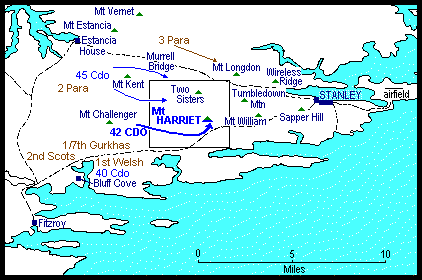
Anyway to get back to what was then our home, where we Accepted what little we had with gratitude. As you've Heard, food was scarce, and so far as water is concerned, We had to find our own. The nearest stream was 5 miles Away - east of the Argentinean regiment at Mt. Harriett. We were on top of a mountain but fortunately the water Settled and remained on the surface! In coy hq, 10 of us Used a puddle 6 ft. Long, 2 ft. Wide and 6 inches deep For the duration of our stay. Hygiene of course was of Crucial interest but luckily no one at this stage suffered From the 'dog'.
We were on this outcrop virtually invulnerable to surface attack and so I cancelled the 100% stand to at dawn and dusk, but we were subjected to periodic 155mm harassing fire. On several evenings we received salvos of 6x 155mm shells every 20 minutes or so for a couple of hours each time. These caused no casualties and were nothing more than a nuisance. The Argentine artillery was firing onto the high features all across their front, and I got the impression that this was a battery firing in general support without the benefit of forward observers. We were indirectly subjected to only one air attack. 5 x 1000 lb. bombs were dropped out of the tailgate of a KC-130 one night. The earth trembled at every explosion and I reported to cdo hq that these landed 3 or 400 meters northwest of us, k coy reckoned it was 200m southeast of them. As we were 5 km apart, one or both of us was wrong, All I do know is they made an enormous impression upon me. I could only imagine what the Argentineans at the airfield must have felt when they were similarly attacked, and the Bombs landed virtually on target, within their midst!
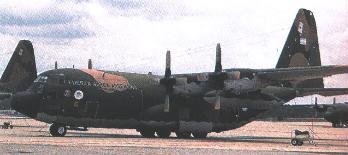
Talking of the airfield, we could see it and the port from Mt. Challenger and could see the daily aircraft and ship movements. It was very frustrating to be able to do nothing about it. Despite the TEZ, 2 or 3 C-130 aircraft movements occurred each night, and coastal ships occasionally seemed to risk interception too. To say I was frustrated is in fact an understatement; I was furious because the BBC world service had said time and time again that the TEZ was complete and unbreachable, and the airfield completely blocked. I was furious about having been fed propaganda and believing it.
Visibility in the Falklands is superb with no pollution, and from our position we had an amazing view east towards Port Stanley and southwest 12 km to Port Pleasant (gr 165635) where on 8 June 2 LSLs could clearly be seen. In the worst disaster of the war incorrectly called "bluff cove" these LSLs, Sir Galahad and Sir Tristram, were bombed by 5 SkyHawks. Sir Tristram had actually unloaded most of its cargo and the 2 bombs caused little damage other than killing 2. The effect on Sir Galahad was vastly more serious. Within 45 minutes the whole ship was ablaze when the ship's master, Captain Roberts, finally abandoned ship himself. After the surrender, the Galahad was towed out to sea and sunk as a war grave. 48 men died in the attack and 150 were burned or injured. We watched, totally impotent, as the attack came in, and within seconds could see the smoke and flame billowing out; my forward op, 2 km from the enemy, also clearly heard the cheers of the Argentineans on Mt. Harriet. They could equally clearly see the attack from 16 Kms away, and had sent the original sighting report. My Air Defence detachment fired one Blowpipe missile at extreme range, more out of frustration than hope, but it failed to get close to any of the aircraft as they swung south instead of north.
video 14
Let me now talk about patrolling, so that you can see how we acquired the information necessary for the co to make his plan for the attack. Patrolling involved the domination of no man's land and reconnaissance of what was likely to be our objective, Mt. Harriett. Brigadier Thompson of course realized that it was important to Coordinate all patrols and so appointed a patrol master, The s03 g3trg to do this. Each cdo sent out only one troop strength patrol each night. My coy sent out 5, roughly one every other night. The first was to position an op on the east end of Mt. Wall, at gr 275707. As this was only 2,000m from the main Argentinean defensive position, it seemed most likely that it would be engaged fairly early on. It was, therefore, a very strong team of 16, including 2 x 4 man teams from recce tp, 2 snipers, fac and foo Teams; I placed oc recce tp, who was under command, as the OC. I spent all night clearing and positioning this post which eventually moved in without difficulty. Just before first light, I was at gr2587o8 returning to my coy base when very thick mist came down. I stopped my patrol until it lifted since I had no desire to get disorientated. And we crawled into our sleeping bags. Typically as we had no shelter overhead, it started to "pee" with rain. My sleeping bag got soaking wet and for the next 72 hours I had to put on waterproofs before climbing into my "slug".
At the question and answer period last time, someone asked what kit was the most useful; I found it difficult to answer because it was all useful -- that which I did not have but which I swear I shall never again be without is:
a. A gore-tex sleeping bag cover/bivvy bag
b. A hollow-fill sleeping bag rather than a down or feather sack. Scientifically they dry 27 times quicker and don't now suffer the serious degradation that they used to, when damp. In my last job procuring and trialing kit for Special Forces, I co-directed comprehensive trials lasting 12 months and involving live trials in the arctic and controlled cold chamber evaluation at temps down to -40oc (-40of) and including 1 litre of water per bag. The American north face big foot sleeping bag came out on top, I can wholeheartedly can recommend it!
Anyway, the op was able to remain in position for several days engaging the enemy with indirect fire and gaining valuable details of enemy disposition on the forward slope of Mt. Harriett. At dawn on day 1, however, they were horrified to see an Argentinean 5-man tent about 500m from their position, at gr 282707, but it didn't bother them until day 4 or 5 when the Argentineans decided to have breakfast on the summit of Mt. Wall from where 2 marines were constantly on watch. Curiously on reaching the summit, the Argies faced east, sat down and started to cook. Lt. Chris Mawhood decided that this patrol must be dealt with. After deploying the whole force into fire positions with mgs, 66s, and slrs, 2 men went dagger-in-teeth to try to capture them. When only 3 or 4m off and despite absolute silence, one of the Argentinians turned to look over his left shoulder, with weapon in hand, and the last thing he ever saw was a marine approaching. After a short and successful engagement the op requested and was given permission to withdraw. Fearing an enemy follow-up the op fled leaving much heavy personnel equipment behind, including sleeping bags. The logistics on the falklands was such that there were no spare bags available; they had all been sunk on the Atlantic Conveyer. The op party had several cold nights until we finally overran the Argentinean position, and liberated some of their excellent Bags!
As the op withdrew, I received a sigint report that 3 X Argentinean troops were en route by vehicle along the Road to cut off their withdrawal. I quickly assembled our 16 coy mgs and moved forward to gr 257704 to cover their retirement across the open saddle between Mt. Wall and Mt. Challenger. They got across without interference, and There was no sign through the swirling mist of any enemy Follow-up; along this track (point) but that is not to say It was contemplated or even planned. The next sigint report we had was that the Argentinians were going to use chemical weapons against us, and we did not have our gas masks with us; they were at Port San Carlos with our heavy equipment. Amid frantic efforts, these were removed from our packs and flown forward. There was much relief when they arrived within two hours; the earlier discovery of Napalm at Goose Green lent some degree of credence to the report but we were thankful that we were never subjected to a gas attack. The final input from sigint came during the battle at a very critical stage when we were held up 600m from the summit of Mt. Harriett. I was told that 12 helicopters were inbound to the mountain top. At first I thought these must be mortar bombs showing up on the radar, but I was assured they were helicopters. I surmized that even if it were only 12 Hueys, the reinforcements alone would be enough to cause me to fail in my mission. I therefore had a renewed sense of urgency that might have contributed to one or two of my casualties later in the battle.
To get back to our patrol program. The next night, 6 troop, under the command of 2 lt. Julian Pusey, laid an ambush due south of our coy position along this track from Goose Green to Stanley - in the hope of catching stragglers Returning to Stanley after 2 Para's battle but we caught nothing. The patrol the following night was our first Forward of Mt. Wall, which was still at this time occupied By the o.p. who had identified the positions of the forward (western) slope. Its job was to engage the enemy on the Southwest side of Mt. Harriett, in order to pinpoint Obstacles and dfs, gauge their level of competence and Procedures, and generally harass them. 4 troop, under LT Ken McMillan moved out at last light along the ridgeline And south of Mt. Wall. 3 hours later marine Curtis, a 230 Lbs. RN rugby player, stepped on an antipersonnel mine, at Gr 285708. At that time the patrol also came under artillery fire. Cpl Cuthell, his section commander, another large rugby player, picked him up and carried him back the way he'd come, for about 250m. There the troop stopped and Curtis gave himself morphine while the remnants of his foot were bound and strapped up by the corpsman (ma). The mission was abandoned, and then started the long, slow business of evacuating him back. The weather Was foul, and the low clouds prohibited helicopter Casevac. Whenever the patrol stayed on the low ground Where the going was good, they were shelled. An optimist would say that part of the mission had been achieved, as We'd found some of their dfs and located one minefield! Anyway the patrol had to go on the rough ground at the foothills to the south of Mt. Wall to avoid the artillery. There the rock runs impeded their progress enormously, and made the whole thing a very tiring exercise for all. I'd Remind you that there are no trees in the Falklands -- and no local resources for making a stretcher; I'm not sure anyway that over the boulders one could have been utilized. Each section carried 2x sleeping bags and a kip (kit individual protection), used for construction of shelter trenches. These were used from time to time but were not very good. After a second stop for more intravenous drips and rest for all, the troop eventually got back absolutely exhausted at 9 a.m. Those of us who have in the past skipped over the casevac procedures during exercises in the NATO sequence of orders, had better take note. At about 10:30 there was a break in the weather and Curtis was eventually evacuated by helicopter to SS Uganda. Though the offensive missions of the patrol were not achieved, the co surmised that he could not hope to succeed in a frontal assault across the open ground that was likely to be mined along the w of Mt. Harriett north of the track. Marine Curtis incidentally has an artificial leg and within 9 months went skiing in Colorado. Though he can also pass our physical fitness test he has left the RM and is currently at an university.
The next night I cleared a route with our combat and attached royal engineers from the saddle between Mt. Challenger and Mt. Wall southwest track, to the track, and the following night I sent out 5 troop, under Sgt Weston and a small recce section under Sgt Collins to find a route round the south of the minefield. The troop commander, Lt. Burnell was suffering from exposure so did not lead the patrol. He fortunately revived when we got the helicopter resupply of food that I've already spoken about.
Sgt Weston's patrol was to establish a patrol base at Gr 290700, while Sgt Collins was to go forward to gr 310702. They were nearing the patrol base location, when "bang", marine Paterson stepped on a mine. The patrol could not be abandoned since the attack was scheduled for the next night. Sgt Weston with one section took Paterson back 1500m where a helicopter recovered him 35 minutes later. A section commander established the patrol base and Sgt Collins went off. As the result of this patrol, the co had all the information needed to make his plan. But next day, LSL Sir Galahad was hit in the attack I've already mentioned, and due to the reallocation of all helo assets from artillery resupply to casevac duties, the bde coordinated attack was delayed. Adhering to the principle that time spent in recce is never wasted, the following night, Sgt Collins again went out; he found a safe route, identified the start line which was to be the fence to the se of Mt. Harriett and came back with first class information. -- do please remember we had no air photographs nor any up-to-date information other than that which we had ourselves gathered.
video 15
Concurrent with our patrolling and op activity, k coy and later j coy also conducted a series of patrols; in one particularly successful operation, a troop of k coy discovered that Goat Ridge was unoccupied and that the enemy had numerous depth positions on the north and northeast slopes of Mt. Harriett, one well forward with at least troop sized units on the western tip and, north and South of it, and a company in the rear.
With the bde assault at last confirmed for the night of 11/12 june, I was flown to the comfort of cdo hq, where there were 2x bv202s and 2-man tents and a full cdo "o" gp was held on 10 June. It seemed incredible to be receiving orders for a full-scale live commando night attack. 2 months earlier, Peter Babbington, k coy commander and I received similar orders for a night attack in ex alloy Express, the NATO n. Norway exercise. On that occasion, we spent a long time discussing boundaries and how to Deconflict. And it certainly saved a lot of time now. Let me now quote from the official record of proceedings. "The decision to attack from the rear was finally taken. Although it was a bold move the co was confident that, provided secrecy was maintained until h-hour, surprise would be achieved. A 2 phase assault was decided Upon. K coy was to cross the sl first and secure the Eastern end of the feature followed 60 minutes later by L Coy securing the w end. Once both coys were firm k would then press on to seize goat ridge. A thorough artillery and mortar fire "softening-up" Was to include naval gun fire support from the frigate HMS Yarmouth with 1 x 4.5" turret. J coy had already moved forward onto the w slope of mount wall and the mortar line had been established in this area too. After last light (around - 2015 hrs) on 11 june k and L coys moved forward from Mount Challenger (where they had laid-up and prepared for battle during daylight that day) to a reception area controlled by j coy in the lee of mount wall (gr264706). Here, bergen rucksacks were left behind and the move forward along the cleared route was undertaken by j coy guides. Here also the commando suffered its first casualties. Enemy mortar fire killed one cpl and wounded 4 mvps. One tp of j coy had already gone ahead as soon as darkness fell to mark the route and to drop off two Milan Anti tank missile sections. One Milan sect was positioned Immediately s of Harriet near the track in the area Gr3o07oo. Their task was to engage and destroy the enemy bunkers and sangers on the s slopes of the feature, to be illuminated by the cdo's mortars. The second Milan sect, on the Stanley - Goose Green track to the east of Harriet, was to prevent any possible enemy interference by vehicles approaching from the east. The tp itself was to meet up with the recce troop of 1 bn welsh guards which had been tasked to secure the sl. The pl comd of the guards recce Pl had not attended 42 cdo's comprehensive o gp, and we were always concerned about this crucial part of the proceedings. Oc 12 troop spent ages looking for the guards Pl and did not find them till nearly 0200, well after the planned h-hour. Needless to say, there was no thought of proceeding before we knew that the guards knew we were There!
At 2130, just over an hour after last light, k coy set off for the sl and h-hour was timed for 0100 hrs on 12 June; they had 3-1/2 hrs to cover the 6 km. Accompanying them was a porter tp formed from hq coy under command of the Adjt, who had come forward from cdo main hq, which had Stayed in its original location near mount kent for comms & logistic reasons. This tp was to act as a porter group, Carrying the sf kits of both k and l coys thus freeing them Of that burden, in addition, they carried extra ammo. This Troop went to ground in the fup just short of the sl and the intention was for it to carry up the sf kits to the top of Harriet once the coy comds called them forward. Tac hq meanwhile positioned itself in an abandoned Argentinian sod-walled sanger in the area gr275705. Tac Hq, consisting of co, s3, bc and ngfso parties, signallers Mor offr sapper offr and oc j coy, was to spend 8 hrs in This freezing position until 6 am. J coy (-) and the engr Tp (26 strong) were available to the co as reserve. The whole of the enemy position was shelled without respite after last light. At h-hour the op tp from j coy positioned on the e end of Mount Wall played its part in the plan most effectively. As a diversion, it opened up on the enemy positions opposite, firing various enemy weapons captured previously; it sent up schermulies and made a great deal of noise aimed at deceiving the enemy into believing an Argentinean patrol was engaged with it. Even if this deception was not believed, the spectacle was likely to divert attention from the two rifle coys skirting South to the fup.
The enemy put up a couple of mortar illum flares as k and l coys were moving round. We expected heavy artillery and mortar fire to follow. Nothing happened, and although the enemy twice repeated these single flare illumination shoots before h-hour it was a relief to realize they were merely random shoots and that the coys had not been Sighted.
I'll shortly be showing a tape of, amongst other things, k coy's operation but let me first cover the remainder of the operation from my perspective as l coy Comd -- and I'll quote from Julian Thompson's book "No Picnic". Incidentally, my coy at this stage was 129 Strong.
"L company's task was to clear and secure the western End of the mount Harriet feature. Starting after k company Across the same start line, surprise had been lost and so L company came under effective fire from heavy machine guns Within 200 metres of the start line taking three casualties Almost at once. Captain Wheen, commanding L company, Called for Milan to fire at the machine-gun positions and at least four sniper teams, all equipped with night sights, before reaching its first objective, the western end of the Harriet spineback. This involved a fighting advance of about 600 metres and, as each position took a separate Troop or section attack to deal with it, it took about five Hours to cover the distance from the start line. The company found that it was best to keep skirmishing forward throughout this advance, because going to ground for any length of time meant sitting in the middle of the enemy artillery fire tasks; here artillery and small arms caused a further 4 gunshot and 7 shrapnel casualties. As the company arrived at the western end of Mount Harriet they found large numbers of Argentines wishing to surrender. In the darkness there appeared to be about fifty of them, although when daylight arrived many more appeared." Incidentally, it was at this stage that we saw a land launched Exocet missile heading out to sea. HMS Glamorgan did not need us to tell them it was inbound. It had already been detected and avoiding action initiated. Sadly, the missile struck the helo hanger killing 13 and destroying the helo.
When reorganized his company, sent the prisoners to the rear and then ordered 5 troop to move forward to the Company's next objective, an enemy position in the rocky outcrop about 500 metres due north of the western end of Harriet. Before they moved, however, Wheen concentrated all his machine guns, less those of 5 troop, fifteen guns in all, on the ridge. As 5 troop moved forward down the slope to the rocky outcrop, they came under heavy fire from their objective. Wheen pulled them back and then hit the enemy with mortar, artillery and machine-gun fire before ordering 5 troop forward again. They dashed forward with great determination and winkled or killed out the enemy." The reason I did not use indirect fire weapons at the start Was because the FOO had advised me of the critical ammunition shortage with only a few rounds left per gun. L company was then ordered by Vaux to press on to Goat Ridge, while k company remained on the western end of Harriet. Time was getting short and Vaux wanted to be firm on both features before first light and the expected Argentine counterattack materialized. L company found Goat ridge unoccupied, although, as they arrived, they saw about fifty enemy running up the side of Tumbledown and called down artillery fire on them. (I surmise that these fled from the rocky outcrop following the intensive indirect fire we brought upon it.) Vaux and his tactical Headquarters then led J company directly on to the Harriet feature from the eastern end of wall mountain. He did not wish to waste time taking them along the route followed by k and L companies. They sprinted through the minefield with 'their fingers crossed and if they could have managed it, their toes as well'. The most dangerous moment to an attacker is often just after he arrives on an objective and in the euphoria, or exhaustion, or both, relaxes and is then hit by a counterattack which knocks him off the Hard-won position. The well-trained troops in 3 commando Brigade speedily set to to prepare themselves to receive such an attack, but, except on one occasion, the Argentines did not mount counterattacks, although it is only with the wisdom of hindsight that we know this now. They did, however, resort to the other expedient of those who have lost ground, which is to shell and mortar their recent positions. Vaux consolidated his command with L company on Goat ridge and the rocky outcrop, k company on the western End of Harriet and j company on the eastern end.
The dawn found all 3 commando brigade's objective secure but with the daylight, the enemy shelling intensified." Looking back over the ground we had just Covered, I reckoned that we would have died of old age or starvation before being driven off it. We rather hoped the enemy would counterattack so that we could show them how the feature should be defended! 2 coys of 42 cdo had taken a regimental position for 2 killed and 30 wounded. I think I ought to go into a little more detail on the battle. As soon as we came under effective fire we returned direct and later artillery/ngs fire at the 3 main sources. The extreme right machine gunpost having caused the first casualties attracted the greatest response, whereupon oc k coy protested over the ucn that we were shooting perilously close to his men. In the din it was difficult to get through on the radio to troop and section commanders, so I used voice: within a couple of minutes our effective supporting fire stopped, -- but this demonstrates the deconfliction problem at night.
It was obvious from the start that the enemy had effective night observation devices. For this reason, and since surprise had been lost during k coy's attack, I was happy for voice to be used, and this proved effective. Visibility was not too bad, so control at section level was not difficult. In order to observe progress of the coy I carried an IWS. This was very effective up to 150m - 200m but beyond that range men tended to merge into the rocks, particularly after the moon rose behind the mountain. On two occasions I tasked 6 tp to fire miniflares. This proved useful in locating their forward section, and surprisingly neither compromised their position nor drew enemy fire.
Closing with the enemy. Once we had identified the approximate area of each machine gun/sniper post we had to use conventional methods, at tp level, of locating the enemy. This proved difficult in the rocky terrain at night, particularly as the enemy were moving from cover to cover, or else a section position would open up with just one rifle at a time; the aid being to deceive us into believing that it was a single sniper. Once identified, we found anti-tank weapons ideal for engaging the enemy. We fired Milan in conjunction with mortar and other illuminants, and though on one occasion it hit the wrong target it had a shock effect upon the enemy sufficient to persuade them to stop firing! 84mm Carl Gustav HESH rounds proved remarkably effective up to 150m and on two occasions I watched them completely shatter enemy machine gun teams. 66mm were also used effectively up to approx 50m, to suppress the enemy fire. Regrettably we had no M203, M79 or smaw which would have been most effective.
We were also most concerned about recognition at night. Eventually we decided upon a small 2-4 inch strip Of white tape on our belt harness just below the Shoulders. Our headdress was also distinctive; our steel Helmets looked different to the Argentineans and Furthermore were fiendishly uncomfortable. Most including Myself ditched the helmet and wore our traditional green Berets. For the benefit of the medical fraternity, i had No head or neck injuries within my coy. All 14 were to the Torso and limbs.
And now back to the record of proceedings: The pow situation began to cause problems as it became A flood. Surprise and shock action had dislodged the major Part of 4 infantry regiment, and 42 cdo took over 300 Prisoners. Guarding them and sending them back to bde cages became a real problem for no fighting sub-units could be spared as a counterattack surely must be mounted with us occupying such important ground. Boosted by ranks from surveillance troop, the adjutant's porter troop did sterling service, doubling as a forward first aid post, readying the most seriously wounded for casevac by helicopter; this was achieved several times as incomers were actually landing but luckily, no helicopter was hit.
We realized that k coy in their initial assault had struck the regimental hq and battalion support elements, While l coy took out 2 reinforced coys. The surprise achieved during the attack was apparent from the debris of Personal possessions, radios, ammo, weapons and equipment strewn everywhere. It also gave lie to the rumor that the enemy were poorly equipped and supplied - on these positions they certainly were not! 42 cdo captured 4 x 120mm mortars and 2 x 0.5 Brownings on Mt Harriet and it was with immense satisfaction during 12/13 June that we turned them on their erstwhile owners, occupying Tumbledown and Mount William to the east, features which within 48 hrs were to be in British hands.
video 16
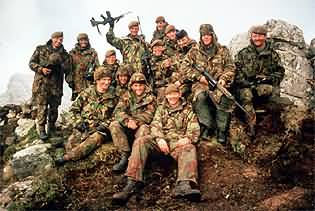
Let me briefly summarize a few key points in the conduct and success of the battle again quoting from g2 cro L.o.p. complete surprise was achieved and, as ever, was a major reason for success. Command and control are obviously very important at night and in this terrain. My personal view (that is of The coioc officer is that with k & l having worked closely in the field in Norway at length in feb and mar we had a built-in advantage: i.e., we were properly "worked-up". it was good to see that darkness and the difficulties of the terrain could be overcome in such "bitty" fighting and that the coy & tp comds could exercise firm control. Good timely radio procedure is obviously vital. Our (i.e., all British forces) success in night operations made me think that we sell ourselves short when it is so frequently re-iterated in staff colleges and else- where that the Soviets do so much more night training than us. Whether we do as much as the Soviets or not, it is clear that British infantry does have the ability and the initiative to operate very successfully at night. Incidentally, in conversation later with co 4 inf regt, he Refused to believe that every one of my men did not have a Night sight.
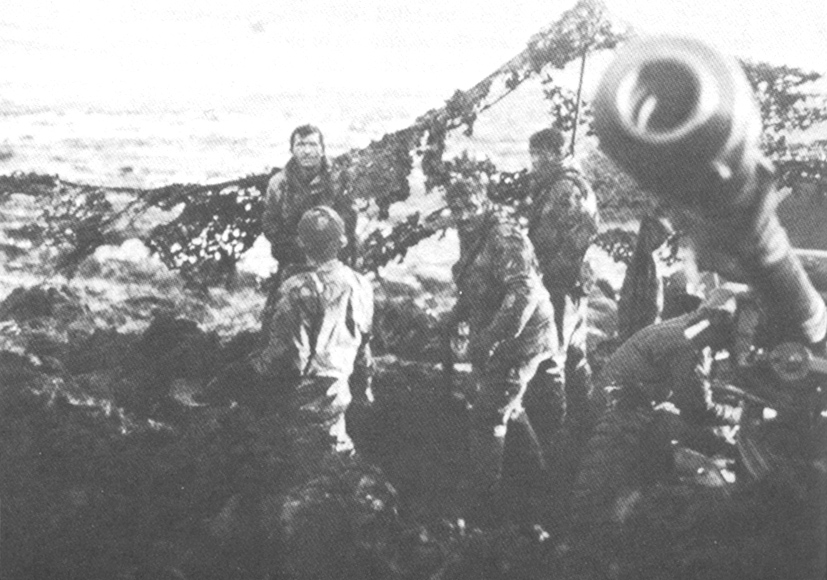
Speedy, accurate artillery fire was encouraging to have on one's side, and we instinctively felt it was having a detrimental effect on the opposition's morale. The FOOs with the coy had to bring down supporting fire within 100m of the coys. On one occasion FOO with k coy called for, and got, a regimental fire mission involving four gun batteries. Securing the ridge was no easy matter as this perhaps demonstrates. The coordination of the artillery, naval gunfire and mortar fire during the night was most impressive and the co-location of the co, bc, ngsfo and mortar offer meant that the FOOs and their rifle coy comds could be supported with the right type and weight of fire extremely quickly.
Now equipment. We carried full scale ammo for all weapons and the only troop weapons not carried in the assault were the 2" lt mortars. The effects of maw and law were tremendous against enemy infantry. The kit carried was: fighting order with a respirator bag on the belt too -- it carried such things as water proofs, survival rations and other items such as extra socks, radio batteries and some extra ammo. Windproof-smockpockets were also crammed with odds and ends not carried on exercises but considered highly desirable in action, especially with logistic resupply so tenuous! (e.g. extra torch batteries, drinks pack, nutty, toilet paper - the majority had some sort of "dog" at one stage or another, for we used any water available in the hills - we rarely got water resupply by Hel, the space just was not available). The '58 pattern Webbing was awful. With extra rats/ammo and whatever Hexamine we could carry, it was heavy un-comfortable, and awkward when wet. Nevertheless we always meant to assault carrying it: our philosophy was that a belt order or just weapon alone with magazines in pockets was all very well in pursuit of the philosophy of mobility in the assault, but if you were then pinned down/counterattacked on an exposed feature, it was best to sacrifice some comfort in terms of weight for the comfort of knowing that you could survive a set length of time before you had to have outside assistance. Our set length was 48 hours and I think we felt much happier knowing we had this capability. adrenalin in the assault customarily enables "royal" to carry fearsome weights and still fight hard!
Enemy resistance we met was in line with that Encountered elsewhere in the campaign: a hard initial Response which then crumbled, except for machine gunners And snipers who fought vigorously for much longer.
video 17
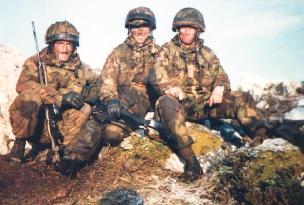
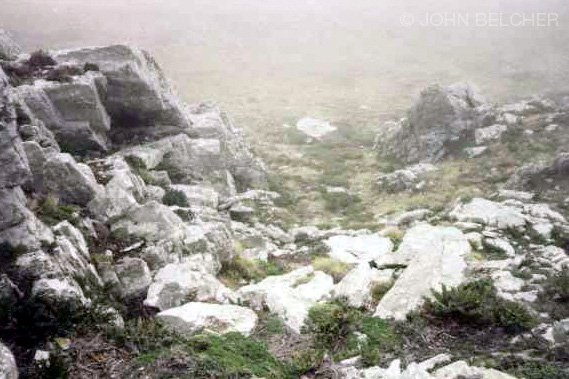
We had been ordered to be prepared to press forward the attack onto Mount Tumbledown and Mount William if the enemy fled our initial attack, and time allowed. By dawn it was obvious that we were in no position to attack. We were exhausted, out of ammo and suffering significant casualties. My 21c, a radio operator, my tac hq machine gunner and one of my troop commanders had all been shot, and a further 10 also wounded. Another troop commander I discovered was suffering from shellshock; at 1330, I had called an "o" group for 1430 hours, just after the battle. At 1425 this troop commander had not arrived, nor could I see that he was on his way. The troop was politely asked to find him. He was finally discovered sitting on a rock, fortunately on the reverse slope, waving at the helicopters bringing in the scots guards! When he eventually arrived, he had a completely vacant look about him and on questioning was not aware of what had happened over the previous 24 hours. A change of scenery at cdo hq for 72 hours cured him, superficially at least. I also was suffering from the "dog". It hit me first on top of mount Harriet after we had taken the main position and were about To strike the rocky outcrop. I must confess that I coordinated both the artillery and mortar fire missions and five minutes later the troop attack with my trousers round My ankles! One way and another no one has ever packed such a punch!
The following day the scots guards prepared for their attack on Mt. Tumbledown from a position in trenches laid out in the open behind us at grid 295715, and I regret to say suffered some shrapnel wounds. They were not adequately dug in, had no overhead cover and were in the obvious position from which to launch the next attack. We had identified a minefield between the east end of Goat Ridge and the west end of Mt. Tumbledown at gr 323720.
A Harrier strike was therefore called and we had a bird's eye view of the laser guided: bomb striking on target. That night the scots guards launched their attack through my position, the eastern end of which was their secure Start Line. We provided 2 x .50 cal machine guns in direct support, gratefully donated by the Argentineans. 42 cdo rm also had to provide mortar fire support, as the scots guards tubes got sunk in the peat after the first rounds, having been inadequately bedded in. During this attack I acted as LO within Brigadier Wilson's advanced tactical hq consisting of him, his cos, arty comd, s3 and 2 radio operators. It struck me that this was inadequate, the brigadier was without the essential communications and his necessary staff, and they, back at the main hq, were not kept in the picture. Fortunately, shortly after dawn on 14 Jan, as the Ghurkha's were about to start their assault on Mt. William, we heard a report of white flags over Stanley -- and so came the rush forward.
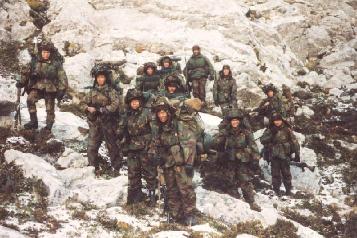
Within 30 minutes of confirmation, helicopters were en route to take first my coy, then the remainder of the cdo ukm fwd to the northeast slops of Mt. Tumbledown (to gr 340725).
The situation was very unclear from our point of view, and presumably chaotic for the Argentineans. We therefore conducted this operation as a helicopter assault. On landing we deployed and eventually moved off through what we feared may be another minefield. It was a Question of "in his master's steps he trod". I regret to Say that I was the master! For fairly obvious reasons I was more concerned about casualties after the ceasefire than during the battle.
video 18
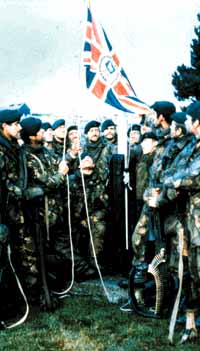
By midafternoon, we were in the western sector of Port Stanley, where composite coy J, formed by Col Nick Vaux to replace M coy in South Georgia, and consisting primarily of former members of the original np8901 based in the Falklands, had the honor of raising the same union jack that had been lowered in surrender 2 and 1/2 months earlier outside government house. My coy and j coy were billeted in the seaplane hangar which had been hit by a cluster bomb. The officers and sncos of our two coys used the mechanics workshop and lounge. When it rained a red stain in the ceiling spread and dripped onto us, so the csm detailed someone to go up onto the ceiling to investigate. We then realized the hanger must have been used as a morgue as there must have been 10 or 15 assorted limbs piled up on the roof. Outside was a wheelbarrow with a dead soldier in it, on top of him was a kit bag. When one of my LTs picked up the kit bag the head and four limbs fell out in 5 different directions. Anyway, we were pleased a couple of days later to move into the sheep slaughter house; it was very clean except for the deep freeze room which was full of decayed lamb. There had been no power for a couple of weeks or more. While in Stanley, we also got mail and magazines of one sort or another from the grateful Population in the uk who had donated some 25m pounds ($37m) to the South Atlantic fund.
In Stanley we found dozens of large containers full of Food, clothing and equipment; there was no need for us now to go hungry, but water remained a problem and more and More marines got the "dog" as a result.
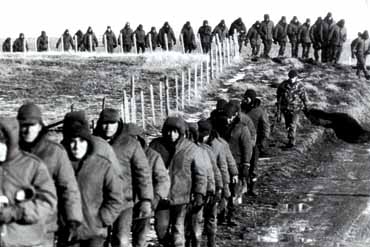
42 cdo task was to accept the surrender of the Argentinians who were to assemble at the airfield. This was a large enough area to place the 11,000 Argentineans, reported to be on the islands, and it had only one access point, where my coy was based for 48 hours every other 2 days.
Most of the Argentian troops shambled in in groups of 10 to 30. We disarmed them and confiscated all warfighting equipment except steel helmets and gas masks. Some such as the 4th marine regiment marched smartly in columns of route. Co in front, then adjutant, a rifle coy, the colours and then the remainder. Some 100m short of my position they halted and burnt their colours. When they reached me, the co halted the regiment, placed it at my disposal and personally gave me his matching pair of personalized Colt .45's. Other senior officers were less dignified; particularly as they tried-to drive in their Mercedes cross-country vehicles, to the airfield. These I hijacked - $750,000 in 3 hours, and made them walk the 2 miles. In the surrender agreement, General Menendez had requested that the officers, some of whom were most unpopular with their men and feared lynching, be allowed to keep their pistols. This was approved by General Moore, although only a few felt the need for them! As you can imagine we collected a great pile of weapons, magazines, bayonets, etc.; Sadly we as individuals were allowed to bring none back, but each unit retained a number of specialized weapons for subsequent worldwide contingencies. What happened to the surplus 8000 weapon: they were tragically dumped in the sea!
Life at the airfield for the Argentinean pows was uncomfortable, but it was no worse than for us. I wish to recount only 2 stories. Two or 3 days after the surrender, the brigade major (mab cos) tasked 42 cdo rm - my coy and another--to go to the airfield and clear it for subsequent fixed-wing air operations. After considerable discussion or more precisely, argument, I convinced him that we could "hack the problem" with myself, my csm who is a military policeman by mos, and a couple of marines for protection. The pows remained well disciplined under their own officers, mps and dogs and were eager to help. Within 3 hours of instructing the commandant of the prisoners, 8500 men were sweeping the airfield with hard scrubbing brushes, brooms, etc. The carrot I gave them was that we wished to fly in tents, food and so on from Ascension Island. Coincidentally, before they had finished, the first British C-130 to fly over the island, appeared overhead, proceeded to drop by parachute a load of stores some 4 miles to the west. This both enhanced my credibility with the prisoners and goaded them to greater efforts!
A day or 2 later the pow commandant asked me if I could get additional water for them. Though it was in very short supply, I managed to get some - and they were most grateful. So grateful in fact that I and my xo were invited to dinner the night before the vast majority of the Pows were evacuated in SS Canberra to Buenos Aires. The dinner was a truly memorable experience: not from the point of view of the food, which was appalling-- even though it was the first fresh food I had had for a month, nor even from the security point of view. Just as in Ireland both I and my xo had automatic hand guns loaded and ready for self-protection, and I had a section on vehicle patrol throughout the evening. The dinner was memorable because of the fascinating company. The "president" was the commanding officer of the airfield and its defence Forces; Mr. Vice, the co of the 4th marine regiment, the other involuntary guests were 2 staff officers, one to each of the colonels. The conversation was in English and similar in content and spirit to any other I or any of the other ios have had here with u.s. officers or amongst ourselves. They had been educated at English schools in Argentina or been to university in England, or to Sandhurst or Camberley, the army's TBS and staff college. We debriefed each of the battles and I discovered for the First time that their defenses had been initially directed to the south with the front line along Mt. Harriet, Mt. William and Sapper Hill. We also discussed world affairs and they reiterated that the last people they wished to fight were the Brits. There are, I think, more Welsh speakers in Argentina than in Wales and many of their emotional ties are with Britain. The only subject upon which we agreed to differ was on the status of the Falklands. But even then when they said this is only the first round, and they'll be back-I had to agree! We parted as great friends-and I eagerly await diplomatic approval to take up their invitation to lecture to their Staff college on "the attack." Since then I have only met One Argentinean, a delightful civilian whom I sat next to at a formal lunch at the Farnborough International Air Show. He was interested in secondary radar and iff- Thankfully not Exocet-capable aircraft!!
Eight days after the surrender, when SS Canberra returned from taking Argentinian pow's to Buenos Aires, we reembarked on Canberra to a marvelous welcome, delicious food, our first wash for 31 days and the luxury of sitting on a chair and sleeping in a bed. The 20 day return journey was one long marvelous party: on board SS Canberra were 3 cdo bde rm, some 50% of the strength of the Royal Marines and what a reunion we had. There was a certain amount of work to be done. Post operation reports and records of proceedings to be written, stores to be cleaned and mustered, medical screening for trench foot and so on. Excitement mounted as we neared England. Our landfall was the lizard in Cornwall at about 1600 on 10 july. Thereafter we were escorted by a flotilla of small boats. That evening the cdo forces band that had performed quite admirably throughout the war as stretcher bearers, pow Guards, air defence crew and working hands aboard SS Canberra, played the traditional sunset ceremony; a very moving occasion at any time. Here so rapturous was the applause that for the first time in history, they did an encore, the sun set twice that night! We arrived in the solent shortly after dawn to the fantastic welcome of thousands of boats and hundreds of thousands of spectators. We docked in Southhampton, the home port of SS Canberra and after a tearjerking reunion headed west in a convoy of buses to Plymouth. At every village, road junction, bridge and roundabout on the 200 mile journey, were crowds of people waving flags and greeting us home. In Dorchester for example, ladies came aboard each bus bearing pints of good English beer for all. We eventually got home on 12 July 1982, 3 months and four days after leaving. My commanding officer, Nick Vaux, called it a fairy tale war. We deployed and returned on a roundtrip of 16,000 miles in a luxury liner with first class treatment throughout. 7,000 of us landed with minimal loss in San Carlos water and fought a war against a numerically superior force of 10,800, which had had 6 weeks to prepare his defensive positions. We beat them despite enormous logistic and other difficulties, and the commando suffered only 2 killed and 26 wounded. All this within the school summer term, during which most service children in Englands are away at boarding school from mid-April to Mid-July!
video 19
I don't intend going through the nitty gritty of all the lessons that could be learned because not only would It take too long, but also some do not support the accepted Principle of war!
I think, however, i should mention just 5 fundamentals:
a. The fundamental requirement for good training at all levels.
b. The critical importance of using the night to best advantage.
c. The decisive nature of supporting arms in an infantry battle.
d. The need for good communications.
e. And finally, don't forget that logisticians can never win a war, but they most certainly can lose it!
Ladies and gentlemen, you have been very patient in listening to me for a long time, and thank you for your attention. I'll shortly try to answer any questions you may have, but first I'd like to welcome from the British Embassy, Captain Ron Crawford, a royal marine support helicopter pilot who flew in 3 weeks, 140 hours on single Pilot operations with great distinction during the war. Between us we'll do the best we can to satisfy your professional curiosity.